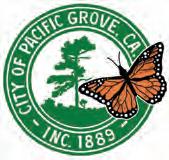I. INTRODUCTION
A. Project Background & Purpose
The Pacific Grove Historic Context Statement was sponsored by the City of Pacific Grove Community Development Department, and will be used as a foundation for the continued development of the City’s historic preservation program. Preparation of the context statement was undertaken in order to bring a greater level of consistency and clarity to the city’s preservation planning efforts, which have been ongoing for more than forty years.
This document presents the history of Pacific Grove’s built environment from pre-history to the present in order to support and guide identification and evaluation of historic properties throughout the city, as well as to inform future planning decisions. The document identifies important periods, events, themes, and patterns of development, and provides a framework for evaluating individual historic properties and neighborhoods for the National Register of Historical Resources, California Register of Historical Resources, and City of Pacific Grove Historic Resources Inventory (Municipal Code Chapter 23.76). Historic property types associated with these periods and themes are also identified and described in the historic context statement, and significance and integrity considerations are included for each.
It is important to note that while the context statement identifies key historical themes in Pacific Grove’s development, it is not a comprehensive history of the city, nor is it a definitive listing of all the city’s significant resources. Instead, it provides a general discussion of the overarching forces that shaped Pacific Grove’s built environment, why properties associated with that development are important, and what characteristics they need to qualify as historic resources.
Historic Context Statement – Final City of Pacific Grove Introduction Pacific Grove, California 31 October 2011 Page & Turnbull, Inc. 3
B. Definition of Geographical Area
The Pacific Grove Historic Context Statement addresses the geographical area within the current city limits. Pacific Grove is a coastal town located on the tip of the Monterey Peninsula, between Monterey and Pebble Beach in Monterey County, California. The Pacific Ocean marks the northern and western boundaries of the city, while Line Street bounds the city to the east. Sunset Drive forms much of the city’s southern boundary, although the city limits also run further south out Forest Avenue to include the Del Monte Park area. Among the principal roads, Lighthouse Avenue runs east-west through the city and serves as the traditional commercial corridor in downtown Pacific Grove. Another major local thoroughfare, Forest Avenue, runs north-south and connects the downtown area to the Holman Highway. The city also includes a portion of the famed 17 Mile Drive, which links scenic coastal areas with the Del Monte Forest.
The original city grid as laid out in the late ninete enth century included the area between Lighthouse Avenue and Monterey Bay; the oldest buildings are generally located in this tight-knit grid. The city then expanded outward through a series of additions, subdivisions, and annexations. Larger parcels with more recent construction are located in Pacific Grove Acres and in the hills near Forest Avenue. Notable Pacific Grove sites include the Point Pinos Lighthouse (1854), located at the northwest corner of the city; Lovers Point, a beach and park just north of the city center; the Monarch Butterfly Sanctuary near the city’s western edge; and the Julia Morgan-designed Asilomar complex at the southwest corner of the city. Monterey’s famous “Cannery Row” is just east of the Pacific Grove city limits.
Historic Context Statement – Final City of Pacific Grove Introduction Pacific Grove, California 31 October 2011 Page & Turnbull, Inc. 4
Historic Context Statement – Final City of Pacific Grove Introduction Pacific Grove, California 31 October 2011 Page & Turnbull, Inc. 5 DAVID 17 MILE SINEX FOREST 9OCEANVIEW TH 16TH A S L O M A R LINE 117TH 9TH 7TH 18TH PICO CEDAR GIBSON 8TH IRVING JEWELL PRESCOTT 4TH PINE CONGRESS MASON OAK 6TH CENTRAL JUNIPERO LILY 11TH 12TH 10TH RECTRAIL WALNUT PARK FOUNTAIN CARMEL AGRAND LDER LAINE 5TH HWY68 3RD SU NSET WOOD HOFFMAN EARDLEY 2ND C R O C K E R 1ST 15TH G R O V E AC R E 13TH BELDEN SURF ARCHER LOCUST DELMONTE WILLOW M A J E L L A SPENCER BALBOA MILES BAYVIEW H GH ALICE FOREST LODGE WITHERS SFBMORSE GRANITE CREST SHELL EGAN LINCOLN HILLCREST MONTEREY TERRY SKYLINE FUNSTON JESSIELOBOS CHESTNUT LOTTIE SPRUCE CLAY GRACE RIPPLE TAYLOR HARRISON PARCEL MAPLE FRANKLIN HELLAM VIA DEL REY LYNDON FILMORE A R M Y SEAVIEW CYPRESS ROOSEVELT EVANS PR VAT E B OL IO MORSE MERMAID NEWTON SYIDA BENITO SLOAT MELROSE LAWTON DRAKE SEAPALM SHAFTER PR ES D O JOHNSON RA NS FO RD PACIFIC DENNETT CORAL HAWTHORNE MONTECITO RIDGE ORTEGA SHORT MCCLELLAN 14TH FOAM DEVISADERO JEFFERSON S T L L W E LL FITCH AUSTIN STUART ARENA ORD RIFLE RANGE BEAUMONT MADISON SP RAY MACARTHUR CRAMDEN SERRA DEWEY HE RR MA NN R A LR O A D R I G H T O FW A Y RICKETTS ROW E V E R G R E E N SIREN DRYCREEK LEWIS GROVE HILLSIDE LIGHTHOUSE SPAZIER TIMBER CPL EVANS BWAINWRIGHT ISHOP BENTLEY PATTERSON CHAPARRAL BEACON RACCOON RUTH ACACIA GATE LAUREL 20TzH OLMSTEAD PINE HILL BRIGGS A C R O P O L S CABRILLO SGTFRONIUS BOWEN ROSEMONT MARINO PINES PLUM MER CALEDONIA SAGE PIEDMONT FOREST HILL CPL EVANS EL C AL LE JO N E INFANTRY GLEN LAKE V A D EL P I N A R KIT CA RS ON HACHIYA TR EASU RE MONARCH KENET PAR AD SE PARK DAY SPANISH BAY PETRA TANGLEWOOD PA CIF I C G ROV E UNION TODD AIR OFORCE TTER MORELAND ADOBE CLARK CAFFREY GARDEN WALCOTT L A U RI E ACORN LA SELVA CH UA LAR AVALON LORELEI NAVAJO FOREST PARK MARINE MOSS 19TH H E R R M A N N PINE PINE CYPRESS 13TH SUNSET MC CL EL LA N PRESIDIO PIEDMONT CROCKER JEWELL RA NS FO RD PRESIDIO 14TH 14TH LIGHTHOUSE 2ND 2ND LAUREL PARK LOBOS NEWTON LAWTON RANSFORD LIGHTHOUSE OAK SHELL SHORT SPRUCE SLOAT FITCH CONGRESS Page&Turnbull,Inc./1September2011 ° CityofPacificGrove CityLimits(2011) CurrentCityLimits Map of Pacific Grove, showing city limits, 2011. (Page & Turnbull)
C. Methodology & Research
The Pacific Grove Historic Context Statement is organized chronologically, with sections that correspond to major periods in Pacific Grove’s history from pre-history to the present. The content and organization of the document follows the guidelines of National Register Bulletin No. 15 How to Apply the National Register Criteria for Evaluation; National Register Bulletin No. 16A How to Complete the National Register Registration Form; National Register Bulletin No. 16B How to Complete the National Register Multiple Property Documentation Form; and National Register Bulletin No. 24 Guidelines for Local Surveys: A Basis for Preservation Planning.1; Resources and guidelines published by the California Office of Historic Preservation were also consulted, including the state’s official Instructions for Recording Historical Resources2 and a brief guide entitled “Writing Historic Context Statements.”3
Research for the Pacific Grove Historic Context Statement was gleaned from primary and secondary sources held at local, regional, and online repositories. Materials were primarily gathered at the Pacific Grove Heritage Society, Pacific Grove Public Library, Pacific Grove Museum of Natural History, Monterey Public Library (California Room), and California Historical Society.
Primary sources consulted included Sanborn Fire Insurance Maps, newspaper articles, city directories, census data, and historic photographs. Secondary sources included numerous books and publications (listed in the bibliography at the end of this document), GIS maps, previous historical reports and survey documentation (see Section II), and internet sources. Information and photographs gathered from the public during community workshops were also integrated into the context statement.
Throughout the report, maps are provided in order to illustrate which buildings developed within a particular time frame. These maps are based on data provided by the Monterey County Assessor. In some cases, there may be a discrepancy between the actual construction date of a property and the records of the Assessor. However, it was not within the scope of this report to find and correct these discrepancies.
The report also includes a number of current and historic images of Pacific Grove. Many of the historic images were gathered from secondary sources, which are cited in the image caption. The inclusion of these historic images is intended to be consistent with the “fair use” policies of the U.S. Copyright Office, which states that reproductions used for “criticism, comment, news reporting, teaching (including multiple copies for classroom use), scholarship, or research, is not an infringement of copyright.”4 It is also worth noting that unless specific measures have been taken to renew image copyrights, all published works made prior to 1923 are now in the public domain.5 This report has been prepared expressly as a scholarly research document, and the inclusion of these images was deemed vital for illustrating historic events and development patterns for which few, if any, alternative images are available.
Historic Context Statement – Final City of Pacific Grove Introduction Pacific Grove, California 31 October 2011 Page & Turnbull, Inc. 6
City of Pacific Grove Pacific Grove, California
Finally, because this historic context statement discusses hundreds of properties, the reader should assume that any individual building discussed remains extant today, unless specific mention is made otherwise. This is particularly true of buildings that are familiar landmarks in Pacific Grove, such as schools, churches and civic facilities. However, certain buildings, whether because of their size or relative obscurity, may still include a note emphasizing that they remain extant.
PROJECT TEAM
This historic context statement was prepared for the City of Pacific Grove by Page & Turnbull, a San Francisco-based architecture and planning firm that has been dedicated to historic preservation since 1973. Page & Turnbull staff responsible for this project includes Principal-in-Charge Ruth Todd, AIA, AICP, LEED AP, Project Manager/Cultural Resource Specialist Rebecca Fogel, and Historian Jonathan Lammers, all of whom meet the Secretary of the Interior’s Professional Qualifications Standards in Historic Architecture, Architectural History, and/or History.
Coordination of the project was undertaken by Chief Planner Lynn Burgess, AICP, of the City of Pacific Grove Community Development Department. The Historic Context Statement (HCS) Subcommittee—an advisory group composed of members of the Planning Commission, Architectural Review Board, and Historic Resources Committee—was also instrumental in the preparation of this document. HCS Subcommittee members included William (Bill) Fredrickson, Ken Hinshaw, Steven MacDonald, James (Jim) McCord, Juan D. Rosas, and Claudia Sawyer.
Historic Context Statement – Final
Introduction
31 October 2011 Page & Turnbull, Inc. 7
D. How to Use This Document
The Pacific Grove Historic Context Statement identifies development patterns and significant properties in the area. It is intended to be used as a tool by the Pacific Grove community to better understand and evaluate the city’s historic resources. The document is organized as follows:
Section II. Previous Surveys, Studies and Reports summarizes previous historic resource survey work in Pacific Grove.
Section III. Guidelines for Evaluation provides an overview of the various national, state, and local registration requirements; a summary of significant themes; a definition of each of the major property types found in the city (residential, commercial, industrial, and civic/institutional); and guidelines for evaluating the significance and integrity of these properties. The guidelines in this section can be used by the City of Pacific Grove as the framework for future evaluations.
Section IV. Historic Context includes a narrative of the area’s developmental history. This history is broken into six periods that are defined by events, themes, and development trends. Property types associated with each of the six periods are identified and analyzed. The information in this section does not provide any determinations of eligibility, but rather can be used as a reference point when questions arise regarding a property’s significance and integrity.
Under separate cover is a document entitled “Pacific Grove Preservation Program Considerations,” which includes a discussion of future research topics, survey efforts, designation priorities, and other preservation strategies that could be considered in the future. These recommendations are intended to help prioritize future historic preservation related efforts, and are suggested as “next steps” for the City to consider after the Historic Context Statement has been implemented and used.
Historic Context Statement – Final City of Pacific Grove Introduction Pacific Grove, California 31 October 2011 Page & Turnbull, Inc. 8
City of Pacific Grove Surveys, Studies Pacific Grove, California
II. PREVIOUS SURVEYS, STUDIES AND REPORTS
The City of Pacific Grove has been committed to preserving its architectural heritage since its first historic preservation ordinance was adopted by the City Council in 1994. The City’s current General Plan and implementing regulations also place a strong emphasis on the preservation of historic resources (see General Plan Chapter 7: Historic and Archaeological Resources and the Historic Preservation Ordinance, Pacific Grove Municipal Code Chapter 23.76). The following section identifies prior historic resource surveys and studies on file with the City of Pacific Grove Community Development Department.
Historic Context Statement – Final
Previous
and Reports
31 October 2011 Page & Turnbull, Inc. 9
SINEX 1 7 M IL E 9OCEANVIEW TH LAUREL DAVID 16TH A S L O M A R LINE 117TH 9TH 7TH 18TH PICO CEDAR GIBSON 8TH FOREST JEWELL 4TH 6RECTRAIL TH CENTRAL JUNIPERO 11TH 12TH 10TH WALNUT IRVING PARK FOUNTAIN CARMEL GRAND SU NSET CONGRESS ALDER 5TH 3RD WOOD EARDLEY 2ND C R O C K E R 1ST LOBOS 15TH G R O V E AC R E 13TH SURF LOCUST LAINE DELMONTE WILLOW BALBOA BAYVIEW GRANITE CREST SHELL EGAN HILLCREST MONTEREY OPINE AK CHESTNUT SPRUCE RIPPLE FOAM PRESCOTT MAPLE LBELDEN ILY EVANS MERMAID SLOAT WAVE MELROSE ARCHER SPENCER SEAPALM HAWTHORNE PACIFIC DENNETT CORAL RIDGE HOFFMAN SHORT 14TH BEACH ARENA SP RAY DEWEY R A LR O A D R I G H T O F W A Y RICKETTS ROW E V E R G R E E N SIREN WITHERS NEWTON GROVE LIGHTHOUSE SPAZIER BENTLEY BEACON RUTH ACACIA GATE 20TH ESPLANADE BRIGGS A C R O P O L S ROSEMONT MARINO PINES CALEDONIA BEAUMONT MONARCH CYPRESS DAY SPANISH BAY PETRA PAC F I C G R OV E UNION TODD GARDEN WALCOTT L A UR E MELTON AVALON LORELEI FOREST PARK MARINE MOSS WO RKMAN PINE GARDEN 19TH PARK LIGHTHOUSE SHELL 13TH SHORT SPRUCE 2ND JEWELL SUNSET CROCKER 2ND 14TH PINE OAK 14TH LIGHTHOUSE MARINO PINES CityofPacificGrove ExistingHistoricResources L ListedinNationalRegister istedinHRI Page&Turnbull,Inc./24June2011 ° Map of properties currently listed in the National Register & the Pacific Grove HRI (Page & Turnbull, 2011)
A. Historic Resources Inventory (HRI) & PG Municipal Code §23.76
The Historic Resources Inventory (HRI) is the City of Pacific Grove’s official listing of locallydesignated historic resources. The HRI is administered by the City’s Historic Preservation Ordinance (Chapter 23.76 of the Pacific Grove Municipal Code), and ministered by the Historic Resources Committee (HRC), which may add or delete properties.
This list of historic structures was initiated in 1978 through a matching grant from the State Office of Historic Preservation and adopted by the City of Pacific Grove. The list has since been updated by the Heritage Society and the City of Pacific Grove to include structures built prior to 1927.6 The inventory also includes other properties determined by the Historic Resources Committee to be of architectural and/or historical significance.7
Today, there are over 1,300 buildings listed on the City’s Historic Resources Inventory. Approximately fifteen of these buildings are also listed on the National Register of Historic Places and/or California Register of Historical Resources. There are many more buildings over fifty years of age that have yet to be surveyed. California Department of Parks and Recreation (DPR) 523 forms for nearly 600 of the 1,300 inventoried properties are on file with the Community Development Department.
B. Pacific Grove General Plan: Preservation Element
The City first adopted a historic preservation element as part of its General Plan in August 1987. The element was prepared following guidelines prepared by the State Office of Planning and Research in 1976. The current General Plan was adopted in 1994, with a chapter dedicated to Historic and Archaeological Resources. This chapter includes a brief history of Pacific Grove, a description of common architectural styles, and a list of historic preservation goals, policies, and programs.
The General Plan identifies a number of officially designated historic buildings in Pacific Grove. The following resources were listed on the National Register of Historic Places as of 1994: F. L. Buck House Oliver Smith Trimmer House Centrella Hotel Chautauqua Hall Gosby House
Pt. Pinos Lighthouse
Asilomar State Beach and Conference Grounds National Historic Landmark (contributors include Entrance Gates, Crocker Building, Dodge Memorial Chapel, Phoebe A. Hearst Social Hall, Merrill Hall, Scripps Hall, and Visitors Lodge)
Historic Context Statement – Final City of Pacific Grove Previous Surveys, Studies and Reports Pacific Grove, California 31 October 2011 Page & Turnbull, Inc. 10
Chautauqua Hall is also a California Registered Historical Landmark, and the Oliver Smith Trimmer House is a California Point of Historical Interest.8
C. Heritage Society Surveys
The Heritage Society of Pacific Grove is a non-profit organization incorporated in 1976 with the stated purpose of encouraging restoration and preservation of Pacific Grove’s historic buildings, educating present-day residents about local history and historic preservation, and maintaining the beauty and individuality of Pacific Grove.9
The Heritage Society was responsible for much of the early documentation of Pacific Grove’s historic buildings. Residents who would become members of the yet-to-be-organized Heritage Society worked with City staff beginning in 1975 to inventory for the first time historic homes in the Retreat district. In the next two years, 528 structures were identified and documented—378 singlefamily homes, 50 duplexes and 100 multiple dwellings. Beginning in 1977, funded by a State grant, members of the Heritage Society and City staff photographed and described 350 homes of historic significance. Heritage Society members next undertook to identify and evaluate all the homes built before 1926. (The date 1926 was chosen because the Sanborn Fire Insurance maps for that year could be used to document the existence of the buildings.) This effort led to the creation of the City’s current Historic Resources Inventory, a listing of pre-1926 buildings. In 2005, the Heritage Society funded a photographic inventory of the more than 1,300 structures on the Historic Resources Inventory. These records are available in the Community Development Department, and at the archives at the Heritage Society Barn.
The Society has also placed historic markers—the familiar green plaques—on, presently, 679 historic homes in Pacific Grove. These plaques indicate the year and name of the owner when the building was first assessed for tax purposes—not necessarily the year of construction. In addition, some 70 buildings have been recognized with bronze Heritage House medallions.
D. Other Studies & Resources
Some resources in Pacific Grove were individually documented through the Historic Resources Inventory, DPR 523 Forms, National Register Nominations, Property Tax Record Cards, or other reports. These documents were completed by a variety of consultants from the 1970s to the present, and can be found in the City of Pacific Grove Community Development archives, the Heritage Society Barn, or the State of California Office of Historic Preservation’s Northwest Information Center.
In addition to the abovementioned surveys and documentation, the City of Pacific Grove has a number of planning documents that relate to historic resources. Most notably the City of Pacific Grove
Historic Context Statement – Final City of Pacific Grove Previous Surveys, Studies and Reports Pacific Grove, California 31 October 2011 Page & Turnbull, Inc. 11
Historic Context Statement – Final City of Pacific Grove Previous Surveys, Studies and Reports Pacific Grove, California
Architectural Review Guidelines for Single-Family Residences (1998) provides excellent guidance for identifying architectural styles and the appropriate treatments of historic homes; it is used by boards, commissions, and staff during the review and permit approvals process. In 2010, a set of Window Guidelines was added as an appendix to the residential design guidelines to provide additional clarity about proper treatment of windows. These documents are available at the Community Development Department offices in City Hall, or on the City of Pacific Grove’s website.
31 October 2011 Page & Turnbull, Inc. 12
City of Pacific Grove Evaluation Pacific Grove, California
III. GUIDELINES FOR EVALUATION
The following section reviews themes significant to the developmental history of Pacific Grove and defines major property types that are representative of these themes. The section concludes with general guidelines for evaluating properties for the national, state, and local register.
A. Summary of Significant Themes
The Pacific Grove Historic Context Statement utilizes themes and periods of development as its primary organizing principle. “Themes” are ways to organize and understand information about events, activities, people, communities, and patterns of change that have influenced historic and cultural development of an area. The National Park Service revised its framework for historic themes in 1994, replacing a more chrono-centric approach with themes intended to capture “the full diversity of American history and prehistory.”10 This historic context statement discusses the following themes relative to the growth and evolution of the built environment in Pacific Grove:
Residential Development Commercial Development Civic Growth Transportation & Infrastructure Ethnic & Cultural Diversity Social, Religious, or Cultural Institutions, Movements & Trends Recreation, Leisure & Tourism Development & Booster Organizations Environmentalism
These themes contribute in varying degrees to the Pacific Grove Historic Context Statement, and are manifested in different ways throughout the city’s history. These themes are discussed more specifically as they relate to each of Pacific Grove’s six periods of development.
RELATING THEMES WITH PERIODS OF DEVELOPMENT
The periods of development in this context statement combine specific timeframes with themes that encompass related events, patterns of settlement and construction, activities of people important to the area, and the socioeconomic changes. Each of the periods of development is also associated with specific property types that originated within or characterize the period. The periods of development also represent the potential periods of significance for properties associated with the respective contexts. A period of significance is the time span during which a property (or property type) attained its historic significance.
Historic Context Statement – Final
Guidelines for
31 October 2011 Page & Turnbull, Inc. 13
Historic Context Statement – Final City of Pacific Grove Guidelines for Evaluation Pacific Grove, California 31 October 2011 Page & Turnbull, Inc. 14 DAVID 17 MILE SINEX FOREST 9OCEANVIEW TH 16TH A S I L O M A R LINE 117TH 9TH 7TH 18TH PICO CEDAR GIBSON 8TH IRVING JEWELL PRESCOTT 4TH PINE CONGRESS MASON OAK 6TH CENTRAL JUNIPERO LILY 11TH 12TH 10TH RECTRAIL WALNUT PARK FOUNTAIN CARMEL AGRAND LDER LAINE 5TH HWY68 3RD SUNSET WOOD HOFFMAN EARDLEY 2ND CR O C K ER 1ST 15TH GROV E ACR E 13TH BELDEN SURF ARCHER LOCUST DELMONTE WILLOW M A J E L L A SPENCER BALBOA MILES BAYVIEW HIGH ALICE FOREST LODGE WITHERS SFBMORSE GRANITE CREST SHELL EGAN LINCOLN HILLCREST MONTEREY TERRY SKYLINE FUNSTON JESSIELOBOS CHESTNUT LOTTIE SPRUCE CLAY GRACE RIPPLE TAYLOR HARRISON PARCEL MAPLE FRANKLIN HELLAM VIA DEL REY LYNDON FILMORE A R M Y SEAVIEW CYPRESS ROOSEVELT EVANS PR VAT E BOL O MORSE MERMAID NEWTON SYIDA BENITO SLOAT MELROSE LAWTON DRAKE SEAPALM SHAFTER PR ESID O JOHNSON RA NS FO RD PACIFIC DENNETT CORAL HAWTHORNE MONTECITO RIDGE ORTEGA SHORT MCCLELLAN 14TH FOAM DEVISADERO JEFFERSON S T L L W E LL FITCH AUSTIN STUART ARENA ORD RIFLE RANGE BEAUMONT MADISON SP RAY MACARTHUR CRAMDEN SERRA DEWEY HE RR MA NN R A LR O A D R I G H T O F W AY RICKETTS ROW E V E R G R E E N SIREN DRYCREEK LEWIS GROVE HILLSIDE LIGHTHOUSE SPAZIER TIMBER CPL EVANS BWAINWRIGHT ISHOP BENTLEY PATTERSON CHAPARRAL BEACON RACCOON RUTH ACACIA GATE LAUREL 20TH OLMSTEAD PINE HILL BRIGGS A C R OP OL S CABRILLO SGTFRONIUS BOWEN ROSEMONT MARINO PINES PLUM MER CALEDONIA SAGE PIEDMONT FOREST HILL CPL EVANS EL CAL LE JO N E INFANTRY GLENLAKE V I A D EL P N A R K T CA RS ON HACHIYA TREASU RE MONARCH KENET PARADISE PA R K DAY SPANISH BAY PETRA TANGLEW OOD PAC FIC G R O V E UNION TODD AIR OFORCE TTER MORELAND ADOBE CLARK CAFFREY GARDEN WALCOTT L A U R E ACORN LA SE LVA CHUA LA R AVALON LORELEI NAVAJO FOREST PARK MARINE MOSS 19TH H E R R M A N N PINE PINE CYPRESS 13TH SUNSET MC CL EL LA N PRESIDIO PIEDMONT CROCKER JEWELL RA NS FORD PRESIDIO 14TH 14TH LIGHTHOUSE 2ND 2ND LAUREL PARK LOBOS NEWTON LAWTON RANSFORD LIGHTHOUSE OAK SHELL SHORT SPRUCE SLOAT FITCH CONGRESS CityofPacificGrove ConstructionDates:1873-1966 PERIODSOFDEVELOPMENT DevelopmentoftheRetreat(1873-1902) PGComesofAge(1903-1926) CityofHomes(1927-1945) ExpandingintotheHills(1946-1966) Page&Turnbull,Inc./24June2011 ° Map showing distribution of properties constructed during each period of development (Page & Turnbull)
City of Pacific Grove Guidelines for Evaluation Pacific Grove, California
The periods of development utilized for the Pacific Grove Historic Context Statement have been developed by Page & Turnbull in consultation with the Historic Context Statement Subcommittee, as well as staff from the City of Pacific Grove Community Development Department. These periods are as follows:
Native American & Mission Periods (to 1820)
The dominant themes of this period are the pre-historic settlement of the Pacific Grove area; the Spanish colonization of the area and subsequent formation of the Monterey and Carmel missions; and the tensions that developed between the Native American and European cultures.
Mexican & Early American Periods (1821 - 1872)
The primary themes of this period are the redistribution of land in Northern California and the subsequent decline of the mission at Carmel; the establishment of a Chinese fishing village at Point Alones; and land acquisition by entrepreneur David Jacks.
Early Development of Pacific Grove (1873 - 1902)
The dominant themes of this period are the early development of the city as the Pacific Grove Retreat and the Retreat’s subsequent transition from a summer encampment to a city (creation of water, sewage, and transportation infrastructure and emergence of residential, commercial, and civic development patterns). The impact that development companies such as the Pacific Grove Retreat Association and the Pacific Improvement Company had on the built environment was important during this period, as was the influence of the Chautauqua and other social and religious organizations on the culture and character of the city. Other themes that emerged during this period included the development of recreational facilities and promotion of the area as a tourist attraction and the contributions of the Chinese fishing village to local culture.
Pacific Grove Comes of Age (1903 - 1926)
The primary theme of this period is the maturation of the city, as evidenced by construction of new civic facilities, the arrival of large-scale commercial development along Lighthouse Avenue, and the use of new architectural styles and building materials. Other notable developments included the redevelopment of the beach area at Lovers Point into a fullydeveloped tourist destination, the destruction of the Chinese fishing village and subsequent redevelopment of China Point, as well as the end of the Chautauqua gatherings. The creation of Del Monte Properties as a successor firm to the Pacific Improvement Company and its influence on the sale of lots and development of subdivisions would also become an important force during this era. Finally, the growing influence of the private automobile is a theme that can be seen in commercial, light industrial, and residential development patterns.
Historic Context Statement – Final
31 October 2011 Page & Turnbull, Inc. 15
City of Homes (1927 - 1945)
City of Pacific Grove Pacific Grove, California
The dominant themes of this period are recreation and tourism, the Great Depression, and World War II. Specifically, this period saw new public ownership and management of the city’s key recreational facilities, the rise of auto camps as a significant part of the city’s tourist infrastructure, the protection of natural resources via acquisition of the city’s coastline and the passing of the “butterfly ordinance,” and the improvement of recreational facilities as part of Depression-era work programs. The influence of Monterey’s Cannery Row operations on Pacific Grove would also prove to be a major factor.
Suburban Expansion (1946 - 1965)
The preeminent theme of this period is the post-war growth of the city, reflecting the corresponding dominance of the automobile. This included expansion of civic infrastructure to accommodate population growth; construction of single-family residences in new subdivisions that departed from the original grid layout of streets; the build-out of older subdivisions where development had been sparse; construction of multi-family residences; infill and redevelopment of the central business district and Lovers Point; and the continued impact of automobiles, including clearance of older buildings for parking lots. The proliferation of hotels and motels also demonstrated changes in the city’s tourist industry.
B. Summary of Property Types
Each period of development has one or more associated property types that help illustrate the period’s significant themes. Property types that are discussed in this document are defined as follows:
Residential properties include single-family dwellings, duplexes, flats, and apartments. Single-family dwellings are by far the most common property type in the city, while multiunit buildings are comparatively rare. In Pacific Grove, single-family residences can be further classified into several sub-types: tent cottages, cottages, bungalows, grander residences, and tract houses. Boarding houses, hotels, motels, and auto courts are also considered to be a residential property type for the purposes of this study.
Commercial properties are those with commercial spaces on all floors; buildings with retail space on the ground floor and office space above; or mixed use buildings that feature retail space on the ground floor and dwelling space above.
Industrial properties include any building where things are made, stored or repaired. In addition to factories and warehouses (which have always been scarce in Pacific Grove), industrial properties may also include buildings such as stables, auto-repair shops and garages, water works and electric substations.
Historic Context Statement – Final
Guidelines for Evaluation
31 October 2011 Page & Turnbull, Inc. 16
City of Pacific Grove Evaluation Pacific Grove, California
Institutional properties may include libraries, courthouses, post offices, schools, churches, hospitals, social halls and union halls. Recreational facilities, such as youth centers and the complex at Asilomar would also fall into this category. These buildings are typically larger and more ornate than other property types, are associated with a particular group or organization, and were designed to serve a public or civic function.
Cultural landscapes may include landscape elements or collections of landscape elements, because the physical history of a place like Pacific Grove can be told through more than just its buildings. A cultural landscape could be an entire designed landscape such as a park or cemetery, or could be composed of individual elements such as site features (e.g. fences, walls, etc.), public terraces, street furnishings (e.g., lights and benches), and circulation patterns.
Archeological resources, if discovered, are likely to be significant, but analysis of these resources is outside the scope of this document.
Each section of this context statement identifies associated property types, provides a description of their character and distribution, and outlines the requirements for resource registration.
C. Evaluation Criteria
The following discussion of significance and integrity generally guides the property types analysis found in later chapters of this document, and should be used to support future evaluation of historic resources in Pacific Grove. It is important to note that each property is unique; therefore significance and integrity evaluation must be conducted on a case-by-case basis. These guidelines should be implemented as an overlay to the particular facts and circumstances of each individual resource.
NATIONAL REGISTER OF HISTORIC PLACES & CALIFORNIA REGISTER OF HISTORICAL RESOURCES
The National Register of Historic Places is the nation’s most comprehensive inventory of historic resources. The National Register is administered by the National Park Service and includes buildings, structures, sites, objects, and districts that possess historic, architectural, engineering, archaeological, or cultural significance at the national, state, or local level. According to National Register Bulletin Number 15: How to Apply the National Register Criteria for Evaluation, resources over fifty years of age are typically eligible for listing in the National Register if they meet any one of the four criteria of significance (A through D) and if they sufficiently retain historic integrity. However, resources under fifty years of age can be determined eligible if it can be demonstrated that they are of “exceptional importance,” or if they are contributors to a potential historic district. These criteria are defined in depth in National Register Bulletin Number 15. The California Register of Historical
Historic Context Statement – Final
Guidelines for
31 October 2011 Page & Turnbull, Inc. 17
Resources follows nearly identical guidelines to those used by the National Register, but identifies the Criteria for Evaluation numerically.
The four basic criteria under which a structure, site, building, district, or object can be considered eligible for listing in the National or California registers are:
Criterion A/1 (Event): Properties associated with events that have made a significant contribution to the broad patterns of our history;
Criterion B/2 (Person): Properties associated with the lives of persons significant in our past;
Criterion C/3 (Design/Construction): Properties that embody the distinctive characteristics of a type, period, or method of construction, or that represent the work of a master, or that possess high artistic values, or that represent a significant distinguishable entity whose components lack individual distinction; and
Criterion D/4 (Information Potential): Properties that have yielded, or may be likely to yield, information important in prehistory or history.11
A resource can be considered significant to American history, architecture, archaeology, engineering, and culture on a national, state, or local level. Perhaps the most critical feature of applying the criteria for evaluation is establishing the relationship between a property and its historic context, which is defined as “those patterns or trends in history by which a specific occurrence, property, or site is understood and its meaning (and ultimately its significance) within history or prehistory is made clear.”12
CRTIERIA CONSIDERATIONS
Certain types of properties are usually not considered for listing in National Register. However, these properties can be eligible for listing if they meet special requirements, or Criteria Considerations. If working with one of these excluded property types, an evaluator must determine that a property meets the Criteria Considerations in addition to one of the four evaluation criteria described above in order to justify its inclusion in the National Register. These considerations are defined as follows:
Criteria Consideration A: Religious Properties: A religious property is eligible if it derives its primary significance from architectural or artistic distinction or historical importance.
Criteria Consideration B: Moved Properties: A property removed from its original or historically significant location can be eligible if it is significant primarily for
Historic Context Statement – Final City of Pacific Grove Guidelines for Evaluation Pacific Grove, California 31 October 2011 Page & Turnbull, Inc. 18
architectural value or it is the surviving property most importantly associated with a historic person or event.
Criteria Consideration C: Birthplaces & Graves: A birthplace or grave of a historical figure is eligible if the person is of outstanding importance and if there is no other appropriate site or building directly associated with his or her productive life.
Criteria Consideration D: Cemeteries: A cemetery is eligible if it derives its primary significance from graves of persons of transcendent importance, from age, from distinctive design features, or from association with historic events.
Criteria Consideration E: Reconstructed Properties: A reconstructed property is eligible when it is accurately executed in a suitable environment and presented in a dignified manner as part of a restoration master plan and when no other building or structure with the same associations has survived. All three of these requirements must be met.
Criteria Consideration F: Commemorative Properties: A property primarily commemorative in intent can be eligible if design, age, tradition, or symbolic value has invested it with its own historical significance.
Criteria Consideration G: Properties that Have Achieved Significance within the Past Fifty Years: A property achieving significance within the past fifty years is eligible if it is of exceptional importance.13
The California Register does not have the same strict Criteria Considerations as the National Register, and is more flexible about moved properties and properties less than fifty years of age.
HISTORIC RESOURCES INVENTORY (HRI)
The eligibility criteria for local listing in the City of Pacific Grove’s Historic Resources Inventory (HRI) are similar to the National Register and California Register criteria described above. Specifically, as described in the City of Pacific Grove’s Historic Preservation Ordinance (Municipal Code §23.76.025), the evaluation criteria for inclusion in the Historic Resources Inventory are as follows:
a. Whether the structure has significant character, interest or value as part of the development, heritage or cultural characteristics of the city of Pacific Grove, the state of California, or the United States;
b. Whether it is the site of a significant historic event;
c. Whether it is strongly identified with a person who, or an organization which, significantly contributed to the culture, history or development of the city of Pacific Grove;
d. Whether it is a particularly good example of a period or style;
Historic Context Statement – Final City of Pacific Grove Guidelines for Evaluation Pacific Grove, California 31 October 2011 Page & Turnbull, Inc. 19
e. Whether it is one of the few remaining examples in the city of Pacific Grove possessing distinguishing characteristics of an architectural type or specimen;
f. Whether it is a notable work of an architect or master builder whose individual work has significantly influenced the development of the city of Pacific Grove;
g. Whether it embodies elements of architectural design, detail, materials or craftsmanship that represent a significant architectural innovation;
h. Whether it has a unique location or singular physical characteristics representing an established and familiar visual feature of a neighborhood, community, or of the city of Pacific Grove;
i. Whether it retains the integrity of the original design;
j. Whether it contributes to the architectural aesthetics and continuity of the street;
k. Whether it is located within a geographically definable area possessing a concentration of historic properties which visually contribute to each other and are unified aesthetically. [Ord. 01-25 § 1, 2001; Ord. 97-23 § 1, 1997].14
COMPARISON WITH NATIONAL & STATE CRITERIA
Although phrasing differs, the designation criteria established by City of Pacific Grove’s HRI for the Historic Resources Inventory are similar in spirit to the National Register and California Register criteria described above. In all cases, historic resources may be significant for their association with events, social and cultural trends, important people, architecture, and/or master architects. Thus, the evaluations presented throughout this document for eligibility in any of the three registers will use a consistent approach.
CALIFORNIA ASSEMBLY BILL 133
California Assembly Bill 133 (AB 133), passed in 1994, allows religious institutions to exempt themselves from local historic preservation laws.15 A religious institution may object to the application of a local ordinance to its property if the institution publicly claims that designation will suffer substantial economic hardship or will impede the use of the property in the furtherance of its religious mission.16 Evaluators should be aware of this exemption when considering religious properties for inclusion in the HRI. However, please note that AB 133 does not apply to state law, and therefore religious institutions may still be required to prepare Environmental Impact Reports under the California Environmental Quality Act (CEQA).
INTEGRITY
In addition to qualifying for listing under at least one of the National Register/California Register/local criteria, a property must be shown to have sufficient historic integrity. The concept of integrity is essential to identifying the important physical characteristics of historic resources and in evaluating adverse changes to them. Integrity is defined as “the authenticity of an historic resource’s physical identity evidenced by the survival of characteristics that existed during the resource’s period of significance.”17 The same seven variables or aspects that define integrity—location, design, setting, materials, workmanship, feeling and association—are used to evaluate a resource’s eligibility
Historic Context Statement – Final City of Pacific Grove Guidelines for Evaluation Pacific Grove, California 31 October 2011 Page & Turnbull, Inc. 20
for listing in the National Register and/or the California Register. According to the National Register Bulletin: How to Apply the National Register Criteria for Evaluation, these seven characteristics are defined as follows:
Location is the place where the historic property was constructed or the place where the historic event occurred. The original location of a property, complemented by its setting, is required to express the property’s integrity of location.
Design is the combination of elements that create the form, plans, space, structure and style of the property. Features which must be in place to express a property’s integrity of design are its form, massing, construction method, architectural style, and architectural details (including fenestration pattern).
Setting addresses the physical environment of the historic property inclusive of the landscape and spatial relationships of the building(s). Features which must be in place to express a property’s integrity of setting are its location, relationship to the street, and intact surroundings (e.g., neighborhood or rural).
Materials refer to the physical elements that were combined or deposited during a particular period of time and in a particular pattern of configuration to form the historic property. Features which must be in place to express a property’s integrity of materials are its construction method and architectural details.
Workmanship is the physical evidence of the crafts of a particular culture or people during any given period in history. Features which must be in place to express a property’s integrity of workmanship are its construction method and architectural details.
Feeling is the property’s expression of the aesthetic or historic sense of a particular period of time. Features which must be in place to express a property’s integrity of feeling are its overall design quality, which may include form, massing, architectural style, architectural details, and surroundings.
Association is the direct link between an important historic event or person and a historic property. Features which must be in place to express a property’s integrity of association are its use and its overall design quality.
The California Environmental Quality Act (CEQA) discusses another definition of integrity relative to proposed development projects, noting that projects that cause a substantial adverse change to the significance of a historical resource may have a significant effect on the environment. According to Section 15064.5(b)(1) of the Public Resources Code, “Substantial adverse change in the significance of an historical resource means physical demolition, destruction, relocation, or alteration of the resource or its immediate surroundings such that the significance of an historical resource
Historic Context Statement – Final City of Pacific Grove Guidelines for Evaluation Pacific Grove, California 31 October 2011 Page & Turnbull, Inc. 21
City of Pacific Grove Pacific Grove, California
would be materially impaired.” In order to avoid significant adverse effects, evaluators should look closely to see whether a project “Demolishes or materially alters in an adverse manner those physical characteristics of an historical resource that convey its historical significance and that justify its inclusion in the California Register of Historical Resources, or…a local historical register.”
EVALUATING INTEGRITY IN PACIFIC GROVE
For evaluation purposes, a building ultimately either possesses integrity or does not. While it is understood that nearly all properties undergo change over time—and thus minor alterations or changes are not uncommon—a building must possess enough of its original features to demonstrate why it is significant. Evaluators of potential historic resources should look closely at characteristics such as massing, roof forms, fenestration patterns, cladding materials, and neighborhood surroundings when evaluating a property’s integrity.
In order to convey its historical significance, a property that has sufficient integrity for listing in the national, state, or local historical register will generally retain a majority of its character-defining features. However, the necessary aspects of integrity also depend on the reason the property is significant. High priority is typically placed on integrity of design, materials, and workmanship for properties significant under Criterion C/3, while for properties significant under Criterion A/1 or B/2, these aspects are only necessary to the extent that they help the property convey integrity of feeling and/or association. Similarly, integrity of location and setting are crucial for properties significant under Criterion A/1, but are typically less important for properties significant under Criterion B/2 or C/3. For properties significant under any of these criteria, it is possible for some materials to be replaced without drastically affecting integrity of design, as long as these alterations are subordinate to the overall character of the building. For example, minor alterations such as window replacement may be acceptable in residential districts, but not in an individual property designed by a master architect.
Evaluations of integrity should also include some basis of comparison. In other words, the evaluator should understand the relative levels of integrity associated with each property type. For instance, increased age and rarity of the property type may also lower the threshold required for sufficient integrity. Conversely, some properties may rate exceptionally highly in all aspects of integrity; such properties should be given high priority in preservation planning efforts, and are more likely to be eligible for listing in the National Register. Generally, a property with exceptional integrity will have undergone few or no alterations since its original construction, and will not have been moved from its original location.
Finally, it should be stressed that historic integrity and condition are not the same. Buildings with evident signs of deterioration can still retain eligibility for historic listing as long as it can be demonstrated that they retain enough character-defining features to convey their significance.
Historic Context Statement – Final
Guidelines for Evaluation
31 October 2011 Page & Turnbull, Inc. 22
Historic Context Statement – Final
City of Pacific Grove Historic Context (Pre-1821) Pacific Grove, California
IV. HISTORIC CONTEXT
A. Native American and Spanish Periods (pre-1821)
The longest period of human settlement in Pacific Grove is the period we know least about. There are no written records, only archaeological clues and the writings of early European and American explorers and missionaries. From these sources we at least have some picture of Native American life prior to and immediately after contact with Western civilization. The primary historic themes that relate to this period include:
Native American settlement of the area, including a discussion of known and potential archaeological sites in Pacific Grove.
Spanish colonization of the Monterey area, including the founding of Monterey and the Carmel Mission, as well as the impact of colonization on Native American groups.
NATIVE AMERICAN PERIOD
The natural advantages of settling along the Monterey Peninsula were recognized by native peoples thousands of years before the City of Pacific Grove was founded. In particular, the upwelling of cold water off Monterey Bay encouraged one of the richest concentrations of sea life along the Pacific Coast.18 This included an abundant harvest of mussels, clams, abalones and other shellfish along the coastline, as well as teeming schools of fish in Monterey Bay. Marine mammals were also abundant, including sea lions, otters and migrating whales. At various times of the year, huge seasonal runs of salmon and steelhead would have been available in areas such as the Carmel River, while the estuaries and marshes along the bay would have hosted large flocks of migratory waterfowl. Inland, the hills and mountains could provide a harvest of acorns, buckeye and pine nuts, as well as wild roots, berries and seeds. Both the inland forests and coastal plain supported an abundance of animals including rabbits, deer, elk, antelope and bear.19
Little is known of the first people to arrive in the region, although research indicates that Native American populations were established in California at least 12,000 years ago. At that time, sea levels were lower, and Monterey Bay would not assume its current appearance until sea levels stabilized approximately 7,000 years ago. In the more recent pre-historic past, anthropological studies appear to indicate that the Monterey area represented a border area between two Native American linguistic groups. To the south were the Hokan-speaking Esselen people, inhabiting a forested mountain territory along the upper drainage of the Carmel River, as well as limited areas along the Big Sur coast. Nearer to Monterey were the Ohlone-speaking Rumsen people, whose territory included the present-day cities of Monterey, Carmel and Salinas.20
While linguistic and cultural barriers may have separated these groups, it is believed they shared common subsistence patterns that took advantage of both coastal and inland resources. In particular, their lives likely revolved around seasonal movements focused on acorn gathering, salmon runs, hunting and harvesting shellfish.21 Their material culture was designed to match these
31 October 2011 Page & Turnbull, Inc. 23
City of Pacific Grove Historic Pacific Grove, California
resources, and included stone (or bone) arrows and knives for hunting and butchering; winnowing baskets, mortars and pestles for preparing acorn flour; hemp cordage for snares; willow and rush baskets for transporting and storing goods; sea otter, duck and rabbit skins for blankets; shells and feathers for jewelry and decoration; and tule reeds for mats, shelters and rafts.22

Like many Native Americans throughout California, these tribal groups lived in semi-permanent villages and constructed conical or spherical shelters from willow poles woven with tule reeds and rushes. It has also been recorded that the Rumsen made conical houses of split redwood or redwood bark, and that their more permanent villages were always located inland from the ocean.23 Similarly, the Esselen are known to have occupied inland rock shelters that often contain rock art. Sweat lodges were also constructed, as were dance enclosures made from a fence of woven brush.
In the selection of village sites, the presence of fresh water and easy access to food resources would have been paramount. Areas of relative high ground adjacent to streams or rivers were highly prized, as were areas that abounded in shellfish. In many coastal areas of California, the accumulation of piles of discarded shells known as middens, or shell mounds, are frequent markers for archaeological
“Inhabitants of California and their Respective Dresses,” by Ludwig Choris, 1822 (Bancroft Library)
Historic Context Statement – Final
Context (Pre-1821)
31 October 2011 Page & Turnbull, Inc. 24
sites. Similarly, evidence of Native occupation is also frequently noted by the presence of mortars or bedrock mortar sites used to crush acorns and other nuts.
Given its access to rich marine resources, it is not surprising that Pacific Grove’s coastline shows ample evidence of occupation by Native groups. Numerous small, likely seasonal archaeological sites composed of middens or mortar sites have been recorded along the shoreline in Pacific Grove. At least one site is known to have included a human burial, and evidence of prior digging or artifact collecting—known as “pothunting”—is known at several sites.24
It should be acknowledged here that some of these sites may not necessarily be associated with Native Americans who lived in the immediate region. It is known that Native groups from areas far inland, including the Tulare Lake area in the southern San Joaquin Valley, crossed the mountains for regular visits to Monterey Bay in order to procure shellfish and other marine resources. These visits are recorded as having continued well into the nineteenth century.25
SPANISH PERIOD
Early Exploration
It appears likely the first European to see Monterey Bay was Juan Rodrigues Cabrillo in 1542. Cabrillo was Portuguese by birth, but had joined with the Spanish conquistador Hernán Cortés in the conquest of Mexico between 1519 and 1521. Following the downfall of the Aztecs, Cabrillo joined other military expeditions to Central America and was rewarded by the Spanish crown with long-term leases for land in Guatemala. In 1540, the Governor of Guatemala granted Cabrillo a commission to build and provision three ships for the exploration of potential trade routes in the northern Pacific.26
His fleet sailed north in June of 1542. By November, Cabrillo reached the waters of Northern California, passing the entrance to San Francisco Bay without sighting it. A series of storms and cold weather soon forced the expedition to return south, and in mid-November Cabrillo appears to have passed Monterey Bay, naming it Bahia de los Pinos, or “Bay of the Pines,” as well as sighting “Cabo de Pinos,” today’s Point Pinos.27 Cabrillo was unable to anchor due to the stormy weather, and continued south to Santa Catalina Island. There he was injured and subsequently died on the island in January of 1543. In 1924, the Daughters of the American Revolution placed a plaque at Cabrillo Point (now China Point), located on the property of the Hopkins Marine Station. It erroneously states that “Cabrillo landed at this point 1542.”28
Sixty years would pass before the next expedition to Monterey Bay. During the late sixteenth century Spain developed a lucrative trade route between Acapulco and the Philippines, trading Mexican silver for goods such as spices, ivory, porcelain and silk. During the return trip from Asia, the huge galleons took advantage of trade winds which delivered them off the coast of California. Crews often became sick during the long voyage, and so it was hoped that a suitable port could be
Historic Context Statement – Final City of Pacific Grove Historic Context (Pre-1821) Pacific Grove, California 31 October 2011 Page & Turnbull, Inc. 25
Pacific Grove, California
City of Pacific Grove Historic Context (Pre-1821)
developed in California where the ships could refit and take on fresh provisions before the final voyage south to Acapulco.29
In 1602, Sebastián Vizcaíno received a commission from the Spanish Viceroy in Mexico, the Comde de Monterrey, to investigate the California coast. His fleet of three ships set out in June, and four months later had reached the Monterey Bay area. During the voyage, Vizcaíno reported that he had trouble recognizing Cabrillo’s landmarks and so renamed many locations.30 Vizcaíno’s party visited the Carmel River, and described it in relation to the Monterey Peninsula and Monterey Bay: “Two leagues beyond is a fine port, between which and the river there is a forest of pine trees more two leagues across. This land makes a point almost at the entrance of the port, which was named ‘Punta de Pinos.’” 31
Vizcaíno’s fleet entered the bay on December 16, naming it Monterey in honor of their benefactor.32 Members of his party marveled at the abundance of wildlife, as well as the “immense number of great pine trees, smooth and straight, suitable for the masts and yards of ships.” The rich marine resources were also recorded, including “many good fish in the sea, and among the rocks there are many lapas [mollusks] and mussels, and at depth among the rocks are some very large shells of fine mother-of-pearl [abalone], very beautiful and of a very fine color.” 33
The men of Vizcaíno’s party also discovered they were not alone. “The port is all surrounded by settlements of affable Indians of good disposition and well built, very willing to give what they have. They brought us some of the skins of bears, lions and deer. They use bows and arrows and have their form of government. They are naked. They would have much pleasure in seeing us make a settlement here.” 34 Other accounts mentioned that the native people had constructed “vessels of pine-wood very well made” which they used to take to sea with up to fourteen paddlers on a side.35
Vizcaíno’s glowing accounts of Monterey were viewed with suspicion in Acapulco, and he was criticized for disobeying orders not to explore inland or interact with natives. His mapmaker was also found guilty of a forgery charge and hanged, leading Spanish authorities to discredit Vizcaíno’s recommendation that Monterey be used as a port for the Manila galleons.36
Monterey and the Carmel Mission
The Monterey Bay area remained largely neglected by the Spanish over the next 140 years. Few ships ever anchored there, as the waters were shallow and worrisomely close to rocky coastline.37 By the 1760s, however, Russian fur traders were becoming active in the northern Pacific, and the English were also suspected of having designs on the area. Thus Spanish authorities recommended the settlement of Monterey as a buffer colony against Russian and English encroachment.
In 1768 the Spanish Crown commenced a program of reconnaissance and colonization of upper, or “Alta” California, commanded by Captain Gaspar de Portolá. His expedition was comprised of soldiers, sailors, settlers and a party of Franciscan missionaries that included Father Junipero Serra. Two of the expeditions would travel overland from Baja California while a naval contingent would
Historic Context Statement – Final
31 October 2011 Page & Turnbull, Inc. 26
City of Pacific Grove Historic Context (Pre-1821)
Pacific Grove, California
rendezvous with them along the route. After establishing a mission in San Diego, Portolá headed north but failed to locate Monterey Bay. He instead accidentally encountered San Francisco Bay, and after making a brief reconnaissance, headed back to San Diego.
In April 1770 Portolá again commissioned a joint overland/naval expedition to locate Monterey. After six weeks of travel his land party arrived at Monterey Bay in late May, but soon relocated to the Carmel River area, passing through Point Pinos along the way. There his party “reported many pines which the Indians had felled by fire rings at their bases.”38 They also met with Native Americans who offered them baskets of pine nuts and feather-tipped rods, for which the Spanish made gifts of beads and ribbons.39 A week later the ship, San Antonio, carrying Father Serra arrived off Point Pinos, and on June 3, the parties reunited at Monterey. A mission was founded, and soldiers under Lieutenant Pedro Fages began construction of a military outpost, known as El Presidio Real de San Carlos de Monterey (The Royal Presidio of Saint Charles of Monterey).40
The Mission, officially known as San Carlos Borroméo, was relocated to the Carmel River area the following year by Father Serra. This was both to distance the mission from the soldiers at the Presidio, as well as take advantage of the fresh water and fertile lands of the Carmel River Valley. That same year, Mission Nuestra Senora de la Soledad was founded on the Salinas River southeast of Monterey, while Mission Santa Cruz was established to the north. The original mission site in Monterey is known today as the Royal Presidio Chapel.
As at most missions, various native groups were intermingled at Carmel, eventually resulting in the dissolution of distinct tribal entities. Natives were not only introduced to European religious practices, but European ways of living and working. The Ohlone, Esselen and other native groups of the region soon found at the mission that their daily lives were structured around the schedule of Catholic masses, as well as disciplined conformity to religious doctrine. In place of their traditional hunting and gathering practices, Native American converts (known as neophytes) were taught to grow crops and raise stock animals as a means of subsistence. Others were trained as carpenters and blacksmiths. In a similar manner, women’s skills were turned to wool production, spinning, and the production of cloth, rather than basketry.
Not all native ways were extinguished, however. For a time the natives at the California missions were enlisted in a Spanish venture to trade California sea otter pelts for goods in China. Their success at obtaining pelts would in time lead to a vast reduction of the sea otter population, which in turn allowed abalone—a regular part of the sea otter’s diet—to flourish in the region.41
In 1788 the Carmel Mission was visited by Frenchman Jean Francois de la Perouse, who wrote that the men “retained their skill at harpooning otters and salmon,” and that the natives appeared friendly to him.42 The men were now clothed in breech cloth, while the women wore cloth shirts. While La Perouse judged the monks in charge as pious and charitable men, he also felt that “the mission resembled nothing so much as a slave plantation of Santo Domingo.”43 A great deal of
Historic Context Statement – Final
31 October 2011 Page & Turnbull, Inc. 27
Native American labor centered on the Carmel Mission’s ranching operations, which grew to include thousands of sheep and cattle pastured throughout the Monterey Peninsula.

Non-mission Native Americans, referred to as “gentiles” by the Spanish, also continued to inhabit the area, and sometimes providing refuge for natives who wished to leave the disciplined life of the mission. Those who left were often recaptured with the aid of soldiers from the Presidio and subject to whipping. Far more deadly than the Spanish soldiers, however, was the spread of European diseases for which the Native Americans had no immunity. In 1795 the population living at the Carmel Mission reached a peak of approximately 900 persons, but over the coming decades that number would fall to less than 400.44
Although Monterey had been declared the capital of Alta California in 1775, the small settlement remained a fairly isolated outpost of adobe buildings that included a few houses, as well as the Presidio and a fortification known as the Castillo. The military contingent was small, and the Presidio was frequently manned by only a few dozen soldiers.45 Starting in 1810, Spain began to grapple with wars for independence in Mexico and South America, and its possessions in California were frequently neglected. The garrison at Monterey received few provisions and frequently was not paid. The weak defenses of the area proved tempting for Argentine privateer Hippolyte Bouchard, who along with 400 men attacked Monterey in November 1818, sacking the town and spiking the guns of the fortress.46 It has been reported that part of Bouchard’s party landed near Point Pinos and then marched overland to attack the Presidio from the rear.47
View of the Presidio of Monterey, circa 1792, by Jose Cardero. (Bancroft Library)
Historic Context Statement – Final City of Pacific Grove Historic Context (Pre-1821) Pacific Grove, California 31 October 2011 Page & Turnbull, Inc. 28
City of Pacific Grove Historic Context
Pacific Grove, California
It appears that by the time of Bouchard’s landing a small auxiliary battery had been established at Point Pinos.48 Little is known about the battery, other than a description provided by French traveler Eugene Duflot de Mofras in 1842 who stated, “The Spaniards were wise enough to establish a small battery near Point Pinos, but few traces of this now remain.”49 A map produced by Mofras shows the battery as a crescent located near what is today Cypress Park in Pacific Grove. That map also shows a “ferme” or farmhouse that would be constructed during the Mexican period.
Plan du Port et de La Baie de Monte-Rey (Map of Monterey Bay) by Eugene Duflot de Mofras, 1844. Note that the “batterie” fortification is shown as a crescent near what is today Cypress Park. (David Rumsey Map Collection)
The weak position of the Spanish in Alta California finally crumbled in 1821 when Mexico successfully concluded its bid for independence and California came under the jurisdiction of Mexico. This heralded a rapid decline for the mission system and the redistribution of church lands to powerful Mexican landowners who would dominate the region’s economy for the next several decades.
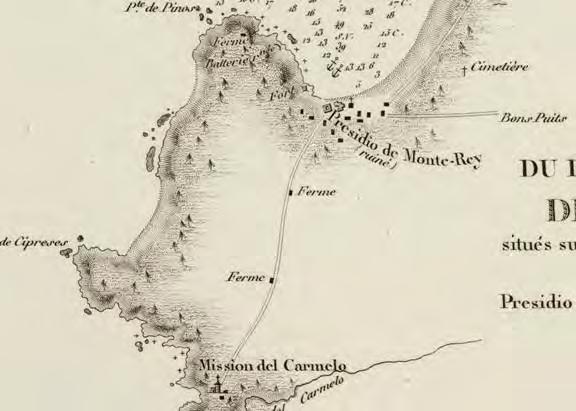
Historic Context Statement – Final
(Pre-1821)
31 October 2011 Page & Turnbull, Inc. 29
ASSOCIATED PROPERTY TYPES & REGISTRATION REQUIREMENTS
The dominant themes of this period are the pre-historic settlement of the Pacific Grove area; the Spanish colonization of the area and subsequent formation of the Monterey and Carmel missions; and the tensions that developed between the Native American and European cultures. However, few, if any, property types reflecting these themes are extant in Pacific Grove today.
Native American Resources
The numerous archaeological sites recorded in Pacific Grove clearly indicate an extended period of Native American occupation. Nevertheless, the Native American period in Pacific Grove is not represented by any extant built resources. The dwellings, sweat-lodges and other structures constructed by native peoples have disappeared over the two centuries of Euro-American presence in the area. Likewise, several sites are known to have been partially excavated or disturbed by pothunting.
However, it is probable that additional archaeological resources, such as the sub-surface remains of shell middens, campsite deposits, and burials, are present in Pacific Grove. These would most likely be encountered during excavation activities in areas near the shoreline or in proximity to sources of water. Indications of such deposits include concentrations of shells and/or bones, as well as objects including stone tools or flakes, mortars and other stone-grinding implements, and shell beads. There is also a possibility that such remains exist as submerged cultural resources located adjacent to the shoreline. If such remains are encountered, it is recommended that a qualified archaeologist be contacted to further assess the site. Any artifacts dating to the Native American period may have the potential to yield information important to prehistory and thus make the site significant under National Register of Historic Places (NR) Criterion D/ California Register of Historical Resources (CR) Criterion 4.
Spanish Period Resources
The accounts of the Vizcaíno and Portolá expeditions clearly indicate the Monterey Bay area remained occupied by Native groups throughout the Spanish period. Although many Native Americans subsequently went to live at the Carmel Mission, historical records also make it clear that independent settlements of Native peoples remained in the region throughout the late eighteenth and early nineteenth centuries. None of these, however, appear to have been located in Pacific Grove. It is likely, though, that Native Americans continued to visit the area, either sporadically as part of traditional practices, or in support of mission activities. Archaeological remains of Spanish period Native American occupation might include the presence of glass and ceramic trade beads, metal implements, and other European materials intermixed with traditional Native American artifacts. If such resources are discovered, the site may be significant under Criterion D/4 for its potential to yield information important to history.
The operations of the Carmel Mission would have included agricultural support facilities scattered throughout the Monterey Peninsula—mostly in support of ranching operations—although no direct references to facilities in Pacific Grove have been located. Likewise, even if such an operation were
Historic Context Statement – Final City of Pacific Grove Historic Context (Pre-1821) Pacific Grove, California 31 October 2011 Page & Turnbull, Inc. 30
City of Pacific Grove Historic Context (Pre-1821) Pacific Grove, California
known to have existed, it is extremely unlikely that any built resources, such as simple wood or adobe structures used for shelter or storage, would remain standing. However, indications of interactions between Native Americans and the Mission might include subsurface remains, such as European implements and possibly religious icons intermixed with traditional Native American artifacts. Mass burials associated with epidemics related to European diseases are also possible. If such resources are discovered, the site may be significant under Criterion D/4 for its potential to yield information important to history.
The only formally documented activity in Pacific Grove during the Spanish period was the construction of a small auxiliary fortification at Point Pinos. However, this battery was already in ruin by the 1840s, and its exact location is not known. The possibility does exist, however, that indications of the fortification’s construction may persist as subsurface remains. These might include artifacts related to military operations, such as musket balls, buckles, buttons or other implements. If such resources are discovered, the site may be significant under Criterion D/4 for its potential to yield information important to history.
Historic Context Statement – Final
31 October 2011 Page & Turnbull, Inc. 31
Historic Context Statement – Final of Pacific Grove Historic Context Grove, California
THIS PAGE INTENTIONALLY LEFT BLANK
City
(Pre-1821) Pacific
31 October 2011 Page & Turnbull, Inc. 32
Historic Context Statement – Final
City of Pacific Grove Historic Context (1821 – 1872) Pacific Grove, California
B. Mexican and Early American Periods (1821-1872)
The period 1821 to 1872 includes the earliest European settlement of Pacific Grove, which would lay the foundation for the area’s later development. The primary historic themes and events of this period include the following:
The impact of the Mexican Revolution, including the redistribution of church lands and the decline of the mission at Carmel.
The impact of the Mexican-American war and California statehood, including the relationship between the established Californios and the newly-arrived Americans.
The establishment of a Chinese fishing village at Point Alones.
Land acquisitions by David Jacks.
Besides the Point Pinos Lighthouse (1854), there are no known physical remnants from the Mexican and Early American Periods in Pacific Grove. However, the themes from this era set the stage for the city’s later developments.
MEXICAN PERIOD (1821 – 1846)
Following a decade-long conflict, Mexico gained independence from Spain in 1821. Under the terms of the treaty, all former Spanish territory in California was placed under Mexican jurisdiction. Monterey was established as the capital of the new Mexican “Alta California” territory. The Mexican Congress subsequently tried to encourage further settlement of California, as well as reduce the influence of the mission system. This was accomplished through a series of legislative decrees which culminated in An Act for the Secularization of the Missions of California in 1833. Intended to encourage colonization and make land more accessible to the average “Californio” (as Mexican citizens in California were called), the process of secularization involved the redistribution of the Church’s enormous land holdings through sales to private interests. It also allowed for the distribution of mission property to the Native American neophytes and released them from servitude. However, rampant corruption often led to the dispersal of the Church’s holdings in the form of large land grants, or “ranchos,” given to powerful local families or to men that had won favor during Mexico’s bid for independence.
These ranchos supported horses, sheep and basic farm crops, but were primarily cattle ranches that served the growing hide and tallow trade. This business, where cattle hides and tallow (fat used to manufacture candles) were exchanged for imported goods, emerged as the basis of California’s economy under Mexican rule. With few owners controlling most of the land, a stratified society emerged, where the average Californio, as well as the newly independent Native Americans, were typically forced to settle for work as rancho laborers. In fact, the large Californio ranching operations of this period were so dependent on native labor that Native Americans were often leased—or illegally sold—between ranch owners.50
31 October 2011 Page & Turnbull, Inc. 33
City of Pacific Grove Historic Context (1821 – 1872) Pacific Grove, California
The secularization of the Carmel mission took place in 1835. Its considerable holdings represented a rich prize. In 1825 it was reported to have more than 87,000 cattle, 1,800 horses, several hundred oxen and nine sheep farms believed to hold over 50,000 sheep.51 Even before that time, however, the lands around Monterey were already being parceled out to private interests.
Rancho Punta de los Pinos
In 1833, Jose Maria Armenta, a soldier at the Monterey Presidio, was granted Rancho Punta de los Pinos by Mexican governor Jose Figueroa. The Rancho consisted of a 2,667 acre parcel that encompassed a sizeable portion of the Monterey Peninsula. The boundaries of the grant extended in a line from Point Aulones or “Abalone Point” (later known as Point Loeb, site of today’s Monterey Bay Aquarium) to Cypress Point near Pebble Beach, including virtually all of the present-day boundaries of Pacific Grove. (Of interest, the word abalone is identified by the Merriam-Webster Dictionary as having a Spanish-American origin from the Rumsen Ohlone word “aulon.”)
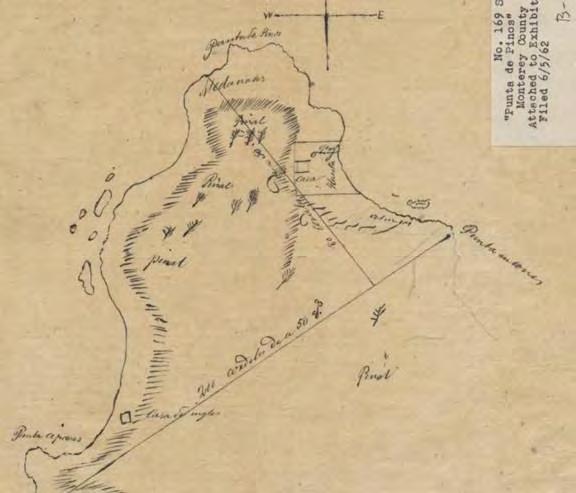 Map of Rancho Punta de Pinos, presented to the United States Land Commission in 1862. Note the Armenta adobe at upper right, as well as the nearby spring shown as a circle with a line. (Bancroft Library)
Map of Rancho Punta de Pinos, presented to the United States Land Commission in 1862. Note the Armenta adobe at upper right, as well as the nearby spring shown as a circle with a line. (Bancroft Library)
Historic Context Statement – Final
31 October 2011 Page & Turnbull, Inc. 34
Armenta constructed an adobe dwelling on his property, believed to have been located northeast of the present-day intersection of Jewell Avenue and Del Monte Boulevard in the Pacific Grove Golf Links.52 A natural spring was located north of the rancho, almost certainly the reason the building was placed where it was.53 Jose Armenta died in 1834, and Rancho Punta de los Pinos would subsequently be the subject of numerous deed transfers and land claims that took decades to resolve—largely because the land grants were rarely based on strict surveying methods.54 Few records of Armenta’s adobe have been located, although the rancho adobe does appear labeled as a “casa” on a land claim map filed for the Rancho in 1862.
Adjacent to Rancho Punta del los Pinos was Rancho El Pescadero, or “The Fisherman,” granted to Fabian Barretto, a Mexican resident of Monterey, in March, 1836. Its 4,426 acres included portions of the Del Monte Forest located south and east of the Point Pinos Rancho, as well as Cypress Point and what is today Pebble Beach.55 At both ranchos, the primary economic activity would have been comprised of cattle and sheep grazing, with Native Americans supplying most of the labor.
The products of these ranchos went to market in Monterey, which had been designated as the only official port of entry in California. A Custom House was erected in 1827, with most of the trade concluded with English and American merchants. The small settlement at Monterey also attracted foreign entrepreneurs, including the American Thomas Oliver Larkin, who arrived in Monterey during the 1830s. Larkin prospered as a merchant and financier, building the first wharf in Monterey and earning the respect of local officials. His stature was such that in 1843 the American government appointed Larkin as the first (and only) American Consul to Alta California.
By this time the United States’ westward ambitions were increasingly focused on California. Despite the territory’s immense natural wealth and commercial advantages, it remained thinly settled, and the Mexican government’s authority appeared quite weak. Notably, steady immigration during the preceding decades meant that by 1845, more foreigners—including a sizeable number of Americans—lived in California than Mexicans.56 Tensions between the Mexican and American governments were also reaching a crescendo following the U.S. annexation of Texas, which Mexico considered part of its territory.
EARLY AMERICAN PERIOD (1846 – 1872)
In 1846, war broke out between the United States and Mexico, and on July 7 naval forces of the Pacific Squadron commanded by Commodore John Sloat occupied Monterey and raised the American flag. Other forces occupied San Francisco, Los Angeles, and San Diego. The takeover at Monterey was concluded peacefully, with the Mexicans offering no resistance. Sloat left a small garrison of Marines who began impr oving defenses to better protect the town and the harbor. The new defenses were named Fort Mervine in honor of Captain William Mervine, who commanded one of the ships in Sloat’s squadron.57
Historic Context Statement – Final City of Pacific Grove Historic Context (1821 – 1872) Pacific Grove, California 31 October 2011 Page & Turnbull, Inc. 35
Historic Context Statement – Final City of Pacific Grove Historic Context (1821 – 1872) Pacific Grove, California
In February 1848, the Mexican-American War ended with the signing of the treaty of Guadalupe Hidalgo, which required Mexico to cede California to the United States. Around the same time, news of the discovery of gold at Sutter’s Mill in the Sierra Nevada reached Monterey. For the remainder of the year, most of the people working in the gold fields were Californians. But 1849 opened with gold seekers from all over the world surging into the territory. Anxious to consolidate its new territory, the U.S. government quickly embarked on a program to bring about California statehood.
In September of 1849 a constitutional convention was held in Monterey at Colton Hall. The delegates ratified the California Constitution in October, and the following year California was granted statehood. Although Monterey had for a time been a whirlwind of activity, it was soon eclipsed by San Francisco as the most important settlement in northern California. San Francisco not only offered a superior harbor, it also offered easier passage to the gold fields. Towns along the route to the gold fields also prospered, including Sacramento, which became the state capital.58
1852 Coast Survey Map
With ships pouring into the new state for the Gold Rush there was an immediate need for accurate maps of the California coastline, as well as the development of navigational aids such as lighthouses. In 1852 the U.S. Coast Survey produced an extremely detailed map of the Monterey harbor and adjacent shoreline, including Point Pinos and much of the land that would become Pacific Grove. By overlaying the 1852 Coast Survey map onto current satellite views, we are able to pinpoint several interesting features of Pacific Grove’s geography at this time.
Of particular interest, the map indicates that a road following substantially the same route as Central Avenue from Monterey to the present-day Pacific Grove border had already been developed by that time. From that point the road followed a route north of present-day Central Avenue, eventually running along what is today the northern border of the Pacific Grove Golf Links. Almost certainly, this road had been developed to serve the rancho building (likely the Jose Armenta house), which is shown as being located northeast of the intersection of Jewell Avenue and Del Monte Boulevard. The road then continued out to the northwest near the present-day intersection of Companion Way and Del Monte Boulevard. There it became a path that circled Point Pinos before continuing south, in places roughly following the alignment of Asilomar Boulevard. This may have been the remnant of an old path to the Carmel Mission.
31 October 2011 Page & Turnbull, Inc. 36
Crespi Pond appears on the map, as well as several other—likely seasonal—ponds or wet areas. These include a seasonal pond near the rancho building at the intersection of Del Monte Boulevard and Egan Avenue; another south of the intersection of 17 Mile Drive and Ripple Avenue; and another pond centered on what is today the intersection of Pacific and Caledonia avenues. This fed a small stream or erosional wash that ran northeast, breaking through the coastal rocks and creating the cove at what is today Lovers Point. The original extent of the creek that can be seen today in Greenwood Park is also shown. The map also identifies Lovers Point in Pacific Grove as Point Aulone, while today’s China Point is called out as Point Almeja, or Mussel Point.
Point Pinos Lighthouse
The 1852 Coast Survey map was produced primarily for coastal navigation, and included sailing directions at bottom. These state that the harbor is safe in all seasons, but that “in entering the Bay give the South Shore good berth in order to avoid Point Pinos (the only Pt. where the Pines reach the Sea.)” Given the danger of ships running aground at Point Pinos, a lighthouse was constructed at the Point shortly after the map was produced. The Point Pinos Lighthouse Station was constructed in 1854 on a U.S. government reservation of 92 acres.
The building featured wood-frame construction with a side-gable roof wrapping around a brick masonry tower. The light, activated in February of 1855, was originally fueled by whale oil forced up
 Excerpt from the 1852 U.S. Coast Survey map of Monterey Harbor and vicinity. Note that what would become Lovers Point is labeled as Point Aulon, while Point Alones (now China Point) is called Point Almeja, or Mussel Point. (David Rumsey Map Collection)
Excerpt from the 1852 U.S. Coast Survey map of Monterey Harbor and vicinity. Note that what would become Lovers Point is labeled as Point Aulon, while Point Alones (now China Point) is called Point Almeja, or Mussel Point. (David Rumsey Map Collection)
Historic Context Statement – Final City of Pacific Grove Historic Context (1821 – 1872) Pacific Grove, California 31 October 2011 Page & Turnbull, Inc. 37
Historic Context Statement – Final
City of Pacific Grove Historic Context (1821 – 1872) Pacific Grove, California
from a tank by a gravity-operated piston. The light from the lamp was concentrated by a Fresnel lens made in France, and a falling weight forced a shutter to move around the light, causing it to “flash” once every 30 seconds. Charles Layton was the station’s first keeper, but he was killed in 1856 while serving as a member of a sheriff’s party. His widow, Charlotte, then took over as the station keeper until 1860. At that time she married her assistant keeper, George Harris, and subsequently stepped down to become an assistant keeper once again.59 Today the lighthouse is both the oldest structure in Pacific Grove and the oldest active navigational aid on the West Coast. It was listed in the National Register of Historic Places in 1977.

The whale oil for the Point Pinos Lighthouse was quite likely processed in Monterey. In 1854, Captain John Pope Davenport—who had noted how closely gray and humpback whales passed to the coastline—began organizing all-Portuguese “shore whaling” crews which would row out to harpoon the whales during their annual migrations. The whales were then towed ashore to several beaches along Monterey Bay, including at McAbee Beach in Monterey, which would one day develop into Cannery Row. There the whale blubber was cut away and rendered into oil for lamps— including the lamp at the Point Pinos Lighthouse.60
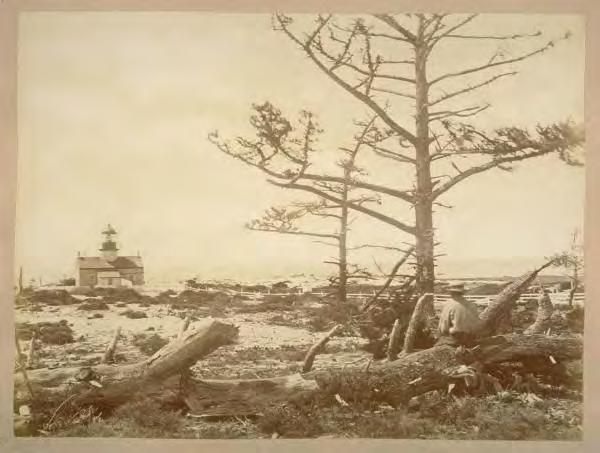
Despite the development of the Point Pinos Lighthouse, within the first few years of the Gold Rush, Monterey—which had never been a large settlement to begin with—lost its position as the capital and main port of Alta California and became little more than a quiet hamlet. While this was largely a factor of geography, development in Monterey was also stifled by the presence of complicated Mexican land grants and an established Mexican character. However, there were a few enterprising Americans who would use this fact to their advantage.61
 Point Pinos Lighthouse, 1859 (National Archives, #26-LG-56-96)
Early view of Point Pinos Lighthouse and dunes (Bancroft Library)
Point Pinos Lighthouse, 1859 (National Archives, #26-LG-56-96)
Early view of Point Pinos Lighthouse and dunes (Bancroft Library)
31 October 2011 Page & Turnbull, Inc. 38
David Jacks
Among those who had arrived in California during the Gold Rush was a budding entrepreneur named David Jacks. Born in Scotland in 1822, Jacks had immigrated to New York in 1841 before moving on to California. Before leaving, Jacks had prudently invested his savings in revolvers which he sold at considerable profit in San Francisco. In 1850 Jacks visited Monterey and decided to settle there. During the early 1850s Jacks worked as an assistant to several Monterey merchants, becoming familiar with the vagaries of local business.
Among the issues then facing Monterey was the legitimization of the town’s claims to some 30,000 acres of Pueblo Lands surrounding the settlement, which had originally been granted by the Spanish Crown. Delos Rodeyn Ashley was retained as the city attorney, and after successfully defending Monterey’s claim before the United States Land Commission, Ashley presented the city with a bill for $991.50. Lacking funds, the town passed a resolution to auction the Pueblo Lands in order to pay the fee. The sale was held in February of 1859, with the sole bidders comprised of Ashley and David Jacks, who paid slightly more than $1,000 for the entire 30,000 acres. The sale was harshly criticized, and years later it became the subject of legal challenges. The case eventually came before the U.S. Supreme Court in 1903, which ruled in favor of Jacks—who had long since acquired Ashley’s interest in the land.62
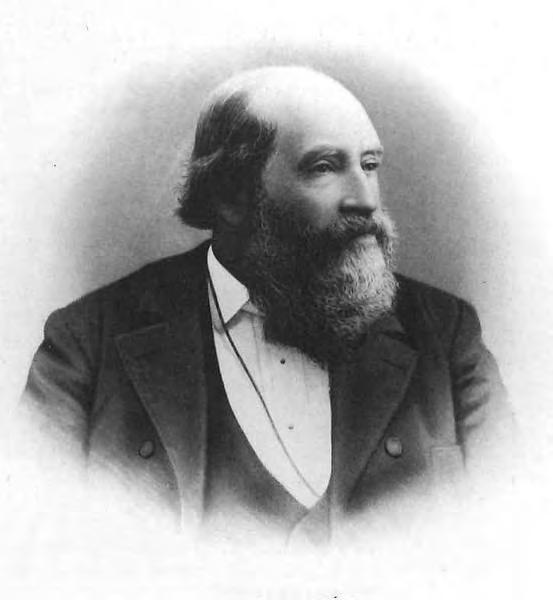 David Jacks, 1882
(Monterey Public Library, California History Room, reproduced in Images of America: Pacific Grove by Kent Seavey and the Heritage Society of Pacific Grove, p. 12)
David Jacks, 1882
(Monterey Public Library, California History Room, reproduced in Images of America: Pacific Grove by Kent Seavey and the Heritage Society of Pacific Grove, p. 12)
Historic Context Statement – Final City of Pacific Grove Historic Context (1821 – 1872) Pacific Grove, California 31 October 2011 Page & Turnbull, Inc. 39
An astute businessman, Jacks realized that many of the area’s prominent citizens—often Mexican ranch owners—were land rich, but cash poor. Jacks soon used this to his advantage, loaning money to clients with strained finances and then foreclosing on their land which had been used as collateral.63 In 1864, Jacks acquired most of the Punta de los Pinos Rancho from Darrell Stokes Gregory, and purchased another interest in the Rancho lands four years later.64 Eventually, it is estimated that Jacks controlled approximately 100,000 acres of Monterey County land—including all of what would become the city of Pacific Grove.65 For the most part, these vast landholdings were used for ranching operations, functioning much as they had during the Mexican era. In 1860, it was estimated that Monterey County included some 100,000 cattle, and raised more sheep than any other county in the United States.66
The Chinese Fishing Village
David Jacks was not the only immigrant to see potential in the Monterey area. In the early 1850s the Monterey area was settled by Chinese immigrants who had come not for gold, but for abalone. As mentioned in the previous chapter, during the Spanish period a lucrative trade in sea otter pelts had decimated the sea otter population, which allowed abalone to thrive along the Monterey Bay coastline. The area was so rich in shellfish that an “abalone rush” developed about 1853, with over 500 Chinese—many from Kwangtung Province—engaged in drying and packing abalone meat for shipment back to China. Some of the Chinese built small cabins along the shore, spreading abalone on the railings to dry. Although the Chinese fishing village would subsequently become known as the Point Alones village, it was actually located along a sheltered curve of beach at the southeastern edge of what is today the Hopkins Marine Laboratory property at China Point, labeled as “Mussel Point” on late-19th century maps. It was the largest such village in the Monterey Bay area, prospering in part because of its protection from rough seas by the tip of the point, as well as its relative isolation from Monterey.67 Around this time it appears that the Chinese leased the land from Henry De Graw, part owner of Rancho Punta de los Pinos, who constructed a small wharf to provide shipping facilities for the Rancho.68
Prior to the arrival of the Chinese, some abalone had been harvested for their shells, which were then shipped for manufacture into buttons and jewelry. But the Chinese operations were much more concentrated, and by 1856, it was observed that the Chinese had removed nearly all the abalone from the waters around Point Pinos. The Chinese then moved south, harvesting areas around Point Lobos and in the Big Sur area.69 After the abalone rush ended, some fishermen stayed on in the area. A document from 1860 shows 15 Chinese living at Point Alones, and those numbers would grow in the coming years.70
During the 1860s, the Chinese expanded their catch to include a much wider variety of fish, including rock fish, sharks, cod, halibut, mackerel and flounder. Because of the lack of refrigeration, almost all of the catch had to be prepared for shipment. Smaller fish were dried on the ground or on racks, while larger fish might be salted and hung to dry on poles. The operations grew steadily, and in 1867 the Chinese shipped some 300 tons of dried fish by steamer from Monterey.71 Around this
Historic Context Statement – Final City of Pacific Grove Historic Context (1821 – 1872) Pacific Grove, California 31 October 2011 Page & Turnbull, Inc. 40
City of Pacific Grove Historic Context (1821 – 1872) Pacific Grove, California

time the market for abalone shells also improved, and so the Chinese reworked the huge piles of discarded shells from earlier harvests and prepared them for sale to vendors in the United States, Europe and China.72 Altogether, the Chinese at Point Alones developed the first true commercial fishery on Monterey Bay, and in some ways were responsible for the most focused commercial activity in the entire Monterey area.
As it developed, the Chinese fishing village consisted of numerous small, gable-roofed, wood-frame dwellings, many of which were constructed on pilings directly adjacent to the beach where small fishing boats could be hauled up when not in use. Larger vessels could be brought ashore via a wooden boat ramp. Unlike many Chinese settlements elsewhere in California, men and women both participated in the work, and the village was very much a self-sufficient community.73 The center of spiritual life was the joss house, or temple, which stood apart from the buildings. A newspaper article in 1870 provides a description of the settlement:
“Built of redwood shakes, their houses look nevertheless as old as a suburb of Canton and there proceeds from it a most ancient and fish-like smell. There are plenty of women in the village … and as a consequence a number of small specimens of the Mongol type, toddling about among pigs and poultry. The village grows all the while and the business this people are engaged in seems to thrive.”74
Detail of U.S. Coast Survey Map, 1878. Note that the Chinese fishing village and the Pacific Grove Retreat are both clearly marked. (Reproduced in Chinese Gold, p. 58)
Historic Context Statement – Final
31 October 2011 Page & Turnbull, Inc. 41
By the late 1860s the Chinese had begun paying rent to David Jacks, who now owned the vast majority of the Point Pinos Rancho. Jacks charged the Chinese two hundred dollars annually to be paid in quarterly installments. The Chinese retained ownership of their buildings, and were entitled to collect any fallen timber in the pine forests above the village for heating and cooking.75 The village’s association with David Jacks probably gave it some measure of protection from outside interference, and Jacks does not appear to have objected to their continued operations on his land. Indeed, the Chinese were by far the most numerous tenants on Jacks’ land in what would become Pacific Grove.
ASSOCIATED PROPERTY TYPES & REGISTRATION REQUIREMENTS
The primary themes of this period are the redistribution of land in Northern California and the subsequent decline of the mission at Carmel; the establishment of a Chinese fishing village at Point Alones; and land acquisition by entrepreneur David Jacks. However, few, if any, property types representing these themes are still extant in Pacific Grove today.
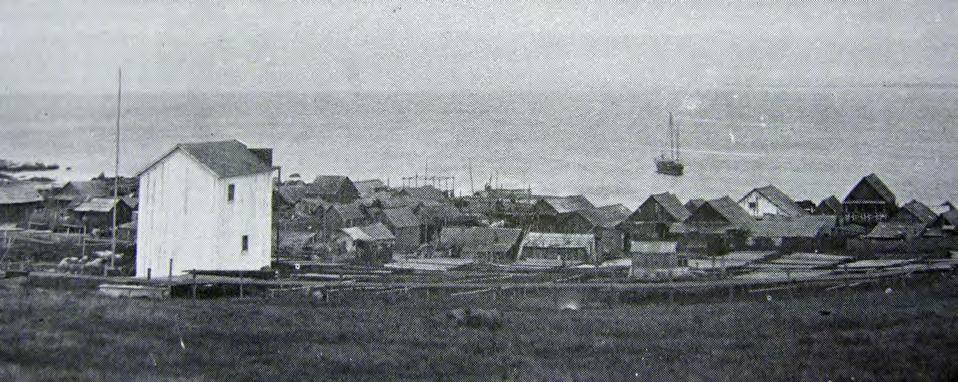
Mexican Period Resources
This period marks the first formal subdivision of the land that would become Pacific Grove, and the historical record clearly indicates that a rancho house was constructed circa 1834 for Jose Maria Armenta near the present-day intersection of Jewell Avenue and Del Monte Boulevard. This house was shown on an 1852 U. S. Coast Survey map, but no drawings or images of it are known, and it does not appear on any subsequent maps of the area. It is presumed to either have been in ruins or dismantled sometime prior to 1875. The possibility does exist, however, that subsurface evidence of the Armenta rancho house may remain. This evidence might include features such as the remnants of foundation walls or post holes. It might also include evidence of activity areas—including garbage pits—containing concentrations of glass and ceramics consistent with the period. If such resources are discovered, it is recommended that a qualified archaeologist be contacted to further assess the
Point Alones Village, circa 1880s (Pat Hathaway Collection, reproduced in Chinese Gold, p. 156)
Historic Context Statement – Final City of Pacific Grove Historic Context (1821 – 1872) Pacific Grove, California 31 October 2011 Page & Turnbull, Inc. 42
City of Pacific Grove Historic Context (1821 – 1872) Pacific Grove, California
area, as the site may be significant under Criterion D/4 for its potential to yield information important to history.
Early American Period Resources
By far the most significant built resource remaining from the Early American Period is the Point Pinos Lighthouse, constructed in 1854, and today the oldest active navigational aid on the West Coast. It symbolizes early efforts by the American government to consolidate California’s entry into the union, as well as enhance the region’s prospects for trade and commerce. There is no need to discuss registration requirements, however, as the lighthouse is already appropriately recognized as a historic resource and was listed in the National Register of Historic Places in 1977.
Despite an extended period of occupation by Chinese fisherman at Point Alones, there are no other built resources associated with the Early American Period extant in Pacific Grove. The fishing village was largely destroyed by fire in 1906, and all the surviving buildings were removed from the site. However, it is likely that subsurface remains of the village remain—including the vestiges of a Chinese cemetery that was known to be located at the site. Evidence of Chinese occupation would include items such as broken glass and ceramics consistent with the period, as well as nails, hooks and other items associated with fishing culture. If such resources are discovered, it is recommended that a qualified archaeologist be contacted to further assess the area, as the site may be significant under Criterion D/4 for its potential to yield information important to history.
The Point Pinos Lighthouse, constructed in 1854, is the only extant resource from this period.
Historic Context Statement – Final
31 October 2011 Page & Turnbull, Inc. 43
Historic Context Statement – Final City of Pacific Grove Historic Context (1821 – 1872) Pacific Grove, California
THIS PAGE INTENTIONALLY LEFT BLANK
31 October 2011 Page & Turnbull, Inc. 44
Historic Context Statement – Final City of Pacific Grove Historic Context (1873 – 1902) Pacific Grove, California
C. Early Development of Pacific Grove (1873 - 1902)
The period 1873 to 1902 includes numerous crucial events that helped shaped the essential character of Pacific Grove—both physically and culturally. The primary historic themes and events of this period include the following:
The establishment of the Pacific Grove Retreat Association and the early development of the Pacific Grove Retreat.
The acquisition of Pacific Grove by the Pacific Improvement Company and that company’s impact on development of the area, including the extension of the original retreat boundaries and sale of lots.
The influence of Chautauqua and other social and religious organizations on the culture and character of the city.
The transition of the Retreat from a summer encampment to a city, including the development of water, sewage and transportation infrastructure, as well as the emergence of residential, commercial and civic development patterns.
The development of recreational facilities and promotion of the area as a tourist attraction.
The contributions of the Chinese fishing village to local culture.
In some respects, 1889 might be considered the watershed year of the period as it marked the incorporation of the city and the arrival of the Southern Pacific Railroad. However, neither of these events led to a spike in population or a palpable shift in building typologies. Pacific Grove first began to develop in earnest with houses for year-round occupancy in the mid-1880s, and the city continued to grow through the turn of the century in a fairly steady arc with late Victorian architectural styles predominating. The decision to end this period in 1902 is related to events that occurred over the following two years that marked clear departures from previous patterns. These included a dramatic redevelopment of the beach area at Lovers Point with expanded tourist facilities, as well as the introduction of new architectural styles and building materials—particularly in commercial buildings. Likewise, the next major additions to the city were not made until 1905 and 1907 respectively.
This period witnessed the establishment of residential and commercial development patterns that would guide the city’s development through the mid-twentieth century. The overwhelming majority of surviving buildings from this period are resi dential, primarily consisting of single-family residences, with only a handful of multi-family buildings. Residential architecture of the period encompasses a wide range of Victorian-era styles. However, because Pacific Grove was a resort area, stylistic “rules” were likewise relaxed, and thus most residences are vernacular in nature and may loosely be grouped under the heading of Folk Victorian. Commercial properties, civic & public assembly properties, and cultural landscape elements associated with the significant themes of the “Early Development of Pacific Grove” period are also present. Although a handful of light industrial properties existed during this period, none appear to be extant today.
31 October 2011 Page & Turnbull, Inc. 45
Historic Context Statement – Final City of Pacific Grove Historic Context (1873 – 1902) Pacific Grove, California 31 October 2011 Page & Turnbull, Inc. 46 DAVID 17 MILE SINEX FOREST 9OCEANVIEW TH 16TH A S L O M A R LINE 117TH 9TH 7TH 18TH PICO CEDAR GIBSON 8TH IRVING PRESCOTT JEWELL 4TH PINE CONGRESS OAK 6TH CENTRAL JUNIPERO LILY 11TH 12TH 10TH RECTRAIL WALNUT PARK FOUNTAIN CARMEL AGRAND LDER LAINE 5TH 3RD SUNSET WOOD HOFFMAN EARDLEY 2ND C R O C K E R 1ST 15TH G R O V E A C R E BELDEN 13TH SURF ARCHER LOCUST DELMONTE WILLOW SPENCER BALBOA BAYVIEW A WITHERS GRANITE CREST SHELL EGAN HILLCREST MONTEREY TERRY CHESTNUT SPRUCE GRACE RIPPLE PARCE MAPLE LYNDO FILMORECYPRESS EVANS MORSE MERMAID NEWTON SLOAT MELROSE DRAKE SEAPALM PACIFIC DENNETT CORAL HAWTHORNE RIDGE SHORT FOAM MCCLELLAN 14TH ARENA BEAUMONT SP RAY DEWEY R A I LR OA D R I G H T O F WA Y RICKETTS ROW E V E R G R E E N SIREN GROVE LIGHTHOUSE SPAZIER BENTLEY BEACON RUTH ACACIA GATE 20TH OLMSTEAD BRIGGS A C R O P O L I S ROSEMONT MARINO PINES CALEDONIA TR EA SURE MONARCH DAY SPANISH BAY PETRA PAC I F I C G R OV E UNION TODD GARDEN WALCOTT L A U R E AVALON LORELEI FOREST PARK MARINE MOSS 19TH PINE CYPRESS 13TH SUNSET CROCKER JEWELL 14TH 14TH LIGHTHOUSE 2ND 2ND LAUREL PARK LOBOS NEWTO LIGHTHOUSE OAK SHELL SHORT SPRUCE SLOAT CONGRESS CityofPacificGrove YearBuilt:1873-1902 1873-1889 1890-1899 1900-1902 Page&Turnbull,Inc./24June2011 ° Properties constructed during “Early Development of Pacific Grove” period (1873-1902) (Page & Turnbull)
Historic Context Statement – Final City of Pacific Grove Historic Context (1873 – 1902) Pacific Grove, California 31 October 2011 Page & Turnbull, Inc. 47 DAVID 17 MILE SINEX FOREST 9OCEANVIEW TH 16TH A S L O M A R LINE 117TH 9TH 7TH 18TH PICO CEDAR GIBSON 8TH IRVING PRESCOTT JEWELL 4TH PINE CONGRESS OAK 6TH CENTRAL JUNIPERO LILY 11TH 12TH 10TH RECTRAIL WALNUT PARK FOUNTAIN CARMEL AGRAND LDER LAINE 5TH 3RD SUNSET WOOD HOFFMAN EARDLEY 2ND C R O C K E R 1ST 15TH G R O V E A C R E BELDEN 13TH SURF ARCHER LOCUST DELMONTE WILLOW SPENCER BALBOA BAYVIEW A WITHERS GRANITE CREST SHELL EGAN HILLCREST MONTEREY TERRY CHESTNUT SPRUCE GRACE RIPPLE PARCE MAPLE LYNDO FILMORECYPRESS EVANS MORSE MERMAID NEWTON SLOAT MELROSE DRAKE SEAPALM PACIFIC DENNETT CORAL HAWTHORNE RIDGE SHORT FOAM MCCLELLAN 14TH ARENA BEAUMONT SP RAY DEWEY R A I LR OA D R I G H T O F WA Y RICKETTS ROW E V E R G R E E N SIREN GROVE LIGHTHOUSE SPAZIER BENTLEY BEACON RUTH ACACIA GATE 20TH OLMSTEAD BRIGGS A C R O P O L I S ROSEMONT MARINO PINES CALEDONIA TR EA SURE MONARCH DAY SPANISH BAY PETRA PAC I F I C G R OV E UNION TODD GARDEN WALCOTT L A U R E AVALON LORELEI FOREST PARK MARINE MOSS 19TH PINE CYPRESS 13TH SUNSET CROCKER JEWELL 14TH 14TH LIGHTHOUSE 2ND 2ND LAUREL PARK LOBOS NEWTO LIGHTHOUSE OAK SHELL SHORT SPRUCE SLOAT CONGRESS ON NION ARK St.JohnCoxSurvey (1875) TH RANITE RESS PKH SecondAddition (1887) IBSON ThirdAddition (1887) T7TH H THREY E6 FirstAddition (1887) CityofPacificGrove Subdivisions&Annexations (1873-1902) Page&Turnbull,Inc./24June2011 ° Subdivisions and additions platted during “Early Development of Pacific Grove” period (1873-1902) (Page & Turnbull)
FORMATION OF THE PACIFIC GROVE RETREAT
The origins of Pacific Grove as a religious retreat can be traced directly to the development of Ocean Grove, a Methodist campground founded along the New Jersey shoreline in 1869. There, religious-minded persons from cities such as New York and Philadelphia could gather to discuss spiritual matters in a rustic setting free from urban distractions and workaday responsibilities. The formation of a religious retreat was not a unique concept, but rather an outgrowth of the revival meetings held in early nineteenth century America, when a shortage of formal religious facilities in frontier communities inspired itinerant preachers to hold outdoor revivals. The popularity of these so-called “camp meetings” grew throughout the nineteenth century, leading to the development of annual encampments in several locations, including Ocean Grove, the Hollow Rock Holiness Camp Meeting in Toronto, Ohio, and the Methodist Campground in Merrick, New York.
As word spread of the success of Ocean Grove, attendees of the 1872 California Annual Conference of the Methodist Church formally began discussions about establishing a West Coast campground. Among those who would have been aware of these discussions was Reverend W. S. Ross, a Methodist clergyman from Alameda. In 1873, Ross visited the Monterey area in the hope that his deteriorating health might be improved by the fresh air. During his visit, Ross evidently met with David Jacks who invited the clergyman to build a tent house on land located near today’s Lighthouse and Fountain Avenue. Ross’ health improved, and he was soon joined by relatives and other visitors that included Methodist Bishop Jesse T. Peck. Subsequent to these visits, David Jacks contacted Reverend George Clifford, then the presiding elder of the San Francisco district, about the possibility of using his land near Monterey for a Methodist campground.76
In 1874, Bishop Peck formed a committee to investigate the formation of a retreat that included himself, Reverend Clifford, and ministers George Ash of Salinas and J. W. Ross of Alameda. The group then traveled to Salinas where they were met by David Jacks and given a tour of his lands. Impressed with the magnificent location, the committee soon entered into negotiations with Jacks. These culminated in Jacks formally offering 100 acres of land for the development of a summer resort during the 23rd California Annual Conference of the Methodist Church held in September 1874.77 Around this same time—perhaps as a gesture of goodwill—Jacks permitted Reverend A. C. McDougall to construct a house on his lands. Located at 142 Pacific Avenue, this is today the oldest surviving house in Pacific Grove.78 According to local historian Don Beals, however, the house was subsequently enlarged and remodeled after its construction.79
Prior to concluding their agreement with David Jacks, the Methodist Episcopal Church filed articles of incorporation for the Pacific Grove Retreat Association (PGRA) on June 15, 1875, at the Monterey County Clerk’s office. The Association was governed by a Board of Trustees that included Reverend Clifford and Reverend Ross, as well as Reverends Frank Jewell and Otis Gibson of San Francisco.
On July 31, 1875, the PGRA finalized its agreement with David Jacks. It outlined the subdivision of 100 acres of Jacks’ land for use as a Christian resort. Five of the 100 acres were donated outright by
Historic Context Statement – Final City of Pacific Grove Historic Context (1873 – 1902) Pacific Grove, California 31 October 2011 Page & Turnbull, Inc. 48
Jacks for the purpose of camp meetings, while the other 95 acres were to be divided into lots. These lots could then be sold or leased by Jacks to people who were willing to submit to the Retreat Association’s rules. Jacks would then split any profits from the sales with the PGRA. Jacks also agreed to loan the PGRA funds for improving the land, which was to be repaid by half the proceeds of the sale of lots. Further, until at least 300 lots were sold, Jacks would pay half the salary of a caretaker for the property. One acre of lots also had to be sold for at least $1,000.80
In return, the PGRA agreed to pay half the taxes levied on unsold lots, as well as make improvements such that the area would be “suitable as a place of Christian sea-side resort … for the purpose of an annual camp meeting of fourteen days.” With both parties in agreement, the PRGR purchased 95 acres, plus the five acres donated by Jacks, for one dollar.81
For David Jacks, the agreement was both altruistic and business-savvy. While the PGRA was able to acquire lands in a prime location, Jacks also was assured the profits from the sale of half the lots. The PGRA was also required to make improvement to the grounds, further increasing the value of Jacks’ land. As one author observed,
The way the contract was laid out virtually assured Jacks of making a profit. If the campground were an enormous success he could count on revenue from the sale of the newly established lots. If it was a failure and the PGRA did not sell as many lots as they expected he would still benefit. If they couldn’t sell enough lots the Association would not have the money to refund Jacks’ initial loan and the lots would revert back to his ownership … All at little expense to himself and with the bonus of having previously unused land cleared, set into lots, and partially occupied … He set himself up nicely regardless of the fate of the Retreat. At the same time it appeared he was making a generous donation to a good Christian cause – which he actually was.82
SURVEY AND SUBDIVISION
In July 1875 a survey map of the Pacific Grove Retreat was filed with the Monterey County Recorder’s Office. Prepared by surveyor St. John Cox, the map not only provided the initial blueprint for subsequent development of the city, but is also instructive as to the ambition of the Retreat’s founders. Laid out largely in a traditional grid pattern, the map depicts the boundaries of the original Retreat as Monterey Bay on the north, Lighthouse Road on the south, 1st Street on the East, and Ocean View Avenue (now Pacific Avenue) on the west. It is important to note that the map does not show all the land donated by Jacks, but rather only the land that the PGRA planned for initial improvements.83
The use of a grid system with uniform lot sizes was not only the most expedient method for surveying the land, but also maximized the number of lots that could be sold. Typically, the lots in Pacific Grove measured 30 feet wide by 60 feet deep. By conventional standards these were
Historic Context Statement – Final City of Pacific Grove Historic Context (1873 – 1902) Pacific Grove, California 31 October 2011 Page & Turnbull, Inc. 49
Historic Context Statement – Final
City of Pacific Grove Historic Context (1873 – 1902) Pacific Grove, California
relatively small. But at the time of the Retreat’s founding it was envisioned that most would be used for camping purposes, rather than the erection of permanent homes. This unusual lot pattern can still be seen today in the residential neighborhoods north of Lighthouse Avenue.
Street and avenue widths varied. Generally speaking, most avenues were 50 feet wide, while street widths, such as those between 1st and 10th Street, alternated between 30 and 40 feet in width every other block. The narrowest streets, of which there were few, included Union and High (now Ricketts), which were only 20 feet wide. The two largest thoroughfares were Grand Avenue and Lighthouse Road, which respectively measured 75 feet and 100 feet wide.
1894 map of the entire St. John Cox Survey (City of Pacific Grove, reproduced in Images of America: Pacific Grove, p. 44)
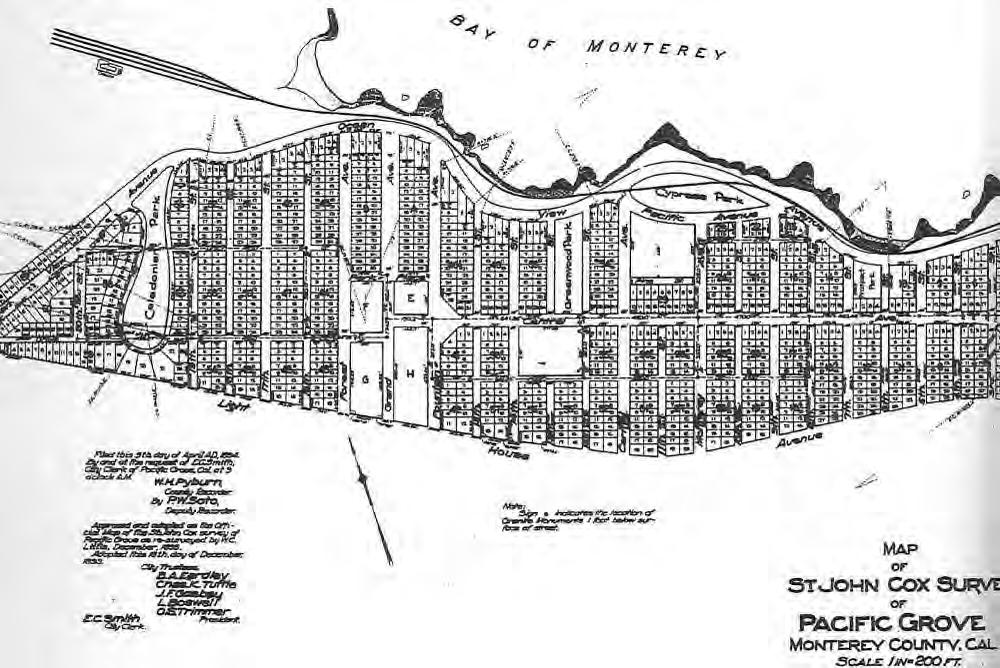
In total there were 64 blocks, but these varied in size depending on the arrangement of intersecting streets or natural features. For example, the blocks bounded by Grove, Union, Forest and 19th Street uniformly included 24 lots. However, some of the blocks located closer to the waterfront, such as the block north of Central Avenue between 5th and 6th streets, might contain as few as 8 lots.
The lack of uniform block sizes was also determined in part by Grand Avenue, which served as a crucial dividing line between the two halves of the Retreat. Other than Lighthouse Road, none of the east-west streets located east of Grand Avenue were connected to any the east-west streets located west of Grand Avenue. The effect of this can still be seen today on the south side of Jewell
31 October 2011 Page & Turnbull, Inc. 50
City of Pacific Grove Historic Context (1873 – 1902) Pacific Grove, California
Park, where Central Avenue has to jog to the south to connect with what was formerly called Grove Street.
Other irregular blocks resulted from the creation of three parks, all of which survive today: Cypress Park, Caledonian Park and Greenwood Park. While Cypress Park appears to have been developed to take advantage of the coastal views, both Caledonian Park and Greenwood Park are likely products of the local topography. In particular, Greenwood Park was placed astride a small creek that was not easily developed, but which could provide fresh water. Both the aforementioned 1852 Coast Survey map, as well as an additional map prepared in 1878, indicate the creek originated at point near the intersection of present-day Pine and 15th streets and then traveled northeast, crossing Lighthouse Avenue around present-day 14th Street, and Central Avenue near 12th Street.

Similarly, the previously-mentioned drainage wash near Lovers Point is shown originating near the north end of Caledonian Park, which was “for many years a swamp … drainage from Lighthouse Avenue made a lake on the ground in wintertime.”84 The drainage from this area flowed through a ravine and emptied into the beach area at Lovers Point. Given the extremely rocky topography along most of Pacific Grove’s shoreline, the presence of this sheltered, naturally-formed beach area suitable for bathing was likely a strong influence on the decision to locate the primary facilities of the Retreat almost directly south of this area.
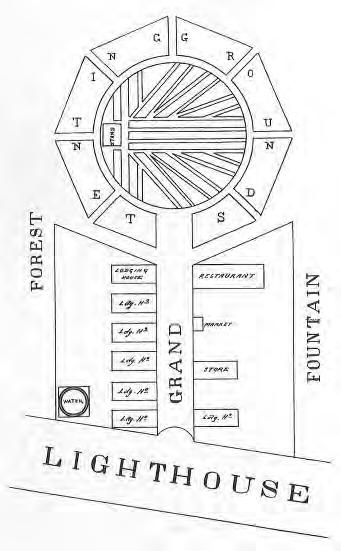 St. John Cox Map of meeting ground, 1875. (Monterey Public Library, California History Room, reproduced in Images of America: Pacific Grove, p. 24)
Preacher’s Stand, 1880. (Photo by C.W.J. Johnson; Pat Hathaway Collection, reproduced in Images of America: Pacific Grove, p. 8)
St. John Cox Map of meeting ground, 1875. (Monterey Public Library, California History Room, reproduced in Images of America: Pacific Grove, p. 24)
Preacher’s Stand, 1880. (Photo by C.W.J. Johnson; Pat Hathaway Collection, reproduced in Images of America: Pacific Grove, p. 8)
Historic Context Statement – Final
31 October 2011 Page & Turnbull, Inc. 51
As shown on the St. John Cox survey map, the focus of the Retreat was located a block southeast of the beach area, where Central and Grand avenues converged on a large square with an octagonalshaped meeting ground at its center. This was to be the focal point of the camp meetings, and would include a large wooden Preacher’s Stand completed in July 1875 by Herman Prinz, a building contractor who operated a lumber mill in Monterey.85 The Preacher’s stand was surrounded by bench seating arranged in a 200-foot circle, with aisles ranging from four to twelve feet in width. This seating was in turn surrounded by an area where a ring of tents could be pitched.86 On the east and south sides of meeting ground, the streets responded to the octagonal layout and were clipped at a 45-degree angle—a design that is still in evidence at the intersection of Central and Fountain avenues. The map also depicts a fountain at the intersection of Central and Fountain avenues, which is almost assuredly the namesake of the latter street.
THE FIRST CAMP MEETING
The St. Cox survey map indicates that the central area of the Retreat was already under development prior to filing the map with the Monterey Recorder’s Office. Almost certainly, this construction activity was being rushed to completion in preparation for the first camp meeting, scheduled to be held in August, 1875. As early as May 1st, the Monterey Weekly Herald had announced that basic plans for the Retreat were complete and that work had begun clearing the grounds. By the time the St. Cox survey map was filed, the area south of the Preacher’s stand was shown as having a series of buildings located on either side of Grand Avenue. These included a 33’ x 90’ restaurant and two camp stores on the east side of Grand Avenue, all of which were nearing completion by mid-July.87
These simple, wood-frame buildings were quickly joined by a grocery provisional store, likely enclosed by tents on the side, and a small lodging house office located at the northeast corner of Lighthouse Road and Grand Avenue. Six wood-frame tent dormitories were also built on the west side of Grand Avenue, all measuring 24 x 50 feet.88 In addition, a bath house was constructed at Lovers Point, with Reverend Alexander McDougall as its first custodian.89
The first official camp meeting at the Pacific Grove Retreat opened on August 8, 1875, and continued for three weeks until August 29.90 In addition to the lodging houses constructed along Grand Avenue, the area surrounding the Preacher’s stand was available for free to campers. Tents could also be purchased or rented from the Pacific Grove Retreat Association at reasonable prices.91 Attendees at the camp meeting could purchase meals from the restaurant on a meal ticketing system, priced at $6 a week, $1 a day or 50 cents a meal.92
While some water for the encampment may have been supplied by the stream in Greenwood Park, the main supply was the spring formerly used to supply the Armenta ranch, located approximately near the present-day intersection of Jewell and Del Monte avenues. Here, on land owned by David Jacks, were constructed two water tanks: the first tank was 60 feet tall and held 6,000 gallons, while the second held 15,000 gallons. Water was delivered by gravity through pipes to the Retreat grounds.93 Water from the tanks was also sprinkled throughout the retreat grounds to hold down dust.94 In 1884, the tanks were razed as new water supplies became available.
Historic Context Statement – Final City of Pacific Grove Historic Context (1873 – 1902) Pacific Grove, California 31 October 2011 Page & Turnbull, Inc. 52
While much of the Retreat Association’s agreement with David Jacks focused on the sale of lots, it does not appear that the first encampment was used to in any way encourage real estate speculation. Rather, it was hoped that visitors would simply delight in the area’s natural splendor and want to purchase lots for future use.95 The first lot sales were not concluded until the final week of the encampment on August 26, 1875. Among the initial purchasers were Dr. Frank F. Jewell, Dr. Thomas Sinex, Edward Berwick, James A. Clayton and Reverend J. W. Ross. Ross was also named first Superintendant of the Retreat, and would be succeeded in 1876 by George O. Ash, who had been on the initial committee that met with David Jacks.96
DEVELOPMENT UNDER DAVID JACKS
Although by many measures the first encampment had been a success, the sale of lots was not sufficient for the Pacific Grove Retreat Association to repay its loan to David Jacks. On May 8, 1876, all land at the Pacific Grove Retreat—other than those lots already sold—reverted to David Jacks.97 Eager to see the value of his lots increase, Jacks continued a program of improvements, including “building bridges over gulches, felling trees and clearing avenues, building fences and stiles, and planting cypress and eucalyptus trees.”98 At this time, nearly all of the streets at the Retreat were largely unimproved, as were the lots. Early photos show that even Grand Avenue, the focus of the Retreat, was thick with large pine trees.
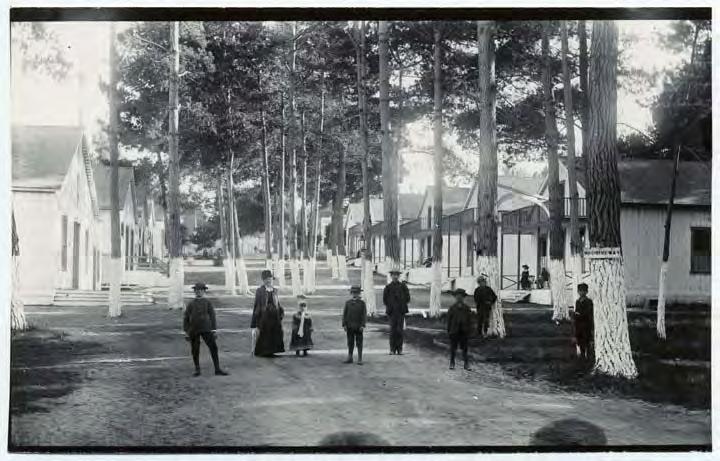 Early view of Grand Avenue, circa 1880 (California State Library)
Early view of Grand Avenue, circa 1880 (California State Library)
Historic Context Statement – Final City of Pacific Grove Historic Context (1873 – 1902) Pacific Grove, California 31 October 2011 Page & Turnbull, Inc. 53
Historic Context Statement – Final City of Pacific Grove Historic Context (1873 – 1902) Pacific Grove, California
Despite the Retreat’s rusticity and relative isolation, Jacks also facilitated the first important transportation connections to Pacific Grove. In 1874—around the same time that negotiations began for the formation of the Pacific Grove Retreat—David Jacks and Salinas landowner Carlisle S. Abbott organized the Monterey & Salinas Valley Railroad. This was a narrow-gauge line that would connect their two towns and mutually improve the value of their lands. Jacks donated almost $70,000 toward construction, and the line was completed in October 1874 with a depot in Monterey. However, the line would be plagued by repeated failures of its trestle over the Salinas River.99 In those cases, another option was travel via the steamship Constantine, which made regular passage between San Francisco and Monterey.100
With the addition of the narrow-gauge railroad, visitors to Pacific Grove could travel via the Southern Pacific Railroad to Salinas, then transfer to David Jacks’ line for the trip into Monterey. There, they could transfer for a carriage ride to the campgrounds, which would follow the route of the recently-completed Lighthouse Road into Pacific Grove. While a footpath from Monterey into Pacific Grove had been previously established, Lighthouse Road was not formally improved until 1874, when Captain Allen Luce, keeper of the Point Pinos Lighthouse, felled trees to cut a trail through the pine woods to Monterey.101 This made it much easier to deliver goods to the Lighthouse station, which previously had to be brought in by sea.102
Jacks’ improvement program for the Pacific Grove Retreat received a crucial boost in 1878 with the arrival of Joseph Oscar Johnson, who was hired by Jacks as Superintendant of the Retreat at a salary of $75 a month. His duties included greeting visitors at the Retreat office, located near a stile gate entrance at Lighthouse and Grand avenues. Johnson was in charge of assigning rooms or camping plots, collecting fees and enforcing rules. At the time, only eight wood-frame cottages had been built at the Retreat—along with 40 to 50 tent frames. During the off-season, the Retreat was nearly empty. Johnson headed one of only two families that lived at the Grove year round. Even as late as 1881, only eight families called Pacific Grove their permanent home.103
Robert Louis Stevenson, who visited Pacific Grove during 1879, wrote glowingly of the splendid isolation:
After a while the woods began to open, the sea to sound nearer at hand. I came upon a road, and, to my surprise, a stile. A step or two farther, and, without leaving the woods, I found myself among trim houses. I walked through street after street, parallel and at right angles, paved with sward and dotted with trees, but still undeniable streets, and each with its name posted at the corner, as in a real town … Facing down the main thoroughfare—“Central Avenue,” as it was ticketed—I saw an open-air temple, with benches and sounding-board, as though for an orchestra. The houses were all tightly shuttered; there was no smoke, or sound but of the waves, no moving thing. I have never been in any place that seemed so dreamlike.104
31 October 2011 Page & Turnbull, Inc. 54
The quiet of the winter months was in stark contrast to the summer encampments, which Stevenson described as a time when “crowds come to enjoy a life of teetotalism, religion and flirtation.” Under Johnson’s steady management, the summer encampments continued to grow steadily during the late 1870s. The focus of the retreats remained prayer and spiritual meditation, but visitors also enjoyed picnicking, fishing and buggy rides to nearby scenic points. Recreational opportunities were also enhanced by Joseph Johnson, who developed a rifle range and horse-powered swing. Beginning in 1879, visitors to the beach cove could also rent rowboats from James Hogan, or enjoy bathing at the bath house, which early photos indicate stretched across the previously-mentioned ravine. 105
THE ARRIVAL OF THE CHAUTAUQUA
As the 1870s came to a close, the summer season at the Pacific Grove Retreat had already been extended to accommodate week-long retreats by groups that were not exclusively Methodist. Such a development was not problematic for Pacific Grove’s founders. True, the Retreat had been founded by Methodist leaders based on Methodist teachings, but it was meant only to be a Christian seaside resort, not a strictly Methodist resort.106 In time, the accommodation of multiple groups over the summer season became the norm for Pacific Grove, allowing it to function something like a modern conference center. Permitting other Christian groups to use the Retreat also promised to enhance its development.
 Retreat office and stile gate entrance at Lighthouse and Grand avenues, 1885. Joseph Oscar Johnson (lower right) was hired by Jacks as Superintendant of the Retreat, and was responsible for greeting visitors at the gate. (Photo by C.W.J. Johnson. California State Library)
Retreat office and stile gate entrance at Lighthouse and Grand avenues, 1885. Joseph Oscar Johnson (lower right) was hired by Jacks as Superintendant of the Retreat, and was responsible for greeting visitors at the gate. (Photo by C.W.J. Johnson. California State Library)
Historic Context Statement – Final City of Pacific Grove Historic Context (1873 – 1902) Pacific Grove, California 31 October 2011 Page & Turnbull, Inc. 55
Historic Context Statement – Final City of Pacific Grove Historic Context (1873 – 1902) Pacific Grove, California
In 1879, the California Sunday School Association, which included a number of prominent Christian leaders, arrived at the Retreat a week prior to the Methodist encampment.107 The visit of the Sunday School Association, held from June 27 to July 4, received extensive coverage in the California Christian Advocate which mentioned: “The grounds are in better condition than we ever saw them on former occasions. A large number of good cottages have been erected. They are neat and tasteful, and some of them are quite sufficient for permanent family residences. A few of the homes are enclosed with good fences, well-painted.”108
Among those in attendance at the Sunday School Conference was Methodist Episcopal Reverend John Heyl Vincent.109 Vincent had founded the Sunday School Teacher publication in 1866, and became editor of the Sunday-School Journal in 1868.110 In 1874, Vincent teamed with Lewis Miller to organize a summer assembly for Sunday school teachers near Lake Chautauqua in New York. Although it was governed by the Sunday School Association of the Methodist Episcopal Church, the meeting also encouraged Baptist, Presbyterian and Congregational members to attend. One of Pacific Grove’s founders, Bishop Jesse Peck, also participated in these early New York assemblies.111
By 1878, the New York meeting grew to include the Chautauqua Literary and Scientific Circle (CLSC), which consisted of a four-year adult-education reading course.112 Within a few years the Chautauqua had grown into a national movement for self-improvement through popular education. At Chautauqua meetings, participants attended public lectures on a variety of theological and scientific subjects, listened to concerts and enjoyed dramatic performances. By the turn of the century there were over 10,000 CLSC circles in the United States, which led one author to observe that it is “probable that no other single wholly American institution, with the possible exception of the Model T, left a greater imprint upon the social and cultural life of rural communities.”113
The first Chautauqua meeting in Pacific Grove commenced on July 4, 1880, and drew over 500 people. Guests were charged the same rental rates as those for the Methodist encampment.114 It included a course with lectures in Bible Studies, Marine Botany, General Biology, Astronomy, and Egyptology. John Muir was also expected to attend. The cost was $2.50.115 J. J. Shinaberger, who visited Pacific Grove in 1880, recalled:
Tents, tents! Nothing but tents. The woods was full of them. They were of all sizes and styles, but mostly new … David Jacks had a monopoly of and did a brisk business in, renting tents to the Chautauquans and others in attendance at the meeting … Lighthouse Road … was the only thoroughfare in or out, and it was dusty, whew! …. Forest Avenue was the first lateral main street to be opened.116
31 October 2011 Page & Turnbull, Inc. 56
The Chautauqua Hall
The arrival of the Chautauqua in Pacific Grove was to have profound influence on the character of the Retreat, and would become a fixture of the summer season for the next 45 years. As early as 1883, the Chautauqua encampment attracted some 1,200 visitors.117 Among the first tangible physical outgrowths of the Chautauqua movement was the construction of the Chautauqua Hall in 1881. Located at the southeast corner of 16th and Grove (now Central) streets, the wood-framed Chautauqua Hall features a simple, utilitarian design, with board-and-batten cladding and a gable roof. It is unquestionably one of the most significant buildings in Pacific Grove surviving from the earliest years of the Retreat’s development, and is designated as California Historical Landmark 839.
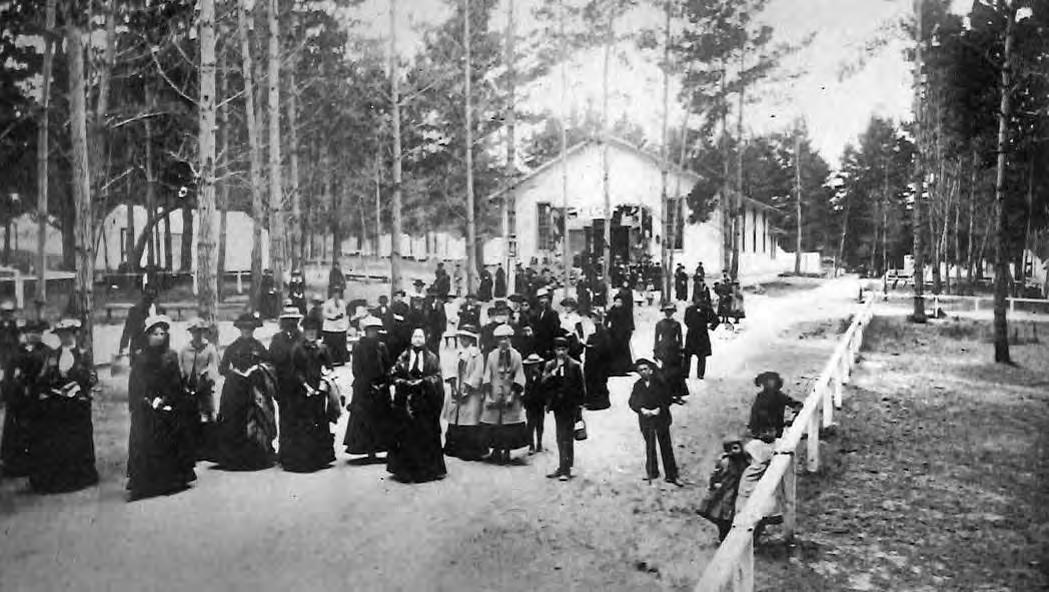
From the outset, the Hall was a multi-use facility. During summer encampments it provided a venue for services and Sunday schools led by clergymen from different denominations.118 During the offseason it was used for tent storage. It remained the primary meeting venue in the city until approximately 1889, when meetings moved to the newly-constructed Methodist Church Assembly Hall.119 Around the same time, the old Preacher’s stand was dismantled and fitted for a stable. By 1916 it had been moved to 311 Forest Avenue on a lot owned by J.A. Pell (no longer extant).120
The arrival of the Chautauqua also strongly influenced the intellectual development of Pacific Grove. It brought important speakers and introduced an educated class of people to the area, including scientists, philosophers, artists and poets. By the mid-1880s, Pacific Grove would organize its first museum through the efforts of Josiah Keep of Mills College, and Mary E. B. Norton, a botany instructor at the San Jose Normal School, who became the Chautauqua Museum’s first
Early view of Chautauqua Hall, 1885 (Pacific Grove Museum of Natural History, reproduced in Images of America: Pacific Grove, p. 30)
Historic Context Statement – Final City of Pacific Grove Historic Context (1873 – 1902) Pacific Grove, California 31 October 2011 Page & Turnbull, Inc. 57
Historic Context Statement – Final City of Pacific Grove Historic Context (1873 – 1902) Pacific Grove, California
curator. The collections focused on natural specimens such as seashells, sea mosses, plants and pinecones.121 Eventually, Norton would keep the museum open the entire year, rather than solely for the summer season.122 In 1886, music was added to the Chautauqua program, and music education would remain an important part of Pacific Grove’s cultural fabric well into the twentieth century.123
THE PACIFIC IMPROVEMENT COMPANY
Although the Chautauqua movement strongly influenced the early character of Pacific Grove, it may be fairly said that no single entity was to have a greater influence on the development of the city— indeed the entire Monterey Peninsula—than the Pacific Improvement Company (PIC). The PIC traced its earliest roots to the Central Pacific Railroad, financed by Sacramento businessmen Leland Stanford, Collis P. Huntington, Charles Crocker and Mark Hopkins—otherwise known as the “Big Four”—who in 1869 had been instrumental in completing the Transcontinental Railroad. The previous year, however, the Big Four had also purchased the nascent Southern Pacific Railroad. This line was slated to begin in San Francisco and then head south along the coast before eventually turning east and completing a southern route across the United States. Under the management of the Big Four, the Central Pacific and Southern Pacific Railroad operations were merged in 1870, with the Southern Pacific Railroad reaching Los Angeles in 1876, and New Orleans in 1883.124
By the late 1870s the Southern Pacific Railroad had a near monopoly on California’s rail system. Through federal land grants given to the company along their right of way, they had also acquired enormous land holdings. In 1878, the Pacific Improvement Company was formed as a subsidiary of Southern Pacific with the express goal of developing these landholdings—as well as nearby areas that could be served by the railroad. With its scenic coastline and proximity to San Francisco, one of the first areas targeted for development by the PIC was the Monterey Peninsula.
In September of 1879, the Southern Pacific purchased the Monterey & Salinas Valley Railroad from David Jacks and other shareholders. By December, the Pacific Improvement Company had purchased the El Pescadero Rancho at Pebble Beach. Then in May of 1880, it was announced that the PIC and David Jacks had agreed on the purchase of the entire Punta de los Pinos rancho— except for the Lighthouse reservation and 100 lots reserved by Jacks.125 The total price for these acquisitions was $35,000—or about $5 an acre.126
David Jacks’ motivations for the sale are not known. Clearly, he was able to divest himself of the property in one fell swoop at a substantial profit to his initial investment. He also likely realized that any improvements made by the PIC would vastly increase the value of the lots he still retained in Pacific Grove.127 For its part, the Pacific Improvement Company appears to have been perfectly willing to honor the prior arrangement between Jacks and the Retreat Association to maintain Pacific Grove as a Christian Resort—doubtless because they were as eager to see the area developed as Jacks had been. The transition was also smoothed by the PIC’s retention of Joseph O. Johnson as Superintendant of the resort. 128
31 October 2011 Page & Turnbull, Inc. 58
Tensions did emerge, however, following the PIC’s discovery that the boundaries of the land in the deeds signed by Jacks did not extend to the western end of the Monterey city limits. Jacks defended his claim to this strip of land, however, by employing a large group of men to construct a fence from the waterfront along the entire east line of the PIC survey (Eardley Avenue). This strip of land eventually came to be known as the Intermedia Tract, and it would be many years before the cities of Pacific Grove and Monterey agreed to extend their boundaries into this no-man’s land, with the official boundary designated as Line Street between David and Eardley avenues.129 This boundary also remains abundantly clear today in the awkward intersection between the Pacific Grove and Monterey street grids.
Land disputes aside, the PIC wasted no time in improving its purchases. In early February 1880 the company began clearing land for a luxury resort known as the Del Monte Hotel. Located at what was then the eastern edge of Monterey, the three-story hotel was completed in six months. It featured over 100 rooms, as well as a ballroom, observatory, and approximately 100 acres of grounds with bathhouses, fountains and parks.130 To bring in visitors, the Monterey & Salinas Valley Railroad was reconstructed as a broad-gauge line from Castroville to Monterey. A railroad table from 1883 indicates that Monterey could be reached from San Francisco via the Monterey Express, or “Daisy Train,” which left San Francisco at 3:30pm and arrived in Monterey 3 ½ hours later.131
While the Del Monte Hotel was under construction, the PIC also began developing a scenic coast drive to showcase the local scenery for hotel visitors. This was a loop drive from Monterey out through Pacific Grove to the Pebble Beach area, and quickly gained fame with tourists as the “17 Mile Drive.” One of the first stops was the “exotic” Chinese fishing village at the eastern end of Pacific Grove.132 In 1883 a writer would describe the Hotel Del Monte as:
The “Queen of Watering Places without a peer among resorts for tourists, pleasureseekers, and invalids. That it shall attain this distinction, even situated as it is, is a purpose of its proprietors which are sparing no pains to compass. They own the whole peninsular jutting into the Pacific west of the hotel—a compact body of over 7,000 acres—which they propose to convert into a beautiful park, with drives and deer, and lakes and dells, and to attract many a wealthy household establish homes there.”133
In Pacific Grove, the PIC also made important improvements including improved street grading and the development of sewer and drainage infrastructure. The latter was considered crucial in order to remove the threat of malaria, as well as “the thousand natural shocks that flesh is heir to, arising principally from sewer gas and the foul odors engendered thereby.”134 In 1881 the PIC also built six new cottages on the west side of Grand, which took the place of the original Retreat cottages in the same location.135
Perhaps the most important improvement made by the PIC was the construction of a water system to supply the Hotel Del Monte—as well as the rest of the Monterey Peninsula. In 1883 the company
Historic Context Statement – Final City of Pacific Grove Historic Context (1873 – 1902) Pacific Grove, California 31 October 2011 Page & Turnbull, Inc. 59
Historic Context Statement – Final City of Pacific Grove Historic Context (1873 – 1902) Pacific Grove, California
spent several hundred thousand dollars constructing a dam at the headwaters of the Carmel River. The water was then transported by gravity flow through a 23-mile pipeline to Pacific Grove and Monterey. The system was further enhanced in 1884 by the construction of a 14 million gallon reservoir, located southwest of the present-day intersection of David and Carmel avenues in Pacific Grove.136 Storage capacity was again increased in 1888 through the construction of the Forest Hill Reservoir. Located in the hills between Pacific Grove and Pebble Beach, the reservoir was constructed in three months by 1,700 Chinese laborers who enlarged a former clay pit and then lined it with granite. When completed, the reservoir featured a storage capacity of 140 million gallons.137
FROM SUMMER TENTS TO COTTAGES
The development of the Del Monte Hotel and the 17 Mile Drive brought large numbers of visitors to Pacific Grove during the summer months, encouraged in part by the Southern Pacific, which charged retreat-goers one-third less than the regular fare and provided free transportation for tents and baggage.138
The Southern Pacific’s largesse was doubtless inspired by the desire to attract potential buyers for the PIC’s lots in Pacific Grove. They also encouraged goodwill by financing the construction of the previously-discussed Chautauqua Hall. In 1881, the PIC sold 128 lots, followed by 405 lots in 1882.139 In part, these sales appear to have been facilitated by company efforts that allowed potential buyers to visualize the exact placement of their property. A writer in 1882 noted that:
Desirable lots for building residences or for tenting purposes, can be purchased at reasonable rates. Maps are on exhibition at the Grove and a person to show the ground and state prices. Every lot has been staked out, so that purchasers can see immediately their boundary lines … A large number of lots have been sold during the past season and several new residences erected. … A four horse coach [from the Hotel Del Monte] makes four trips daily to and from the Grove. (Not so frequent on Sundays.) All places of interest can be reached by one of the finest drives in the State over a macadamized road of twenty miles.140
Despite the sale of lots, Pacific Grove largely remained a tent city during the summer meetings. After 1880, visitors had the option of renting tents from either David Jacks—who maintained a commercial presence in the Grove—or from the PIC. These were easily distinguished by their color. The PIC tents were white, while those offered by David Jacks featured blue-colored stripes in order to maintain a certain degree of privacy.141
The PIC tents features six-foot-tall walls and came in numerous configurations, ranging from the smallest (10 x12 feet), to medium-sized tents (12 x 16 feet), to the largest (12 x 24 feet). In 1882 a writer mentioned these could be rented for prices ranging from $4 to $9.50 a week. The largest tent was “divided into three rooms and furnished with cook stove and kitchen table.” Those bringing their own tents would be charged a small ground rent that also covered water usage.142
31 October 2011 Page & Turnbull, Inc. 60
To facilitate easier set-up of tents during the summer season, semi-permanent tent frames were placed throughout the Retreat. By far, the densest clusters were located along 16th Street north of Grove Street, and 17th Street north of Lighthouse Road.143 In time, many retreaters constructed more permanent cottages by cladding these frames with single-wall redwood board-and-batten skin, while still retaining the original tent on the interior as a dust barrier.144 The result was a hybrid type of gable-fronted “tent cottage” exceedingly well-suited to the Retreat’s small 30 x 60 foot lots. Along with simple hip-roofed cottages, the gable-roofed tent cottage quickly became the most common form of frame folk-housing in the Grove. It has even been opined that the colored battens used on these cottages were meant to imitate tent stripes.145
Many of these tent cottages retained the original dimensions of the tent frames, although it quickly became common to enlarge them with shed-roofed additions in the rear for kitchens. In the ensuing years, other additions would follow. As one author observed, “The first addition was usually nailed on the back side and pipes of all sizes and shapes were attached to the exterior in order to provide running water and inside bathroom facilities. Around the turn of the century its gas lighting was replaced by electric wiring and fixtures.”146 Tent cottages from this period are likely to be significant for their association with the theme of residential development tied to the founding of Pacific Grove as a religious retreat. For example, small board-and-batten tent cottages are able to convey the unusual, small lot divisions created for the Retreat, as well as the city’s early growth as a summer encampment.
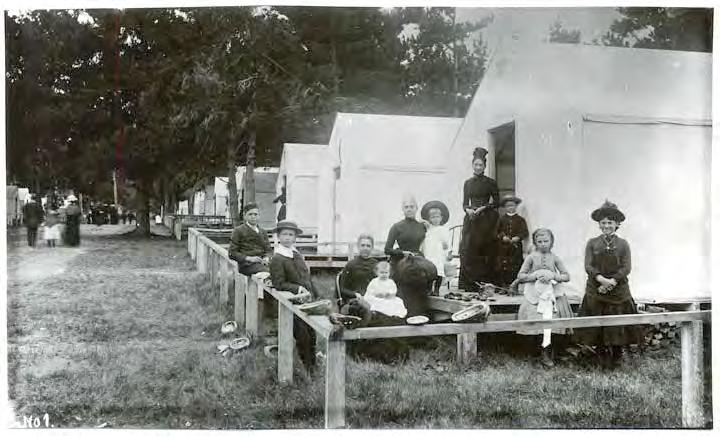 Tent frame accommodations, likely along 16th or 17th Street, 1885. (California State Library)
Tent frame accommodations, likely along 16th or 17th Street, 1885. (California State Library)
Historic Context Statement – Final City of Pacific Grove Historic Context (1873 – 1902) Pacific Grove, California 31 October 2011 Page & Turnbull, Inc. 61
Tent cottages were by no means the only type of housing being erected in the Grove. In 1878 Joseph O. Johnson had constructed a house on the northeast corner of Lighthouse and Fountain Avenue. It included a hip roof and a prominent porch—design features also common to many residences of the period. Perhaps the most substantial building in early Pacific Grove was the house of Dr. Frank F. Jewell (no longer extant), constructed as a summer retreat in 1879 using the doors and stained glass windows from a razed Methodist church in San Francisco. In contrast to the simple tent cottages, Jewell’s House featured numerous “gingerbread” decorative elements and occupied a prominent lot on the northwest corner of Forest Avenue and what is today Park Place. Jewell was one of the founding fathers of the Retreat and during the 1880s served as pastor of the San Jose First Church, and then as presiding elder for the Oakland District. In 1897 he became superintendant of the Retreat, and following his death in 1899 was buried in El Carmelo Cemetery. Jewell’s widow operated the house as furnished rooms for a brief period, and it was subsequently used as a boarding house.147

Another prominent early residence was that of Senator Benjamin J. Langford, constructed in the early 1880s at the extreme eastern edge of Pacific Grove on Lot 1, Block 1 of the Retreat. Addressed today as 225 Central Avenue, the two-story house shows Italianate style influences in its tall central tower, and would have been an impressive landmark marking the entrance to the Retreat. The house’s location also led to one of the more storied occurrences in Pacific Grove’s development. At the time the house was constructed, the boundaries of the Retreat were fenced—more symbolically than for security’s sake. One could enter the Grove on foot quite easily by walking through a stile gate—which was a break in the fence with a step up and through. But visitors on horseback or in carriages could not enter the Grove unless the wagon-gate was unlocked by the Superintendant. Langford’s home stood just beyond the entrance gate to the Retreat, and he apparently grew weary of repeatedly parking his carriage, walking all the way into the Grove to retrieve the key, unlocking the gate, and then traveling back to return the key. Thus he eventually decided to take matters into his own hands and used an axe to demolish the gate—which was never rebuilt.148 Grander residences such as the Langford House may be significant as an illustration of Pacific Grove’s early association with prominent individuals, as well as the financial success of some of the city’s early developers.
 Views of tents and cottages, 1885. Photos by C.W.J. Johnson. (California State Library)
Views of tents and cottages, 1885. Photos by C.W.J. Johnson. (California State Library)
Historic Context Statement – Final City of Pacific Grove Historic Context (1873 – 1902) Pacific Grove, California 31 October 2011 Page & Turnbull, Inc. 62

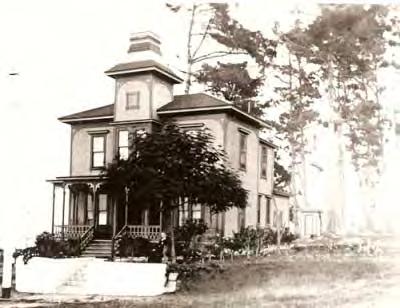 Dr. Frank F. Jewell House, circa 1900 (Steve Travaille, reproduced in Images of America: Pacific Grove, p. 74)
Early photograph of Langford House, circa 1890 (Courtesy the Heritage Society of Pacific Grove)
Dr. Frank F. Jewell House, circa 1900 (Steve Travaille, reproduced in Images of America: Pacific Grove, p. 74)
Early photograph of Langford House, circa 1890 (Courtesy the Heritage Society of Pacific Grove)
Historic Context Statement – Final City of Pacific Grove Historic Context (1873 – 1902) Pacific Grove, California 31 October 2011 Page & Turnbull, Inc. 63
Historic Context Statement – Final
City of Pacific Grove Historic Context (1873 – 1902) Pacific Grove, California
By 1882 approximately 100 cottages had been constructed in Pacific Grove Retreat and an impulse was growing to open the area as a year-round settlement. A visitor that year wrote:
The seed is sown from which good fruit is confidently awaited in coming years. It was at first designed to keep the Grove open only during summer, when it never rains and tents afford all needed shelter for campers. Since so many cottages have been built, and the proprietors have erected lodging houses, and a restaurant and public parlor, and a bakery and store have been set up, so many are lingering and loth [sic] to leave, that it is decided to keep open the year round.149
As development continued in the Grove, the Pacific Grove Retreat Association passed a series of rules in 1883 designed to protect the atmosphere of the Retreat. These regulations were published as an agreement between the Pacific Improvement Company as owners, and the Retreat Association as “moral and prudential” managers. At this time, Frank F. Jewell served as President of the Retreat Association, with Thomas H. Sinex as Secretary. Among the various prohibitions was the sale of any good or merchandise—except medicine—on the Sabbath. Immodest bathing apparel was prohibited, as was fast travel on horseback or in a carriage. No animal stock was allowed to roam free, and keeping horses was also banned except at designated stable lots. Social and public dancing was not allowed, nor was card playing, gambling or profane language. The sale of alcohol was strictly forbidden, and public parlors were required to close at 10:00 p.m. A curfew against any travel whatsoever in the Grove began at 10:30 p.m.150
The rules of the Retreat Association are a reflection of Pacific Grov e’s demographics at this time. Almost by definition the early residents were overtly religious, and most appear to have been relatively affluent. This was evidenced by their ability to afford a seasonal vacation residence, as well as have the funds and leisure time to enjoy it. Census information (discussed at length later in the report) also indicates that nearly all of the residents were white, and many were at or nearing retirement age. Thus, Pacific Grove does not appear to have been a place that attracted immigrants eager to make a fortune, but rather a place where people who had already established themselves in society came for quiet relaxation. This trend would remain an essential facet of Pacific Grove’s character well into the twentieth century.
EARLY COMMERCIAL DEVELOPMENT
Prior to 1886, Pacific Grove had few commercial enterprises other than those operated by the Retreat Association. In fact, the densest commercial area was comprised of the same stores constructed for the opening of the Retreat in 1875. Lots sold elsewhere by the PIC for business purposes came with the stipulation that they could only be operated during the summer season. By the mid-1880s, however, the Retreat had grown to include approximately 200 cottages, and it is estimated that the PIC had sold at least 1,500 lots for summer residences.151 With this critical mass, it appears that the PIC felt the timing was opportune to open up the area to greater commercial development.152 To facilitate this, the PIC sold a large lot to its agent in the Grove, Joseph O.
31 October 2011 Page & Turnbull, Inc. 64
City of Pacific Grove Historic Context (1873 – 1902) Pacific Grove, California
Johnson. In February of 1886, Johnson filed a map with the Monterey County Recorder for a new subdivision called the “Stable Block.”153 Located on the south side of Lighthouse Avenue between Forest, Fountain and Laurel avenues, this would become the nexus for Pacific Grove’s first commercial “downtown.”
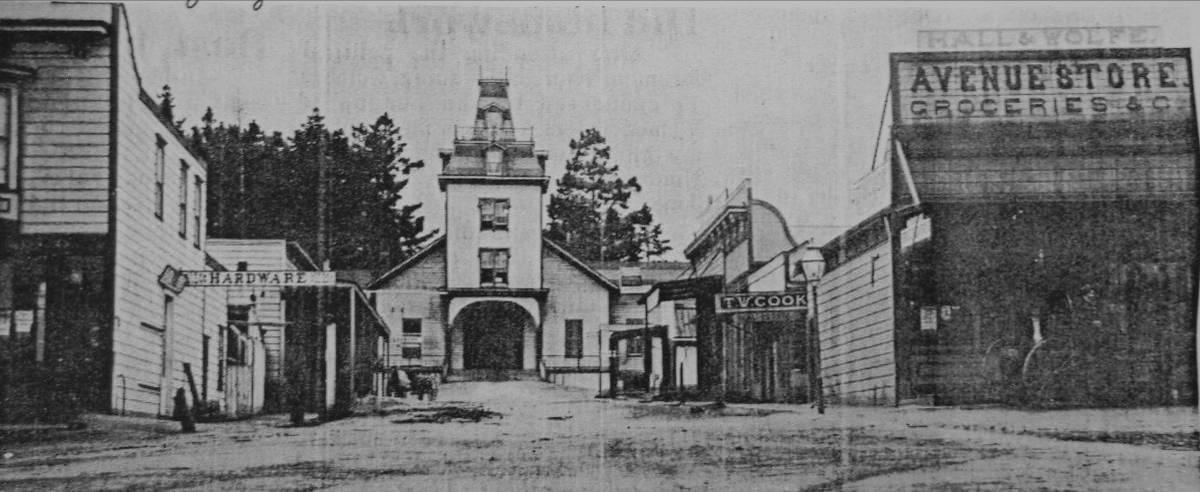
Development of the Stable Block is a clear reminder of the preeminent role horses played in nineteenth century America, and the distinct imprint they left on building types and business ventures. All of today’s modern infrastructure serving the automobile—such as gas stations, repair shops, garages and parking lots—had their counterparts during the nineteenth century in livery and feed stores, blacksmith shops, stables and corrals. The earliest horse-related infrastructure in Pacific Grove was a large corral developed by David Jacks on land located south of Lighthouse Road and north of Greenwood Gulch in the present-day vicinity of 15th Street.154 In 1884, Joseph O. Johnson developed the Grove’s first stable, which stood on the south side of Lighthouse Avenue between Grand and Fountain avenues. Here, Johnson also operated a stage line operating between the Hotel Del Monte and Pacific Grove, as well as excursions along the 17 Mile Drive. This operation was a precursor to Johnson’s greatest venture, Mammoth Stables, which served as the centerpiece of the Stable Block.
Constructed in 1886, Mammoth Stables stood on the south side of the block facing the southern extension of Grand Avenue. The name was apt, as the stable was at that time the largest building ever constructed in the Retreat. At center was a carriage house featuring a five-story tower capped by a cupola. To the east was a long wing that could hold 94 horses, while large corrals were located to the northwest and in the rear of the stables. Johnson also constructed a large home called “Nine Gables” set back from the southeast corner of Fountain and Lighthouse avenues. This residence featured a three-story tower and could rightly be characterized as Pacific Grove’s first mansion.
Mammoth Stables, circa 1890 (no longer extant) (Reprinted in Monterey Bay Tribune, 25 October 1990)
Historic Context Statement – Final
31 October 2011 Page & Turnbull, Inc. 65
Historic Context Statement – Final
City of Pacific Grove Historic Context (1873 – 1902) Pacific Grove, California
To finance the construction of Mammoth Stables, Johnson auctioned adjacent lots facing Forest, Lighthouse and Grand avenues. An auction was held on March 6 and the new lots sold well. Almost immediately construction began on new stores in preparation for the opening of the summer season. That same year, Johnson stepped down as Superintendant of the Retreat in order to attend to his increasing business duties.155
Among the first new businesses to appear on the Stable Block was Frederick Henry Ray’s hardware store, a two-story building located on the southeast corner of Lighthouse and Grand avenues. Immediately to the south was the one-story Seaside Drug Store, built for J.P.E. Heintz in 1886. This building was acquired by pharmacist Charles K. Tuttle in 1887, who would go on to have a distinguished career in the Grove, serving in various public offices. Tuttle was also a photographer, and many of his images remain the best record of the early development of Pacific Grove. In 1892, Tuttle raised his building to two stories and added bay windows. The Ray Building was also remodeled with a new facade at this time, and both buildings remain extant.156
Joseph O. Johnson also developed a business block on the east side of Grand Avenue with the construction of 213 – 221 Grand Avenue in 1886 (extant). This one-story building was divided into five continuous storefronts covered by awnings and capped by felt roofing. By 1888 the southernmost storefront was occupied by a Chinese “Wash House,” while Bedson Eardley opened up a printing facility for the Pacific Grove Review in the storefront at 215 Grand Avenue.157 The first issue
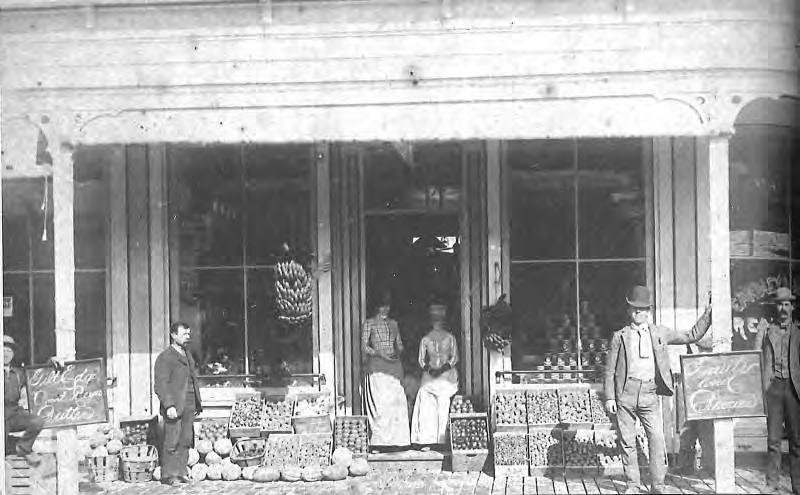 Johnson Block, circa 1889. Note Bedson Eardley’s office at right. (Heritage Society of Pacific Grove, reproduced in Images of America: Pacific Grove, p. 68)
Johnson Block, circa 1889. Note Bedson Eardley’s office at right. (Heritage Society of Pacific Grove, reproduced in Images of America: Pacific Grove, p. 68)
31 October 2011 Page & Turnbull, Inc. 66
City of Pacific Grove Historic Context (1873 – 1902) Pacific Grove, California
appeared in May 1888, but it was primarily a vehicle for real estate promotion. The paper’s banner read “Pacific Grove Review – Devoted to the Real Estate Interests of Monterey County.” At the time, lots were selling between $125 and $1,000 each.158 Eardley would go on to serve as Superintendant of the Pacific Improvement Company’s operations in Pacific Grove, while the paper came under the control of editor and publisher Anna A. Gallanar. In 1893 the paper sold at a subscription price of $2 per annum and was said to be a “worthy local organ of Pacific Grove.”159
The remainder of the nascent business district was located on the west side of Grand Avenue, where new businesses fronting on Lighthouse Avenue included David W. Lloyd’s General Merchandise store at 563 – 567 Lighthouse. This building was constructed in 1886, and enlarged with a second story by 1893. Immediately east was Hall & Wolfe’s grocery store, constructed in 1888, while immediately west was the Pacific Improvement Company’s office, followed by the Pacific Grove Land Office developed by Baker & Barber in 1886.160 By 1888, Sanborn maps indicate that a post office had also been established on the west side of Grand Ave, as well as a large roller skating rink on the northeast corner of Forest and Laurel avenues. Roller skating was then quite popular throughout the United States, and appears to have been considered sufficiently appropriate for the Retreat Association.
Of all the pre-1900 buildings constructed on the west side of Grand Avenue within the Stable Block, it appears that only one survives today: the two-story Aljah Roy Cummings building at 211 Forest Avenue. Historian Donald Howard dates the construction of this building to 1884, which pre-dates Johnson’s subdivision.161 Sanborn maps indicate that between 1888 and 1892 a rear addition was added to the building for a carpenter’s shop, while the front of the building housed the printing
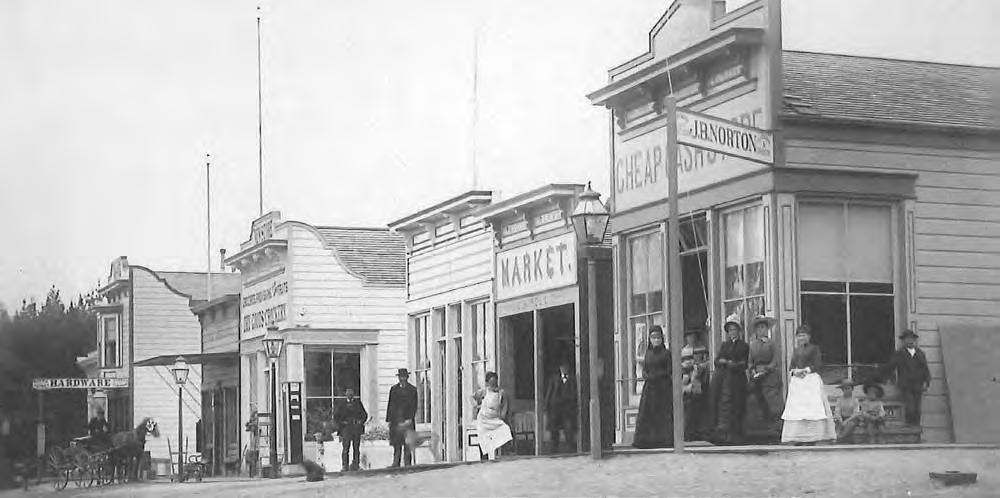 Commercial buildings on Lighthouse Avenue, between Forest and Grand, circa 1889. Note that all are designed in the Western False-Front tradition. (C.K. Tuttle Collection, Pacific Grove Museum of Natural History, reproduced in Images of America: Pacific Grove, p. 48)
Commercial buildings on Lighthouse Avenue, between Forest and Grand, circa 1889. Note that all are designed in the Western False-Front tradition. (C.K. Tuttle Collection, Pacific Grove Museum of Natural History, reproduced in Images of America: Pacific Grove, p. 48)
Historic Context Statement – Final
31 October 2011 Page & Turnbull, Inc. 67
Historic Context Statement – Final City of Pacific Grove Historic Context (1873 – 1902) Pacific Grove, California
plant for Anna Gallanar’s Pacific Grove Review newspaper. (An exceptionally detailed account of Pacific Grove’s early business development is provided in Donald Howard’s book, The Old Pacific Grove Retreat 1875 – 1940, which should be considered a primary reference for research on this subject).
The commercial buildings described here are likely to be significant as illustrations of the establishment of commerce during the earliest period of development in Pacific Grove, especially along Lighthouse, Grand and Forest avenues as the city’s primary commercial area. The architecture of nearly all of these commercial buildings found a common root in the Western False-Front tradition, so called because it used a flat-front facade and tall parapet—sometimes featuring a cornice—to conceal a gable-roof behind it. This gave the building a more impressive street presence by extending its height, while also imitating the profile common to urban commercial centers in the East. These buildings were easy to construct—and as alluded to above—easy to modify. Thus it was common that over time the facades of many of these buildings would be modified according to evolving tastes and architectural styles. Common treatments would include the addition of bay windows and elaborate wood trim designed to catch the eye and impress the shopper.
THE FIRST, SECOND AND THIRD ADDITIONS
Copy of the map filed on May 7, 1887 showing the First, Second and Third Additions to the Pacific Grove Retreat. The additions are located south of Light House Road, while the original Retreat boundaries are to the north. (Courtesy the Heritage Society of Pacific Grove)

31 October 2011 Page & Turnbull, Inc. 68
The year 1887 was a whirlwind of activity for the Pacific Investment Company. On May 7th the company filed survey maps detailing the First, Second and Third Additions to Pacific Grove. Other than the subdivision of Johnson’s Stable Block the previous year, this represented the first extension of the Retreat’s boundaries since the 1875 survey by St. John Cox. All of the land was located south of Lighthouse Avenue. The First Addition stretched from 1st Street on the east, to 16th Street on the west, with Pine Avenue as its southern boundary. The Second Addition was located to the west, running from 16th Street to a line between Granite and Willow streets, also with Pine as the southern boundary. The Third Addition was L-shaped, wrapping around the First and Second Additions on the south and west. Its boundaries included 6th Street on the east, Junipero Avenue on the south, and Alder Street on the west. Combined, these Additions more than doubled the size of the Retreat.
These new surveys generally continued the pattern of north-south streets from 1st Street all the way to 19th Street. Further west, however, there were no north-south street connections between the new additions and the old Retreat streets. Generally speaking, the block sizes were standardized, with dimensions of 300 feet by 120 feet. This allowed for twenty 30’ x 60’ lots in each block. It is these small parcels—both in the original subdivision and the first three additions—that are largely responsible for the dense, close-knit character of Pacific Grove’s historic core. The lot sizes dictated the sizes of the homes that could be built on them, which were generally confined to small cottages. Pacific Grove’s larger homes were frequently built on less uniform lots, such as those along the curves of Lighthouse and Ocean View avenues, which frequently resulted in lots with larger widths or depths. Several smaller parcels could also be purchased and joined together to make a single, larger lot, but this was not especially common.
Lots could be purchased at the PIC company office, which at this time was located in a storefront along Lighthouse Avenue. Auctions were also held, however, including the sale of 1,400 lots in the Third Addition. The Del Monte Wave reported that, “In front of a platform in a charming spot in the Grove were arranged several rows of seats for the sale. All present were supplied with a complete lithograph map of the Grove. While the bidding was spirited, there was no excitement whatever.”162 The auctions led to concerns that land speculation was overtaking the Grove, which would increase the price of property “above the reach of those not possessed by wealth.”163
THE EL CARMELO HOTEL
A mere two weeks after the Pacific Improvement Company filed survey maps for the new additions, it also completed its most notable developments to date with the construction of the three-story El Carmelo Hotel. Located on the north side of Lighthouse Avenue, the hotel grounds occupied the entire area between Lighthouse, Forest, Park Place and Fountain avenues. The hotel opened on May 20, 1887 with modern features including indoor plumbing in each of its 114 rooms, an elevator, and gas lighting.164 A landscaped park was laid out in front of the building by landscape architect, Rudolph Ulrich, who also landscaped the grounds for the Del Monte Hotel.165 A large ornate fountain donated by the Loyal Temperance Union was added to the grounds, located near the
Historic Context Statement – Final City of Pacific Grove Historic Context (1873 – 1902) Pacific Grove, California 31 October 2011 Page & Turnbull, Inc. 69
northeast corner of Grand and Lighthouse avenues.166 At the rear, the hotel was connected to a large two-story dining room and kitchen, which served hotel guests as well as other summer retreaters. A small octagonal “smoking room” also stood at the rear of the property in the middle of Grand Avenue.
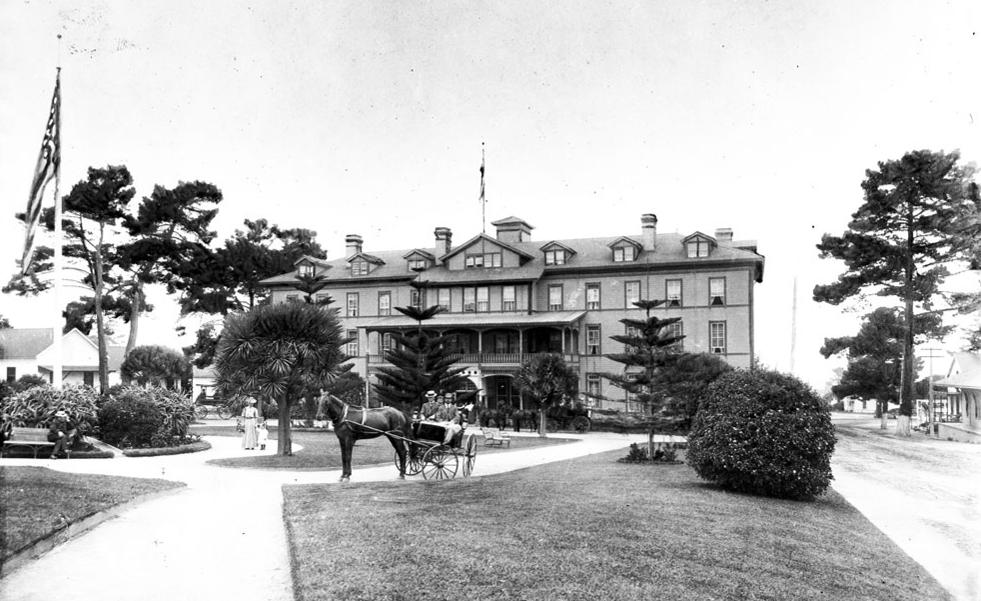
The El Carmelo would quickly become a centerpiece of social life during the summer months, heralded a few weeks after its opening by the dramatic and unplanned arrival of guests from the Del Monte Hotel in Monterey. In early June that hotel had been destroyed by fire, and many of its guests were relocated by the PIC to Pacific Grove. Two other notable lodging facilities were also constructed around this time. In 1888 construction began on the 20-room Centrella Hotel, located on the northeast corner of Grove (Central) and 17th Street. Constructed by local caterers, the building is still extant and has been placed on the National Register of Historic Places.167 That same year, Joseph F. Gosbey constructed a boarding house at 643 Lighthouse Avenue, renting rooms to visiting clergymen. Around 1900 the building was remodeled with the addition of a corner tower.168
Construction of the El Carmelo, which featured many modern conveniences, marked a clear departure from the earlier, rustic aspect of the Retreat, and led to a dramatic makeover of the Retreat’s central area. The old Preacher’s stand and bench seating beneath the pines were replaced by landscaped grounds, and the restaurant, store, market and lodging house built on the east side of Grand Avenue in 1875 were moved to the east side of Fountain Avenue across from the hotel. In the ensuing years, many of these buildings would see multiple uses. The old restaurant was
El Carmelo Hotel, circa 1900 (California Historical Society/USC Digital Archive #CHS-14375)
Historic Context Statement – Final City of Pacific Grove Historic Context (1873 – 1902) Pacific Grove, California 31 October 2011 Page & Turnbull, Inc. 70
Historic Context Statement – Final
City of Pacific Grove Historic Context (1873 – 1902) Pacific Grove, California
converted into a church and social hall on the southeast corner of Fountain and High Street (now Ricketts’ Row). Another building was converted to a mattress factory, likely to supply the tent campers during the summer season. The old lodging houses on the east side of Grand remained in place and served as adjunct hotel rooms.
1888: A MOMENT IN TIME
One of the primary tools for researching this history of development in Pacific Grove is a series of maps produced by the Sanborn Map and Publishing Company. Originally designed to help insurance companies set rates according to fire risks, these maps illustrate lot by lot, block by block development, including the building’s use, site plan and construction materials. The first Sanborn maps for Pacific Grove were produced in 1888 and offer an exceptionally-detailed view of the area’s development at that time. It should be noted, however, that the maps focus primarily on areas with the densest concentration of buildings. Isolated buildings located far from activity centers (where there was less fire risk) were not shown.
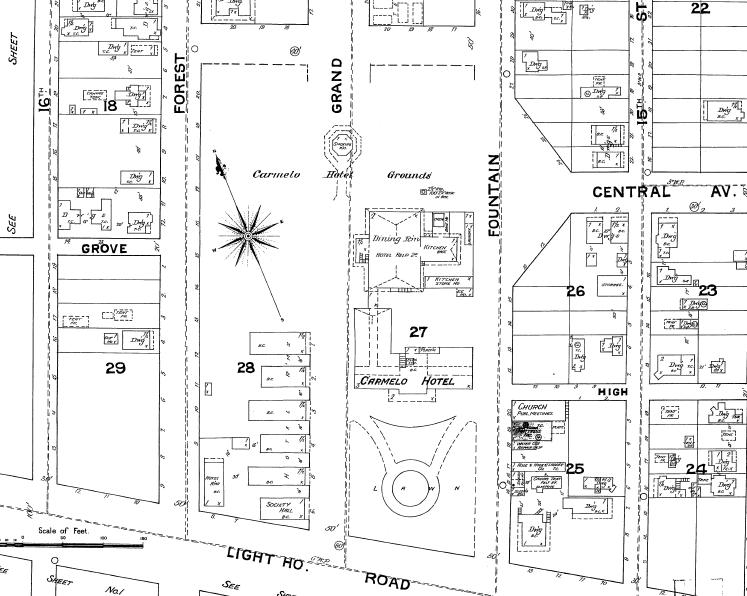 1888 Sanborn Fire Insurance Map of the El Carmelo Hotel and vicinity. Note the large grounds surrounding the Hotel.
1888 Sanborn Fire Insurance Map of the El Carmelo Hotel and vicinity. Note the large grounds surrounding the Hotel.
31 October 2011 Page & Turnbull, Inc. 71
A careful examination of the 1888 maps for Pacific Grove show that the most developed area of the Retreat were the blocks bounded by Forest, Laurel, Fountain and Ocean View avenues. The threestory Carmelo Hotel and its grounds dominated the center of the Retreat north of Lighthouse Avenue, while J. O. Johnson’s Stable Block was the sole focus of commercial activity south of Lighthouse Avenue. Then, as is still the case now, the overwhelming majority of buildings were residential, mostly one or one-and-a-half story wood-frame dwellings. Most houses featured small setbacks and front porches, while some also included boxed window bays. The largest home was that of J. O. Johnson, and there are probably no more than 20 two-story buildings in the entire Retreat. Tent frames continued to be clustered in “tent city,” shown as rows of frames along 16th and 17th streets from Lighthouse Avenue toward the bay, as well as small clusters of tent frames north of Park Place along Grand and Fountain avenues.
There was almost no industrial development of any kind, save for a blacksmith’s shop located in the Stable Block and a lumber yard located on the northwest corner of Forest and Laurel avenues. This was the chain mill and yard operated by the Loma Prieta Lumber Company, which had arrived in Pacific Grove in 1883.169 Several stables were also clustered nearby on the block bound by Forest, Laurel, Grand and Pine avenues. Given the relative paucity of industrial development, there does not appear to have been any dedicated company housing (e.g., worker dormitories) or clusters of working-class housing. Presumably, most unskilled or semi-skilled laborers lived as boarders, or occupied small cottages which are not distinguishable on Sanborn maps from seasonal resort cottages.
The 1888 Sanborn maps show that there was little development of any kind south of Laurel Avenue—unsurprising given that the area had only been opened for development the previous year. In fact, the vast majority of all development in the Retreat was concentrated north of Laurel between 12th Street on the east and Park Street on the west—and even these boundaries show hundreds of undeveloped lots. The areas immediately adjacent to the coast also appear mostly undeveloped, and the beach area at Lovers Point is not shown on the maps.
Given the religious origins of the Retreat, it is somewhat surprising that few dedicated religious buildings were shown at this time save for the Chautauqua Hall, labeled as a Methodist Episcopal Church, and a makeshift non-denominational church (later called the “Old Parlor”) located on the southeast corner of what is today Fountain Avenue and Ricketts Row. As previously mentioned, this was the old restaurant built in 1875, moved from the east side of Grand when the El Carmelo was built. South of this building, located about mid-block, was Pacific Grove’s first fire fighting facility, a hook-and-ladder company occupying a narrow one-story frame building.
Historic Context Statement – Final City of Pacific Grove Historic Context (1873 – 1902) Pacific Grove, California 31 October 2011 Page & Turnbull, Inc. 72
BECOMING A CITY
As late as November 1886 there were only 205 cottages in Pacific Grove connected to the water system, and only 87 of them drew water year round.170 But a number of developments were then taking place that demonstrated increasing momentum for conversion of the Retreat into a conventional city. One of these included the construction of the firehouse mentioned above. The Pacific Grove Hook & Ladder Company No. 1 had been organized in 1885, and the following year an engine house for a two-wheel handcart was constructed by L. D. Stone (no longer extant).171
Schools were also being developed. In 1884 Carrie Lloyd opened a summer school for children in the rear of the Chautauqua Hall. A school district was formed the following year and classes were
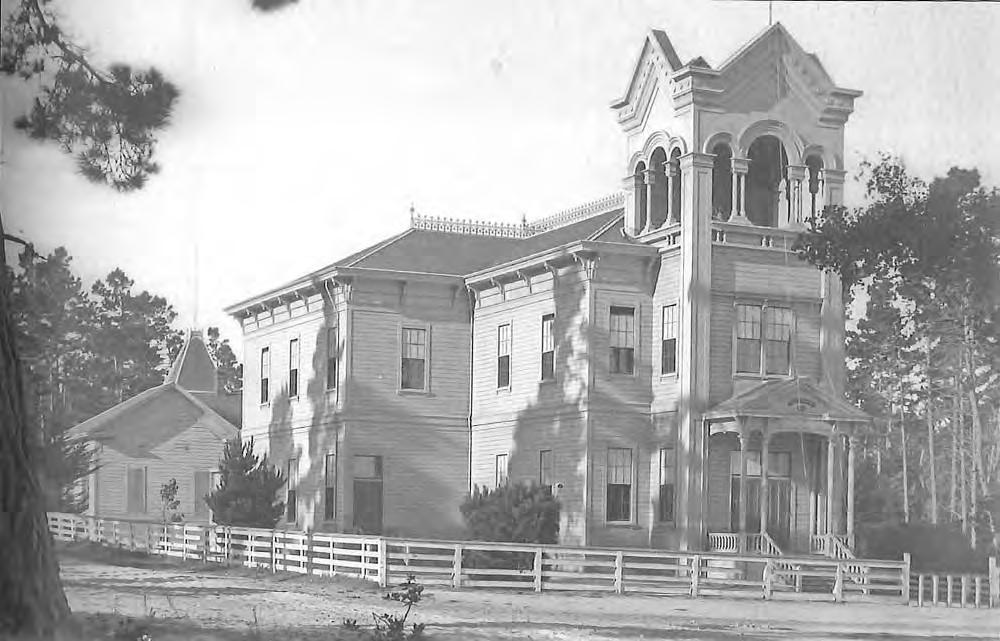
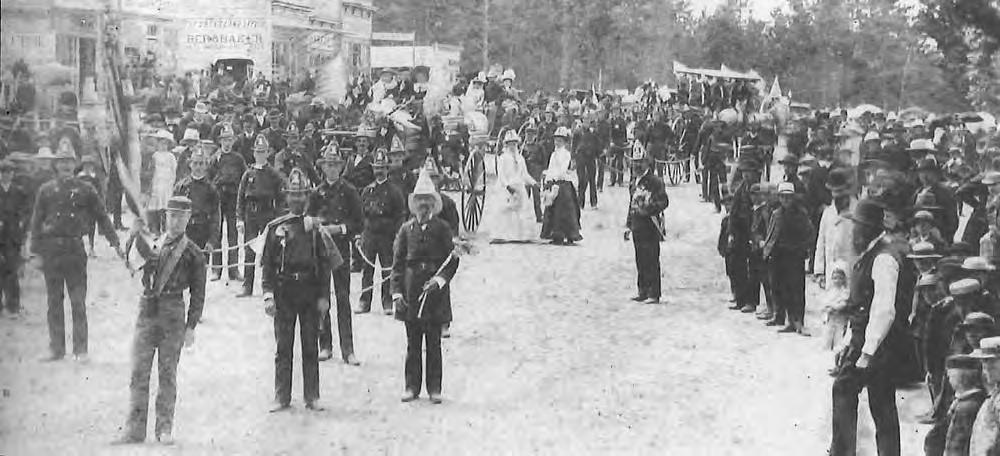 Pacific Grove’s Volunteer Fire Department, July 4, 1887 (Phyllis Fisher Neel, reproduced in Images of America: Pacific Grove, p. 49)
Pine Street School, circa 1891. Note the original school in the rear. (C.K. Tuttle Collection, Pacific Grove Museum of Natural History, reproduced in Images of America: Pacific Grove, p. 55)
Pacific Grove’s Volunteer Fire Department, July 4, 1887 (Phyllis Fisher Neel, reproduced in Images of America: Pacific Grove, p. 49)
Pine Street School, circa 1891. Note the original school in the rear. (C.K. Tuttle Collection, Pacific Grove Museum of Natural History, reproduced in Images of America: Pacific Grove, p. 55)
Historic Context Statement – Final City of Pacific Grove Historic Context (1873 – 1902) Pacific Grove, California 31 October 2011 Page & Turnbull, Inc. 73
Historic Context Statement – Final City of Pacific Grove Historic Context (1873 – 1902) Pacific Grove, California
held in the Old Parlor. Then in 1887, a local bond issue was passed for the construction of a schoolhouse. The PIC donated 20 lots on the south side of Pine Avenue in the First Addition for the school site—the same site where the Robert Down School stands today.172 A one-room schoolhouse was constructed that same year, but within a short time a new two-story facility called the Pine Street School was constructed on the same site, opening its doors on April 13, 1891 (no longer extant). The old schoolhouse was moved to rear of the property and used for adjunct classroom space.173 By 1893 it was written that:
The public schools of Pacific Grove are divided into four classes, taught by four teachers. There are about 150 pupils in attendance. There is a high-school class where pupils are prepared for the university … A kindergarten class is also maintained … The district has a fine school building, with six rooms, and a large hall, capable of being divided into two more rooms when the occasion requires. The schoolhouse is thoroughly furnished with all the modern appliances for heating, seating, and ventilation; and the plumbing is of the best.174
At the same time that schools were being formed, the development of Pacific Grove’s first library was also underway. The nucleus of the library began in the 1880s with a collection of books stored in a corner of the Old Parlor. Within a few years, however, it had moved to the octagonal-shaped building previously used as a “smoking room” behind the El Carmelo Hotel. This building also appears to have been used as space for the nascent Pacific Grove Museum, and by 1892 the octagonal building had been moved from its previous location to the area where the Pacific Grove Museum of Natural History stands today. After the turn of the century the library would move again to J. O. Johnson’s block at 211 Grand Avenue, where it became the first free circulating library in Monterey County.175
The late 1880s also witnessed a period of street improvements, including the clearing and grading of Lighthouse Avenue with a gravel bed. In 1888, all men living in Pacific Grove were asked to present themselves with appropriate tools to accomplish the job. The gravel was obtained “by digging and blasting a large deep gravel pit between Willow and Wood streets on Lighthouse Avenue and hauling if with four horses.”176
While these civic and cultural developments were important milestones for Pacific Grove, the greatest single impulse for incorporation as a city was unquestionably the coming of the Southern Pacific Railroad. In 1888 plans were announced for the continuation of the Southern Pacific Railroad from Monterey to Pacific Grove and out to the mouth of the Carmel River—a total distance of about 16 miles. This announcement stirred business owners and residents alike, and within a short time efforts were underway to incorporate the Retreat as a city.177
In June of 1889, Pacific Grove incorporated as a city of the sixth class (the class was based on population). The move to incorporate met with little resistance. The city was governed by a Board of Trustees drawn from the old Retreat Association, and its first significant effort was the enactment of
31 October 2011 Page & Turnbull, Inc. 74
Historic Context Statement – Final City of Pacific Grove Historic Context (1873 – 1902) Pacific Grove, California
a series of ordinances with names that included the “Protection of the Persons and the Preservation of the Morals in the city of P.G.” There were designed to preserve the unique qualities of the town, and in large part followed the earlier retreat rules, prohibiting “immoral” businesses—especially those that would sell alcohol—as well as other undesirable activities including shooting firearms, and playing ball in the street.178 Pacific Grove does not appear to have had a city hall at that time. The first time it appears on a map is in 1897, when the Sanborn map of that year shows it sharing space with the firehouse building on Fountain Avenue.
RAIL SERVICE ARRIVES IN PACIFIC GROVE
Construction on the Southern Pacific Railroad extension from Monterey was begun in May 1889 by Chinese laborers, and the first Southern Pacific Railroad train pulled into Pacific Grove on the 1st of August 1889. The right-of-way followed a sinuous route along the shoreline at the eastern end of Pacific Grove before straightening out in a large field southwest of Lovers Point. A depot was constructed on the south side of the line in what is today the Monarch Pines Mobile Home Park. In this same area, spur lines were constructed to serve the enormous Loma Prieta Lumber Company yard located north of the tracks. That this lumber company would be given such a large plot or prime land southwest of Lovers Point was not accidental. This company had been founded in the 1880s by the Dougherty Brothers of San Jose, and was incorporated with Timothy Hopkins (adopted son of Big Four founder, Mark Hopkins) as President. The company owned some 7,000 acres of forest in the Santa Cruz Mountains near Aptos, which was brought to a market by a rail system constructed in cooperation with the Southern Pacific.179
From the area southwest of Lovers Point, the railroad line then continued westward, out through the pasture land of the Bodfish Dairy—today the site of the Pacific Grove Golf Links. The dairy had been developed by David Jacks in 1887, and subsequently rented to William Bodfish.180 During railroad construction in this area, it is reported that work crews encountered a human burial, perhaps associated with the old Jose Armenta ranch house.181 From there, the railroad line turned near El Carmelo Cemetery and continued south over today’s Railroad Way to a point just south of Sunset Drive. There, a “sand spur” was constructed that extended southwest to the vicinity of Lake Majella.182 This was a pond located amidst rolling dunes in what is today the Spanish Bay Club development.
The line was originally planned to continue to an area of coal deposits in the Carmel Valley, but for reasons that are unclear, it was never extended beyond Lake Majella. Here the PIC established commercial sand mining operations amidst the abundant sand deposits at Moss Beach. Initially, the sand was mined by hand and loaded onto gondola freight cars for exclusive use by the Southern Pacific, which used the sand to improve traction on its many lines. Eventually, though, the sand would also be mined for shipment to east coasts glass makers.183
31 October 2011 Page & Turnbull, Inc. 75
Within a few years the Southern Pacific was not the only rail operation in Pacific Grove. On April 20, 1891 service was initiated by the Monterey and Pacific Grove Street Railway Company. This was a narrow-gauge, horse car line running out from the Hotel Del Monte to Lighthouse Avenue through New Monterey, then out Central Avenue in Pacific Grove to Fountain Avenue. There it traveled one block south to Lighthouse Avenue where it turned west and continued to a terminus at 17th Street. A car barn was built at the Del Monte terminus, as well as another car barn located at Central Avenue at 2nd Street in Pacific Grove (no longer extant). The grand opening coincided with a visit from President Benjamin Harrison, with the parade starting in Pacific Grove.184 The company was reorganized in 1893 as Monterey and Pacific Grove Street Railway and Electric Power Co.185 Among its directors at the time were Oliver S. Trimmer and Phillip Oyer of Pacific Grove, as well as Harry A Greene of Monterey.186 Greene was a highly influential figure in the development of Monterey, including the subdivision of New Monterey, the creation of the city’s first electric company, and construction of the Monterey harbor breakwater. His house, constructed in 1887, still stands in New Monterey at 361 Lighthouse Avenue.
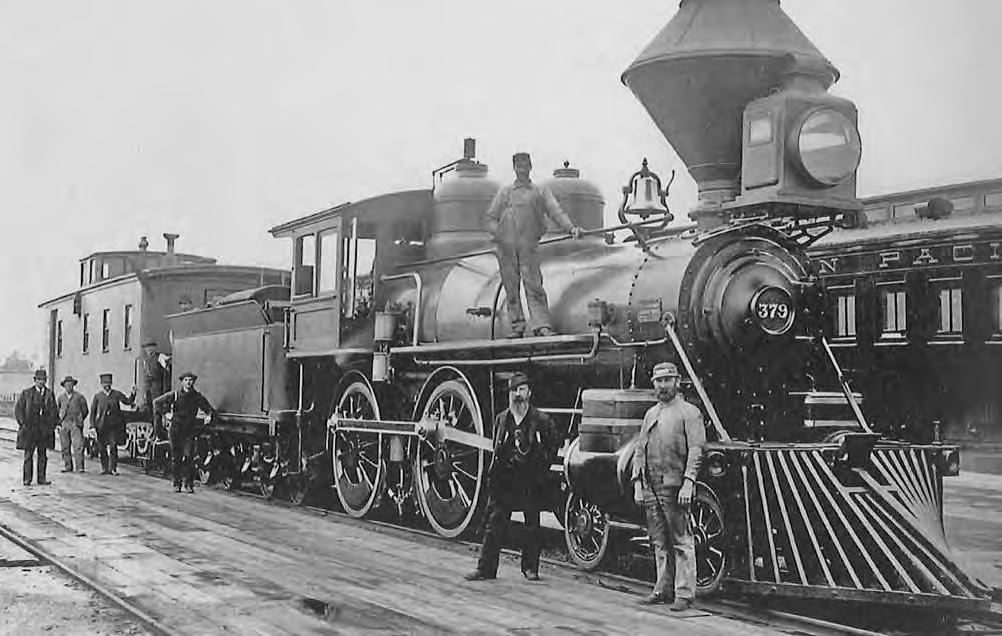 Southern Pacific Steam Engine, 1896 (Pat Hathaway Collection, reproduced in Images of America: Pacific Grove, p. 22)
Southern Pacific Steam Engine, 1896 (Pat Hathaway Collection, reproduced in Images of America: Pacific Grove, p. 22)
Historic Context Statement – Final City of Pacific Grove Historic Context (1873 – 1902) Pacific Grove, California 31 October 2011 Page & Turnbull, Inc. 76
PACIFIC GROVE’S EARLY CHURCHES


Despite Pacific Grove’s reputation as a Christian seaside resort, it was not until 1887 that construction began on the first building wholly designed for religious worship. This was St. Mary’sby-the-Sea, located on a lot donated by the Pacific Improvement Company at the southwest corner of Central Avenue and 12th Street. The building was designed by William H. Hamilton after a Gothic church located in Bath, England, and the interior finished with natural woods. A rectory designed by Ernest Coxhead was added in 1890, followed by a Parish house in 1893.187 Part of the lot included a spring feeding Greenwood Park gulch, which had to be crossed by a wooden bridge.
The following year the cornerstone was laid for a new Methodist Episcopal Church and Assembly Hall located on the north side of Lighthouse Avenue between 17th and 18th streets (no longer extant). The site encompassed eight lots donated by the PIC, which also donated $10,000 toward its construction. A Mr. Price of Philadelphia served as architect, while William Henry Hoyt—who would also build several commercial buildings in Pacific Grove—served as contractor.188 Completed in 1889, the Gothic Revival style edifice was the largest of Pacific Grove’s churches, featuring two impressive towers flanking the sanctuary. On the interior, the sanctuary featured a sloped floor, with opera-style seating installed in the balconies which could seat 600 persons. Classes were held in both towers as well as the basement, which also housed a kitchen and banquet room.
Monterey & Pacific Grove Street Railway, Horsecar No.7, 1895 (Erle C Hanson, Monterey & Pacific Grove Street Car Era)
Historic Context Statement – Final City of Pacific Grove Historic Context (1873 – 1902) Pacific Grove, California 31 October 2011 Page & Turnbull, Inc. 77
From the outset the Methodist Episcopal Church was designed as both a church and meeting hall, and would soon play host to many of the Chautauqua assembly functions. Part of the total $25,000 construction cost had been donated by several individuals “with the express understanding that this edifice was to be owned by the association and used for the meetings of all religious and educational assemblies which come to the Grove, free of charge. It is, however, dedicated as a Methodist Church, and is so used by the local Methodist Episcopal Association.”189
The Mayflower Congregational Church incorporated in 1892, and by the following year had begun work on a modest chapel. This was located directly west of St. Mary’s-by-the-Sea on land that had also been donated by the PIC. A Gothic Revival style chapel was completed in 1895, but would be destroyed by fire in 1910. It was then replaced by a much larger brick-veneered building, completed around 1911.

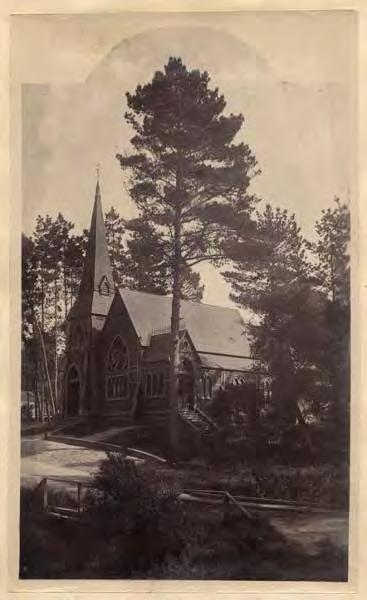 Early view of St. Mary’s-by-the-Sea (California State Library)
Methodist Episcopal Church and Assembly Hall, 1900 (C.K. Tuttle Collection, Pacific Grove Museum of Natural History, reproduced in Images of America: Pacific Grove, p. 63)
Early view of St. Mary’s-by-the-Sea (California State Library)
Methodist Episcopal Church and Assembly Hall, 1900 (C.K. Tuttle Collection, Pacific Grove Museum of Natural History, reproduced in Images of America: Pacific Grove, p. 63)
Historic Context Statement – Final City of Pacific Grove Historic Context (1873 – 1902) Pacific Grove, California 31 October 2011 Page & Turnbull, Inc. 78
Following the completion of the Mayflower Church, construction began on yet another church in the vicinity. The First Christian Church had organized in 1891 with meetings in the Old Parlor, and by 1896 had completed work on the shell of a Gothic Revival chapel located on the northwest corner of Central and Carmel avenues. Completed in 1904, the building features a corner tower with a belfry and rounded out an impressive collection of religious edifices all located with a block of Greenwood Park.190 Why the PIC chose to donate land for several churches in this area is not entirely clear, but Central Avenue was then considered one of Pacific Grove’s more important thoroughfares, and this location near the gateway to “downtown” would have been considered prestigious. Indeed, the PIC was active in making street improvements during this era. The gardener who maintained the grounds of the Hotel Del Monte also headed street improvement projects in Pacific Grove, and the company frequently donated gravel and manpower for street repairs.191 Along with an improvement of the streetscape, construction of these churches would lend a greater sense of permanency to the young city, and doubtless increase the further sale of lots and residential construction activity.
The construction of Pacific Grove’s first permanent churches clearly represents an important transition from religious retreat to fully-functioning city. These churches are therefore likely to be significant as expressions of religious and cultural values tied to the earliest period of growth in Pacific Grove, as well as for their exceptional architectural design.
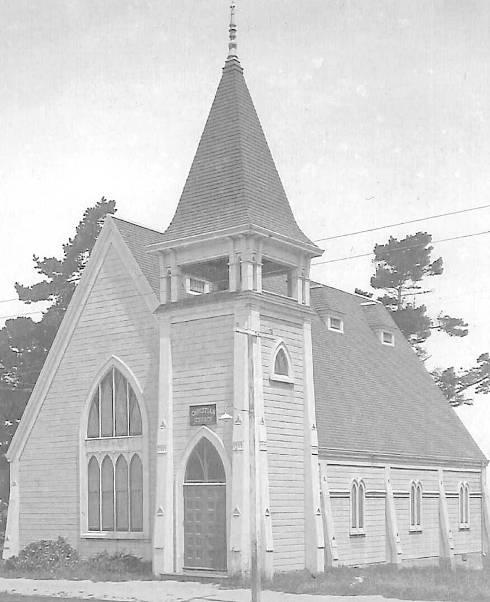 First Christian Church, 1896. (C.K. Tuttle Collection, Pacific Grove Museum of Natural History, reproduced in Images of America: Pacific Grove p. 62)
First Christian Church, 1896. (C.K. Tuttle Collection, Pacific Grove Museum of Natural History, reproduced in Images of America: Pacific Grove p. 62)
Historic Context Statement – Final City of Pacific Grove Historic Context (1873 – 1902) Pacific Grove, California 31 October 2011 Page & Turnbull, Inc. 79
TURN OF THE CENTURY GROWTH
Although the 1890 U.S. Census records were later destroyed by a warehouse fire, a contemporary account from the period held that Pacific Grove counted 1,336 year-round residents that year, and it was estimated that 10,000 visitors arrived every summer.192 By this time Pacific Grove’s summer calendar included a rapid succession of spiritual and social organizations that arrived for a few days or a week before being supplanted by another. A typical summer program might have included the Epworth League at the end of April; the Young Men’s Christian Association (YMCA) in May; the Summer Encampment of the Methodist Episcopal Church in early July, followed immediately by the Chautauqua Assembly; the Women’s Christian Temperance Union in early August followed by the Farmer’s Institute; the Itinerant’s Club in early September, followed by the California Conference of the Methodist Episcopal Church, which closed out the season.193
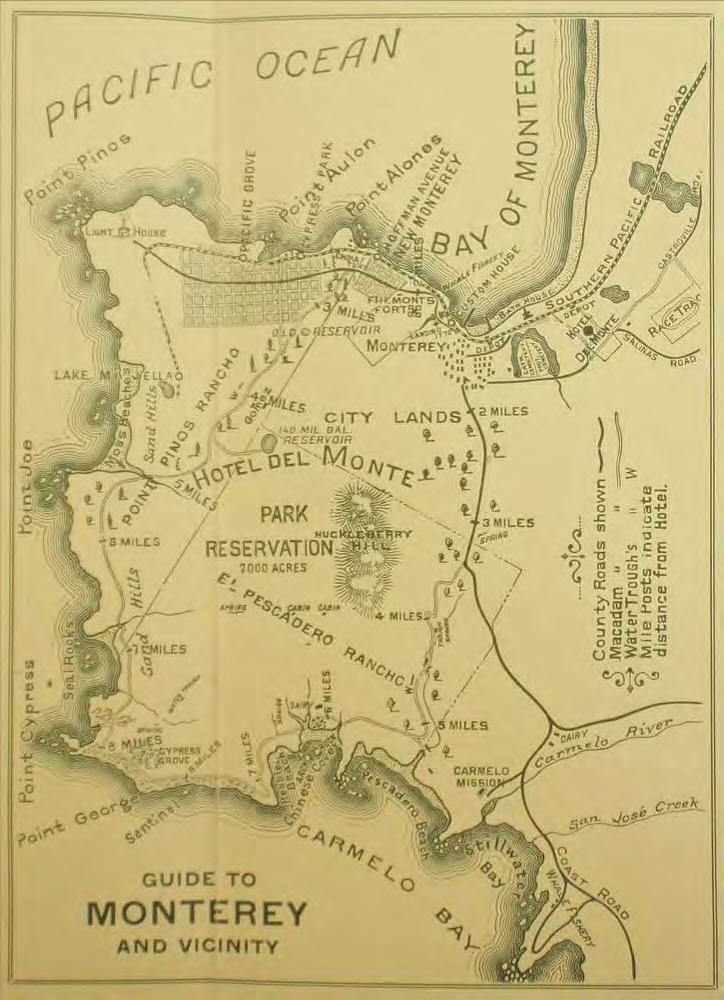 Promotional map of Monterey and vicinity, 1900 (Monterey Public Library, California Room)
Promotional map of Monterey and vicinity, 1900 (Monterey Public Library, California Room)
Historic Context Statement – Final City of Pacific Grove Historic Context (1873 – 1902) Pacific Grove, California 31 October 2011 Page & Turnbull, Inc. 80
Historic Context Statement – Final City of Pacific Grove Historic Context (1873 – 1902) Pacific Grove, California
An adult summer school was also held, with classes that included mathematics, history, romance languages and physics. These were taught by “instructors from the faculties of both Stanford University and the University of California.”194 Around 1895 the Pacific Grove Summer School of Music was also founded, which featured eight weeks of music classes conducted in association with the Chautauqua.195 The summer music school was a forerunner of the Pacific Grove High School summer music program, which continued well into the twentieth century.196
Commercial Development
Commercial development grew steadily during this period to service the large numbers of visitors, most of whom appear to have arrived via rail from the San Francisco Bay area. Almost all of the new commercial development was focused on Lighthouse Avenue, where new businesses spread outward from the earlier development of the Stable Block. These included the stores of the Hollenbeck Block, which fronted the south side of Lighthouse Avenue for the entire block between Forest Avenue and 16th Street (no longer extant). Constructed by contractor William Henry Hoyt in 1889, the two-story building included a bakery, candy store and cigar stand, with a hotel on the second floor. The post office was also relocated in this building, while the former postal building on Grand Avenue was converted to a telegraph office. One of the more popular shops in the Hollenbeck Block was a dry goods store operated by Rensselaer Luther Holman in partnership with George Washington Towle. Holman had arrived in Pacific Grove in 1890, and he and his sons would go on to become some of Pacific Grove’s most successful merchants.197
Another notable development during this period was the William Robson Building, also constructed by contractor William H. Hoyt on the northwest corner of Lighthouse and Grand avenues. When completed it 1892, the Robson building was the first notable commercial building developed on the north side of Lighthouse Avenue. It would include the Gale Brothers Grocery on the ground floor, and the Ancient Order of United Workmen lodge on the second floor. At some point prior to 1905, Bedson Eardley would gain control of the property, and by 1929 the building would be razed and replaced by the First National Bank.198
A further catalyst for commercial expansion occurred in 1892 when J. O. Johnson sold his large residence at the southwest corner of Fountain and Lighthouse avenues—which was promptly moved across the street to the southeast corner. The large parcel was then subdivided into smaller lots, and by 1897 a small string of shops had been constructed south of Charles K. Tuttle’s drug store including a furniture shop, a hat store, and a store selling stoves and tin ware (all extant). Johnson died in 1896, and by the following year his former home was operating as a “Faith Healing Home.”199
The fact that Joseph O. Johnson’s house was moved across the street should not be considered extraordinary. Although it was one of the largest homes in the Grove at that time, house moving was a very common occurrence during this era—both in Pacific Grove and elsewhere in California. In fact, it is safe to assume that few homes during this era were demolished in the conventional sense of the word. At worst they might have been dismantled and the building materials used
31 October 2011 Page & Turnbull, Inc. 81
elsewhere. But most of Pacific Grove’s buildings were small, wood frame structures, and moving them would not have been particularly difficult—especially at a time when vacant lots were plentiful, and rarely more than a block away.
Rounding out Pacific Grove’s downtown commercial development at this time was the addition of a few more stores on the east side of Forest Avenue south of Lighthouse. These included a hardware and paint store, as well as a furniture store that included an annex for an undertaker (no longer extant). This was Pacific Grove’s first undertaking business, operated by J. A. Pell, and its establishment was doubtless connected with the development of the El Carmelo Cemetery near the Point Pinos Lighthouse in 1889.200
Viewed as a whole, the nature of Pacific Grove’s commercial development during this period clearly reflects the macro trends of the day. Some buildings were strongly geared to the tourist trade: the curio stores, candy shops, jewelry stores and hat shops. Others show a town where new construction—particularly residential construction—was in high gear: the hardware stores, furniture shops, stove dealers and paint suppliers.
Residential Development Sanborn maps produced in 1892 and 1897 show that Pacific Grove’s residential growth during this period consisted primarily of infill within the original Retreat boundaries, as well as growth into the First and Second Additions. In the early part of the decade, much of the growth occurred between Pine and Lighthouse avenues from 11th Street on the east and Granite Street on the west. By 1897,
Lighthouse Avenue, 1901 (Pat Hathaway Collection; Monterey Public Library, California History Room Clipping Files)
Historic Context Statement – Final City of Pacific Grove Historic Context (1873 – 1902) Pacific Grove, California 31 October 2011 Page & Turnbull, Inc. 82
however, residential growth was also concentrating at the east end of the city, particularly between 4th and 11th streets in the vicinity of the streetcar line along Central Avenue. Here, the prestigious corner lots along Central remained mostly undeveloped, while the interior portions of the blocks were being built out with modest one-story frame dwellings. Closer to Ocean View Boulevard, the houses tended to be larger, with one-and-a-half or two-story frame dwellings offering views of Monterey Bay. At least some—if not most—of the lumber to construct these residences was supplied by the large Loma Prieta Lumber Company yard located southwest of Lovers Point on the north side of the Southern Pacific Railroad tracks.
Despite this development, tent frames also remained common. Pacific Grove may have incorporated as a city, but that did not herald the end of the summer season tent city. The Sanborn maps show that the densest cluster of tent frames had shifted one block west by 1892, when it was located between 17th and 18th streets north of Grove (now Central) Street. The former heart of the tent city—which had stood between 16th and 17th streets in the same area—was then in the process of being developed with new houses, such as a row of three semi-identical one-and-a half story cottages at 116 – 122 16th Street (two of which are still extant). These cottages were constructed by the PIC, and are identical to another cottage at 302 Lighthouse Avenue.201
The location of the tent city was not accidental. It stood a relatively short distance southeast of the Southern Pacific Railroad Depot, which simplified travel arrangements for visitors. The PIC’s continued support of the tenting operations during this period also appears pragmatic. The land remained effectively undeveloped, while its value for future sale increased with the construction of new buildings in adjacent areas. And as one of the most affordable options for lodging in the Grove, the tents also continued to bring in new visitors whom the PIC—like the Retreat’s founders—hoped would fall in love with the area and purchase a lot.
By the 1890s, the conversion of tent frames to tent cottages was growing less common. Nevertheless, the simple gable-front design remained a powerful inspiration, and many homes of the era copied the basic design as it was so well-suited to the small lots. However, the houses constructed in the final decade of the nineteenth century on the whole tended to be larger than those constructed in previous years, and represented the transition of the area from summer resort to year-round city. Residences from the turn of the century are therefore likely to be significant as examples of this transition.
Demographic research also appears to indicate that many of these new dwellings represented retirement homes, as Pacific Grove’s population skewed heavily to older, white, middle or upper middle class residents during this period.202 There does not appear to have been a sizeable immigrant community, nor are any ethnic enclaves apparent, save for the Chinese fishing village. In this sense, Pacific Grove appears to have stood apart from the ethnically diverse demographics that characterized many growing California communities during this period, functioning as a quiet retirement community for most of the year, with the center of the city transforming into a busy resort during the summer months.
Historic Context Statement – Final City of Pacific Grove Historic Context (1873 – 1902) Pacific Grove, California 31 October 2011 Page & Turnbull, Inc. 83
In time, the regular influx of visitors during the summer season led to the conversion of private homes to boarding houses. This was particularly true in the central area of the city north of what is today Jewell Park. Between 1888 and 1892 at least four private dwellings were converted to boarding houses, including the Jewell House, 123 Forest Avenue (extant), 133 Forest Avenue (extant), and 134 Grand Avenue (extant, but enlarged). Of interest, 123 Forest was used for a time as a sanitarium, having been built in 1886 for Dr. Carrie L. Roe. A few boarding houses also developed in the same manner along Lighthouse Avenue during this period, including the Gosbey House at 643 Lighthouse Avenue (extant), as well as the Bain Building at 663 Lighthouse Avenue (extant). These were all almost exclusively large two-story dwellings with many rooms to accommodate visitors.
Viewed as a whole, Pacific Grove’s residential development during this time loosely fit into three categories: tent cottages and other small wood-frame dwellings, usually featuring a front-facing gable roof; medium-sized residences, often one or one-and-a-half stories with a hip or gable roof; and much larger two-story residences that might be classed as mansions. Tent cottages, modest dwellings, and grander residences may all be significant as examples of their respective typologies. The latter were scattered throughout the town and included Doctor Andrew Jackson Hart’s residence built in 1893 at 649 Lighthouse Avenue, as well as the home of Dr. Oliver S. Trimmer at 230 6th Street, constructed the same year by notable Pacific Grove contractors Abraham Lee and George Quentel.203 Both residences were designed in the Queen Anne style and featured dramatic turrets, patterned wood shingles and art glass windows.204 Many prominent residences of the period would have also included metal cresting at the roofline, although much of this was lost to scrap
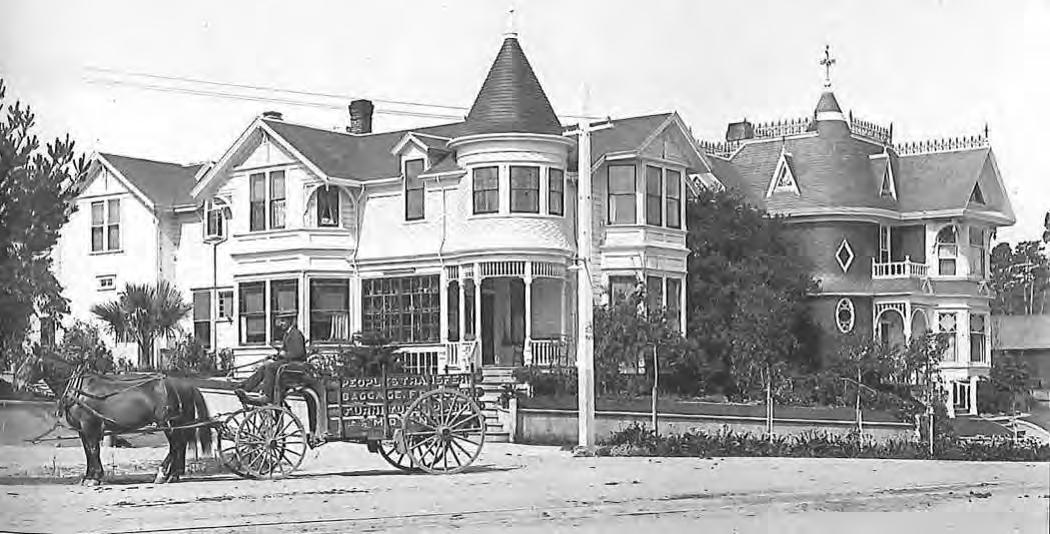 Queen Anne-style residences on Lightbouse Avenue, circa 1900. Note the Gosbey House (left) and Dr. Hart House (right)
(C.K. Tuttle Collection, Pacific Grove Museum of Natural History, reproduced in Images of America: Pacific Grove p. 63)
Queen Anne-style residences on Lightbouse Avenue, circa 1900. Note the Gosbey House (left) and Dr. Hart House (right)
(C.K. Tuttle Collection, Pacific Grove Museum of Natural History, reproduced in Images of America: Pacific Grove p. 63)
Historic Context Statement – Final City of Pacific Grove Historic Context (1873 – 1902) Pacific Grove, California 31 October 2011 Page & Turnbull, Inc. 84
drives during the two world wars. One of the few homes in Pacific Grove that is still ornamented with roofline cresting is 509 Laurel Avenue, built in 1888.





One of the more unusually ornamented houses of the period was built in 1888 at 289 Lighthouse Avenue. Because of the steep lot, a large stone retaining wall was built featuring a dramatic entry and a stone carving of a mountain lion. These were designed by stoneworker Charles D. Casper, who worked as a mason for the El Carmelo Hotel. Although the original house was torn down in 1928, the wall and mountain lion are still present, and the brick-clad Mediterranean Revival bungalow that stands on the lot is today known as “The Boulders.”205 According to local historian Kent Seavey, the masonry work on the wall is indicative of the masonry techniques used by Chinese stone masons.206
Perhaps the most prominent residence built during this period was a Queen Anne style mansion constructed by banker George Brandt in 1895 and today addressed as 1081 17 Mile Drive. Sometimes referred to as “Pinehurst,” or the LaPorte Mansion, the house stands on a six-acre lot,
 LaPorte Mansion, 1081 17 Mile Drive (1895). Photo circa 1970s. (Monterey Public Library, California History Room)
LaPorte Mansion, 1081 17 Mile Drive (1895). Photo circa 1970s. (Monterey Public Library, California History Room)
Historic Context Statement – Final City of Pacific Grove Historic Context (1873 – 1902) Pacific Grove, California 31 October 2011 Page & Turnbull, Inc. 85
which appears to be among the largest residential parcels in Pacific Grove. Of interest, the house’s location would have been outside the city limits when constructed, and the sale of the lot was likely concluded through an arrangement with the Pacific Improvement Company.
As compared to the opulence of Pacific Grove’s grander residences, this period also witnessed the construction of two log houses, both located in the same general area. The Curtis house at 301 Alder Street was completed circa 1897 for Mrs. Clara E. Curtis, It passed through several owners until purchased by Albert S. Collins circa 1915, who made a large addition to the original structure using Craftsman-style design elements.207 Another much larger log house was constructed at 505 Chestnut Street circa 1902 for Charles Howard. Both buildings remain extant.208
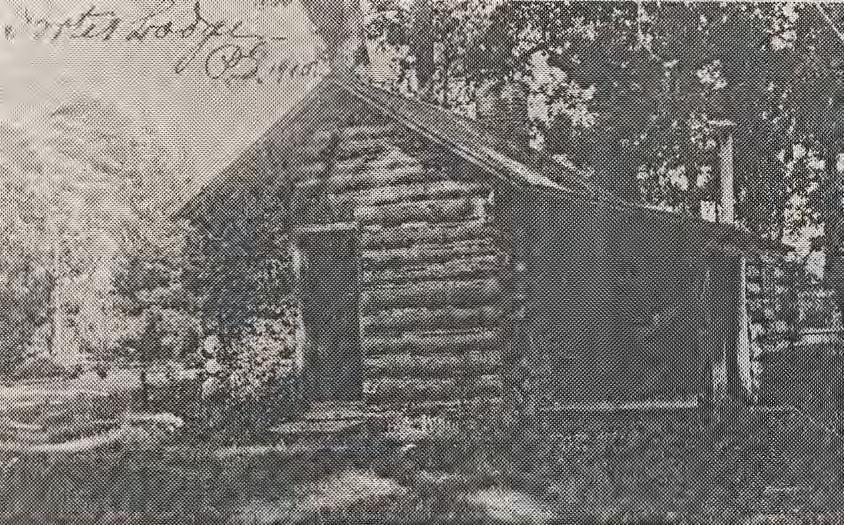
Civic Development
Given the steady pace of commercial and residential development, it is somewhat surprising that very few wholly civic projects were undertaken during this period—other than the schools previously discussed. No formal town hall existed. Rather, the city’s administrative offices were located in the firehouse building located on the east side on Fountain Avenue across from the El Carmelo Hotel. In 1891 that building had been enlarged with the addition of 40-foot tower, which housed a bell donated by Joseph O. Johnson. (The bell now stands in front of the firehouse at Pine Avenue and 17th Street.)209
In 1895, the city did work to tackle an ongoing problem with garbage disposal by constructing a municipal garbage chute located at the edge of the bay near the present-day intersection of Sea Palm and Ocean View avenues. This was a wooden ramp that ran out from the cliff face above the water, allowing residents to dump their garbage directly into Monterey Bay, where it would be carried out to sea by the current. Prior to that time, most residence simply buried their garbage at the rear of
Porter Lodge at 301 Alder, originally constructed for Mrs. Clara E. Curtis. Photo 1910. (Heritage Society of Pacific Grove, Board & Batten, February/March 2000)
Historic Context Statement – Final City of Pacific Grove Historic Context (1873 – 1902) Pacific Grove, California 31 October 2011 Page & Turnbull, Inc. 86
their yard. The area continued to be used as a dumping ground until at least 1913, when the city relocated the dump to Del Monte Park near the foot of Buena Vista Avenue.210
In 1897 a small jail is reported to have been constructed near Laurel and Fountain avenues, and indeed a very small structure labeled as a “lock up” appears on an 1897 Sanborn map, located northwest of Mammoth Stables behind a wagon and blacksmith’s shop (no longer extant).211 At the time, Pacific Grove counted only two law enforcement personnel—a constable during the day and a night watchman.212 This rather informal police force had been inaugurated in 1888, but Pacific Grove did not form a regular police department until 1900, when it gained a marshal and five deputies.213
Perhaps the two most important civic improvements of the era were the arrival of electric power in 1895, and the inauguration of telephone service in 1896. Both were somewhat slow to develop, however. Electricity was supplied by the Monterey Electric Light and Development Company from generators located in Monterey.214 Initially, electric wires were only installed on the principal streets, but by about 1910 most homes had been wired. Similarly, Pacific Grove’s first telephone service consisted of exactly one exchange: a connection between the home of Doctor Oliver Trimmer and Charles Tuttle’s drugstore. Tuttle had married Trimmer’s niece, and his daughter Winnifred would become the town’s first operator. As late as 1906, however, there were only 150 subscribers to the telephone system.215
Of all the civic-related buildings constructed during this period, the only one that remains today is the former Pacific Grove post office located at 208 Forest Avenue. Erected in 1901, it was the first brick building constructed in the city, and the post office would remain at this location until the late 1930s when a new post office was opened.216
El Carmelo Cemetery
The first and only burial ground established in Pacific Grove was the El Carmelo Cemetery, located northeast of the intersection of Lighthouse and Asilomar avenues, and is likely a significant cultural landscape. The first burial occurred at the site in 1889, when the surrounding area was composed almost entirely of pine forest. Presumably, the cemetery was developed by the Pacific Improvement Company, as an 1895 article in the Pacific Grove Review states: “The management have shown good taste in selecting such a site and have laid out the grounds for avenues and walks with good taste.” 217
However, David Jacks—who owned the adjacent Bodfish Dairy lands—is also known to have donated a portion of the grounds for the graves of Methodist ministers and their families. Prior to 1905, a group called the El Carmelo Cemetery Association also owned several burial plots in the cemetery, but these may have been purchased from the PIC.
The earliest available maps of the cemetery indicate that it was laid out in a roughly rectangular shape featuring fourteen sections of varying size (labeled sections A through K), and that it was to be bisected by several avenues. The eastern end of the cemetery is also shown as having an entrance
Historic Context Statement – Final City of Pacific Grove Historic Context (1873 – 1902) Pacific Grove, California 31 October 2011 Page & Turnbull, Inc. 87
wrapping around a small triangular wedge of ground labeled as section A. The southeastern edge of the cemetery was bounded by the curving line of the Southern Pacific Railroad.
In 1909, the Pacific Improvement Company would sell 9.32 acres of the site to the Trustees of Monterey Lodge Number 182, Independent Order of Odd Fellows. Four years later, the Trustees sold the cemetery to Hind Harper for $1,500, who in 1918 would purchase an additional acre of land for the cemetery from the PIC. Other sales would follow until the city purchased the site in October 1945.218 Further information on the city’s acquisition of the cemetery is included in subsequent chapters.
Early map of El Carmelo Cemetery, circa 1900. (Courtesy the Heritage Society of Pacific Grove)
Social Organizations
Along with hosting summer retreats for a variety of allied religious and social organizations, the city was also home to a large number of fraternal lodges and benevolent societies. Their meeting places evolved over time, but during the 1890s most appear to have met in one of three places: Robson Hall located in the William Robson Building on the northwest corner of Lighthouse and Forest avenues; the second floor of the Aljah Roy Cummings building at 211 Forest Avenue; or the second floor of the William Scoble Building at 609 Lighthouse Avenue (no longer extant). In 1902, however, William Scoble’s son, Thomas, constructed a new two-story building on the southeast
Historic Context Statement – Final City of Pacific Grove Historic Context (1873 – 1902) Pacific Grove, California Turnbull,
31 October 2011 Page &
Inc. 88
City of Pacific Grove Historic Context (1873 – 1902) Pacific Grove, California
corner of Lighthouse Avenue and 17th Street (extant). Known as Scoble Hall, it included a furniture store used by R. L. Holman on the ground floor, and the Independent Order of Odd Fellows’ Lodge on the second story.219
Robson Hall and Scoble Hall quickly emerged as the most popular venues, with a turn-of-the century city directory indicating that Scoble Hall hosted the Odd Fellows; the Companions of the Forest; the Order of the Eastern Star (a women’s auxiliary of the Masons), and the Daughters of Rebekah (an women’s auxiliary of the Odd Fellows). For its part, Robson Hall hosted organizations such as the Ancient Order of United Workmen; the Grand Army of the Republic; the Independent Order of Good Templars; the Women’s Civic Improvement Club; the Women’s Relief Corps; the Modern Artizans; and the Ancient Free and Accepted Masons.220 The Mason’s Lodge had been founded by Charles K. Tuttle in 1897, and he served as its master for four years.221
Pacific Grove’s benevolent impulses were also realized by the construction of the John Tennant Memorial Home in 1896.222 This was a 17-room Neoclassical mansion located on the southwest corner of Forest and Sinex avenues. It was built by Pacific Grove resident, Margaret Tennant, as a memorial to her brother. Design of the building was completed by one of the most respected architects of the period, Ernest Coxhead of San Francisco.223 Over the years it was used as a home for the aged, as lodging for unwed mothers, and as a rest-cure sanitarium. Tennant later donated the property to the Episcopal Church, and by 1922 it was being used as a boarding house named
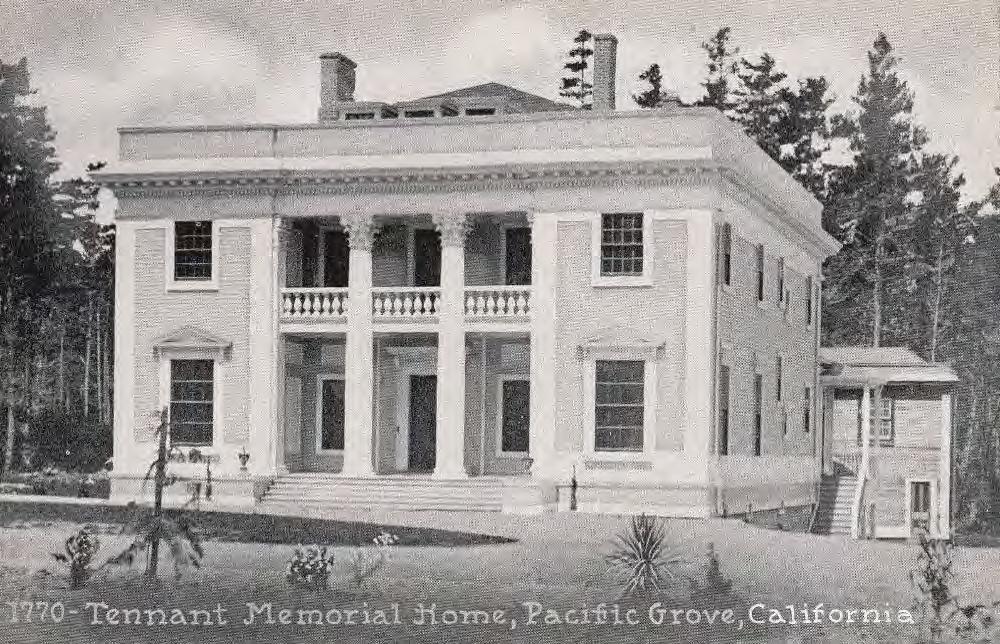 Early postcard of Tennant Memorial Home (Courtesy Charles Huff)
Early postcard of Tennant Memorial Home (Courtesy Charles Huff)
Historic Context Statement – Final
31 October 2011 Page & Turnbull, Inc. 89
Historic Context Statement – Final City of Pacific Grove Historic Context (1873 – 1902) Pacific Grove, California
Hillcrest Lodge. In 1936, it was renamed the Holiday House and was subsequently used as a school. The building was demolished in 1965, although Margaret Tennant’s personal residence, constructed in 1885, survives at 312 Central Avenue.224
Development at Lovers Point
It is important to remember that Pacific Grove was developed first and foremost as a summer resort. Thus, while religious reflection and Chautauqua enlightenment were vital parts of every summer season, people also came to the Pacific Grove to enjoy themselves. From the beginning, one of the lynchpins of the summer season was bathing at the cove located at Lovers Point— although when the point assumed that name is not entirely clear. Appearing as Point Aulon on prior maps, the first published mention of Lovers Point was in 1885.225
As previously discussed, the beach at Lovers Point owed its topography to a drainage gulch that had broken through the coastal rocks to create a sheltered beach cove. The first bathhouse—used for changing into appropriately modest bathing attire—had been constructed in 1875 directly above the gulch into the cove. A covered “vista building” where people could take in views of the water was subsequently constructed by the Retreat association about 1883 near the southeast area of the cove. A wooden wharf was also constructed around 1890 by the PIC, but was destroyed by storms within a few years. Steps from Forest Avenue down to the beach were also improved using rock rubble as a foundation.226
Despite, these improvements, by the 1890s the old bathhouse was viewed as somewhat shabby and ripe for redevelopment. This was driven in part by the arrival of the nearby Southern Pacific Railroad station, which in 1892 began receiving Sunday excursion trains from San Francisco, Oakland and San Jose. These trains allowed visitors to come down for the day and then return home, and visits to Lovers Point would have been an important part of many tourists’ itineraries.227
In 1893 John Lucas Birks leased a portion of the beach area from the PIC and erected a new frame bathhouse with approximately 60 dressing rooms, as well as hot tub baths that were fed by a windmill pump. An advertisement from that year declared that the new Pacific Grove Bathing House had been “recently thoroughly overhauled and enlarged … Splendid beach and surf bathing … pleasure boats, both row and sail, at reasonable rates.”228 The area was further improved in 1897 when Nathaniel Sprague hired William Hatch to blast rocks from the beach and cliff face in order to construct a new wooden wharf. Sprague was John Birks’ son-in-law and had briefly operated the bathhouse in partnership with Birks. When completed, Sprague’s wharf was located directly opposite the bathhouse along the southeast portion of the cove and used for docking pleasure boats.229
31 October 2011 Page & Turnbull, Inc. 90
Sprague was a recreational pioneer on the Monterey Peninsula, having teamed with San Francisco boat builder William Stone to construct a small fleet of rental rowboats in 1892 for use at a pier located near what is today Cannery Row in Monterey. But his real innovation was the development of glass-bottom boats for use in Pacific Grove, whereby tourists could be rowed out from the new wharf to enjoy the natural splendor of the “Marine Gardens.” Sprague’s “white swan” glass-bottom boats were operating as early as 1898, and would become a fixture of the Pacific Grove waterfront for decades. Sprague served as oarsman, and would continue to operate the boats until his death in 1948.
Hopkins Seaside Laboratory
Recreation was not the only activity at Lovers Point. In 1892 the Hopkins Seaside Laboratory was founded through an endowment by Timothy Hopkins, adopted son of the Big Four railroad magnate Mark Hopkins. In 1885 Hopkins was appointed trustee for the recently created Stanford University, and in 1892 supported the construction of one of the country’s first marine laboratories on land donated by the PIC at Lovers Point. Located slightly southwest of the point, the first building was a two-story frame laboratory that included various labs, as well as aquariums supplied by a 2,000 gallon tank at the rear. Water for the tank was pumped in by the same windmill that served Birks’ bathhouse. By 1893 another two-story building had been constructed, housing laboratories and a public aquarium on the first floor, with classrooms and a library on the second floor. Many of the laboratory’s specimens were gathered by Chinese fisherman, such as Quock
 Bathhouse at Lovers Point, circa 1898. Photo by Joseph K. Oliver. (Kim Coventry, reproduced in Images of America: Monterey Peninsula, p. 71)
Bathhouse at Lovers Point, circa 1898. Photo by Joseph K. Oliver. (Kim Coventry, reproduced in Images of America: Monterey Peninsula, p. 71)
Historic Context Statement – Final City of Pacific Grove Historic Context (1873 – 1902) Pacific Grove, California 31 October 2011 Page & Turnbull, Inc. 91
Historic Context Statement – Final City of Pacific Grove Historic Context (1873 – 1902) Pacific Grove, California

Tuck Lee, whose intimate knowledge of Monterey Bay allowed them to find and collect rare specimens. A scientific journal published around the turn of the century even singled out Quock Tuck Lee as having been “of utmost service, skilful, persevering and accurate in locating Chimaera” (a deep-water relative of the shark).230
THE 1900 CENSUS
In his master’s thesis, Pacific Grove: A Story of Western Development, Robert J. Rapp presents a thoughtful analysis of the 1900 U.S. Census, which reveals much about the character of Pacific Grove’s residents at the turn of the century. In particular, it shows that the young city included a sizeable number of elderly residents, who comprised nearly one-third of the population. The average head of household age was 54, and a fully twenty-two percent of the total population was comprised of widowers. This age, which at the time would have been associated with retirement, in part helps explain the large number of social clubs and community groups that were active in Pacific Grove. It also may explain the lack of resistance to restrictive ordinances that helped ensure a quiet, calm atmosphere. As might be expected of a city with an overtly religious character, no fewer than eight ministers also called Pacific Grove their home.231
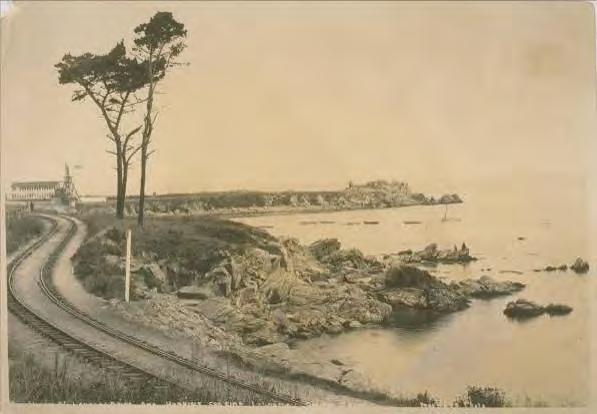
Of interest, the census also shows many single women as heads of households. This may have be indicative of the many women who had been widowed during the Civil War three decades earlier, and who were now in search of a comfortable, safe place to retire.232 The rest of the town was comprised largely of married adults, which suggests that younger people who resided in Pacific Grove had come to settle down, rather than find a spouse.233
Economically, the town was solidly middle or upper middle class. More than half the residents owned their own homes, and of those over eighty-percent owned their home outright. The image of Pacific Grove as a quiet community dominated by relatively affluent retirees is also born out by an
Lovers Point, with Hopkins Seaside Laboratory visible in distance, circa 1900 (Bancroft Library)
Hopkins Seaside Laboratory, 1892 (Heritage Society of Pacific Grove, reproduced in Images of America: Pacific Grove, p. 68)
31 October 2011 Page & Turnbull, Inc. 92
Historic Context Statement – Final City of Pacific Grove Historic Context (1873 – 1902) Pacific Grove, California
analysis of occupational data. Of the 398 heads of households identified in the 1900 Census, 211 were either retired or provided no occupational data. Of those who provided employment information, more than fifty percent listed white-collar occupations, while an additional thirty-two percent could be classified as having skilled or semi-skilled blue collar occupations. Most also worked within the city limits of Pacific Grove. Only twenty-two heads of households were classified as unskilled or menial laborers.234
In part, this relative economic homogeneity is evidenced by contemporary Sanborn maps, which do not appear to reveal any socio-economically segregated neighborhoods. While larger houses did exist in Pacific Grove, they were not located in enclaves. Rather, they were quite frequently sited adjacent to small cottages. The owners of Pacific Grove’s larger residences also lived relatively modestly. The Census indicates that only sixteen households employed domestic servants, most of whom lived on site.
Relatively few immigrants lived in Pacific Grove at this time. Over eighty percent of Pacific Grove’s residents were native born, while the rest primarily hailed from the British Isles, Canada or northern Europe. Pacific Grove was also overwhelmingly white. Excluding the residents of the Chinese fishing village, the 1900 census shows only four African-American residents of the city, and only one person of Japanese descent.
THE CHINESE IN PACIFIC GROVE
The Chinese fishing village at Mussel Point continued to grow during the last decades of the nineteenth century, although in many ways it still stood a world apart from the city. An article from 1888 described it as a scenically rustic, yet commercially active area. According to the writer, the village was then comprised of:
A double row of shanties, built directly on the rocky shore, which here permits good-sized fishing boats to come to anchor at the owner’s back door. … On all the rocks about are arranged lattice-work frames that are covered with drying fish. The fish are mainly squid, about as long as one’s hand, split and boned … When viewed from the water, it is said by those who have traveled in China, to bear a striking resemblance to the native villages that line the Yangtze.235
By this time the Chinese village, which numbered around 200 residents,236 had also emerged as a common part of any tourist’s list of things to see. One writer mentioned that, “even the Chinese fishing village in Pacific Grove, in spite of its mal-odiferous smells, has its full quota of sightseers. To many it is simple curiosity that prompts the threading of its narrow street and peering into its open doorways.”237 The Del Monte Hotel even took guests to see the Chinese New Year celebrations, where the villagers welcomed visitors with tables set out with treats.238
31 October 2011 Page & Turnbull, Inc. 93
As discussed in the previous chapter, the large number of families at the Pacific Grove fishing village was atypical of many other Chinese settlements in California, which were almost exclusively comprised of male laborers. The result was that the village included a sizeable number of children. As early as 1883 the Methodist Episcopal Church had established a mission and school at the Chinese village directed by Eunice L. Wilson. The school moved to Pacific Grove in 1890, and after Wilson’s death in 1894 the children were allowed to attend the Pacific Grove Elementary School as long as they would “present themselves clean and under the same conditions as white children.”239 A book published in 1893 mentions: “The Chinese colony of 400 or 500, within the district, includes some thirty-five native born Chinese children, for whose education in English provision was made by the school trustees; but the parents of these children seemed to be averse to sending them to school.”240
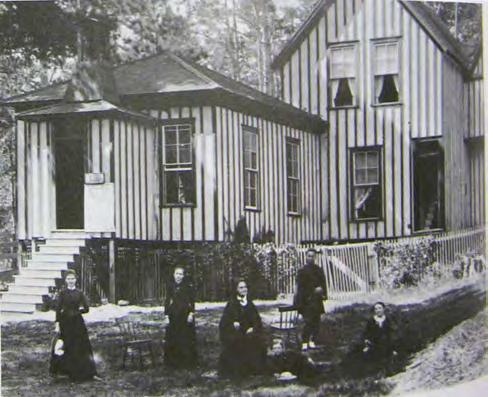
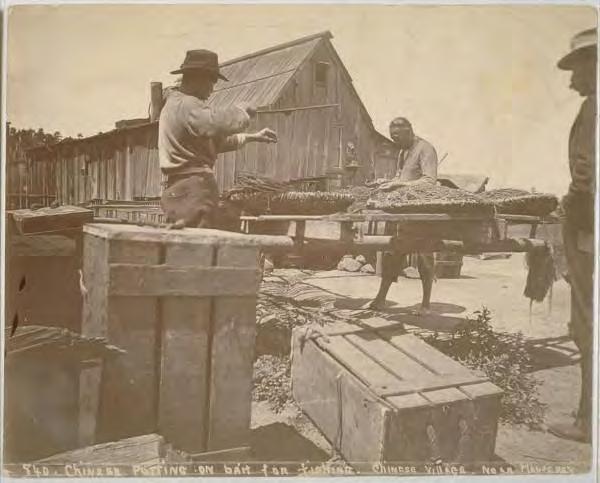
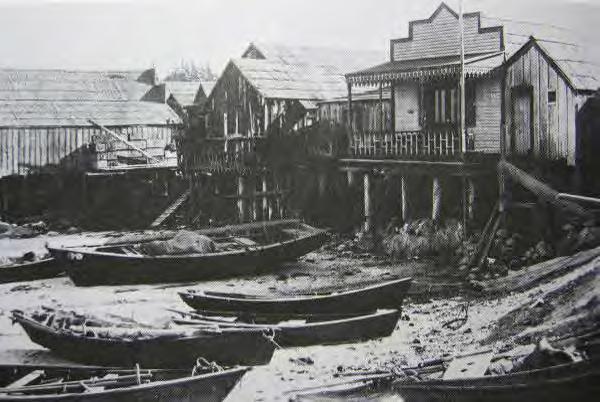
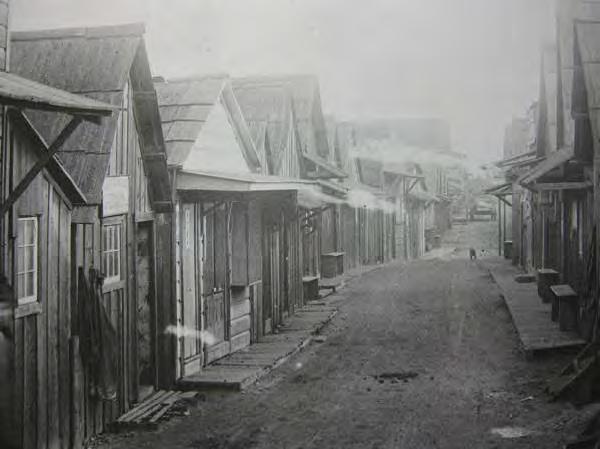 Point Alones Village, 1890s (Pat Hathaway Collection, reproduced in Chinese Gold, p. 162)
Point Alones Village, circa 1900 (Pat Hathaway Collection, reproduced in Chinese Gold, p.42)
Chinese fisherman, circa 1890 (Bancroft Library)
Chinese mission and school, circa 1890 (California State Library)
Point Alones Village, 1890s (Pat Hathaway Collection, reproduced in Chinese Gold, p. 162)
Point Alones Village, circa 1900 (Pat Hathaway Collection, reproduced in Chinese Gold, p.42)
Chinese fisherman, circa 1890 (Bancroft Library)
Chinese mission and school, circa 1890 (California State Library)
Historic Context Statement – Final City of Pacific Grove Historic Context (1873 – 1902) Pacific Grove, California 31 October 2011 Page & Turnbull, Inc. 94
Historic Context Statement – Final City of Pacific Grove Historic Context (1873 – 1902) Pacific Grove, California
While the Chinese in Pacific Grove continued to operate the most important commercial fishing operations on Monterey Bay, some residents also found employment in the developing resort economy. Following the construction of the Hotel Del Monte, the PIC employed Chinese laborers at the hotel, as well as for construction of the various drives around the peninsula.241 Chinese laborers—though not from the Pacific Grove village—were also an integral part of agricultural operations in the Salinas River Valley.
At least one Chinese immigrant inserted himself into the commercial life of Pacific Grove outside the Chinese Village with the establishment of a laundry at 221 Grand Avenue at the southern end of the commercial block developed by J. O. Johnson. The laundry was operated by Jim Jim or Jim Long Jong, and continued at this location until at least 1905 when it was converted into Simpson’s Plumbing.242 Hundreds of Pacific Grove residents turned out for Jim Jim’s wedding in 1900, testifying to his important role in the community.243 The author of a study of Chinese culture in the Monterey concluded that:
Chinese laundries are probably the most misunderstood and least appreciated of all the businesses associated with the Chinese in America,” and that they are often dismissed as “peripheral to the more dramatic exploits of the railroad builders or fishermen. Yet the Chinese laundryman personified the persistence, adaptability, and ingenuity of the Chinese immigrant. Often the first to establish a Chinese business in a community, the laundryman skillfully adapted to the shifting political and economic currents in the community.244
Another important role of the Chinese in the development of the Monterey Peninsula was the construction of the Forest Hill Reservoir in 1888. As previously discussed, this effort required some 1,700 Chinese laborers, although it is likely that few of them hailed from the Pacific Grove village. Ironically, the same year as the reservoir was being completed, the Scott Act was signed into law by President Grover Cleveland. This legislation not only prohibited further Chinese immigration to the United States, it also stipulated that any Chinese who had left the United States, even only temporarily, would be refused reentry.245
The exclusion of further Chinese immigration would have a profound effect on ethnic communities in the Monterey Bay area. In particular, it would open the door for Japanese immigrants who would assume the roles formerly played by Chinese laborers, as well as pioneer new industries. Around the turn of the century, the Chinese community would also face increasing pressures to leave its location at China Point. In part this was driven by the growth of both Pacific Grove and Monterey, which brought white residents in closer contact with an unfamiliar culture, as well as practical concerns focused around the smell of the Chinese fishing operations. Just as importantly, however, was the fact that the Chinese lived on what was increasingly very valuable real estate adjacent to the coast. In the coming years, pressure on the Chinese to relocate would increase dramatically, leading to one of the more dramatic events in Pacific Grove history.
31 October 2011 Page & Turnbull, Inc. 95
Historic Context Statement – Final City of Pacific Grove Historic Context (1873 – 1902) Pacific Grove, California
ASSOCIATED PROPERTY TYPES & REGISTRATION REQUIREMENTS (1873 – 1902)
The dominant themes of the “Early Development of Pacific Grove” period are the early development of the city as the Pacific Grove Retreat and the Retreat’s subsequent transition from a summer encampment to a city (creation of water, sewage, and transportation infrastructure and emergence of residential, commercial, and civic development patterns). The impact that development companies such as the Pacific Grove Retreat Association and the Pacific Improvement Company had on the built environment was important during this period, as was the influence of the Chautauqua and other social and religious organizations on the culture and character of the city. Other themes that emerged during this period included the development of recreational facilities and promotion of the area as a tourist attraction and the contributions of the Chinese fishing village to local culture. Property types associated with these significant themes include residential properties, commercial properties, civic & public assembly properties, and cultural landscape elements.
Although a handful of light industrial properties existed during this period, none appear to be extant today.
RESIDENTIAL PROPERTIES
The period 1873 – 1902 covers a significant period of development in Pacific Grove, including the establishment of the Pacific Grove Retreat and its transition from a summer encampment to an incorporated city. Likewise, this period witnessed the establishment of residential and commercial development patterns that would guide the city’s development through the mid-twentieth century.
The overwhelming majority of surviving buildings from this period are residential, primarily consisting of single-family residences, with only a handful of multi-family buildings.
Architecture of the period encompasses a wide range of styles, roughly following a chronology that includes the Gothic Revival style (1870s – 1890s); Italianate style (1870s – 1880s); Stick/Eastlake style (1880s – 1900); and Queen Anne style (1880s – 1905). However, because Pacific Grove was a resort area, stylistic “rules” were likewise relaxed, and relatively few pure examples of architectural styles are present. Thus, most residences are vernacular in nature and may loosely be grouped under the heading of Folk Victorian. These frequently drew from a variety of influences, particularly during the 1880s and 1890s, when Stick and Queen Anne decorative elements were often used on the same general building form.
Residences of this period may be loosely categorized within three separate typologies:
Small “tent cottages” with front-facing gable roofs that were either converted from original tent frames or designed to imitate this pattern.
Modest dwellings, typically one or one-and-a-half stories in height, most frequently with a hip roof.
Large dwellings or grander residences, typically two stories in height and richly ornamented. A few large dwellings were also converted to boarding houses, and have been grouped in this category.
31 October 2011 Page & Turnbull, Inc. 96
Within these typologies, several patterns are present. As a general rule, most residences are rectangular, and most typically are one to two stories in height. Wood frame construction is near universal, although brick and log structural systems are possible. The most popular roof forms were gable, hip or a combination of the two. Most homes of this period also featured partial or full-width entry porches.
Given Pacific Grove’s small lot sizes, houses typically feature only a narrow set back from the front and side lot lines, although larger residences constructed on large or multiple lots may feature generous set backs from the street. Residential properties, particularly those on larger lots, also sometimes have associated ancillary structures such as storage sheds and stables that have often been converted to automobile garages. Some properties also have associated site or landscape features, such as retaining walls, site walls, steps, wrought iron fences, or large specimen trees.
All residential buildings dating to this period would originally have had wood-sash windows and wood paneled or glazed doors. Typical cladding would have originally consisted of wood board and batten, wood channel drop, or wood shingle siding. Many buildings would also have originally featured elaborate wooden trim, most often concentrated around porches, windows and gable ends.

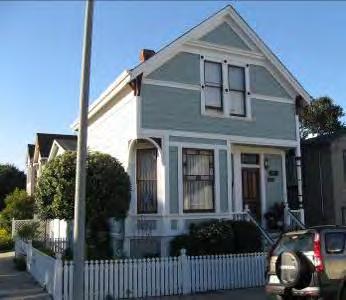
These buildings are generally confined to areas of the city subdivided prior to 1900, including the original Retreat boundaries and the First, Second and Third Additions. Within this area, the greatest concentration of residences from this period are found north of Pine Avenue between Granite Street on the west and Carmel Avenue on the east. A few areas with particularly dense clusters include 19th Street between Central and Jewell avenues; Fountain Avenue and 15th Street north of Central Avenue; and 17th Street between Laurel and Lighthouse avenues.
 Residences from this period in Pacific Grove range in size and ornamentation. Primary typologies include tent cottages (left: 127-129 17th Street), modest dwellings (middle: 150 18th Street), and grander residences (right: La Porte Mansion, 1081 17 Mile Drive)
Residences from this period in Pacific Grove range in size and ornamentation. Primary typologies include tent cottages (left: 127-129 17th Street), modest dwellings (middle: 150 18th Street), and grander residences (right: La Porte Mansion, 1081 17 Mile Drive)
Historic Context Statement – Final City of Pacific Grove Historic Context (1873 – 1902) Pacific Grove, California 31 October 2011 Page & Turnbull, Inc. 97
Historic Context Statement – Final City of Pacific Grove Historic Context (1873 – 1902) Pacific Grove, California

Architectural Styles & Character Defining Features
The following section provides an outline of the relevant residential architectural styles and the character-defining features associated with each style. These styles can be applied to tent cottages, modest dwellings, and grander residences.
Typically rectangular or cruciform in shape, with symmetrical facades
Steeply pitched gable roofs, sometimes with centered or paired gables on the primary facade
Elaborate verge boards/trim in the gable ends; frequently “icicle” type designs Windows with lancet, or pointed arch tops, may be crowned with drip moldings
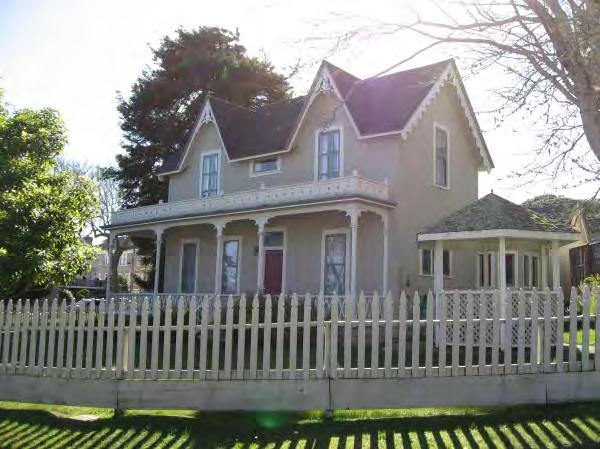
Rare style in Pacific Grove
Symmetrical facade, often with vertical emphasis; stronger examples may include a central tower
Bracketed rooflines, typically with a hip roof Windows with hoods Recessed entries
1. Gothic Revival Style (1870s – 1880s)
Gothic Revival-style house at 129 Pacific Avenue (1884)
2. Italianate Style (1870s – 1880s)
Langford House at 225 Central Avenue is a typical Italianate villa (1884)
31 October 2011 Page & Turnbull, Inc. 98
City of Pacific Grove Context Pacific Grove, California
Gable ends braced with turned truss work
Jigsaw or lathed wood trim, often concentrated around porches or gable ends
Applied wooden strips and/or applied wood “button” ornaments
Extended brackets and building corners delineated by applied boards
Rectangular, or “boxed” bay windows, frequently located on only one side of the façade
Facades of Queen Anne cottages are often symmetrical, with an integral porch on one side and a bay window or flat facade on the other. Larger and more dramatic examples are often asymmetrical, and may feature rounded towers or bay windows.

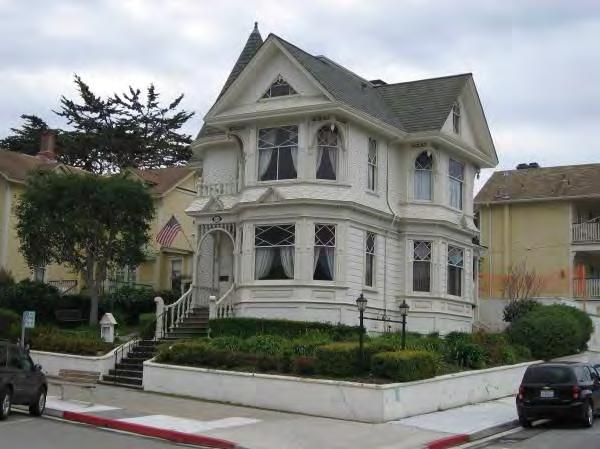
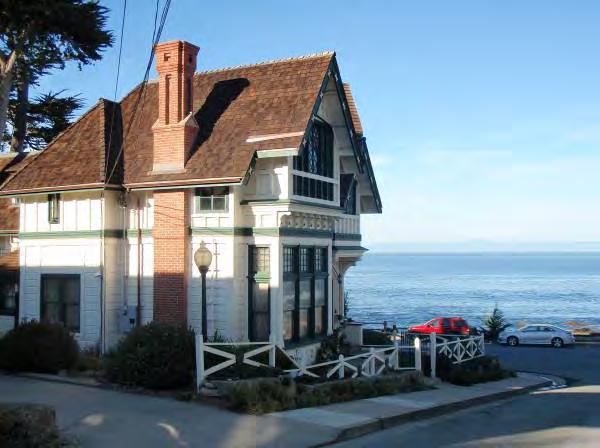
Copious use of applied decorative ornaments, often concentrated on porches or in the gable ends. Most frequently these include scrolled brackets and spindlework above the porch.
“Cutaway” slanted bay windows with brackets and pendants in the overhang
Patterned wood shingles—particularly fish scale shingles—in gable ends
Decorative half-timbering, most frequently on bay windows or in gable ends
Multi-light art glass window lights, most typically in the upper sash
3. Stick/Eastlake Style (1880s -1900)
Green Gables Inn, 104 5th Street (1888)
4. Queen Anne Style (1885 – 1910)
Dr. Hart Residence at 649 Lighthouse Avenue (1893) is a dramatic example of the Queen Anne style
Queen Anne cottage at 320 17th Street (1900). Note the combination of boxed and angled bay windows.
Historic Context Statement – Final
Historic
(1873 – 1902)
31 October 2011 Page & Turnbull, Inc. 99
The most common type of 19th century housing in Pacific Grove. Generally distinguished by an informal composition versus more “pure” examples of the styles named above.


Three common subtypes: tent cottages, gable-and-wing cottages, and hip-roofed cottages.
Tent cottages are small, narrow dwellings featuring a prominent front-facing gable.
Gable-and-wing designs usually features a projecting gable end intersecting a side gable Hip-roofed cottages have hip roofs, frequently with a pyramidal emphasis
All types typically feature porches with posts Wood board-and-batten or channel-drop cladding is most common
Often share decorative similarities with Stick/Eastlake and Queen Anne style buildings, particularly in the concentration of wood ornamentation around porches and in gable ends
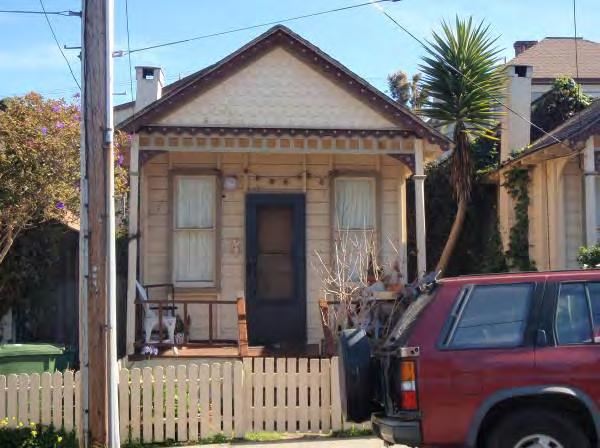 Historic Context Statement
City of Pacific Grove Historic Context – Grove,
4. Queen Anne Style (1885 – 1910), continued
Boarding houses like the Centrella Hotel at 612 Central Ave (1888) may also feature Queen Anne style influences
5. Folk Victorian (1885 – 1910)
Folk Victorian tent cottage, 112 18th Street (1886)
Folk Victorian tent cottage, 233 19th Street (1898)
Historic Context Statement
City of Pacific Grove Historic Context – Grove,
4. Queen Anne Style (1885 – 1910), continued
Boarding houses like the Centrella Hotel at 612 Central Ave (1888) may also feature Queen Anne style influences
5. Folk Victorian (1885 – 1910)
Folk Victorian tent cottage, 112 18th Street (1886)
Folk Victorian tent cottage, 233 19th Street (1898)
– Final
(1873
1902) Pacific
California 31 October 2011 Page & Turnbull, Inc. 100
Typically display limited ornamentation
Hip or gable roofs are most common Wood board-and-batten or channel-drop cladding is most common
Typically have porches with prominent posts May also include traditional or rustic forms. Vernacular structures associated with residences may also include barns or stables.
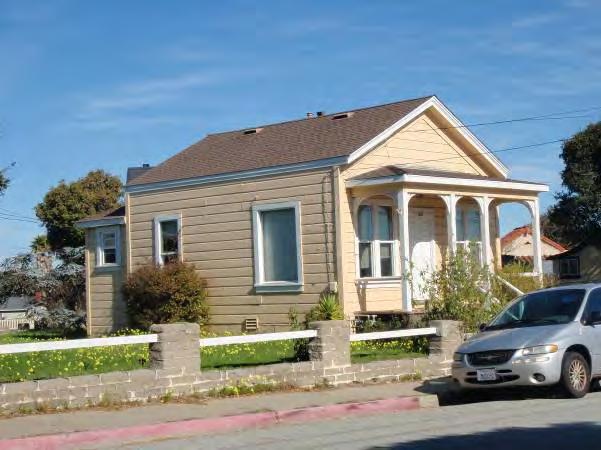
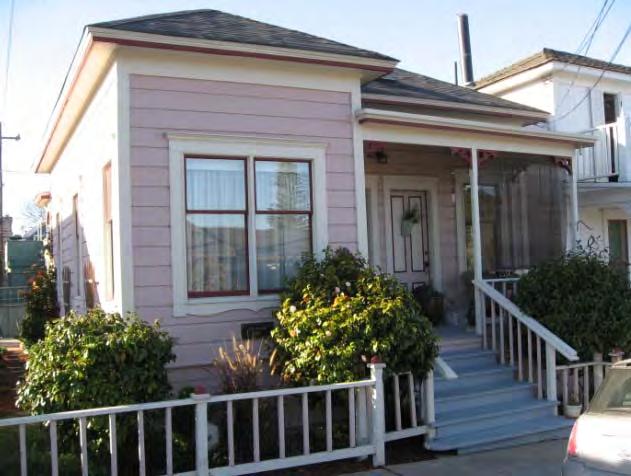

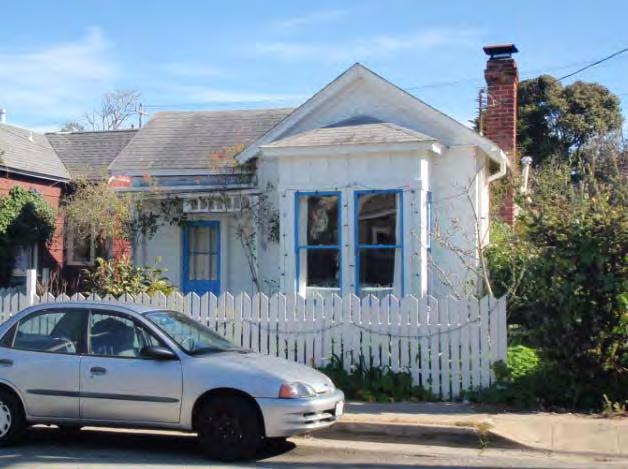 5. Folk Victorian (1885 – 1910), continued
Gable-and-wing cottage, 229 19th Street (1893)
Hip-roofed form, 120 18th Street (1886)
6. Vernacular (1890 – 1910)
This vernacular duplex at 124 18th Street (1887) employs few decorative elements
Vernacular residence at 420 Eardley (ca. 1900) employs few decorative elements
5. Folk Victorian (1885 – 1910), continued
Gable-and-wing cottage, 229 19th Street (1893)
Hip-roofed form, 120 18th Street (1886)
6. Vernacular (1890 – 1910)
This vernacular duplex at 124 18th Street (1887) employs few decorative elements
Vernacular residence at 420 Eardley (ca. 1900) employs few decorative elements
Historic Context Statement – Final City of Pacific Grove Historic Context (1873 – 1902) Pacific Grove, California 31 October 2011 Page & Turnbull, Inc. 101
Significance
The table below discusses the significance of residential buildings from this era according to criteria established by the National Register of Historic Places, California Register of Historical Resources, and the Pacific Grove Municipal Code. It appears that the vast majority of surviving residential buildings from this period are already listed on the City of Pacific Grove’s Historic Resources Inventory. Significance
Discussion
A/1 A, B Events, Patterns & Trends
Residential buildings from this period are significant for their association with the theme of residential development tied to the founding of Pacific Grove as both a religious retreat and its early development as an incorporated resort community. This association is frequently illustrated through simple, vernacular designs appropriate to seasonal use or as retirement cottages. For example, small board-and-batten tent cottages are able to convey the unusual, small lot divisions created for the Retreat, as well as the city’s early growth as a summer encampment. Grander residences may illustrate Pacific Grove’s early association with prominent individuals, as well as the financial success of some of the city’s early developers.
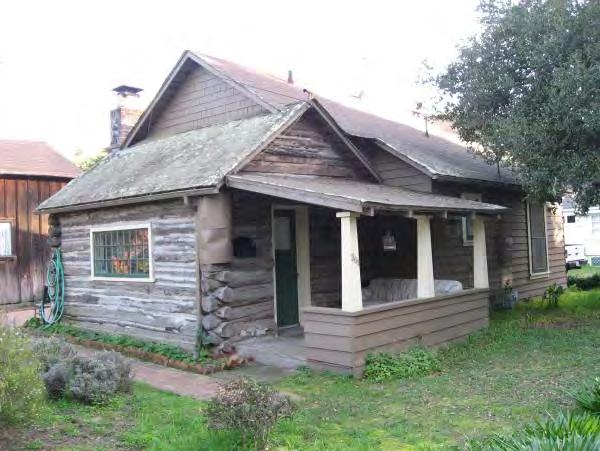
Groups of buildings may be better able to convey these
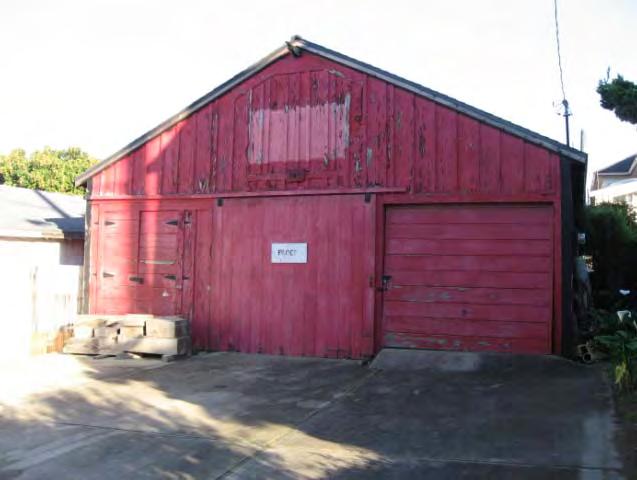 Vernacular designs can also include traditional or rustic forms, such as the log cabin at 301 Alder (1897)
Former stable behind 122 18th Street (facing 19th Street)
Vernacular designs can also include traditional or rustic forms, such as the log cabin at 301 Alder (1897)
Former stable behind 122 18th Street (facing 19th Street)
Historic Context Statement – Final City of Pacific Grove Historic Context (1873 – 1902) Pacific Grove, California 31 October 2011 Page & Turnbull, Inc. 102 6. Vernacular (1890 – 1910), continued
National/ California Register PG Municipal Code §23.76
National/ California Register
PG Municipal Code §23.76
Significance Discussion
patterns than individual structures; evaluators should consider the presence of historic districts that illustrate this criterion, though some properties may also qualify individually for their architectural merits or associations with prominent individuals (see below). Residences from this period may also be associated with ethnic or cultural groups, or may reflect the influence of the Pacific Grove Retreat Association or the Pacific Improvement Company.
B/2 C Persons Residential buildings from this period may be significant for their association with persons important to Pacific Grove history. Grander residences are more likely to be associated with significant persons, such as prominent merchants or religious officials; however, very early cottages may be associated with one of the city’s founding families. If this is the case, however, the residence should be compared to other associated properties to identify which property(s) best represents that person’s achievements or reasons for being significant.
Residential buildings from this period may be significant for their architecture, as expressed by intact stylistic features, forms or construction methods. Buildings may also qualify as the work of a master architect or prominent builder. Individual resources qualified under these criteria should be good examples of types and/or styles, and retain most of their original features. Tent cottages, modest dwellings, and grander residences may all be significant under these criteria as examples of their respective typologies.
D/4 Information Potential Buildings, ruins or subsurface remains that have the potential to yield important information about construction methods and materials, or the evolution of local residential building development may be significant for their potential to provide information important to history. However, such examples would be extremely rare.
C/3 D, E, F, G, H, I, J, K Architecture/ Design
Historic Context Statement – Final City of Pacific Grove Historic Context (1873 – 1902) Pacific Grove, California 31 October 2011 Page & Turnbull, Inc. 103
Integrity
In order to be eligible for listing in the local, state, or national historic registers, a residential property must retain sufficient integrity to convey its significance in association with residential development during this period. While most buildings undergo change over time, alterations should not significantly change the essential historic character of the building. Properties constructed prior to 1903 are relatively rare, and therefore some consideration for their age and rarity is warranted when considering integrity (see below: “Other Integrity Considerations”). Nevertheless, a residential property must retain essential physical features that made up its historic character. The aspects of integrity deemed most important for this period are design, materials, association and feeling.
Buildings would typically meet the threshold for addition to the local register if they meet the minimum eligibility requirements. Buildings qualified as individual resources at the state or national levels should exceed the minimum requirements, and should retain a substantial majority of their original features.
Minimum Eligibility Requirements:
Clear example of residential architecture from this period (should represent tent cottage, modest dwelling, or grander residence typology)
Retains original form and roofline
Substantially retains the original pattern of window and doors
Retains some of its original ornamentation. (The retention of entry, window and/or roofline ornamentation should be considered most important)
Replacement of doors and windows is acceptable as long as they substantially conform to the original door/window pattern and the size of the openings
Retention of the original cladding is important, but not absolute (see below)
Other Integrity Considerations:
It was not at all uncommon for houses to be moved during this period, and so integrity of location and setting should not be considered a paramount concern.
It is generally acceptable for entry stairs and porch features to have been replaced, as these are subject to greater deterioration from weathering and use—particularly in a seaside setting. However, replacement porches should substantially conform to the original configuration, and should not detract from the overall character of the residence.
Incompatible porch replacement would likely jeopardize a residence’s eligibility for the National Register.
Because many seasonal cottages were later adapted for year-round use, additions may be acceptable, particularly if they were made prior to approximately 1920 when construction materials were generally from the same palette. Rear additions that have respected the scale of the original building are also generally acceptable. However, more modern additions that compromise a building’s form and scale are not acceptable.
The replacement of the original cladding—most frequently stucco or asbestos siding over wood—is generally a severe detriment to integrity. It is generally only acceptable as long as
Historic Context Statement – Final City of Pacific Grove Historic Context (1873 – 1902) Pacific Grove, California 31 October 2011 Page & Turnbull, Inc. 104
all or nearly all of the remaining character-defining features are retained. Replacement of siding would likely jeopardize a residence’s eligibility for the National Register.
The retention of original windows greatly enhances integrity of materials, and likewise enhances integrity of design and workmanship. However, it should be recognized that window replacement was common during the mid-20th century. Thus, the fact that a building does not retain its original windows should not—in and of itself—be viewed as an obstacle to historic registration. Far more important is that the building retain its original pattern of windows, and that the replacement windows are located within the original frame openings. The National Park Service notes that “a property that has lost some historic materials or details can be eligible if it retains the majority of features that illustrate its style in terms of the massing, spatial relationships, proportion, pattern of windows and doors, texture of materials, and ornamentation.”246
A residence that was later altered into another style, such as a Victorian building remodeled with Mediterranean Revival influences, has lost association with this period, and should be considered to have association with the period during which it was altered—so long as the alteration adapts the character-defining features of the new style.
Nearly all residences from this period—especially larger homes—originally had associated ancillary structures, but most have been demolished over the years. An early Pacific Grove residence that retains its original ancillary buildings would be considered to have especially high integrity. These outbuildings derive their significance from the significance of the residence, and are typically not eligible in their own right.
The presence of original site or landscape features is not essential, but could enhance a property’s significance and integrity. Properties that retain elements such as walls, fences, steps, paths, and heritage trees are likely to qualify for listing in the National Register.
Residences that have been converted to commercial use are still eligible for listing under all criteria as long as they retain their overall form and architectural character. While such buildings no longer retain their original use, they can still be fine examples of Victorian-era and turn-of-the-century architectural styles and residential development patterns.
COMMERCIAL PROPERTIES
Although this period witnessed the formation of Pacific Grove’s central business district, surviving commercial buildings dating to this era are not common. As with their residential counterparts, commercial buildings of this period are typically modest, no more than two stories in height, and many would have originally featured residential space on their upper floor. As originally designed, many of these buildings conformed to the Western False Front pattern, distinguished by the use of a high false-front parapet designed to impress shoppers. However, within this period it became common for business owners to enlarge and remodel their buildings according to popular tastes and expanding business needs. Examples include Charles K. Tuttle’s drugstore at 551 Lighthouse Avenue, which was raised from one to two stories during this period and embellished with bowfront bay windows. Similarly, the adjacent building at 553 Lighthouse was embellished with Queen Anne style bay windows featuring decorative half-timbering.
Historic Context Statement – Final City of Pacific Grove Historic Context (1873 – 1902) Pacific Grove, California 31 October 2011 Page & Turnbull, Inc. 105
City of Pacific Grove Historic Context (1873 – 1902) Pacific Grove, California
The J. O. Johnson block at 219 Grand Avenue was also developed as a commercial property, although it contained a former Chinese laundry at its southern end. Clothes cleaning operations are more accurately categorized as a light industrial use, but this business is grouped commercial properties because the physical characteristics of the laundry building are more closely aligned with those of commercial structures. Sanborn maps indicate that the storefront used by the Chinese laundry shifted in use over the years, appearing in 1914 as a store, while returning to light industrial use as a plumber’s storage facility in 1926 and 1962.
Top Left: Original brick post office, 208 Forest Avenue.
Top Right: Charles K. Tuttle’s drugstore, 551 Lighthouse Avenue.
Bottom Left: Mixed-use building at 553 Lighthouse Avenue, with Queen Anne details.

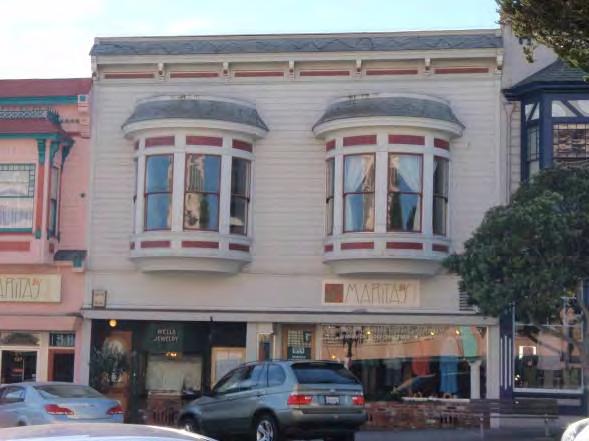
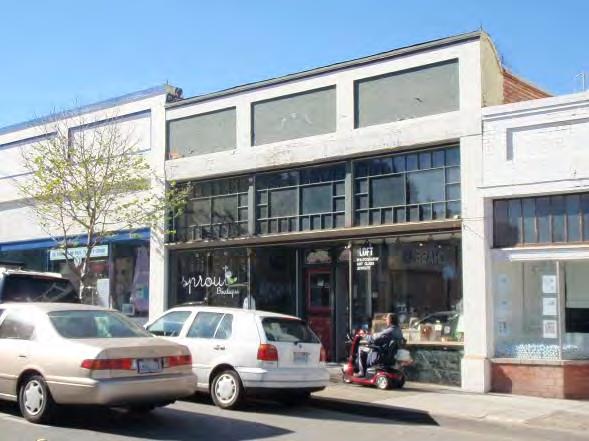
Bottom Right: J.O. Johnson Block at 219 Grand Avenue.
All but one of the surviving commercial buildings from this period are of wood frame construction, with the exception being the brick post office located at 208 Forest Avenue. Roofs are typically gabled, although Charles Tuttle’s drugstore incorporates a butterfly roof that is lower at center than at the ends. Covered porches or awnings at the first floor were originally a common feature, although all have been removed. Most typically, buildings of the period would have been originally clad in wood channel-drop or clapboard siding, and all would have incorporated double-hung woodsash windows and paneled or glazed wood doors. Original storefront systems would likely have been constructed using wood and glass.
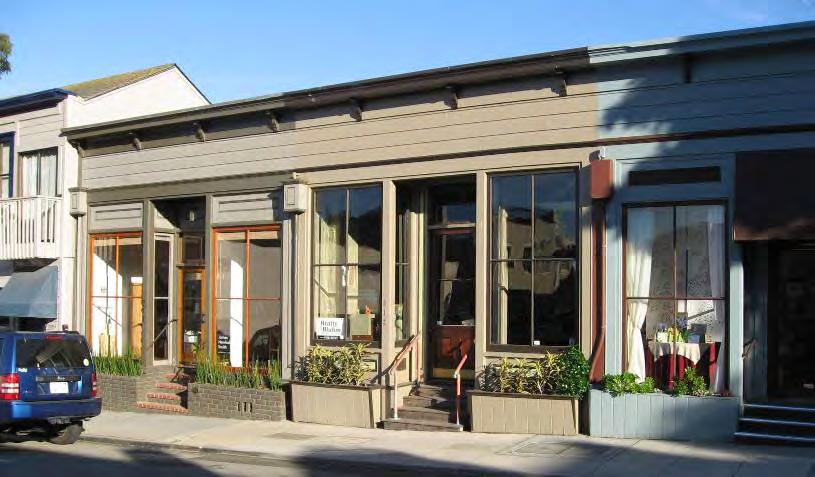
Historic Context Statement – Final
31 October 2011 Page & Turnbull, Inc. 106
Historic Context Statement – Final City of Pacific Grove Historic Context (1873 – 1902) Pacific Grove, California
Nearly all surviving buildings from this period are clustered along Forest, Fountain, Laurel and Lighthouse avenues in close proximity to Grand Avenue, as this area was the center of business activities during this period.
Significance
The table below discusses the significance of residential buildings from this era according to criteria established by the National Register of Historic Places, California Register of Historical Resources, and the Pacific Grove Municipal Code. Most commercial buildings from this period are already listed on the City of Pacific Grove’s Historic Resources Inventory.
Significance Discussion
A/1 A, B Events, Patterns & Trends
Commercial buildings from this period are significant for their association with the theme of commercial development tied to the establishment of commerce during the earliest period of development in Pacific Grove. These buildings illustrate nascent patterns of commercial development that helped cement the area along Lighthouse, Grand and Forest avenues as the city’s primary commercial area. Many buildings would most easily be qualified as contributors to a historic district, although some would qualify individually for their architectural merits or associations with prominent individuals (see below).
B/2 C Persons Commercial buildings from this period may be significant for their association with persons important to Pacific Grove’s history, such as prominent merchant, Charles K. Tuttle. If this is the case, however, the building should be compared to other associated properties to identify which property(s) best represent that person’s achievements or reasons for being significant. For commercial properties potentially eligible for the HRI, this criterion may also apply to businesses or organizations.
National/ California Register PG Municipal Code §23.76
31 October 2011 Page & Turnbull, Inc. 107
City of Pacific Grove Historic Context (1873 – 1902) Pacific Grove, California
National/ California Register PG Municipal Code §23.76 Significance
Discussion
C/3 D, E, F, G, H, I, J, K Architecture/ Design Commercial buildings from this period may be significant for their architecture, as expressed by intact stylistic features, forms or construction methods. Buildings may also qualify as the work of a master architect or prominent builder. Individual resources qualified under these criteria should be good examples of types and/or styles, and retain most of their original features.
D/4 Information Potential Buildings, ruins or subsurface remains that have the potential to yield important information about construction methods and materials, or the evolution of local commercial building development may be significant for their potential to provide information important to history. However, such examples would be rare.
Integrity
In order to be eligible for listing in the local, state, or national historic registers, a commercial property must retain sufficient integrity to convey its significance as part of commercial development during this period. While most buildings undergo change over time, alterations should not significantly change the essential historic character of the buildings. Commercial properties from this era are quite rare, and therefore discretion is warranted when considering integrity (see below: “Other Integrity Considerations”). Nevertheless, a commercial property must retain essential physical features that made up its historic character. The aspects of integrity deemed most important for this period are setting, design, materials, association and feeling.
Buildings would typically meet the threshold for addition to the local register if they meet the minimum eligibility requirements. Buildings qualified as individual resources at the state or national level should exceed the minimum requirements, and should retain a substantial majority of their original features. These include features such as clerestory windows, decorative trim, and prominent cornices or parapets. When assessing storefront alterations, particularly in multi-story commercial or mixed-use buildings, consider whether or not a storefront alteration is still subordinate to the overall character of the building.
Minimum Eligibility Requirements:
Clear example of commercial architecture from this period
Retains original form and roofline
Substantially retains the original pattern of window and doors. Storefront alterations, particularly in multi-story commercial buildings, can be acceptable (see integrity considerations below)
Historic Context Statement – Final
31 October 2011 Page & Turnbull, Inc. 108
City of Pacific Grove Historic Context (1873 – 1902) Pacific Grove, California
Retains at least some of its original ornamentation, if applicable. The retention of entry, window and/or roofline ornamentation should be considered most important.
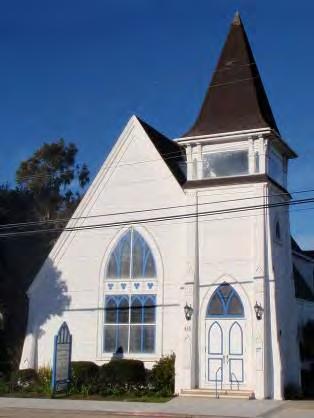
Replacement of doors and windows is acceptable as long as they conform, or substantially conform, to the original door/window pattern and the size of the openings


Other Integrity Considerations:



Commercial buildings from this period that retain their original storefront configurations are extremely rare. In multi-story commercial buildings, ground floor alterations should be considered acceptable as long as they are subordinate to the overall character of the building. Similarly, storefront alterations that demonstrate evolving commercial design patterns associated with a subsequent historically significant context may be acceptable.
Rear additions that have respected the scale of the original building are generally acceptable. However, more recent additions, especially those that compromise a building’s form and scale, are not acceptable.



The replacement of the original cladding is only acceptable as long as enough characterdefining features are retained that the building can be clearly read as historic. In these instances, buildings should only be registered as contributors to a district, rather than as individual resources. Similarly, the application of ornamentation associated with evolving commercial patterns/styles during a subsequent historically significant context may be acceptable in certain instances. In these cases, the building loses association with the Early Pacific Grove period, but may gain association with the subsequent period when the alteration occurred.
CIVIC & PUBLIC ASSEMBLY PROPERTIES
Pacific Grove’s surviving civic & public assembly facilities from this period are quite rare, and include the Chautauqua Hall as well as two churches: St. Mary’s-by-the-Sea and the First Christian Church. (The 1902 post office on Forest Avenue is more closely aligned with commercial architecture of the period, and thus is grouped within that category.)
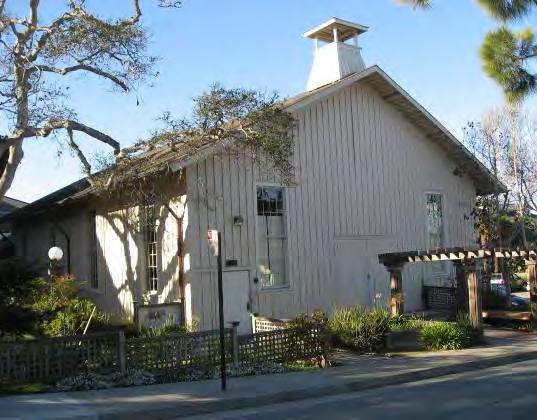 Left to right: Chautauqua Hall (1881), First Christian Church (1890), St. Mary’s-by-the-Sea (1887)
Left to right: Chautauqua Hall (1881), First Christian Church (1890), St. Mary’s-by-the-Sea (1887)
Historic Context Statement – Final
31 October 2011 Page & Turnbull, Inc. 109
Historic Context Statement – Final City of Pacific Grove Historic Context (1873 – 1902) Pacific Grove, California
These buildings are generally impressive and typically were constructed as one-story or one-story double height structures. All are wood frame, and all originally featured wood-sash windows and paneled or glazed wood doors. Stylistically, the two churches show character-defining features of the Gothic Revival style, which was extremely popular for church architecture during this period. In keeping with its rustic origins during the early years of the Retreat, the Chautauqua Hall is much more vernacular in nature.
As a group, these three buildings are significant as expressions of religious and cultural values tied to the earliest period of growth in Pacific Grove.
Significance
The table below discusses the significance of civic & public assembly buildings from this era according to criteria established by the National Register of Historic Places, California Register of Historical Resources, and the Pacific Grove Municipal Code. These properties’ significance is enhanced by their extreme scarcity, and all have been appropriately listed in the City of Pacific Grove’s Historic Resources Inventory. The Chautauqua Hall is likewise listed as a California State Historical Landmark.
A/1 A, B Events, Patterns & Trends
Civic & public assembly buildings from this period are significant as expressions of religious and cultural values tied to the earliest period of growth in Pacific Grove. The Chautauqua Hall represents that movement’s lasting impact on the culture and character of the city, while the two churches are excellent representatives of the overtly religious character of Pacific Grove during this period. Please note that historic significance for a church or other religious property cannot be established on the merits of a religious doctrine, but rather on secular terms for its architectural or artistic values or as a representation of important historic or cultural forces.
B/2 C Persons Civic & public assembly buildings from this period may be significant for their association with persons important to Pacific Grove’s history, such as an early religious leader. If this is the case, however, the building should be compared to other associated properties to identify which property(s) best represent that person’s achievements or reasons for being significant.
National/ California Register PG Municipal Code §23.76 Significance Discussion
31 October 2011 Page & Turnbull, Inc. 110
Historic Context Statement – Final
City of Pacific Grove Historic Context (1873 – 1902) Pacific Grove, California
National/ California Register PG Municipal Code §23.76 Significance Discussion
C/3 D, E, F, G, H, I, J, K Architecture/ Design Civic & public assembly buildings from this period may be significant for their architecture, either as an expression of rustic vernacular design (Chautauqua Hall), or as examples of religious architecture. In particular, St. Mary’s-by-the-Sea is both associated with a master architect, Ernest Coxhead, and is a notable example of Gothic Revival design tempered by the influences of the Arts and Crafts movement.
D/4 Information Potential Buildings, ruins or subsurface remains that have the potential to yield important information about construction methods and materials, or the evolution of local building development may be significant for their potential to provide information important to history. However, such examples would be extremely rare.
In addition to meeting the eligibility requirements outlined in this table, if a church from this period is to be considered for listing in the National Register, it must also meet National Register Criteria Consideration A (Religious Properties). This Criteria states in part that a “religious property requires justification on architectural, artistic, or historic grounds to avoid any appearance of judgment by government about the validity of any religion or belief.” Even if the church is only being evaluated for its eligibility for the state or local register, this information may be helpful in determining the property’s potential significance. For further details, see the National Register Bulletin #15 – How to Apply the National Register Criteria For Evaluation. Under California Assembly Bill 133, a religious property cannot be listed in the Pacific Grove HRI above the objection of the religious institution.
Integrity
In order to be eligible for listing in the local, state, or national historic registers, a civic & public assembly building must retain sufficient integrity to convey its significance as part of development during this period. While most buildings undergo change over time, alterations should not significantly change the essential historic character of the buildings. Buildings qualified as individual resources at the state or national levels should retain a substantial majority of their original features. The aspects of integrity deemed most important for this period are location, design, materials, association and feeling.
Minimum Eligibility Requirements:
Clear example of civic or public assembly architecture of the period
Retains original form and roofline
Substantially retains the original pattern of window and doors
31 October 2011 Page & Turnbull, Inc. 111
City of Pacific Grove Historic Context (1873 – 1902) Pacific Grove, California
Retains some of its original ornamentation. (The retention of entry, window and/or roofline ornamentation should be considered most important)
Replacement of doors and windows can be acceptable as long as they conform to the original door/window pattern and the size of the openings Retention of the original cladding is important, but not absolute (see below)
Other Integrity Considerations:
Alterations that have included the use of conjectural decorative elements to create a false sense of history are not acceptable.
Additions that have respected the scale of the original building are generally acceptable. However, additions that compromise a building’s form and massing are not acceptable.
CULTURAL LANDSCAPE ELEMENTS
Significant themes from this period can be illustrated by cultural landscapes, as well as by the traditional built resources described above. As mentioned previously, site features such as retaining walls, wrought iron fences, and large specimen trees associated with a residence should be evaluated in conjunction with that residence. Similarly, landscaped or designed grounds of a church or other civic facility should be evaluated in conjunction with those institutional properties. Known extant cultural landscapes from this period include sites such as the El Carmelo Cemetery and public parks.
Character-defining features that may collectively contribute to a cultural landscape from this period include:
Vegetation
Circulation (e.g. roads, paths, steps, and walls)
Site objects (e.g. fences, benches, lights, and sculptures)
Structures
Left: Concrete site wall and wrought iron fence at Trimmer Hill (1893). Right: El Carmelo Cemetery (1889).
Historic Context Statement – Final
31 October 2011 Page & Turnbull, Inc. 112
Topography
features and
or buildings
Historic Context Statement – Final City of Pacific Grove Historic Context (1873 – 1902) Pacific Grove, California
Significance
The table below discusses the significance of cultural landscapes from this era according to criteria established by the National Register of Historic Places, California Register of Historical Resources, and the Pacific Grove Municipal Code. These properties do not appear to be listed in the City of Pacific Grove’s Historic Resources Inventory.
National/ California Register PG Municipal Code §23.76 Significance
A/1 A, B Events, Patterns & Trends
Discussion
Cultural landscapes from this period may be significant as expressions of the transition of the Retreat from a summer encampment to a permanent city. For example, the establishment of public parks and the El Carmelo Cemetery help illustrate the early settlement of the city, or may have been the site of an important event.
B/2 C Persons Cultural landscapes from this period are not likely to be significant under this criterion for their associations with important persons.
C/3 D, E, F, G, H, I, J, K
Architecture/ Design Cultural landscapes from this period may be significant for their distinctive design values. In order to qualify under this criterion, the landscape must be purposefully designed, and must clearly express aesthetic principles or technological achievements in city planning, landscape architecture, engineering, or sculpture. These properties may also be significant if they represent the work of a master landscape architect.
D/4 Information Potential Cultural landscapes from this period are not likely to yield important information not available in built resources or other extant documentary evidence.
In addition to meeting the eligibility requirements outlined in this table, if the El Carmelo Cemetery is to be considered for listing in the National Register, it must also meet National Register Criteria Consideration D (Cemeteries). Even if the cemetery is only being evaluated for its eligibility in the state or local register, this information may be helpful in determining the property’s potential significance as a cultural landscape.
31 October 2011 Page & Turnbull, Inc. 113
Integrity
In order to be eligible for listing in the local, state, or national historic registers, a cultural landscape must retain sufficient integrity to convey its association with development trends during this period. Even more so than buildings, cultural landscapes—especially vegetation—are anticipated to experience change over time. An understanding of the landscape as a continuum through history is therefore critical in assessing its cultural and historic value, and a clear definition and understanding of the landscape’s period of significance is essential. In order for the landscape to have integrity, these character-defining features or qualities that contribute to its significance must be present, and integrity of setting becomes a particularly important aspect. Landscapes qualified as individual resources at the local, state or national level should generally retain a majority of their original features.
Historic Context Statement – Final City of Pacific Grove Historic Context (1873 – 1902) Pacific Grove, California 31 October 2011 Page & Turnbull, Inc. 114
Historic Context Statement – Final
City of Pacific Grove Historic Context (1903 – 1926) Grove, California

D. Pacific Grove Comes of Age (1903 - 1926)
The period 1903 – 1926 is dominated by the expansion of Pacific Grove’s commercial, civic and tourist facilities, as well as the redevelopment of several touchstones of the old Retreat. It also witnessed the advent of the private automobile, which would have a profound effect on the city’s built environment. The primary historic themes and events of this period include the following:
The transformation of the beach area at Lovers Point into a fully-developed tourist destination.
The arrival of large-scale commercial development along Lighthouse Avenue employing new architectural styles and building materials.
The destruction of the Chinese fishing village and redevelopment of China Point.
The maturation of the city as evidenced by the construction of a new firehouse, library, museum, new elementary and high schools, and the city’s first dedicated City Hall.
The creation of Del Monte Properties as a successor firm to the Pacific Investment Company and its influence on the sale of lots and development of subdivisions.
The end of the Chautauqua and the “tent camping” era.
The growing influence of the private automobile as seen in commercial, light industrial and residential development patterns.
The year 1903 was full of symbolism for Pacific Grove’s future. For one, the age of electricity was firmly stamped on the city with the electrification of the Monterey & Pacific Grove Street Railway.247 Overhead electric wires were strung up along Central and Lighthouse avenues to serve the streetcar’s route, and the old horse car barn with its hay loft and horse stalls was abandoned.248 This was also the year that the city for the first time acquired a portion of its waterfront for public use by purchasing property at the tip of Lovers Point from the PIC for $1,000. Although this heralded more public investment in the coming decades, the immediate future of Pacific Grove’s waterfront belonged to private interests. Indeed, within the next few years the beach area at Lovers Point would
“Panorama of Pacific Grove,” 1908 (Courtesy the Heritage Society of Pacific Grove)
Pacific
31 October 2011 Page & Turnbull, Inc. 115
Historic Context Statement – Final City of Pacific Grove Historic Context (1903 – 1926) Pacific Grove, California
witness an explosion of private construction activity that transformed the cove from a sedate retreat for bathers and boaters into a fully-fledged seaside entertainment complex. These same years would also witness a flurry of commercial development along Lighthouse Avenue, which brought with it impressive new edifices featuring modern construction methods, new materials and new architectural styles.
Extant properties capable of representing these significant themes include residential properties, commercial properties, civic & public assembly properties, light industrial properties, and cultural landscape elements. Although auto camps & cottage courts were an important property type during this period, there do not appear to be any extant examples today. The overwhelming majority of surviving buildings constructed between 1903 and 1926 are single-family residences designed in period revival styles that represented a dramatic shift from earlier eras—most easily recognized by a transition from wood to stucco cladding. This was also a key period of expansion of Pacific Grove’s central business district, which introduced new architectural styles, construction methods and materials.
31 October 2011 Page & Turnbull, Inc. 116
Historic Context Statement – Final City of Pacific Grove Historic Context (1903 – 1926) Pacific Grove, California 31 October 2011 Page & Turnbull, Inc. 117 DAVID 17 MILE SINEX FOREST 9OCEANVIEW TH 16TH A S L O M A R LINE 117TH 9TH 7TH 18TH PICO CEDAR GIBSON 8TH IRVING PRESCOTT JEWELL 4TH PINE CONGRESS MASON OAK 6TH CENTRAL JUNIPERO LILY 11TH 12TH 10TH RECTRAIL WALNUT PARK FOUNTAIN CARMEL AGRAND LDER LAINE 5TH HWY68 3RD SU NSET WOOD HOFFMAN EARDLEY 2ND CR O C K ER 1ST 15TH GRO V E ACR E BELDEN 13TH SURF ARCHER LOCUST DELMONTE WILLOW M A J E L L A SPENCER BALBOA MILES BAYVIEW HIGH ALICE FOREST LODGE WITHERS SFBMORSE GRANITE CREST SHELL EGAN LINCOLN HILLCREST MONTEREY TERRY SKYLINE FUNSTON JESSIELOBOS CLAY CH ESTNUT LOTTIE SPRUCE GRACE RIPPLE TAYLOR HARRISON PARCEL MAPLE FRANKLIN HELLAM VIA DEL REY LYNDON FILMORE A R M Y SEAVIEW CYPRESS ROOSEVELT EVANS PR IVAT E B OL IO MORSE MERMAID NEWTON SYIDA BENITO SLOAT MELROSE LAWTON DRAKE SEAPALM SHAFTER PR ES DIO JOHNSON RA NS FO RD PACIFIC DENNETT CORAL HAWTHORNE MONTECITO ORTEGA RIDGE SHORT FOAM MCCLELLAN 14TH DEVISADERO JEFFERSON S T I L L W E LL FITCH AUSTIN STUART ARENA ORD RIFLE RANGE MADISON BEAUMONT SP RAY MACARTHUR CRAMDEN SERRA DEWEY HE RR MA NN R A I LR O A D R I GH TO FW AY RICKETTS ROW E V E R G R E E N SIREN DRYCREEK LEWIS GROVE HILLSIDE LIGHTHOUSE SPAZIER CPL EVANS TIMBER BWAINWRIGHT ISHOP BE NTLEY PATTERSON CHAPARRAL BEACON RACCOON RUTH ACACIA GATE LAUREL 20TH OLMSTEAD PINE HILL BRIGGS A C R O P O L S CABRILLO SGTFRONIUS BOWEN ROSEMONT PLUM MER MARINO PINES COLTON CALEDONIA SAGE PIEDMONT FINFANTRY OREST HILL CPL EVANS EL CAL LE JO NE GLEN LAKE V A D EL P I NA R KIT CA RS ON HACHIYA TR EASURE MONARCH KENET PAR AD ISE PAR K DAY SPANISH BAY PETRA TANGLEWOOD PAC I F C G R OV E UNION TODD AIR OFORCE TTER MORELAND ADOBE CLARK CAFFREY GARDEN WALCOTT L A U RI E ACORN LA SELVA CH UA LA R AVALON LORE LEI NAVAJO FOREST PARK MARINE MOSS 19TH H E R R M A N N PINE PINE CYPRESS 13TH SUNSET MC CL EL LA N PRESIDIO PIEDMONT CROCKER JEWELL RANSFO RD PRESIDIO 14TH 14TH LIGHTHOUSE 2ND 2ND LAUREL PARK LOBOS NEWTON LAWTON RANSFORD LIGHTHOUSE OAK SHELL SHORT SPRUCE SLOAT FITCH CONGRESS CityofPacificGrove YearBuilt:1903-1926 1903-1909 1910-1919 1920-1926 Page&Turnbull,Inc./24June2011 ° Properties constructed during “Pacific Grove Comes of Age” period (1903-1926) (Page & Turnbull)
Historic Context Statement – Final City of Pacific Grove Historic Context (1903 – 1926) Pacific Grove, California 31 October 2011 Page & Turnbull, Inc. 118 DAVID 17 MILE SINEX FOREST 9OCEANVIEW TH 16TH A S LO M A R LINE 117TH 9TH 7TH 18TH PICO CEDAR GIBSON 8TH IRVING PRESCOTT JEWELL 4TH PINE CONGRESS MASON OAK 6TH CENTRAL JUNIPERO LILY 11TH 12TH 10TH RECTRAIL WALNUT PARK FOUNTAIN CARMEL AGRAND LDER LAINE 5TH HWY68 3RD SU NSET WOOD HOFFMAN EARDLEY 2ND C R O C K E R 1ST 15TH GRO V E A C R E BELDEN 13TH SURF ARCHER LOCUST DELMONTE WILLOW M A J E L L A SPENCER BALBOA MILES BAYVIEW HIGH ALICE FOREST LODGE WITHERS SFBMORSE GRANITE CREST SHELL EGAN LINCOLN HILLCREST MONTEREY TERRY SKYLINE FUNSTON JESSIELOBOS CLAY CHESTNUT LOTTIE SPRUCE GRACE RIPPLE TAYLOR HARRISON PARCEL MAPLE FRANKLIN HELLAM VIA DELREY LYNDON FILMORE A R M Y SEAVIEW CYPRESS ROOSEVELT EVANS PR IVAT E B OL IO MORSE MERMAID NEWTON SYIDA BENITO SLOAT MELROSE LAWTON DRAKE SEAPALM SHAFTER PR ES IDIO JOHNSON RA NS FO RD PACIFIC DENNETT CORAL HAWTHORNE MONTECITO ORTEGA RIDGE SHORT FOAM MCCLELLAN 14TH DEVISADERO JEFFERSON S T I L L W E LL FITCH AUSTIN STUART ARENA ORD RIFLE RANGE MADISON BEAUMONT SP RAY MACARTHUR CRAMDEN SERRA DEWEY HE RR MA NN R A I LR O A D R I G H T O F W AY RICKETTS ROW E V E R G R E E N SIREN DRYCREEK LEWIS GROVE HILLSIDE LIGHTHOUSE SPAZIER CPL EVANS TIMBER BWAINWRIGHT ISHOP BENTLEY PATTERSON CHAPARRAL BEACON RACCOON RUTH ACACIA GATE LAUREL 20TH OLMSTEAD PINE HILL BRIGGS A C R O P O L S CABRILLO SGTFRONIUS BOWEN ROSEMONT PLUM ME R MARINO PINES COLTON CALEDONIA SAGE PIEDMONT FINFANTRY OREST HILL CPL EVANS EL C AL LE JO N E GLEN LAKE V A D EL P I N A R KIT CA RS ON HACHIYA TR EASURE MONARCH KENET PAR ADISE PARK DAY SPANISH BAY PETRA TANGLEWOOD PAC I F C G R OV E UNION TODD AIR OFORCE TTER MORELAND ADOBE CLARK CAFFREY GARDEN WALCOTT L A U RI E ACORN LA SELVA CH UA LA R AVALON LORELEI NAVAJO FOREST PARK MARINE MOSS 19TH H E R R M A N N PINE PINE CYPRESS 13TH SUNSET MC CL EL LA N PRESIDIO PIEDMONT CROCKER JEWELL RA NSFO RD PRESIDIO 14TH 14TH LIGHTHOUSE 2ND 2ND LAUREL PARK LOBOS NEWTON LAWTON RANSFORD LIGHTHOUSE OAK SHELL SHORT SPRUCE SLOAT FITCH CONGRESS CityofPacificGrove Subdivisions&Annexations (1903-1926) Page&Turnbull,Inc./24June2011 ° UT TT NUT ORES N SS T ForestPark (1914) ONTE PALB BeachTract (1916) E MermaidAlley (1916) FifthAddition (1907) E INE Y FourthAddition (1905) VCEANVIEW EWEY LO UniversityTract (1909) IC AHORT O (1919) ILLC 4TH BE R DA HillcrestAddition (1912) Subdivisions and additions platted during “Pacific Grove Comes of Age” period (1903-1926) (Page & Turnbull)
City of Pacific Grove Context 1926) Pacific Grove, California
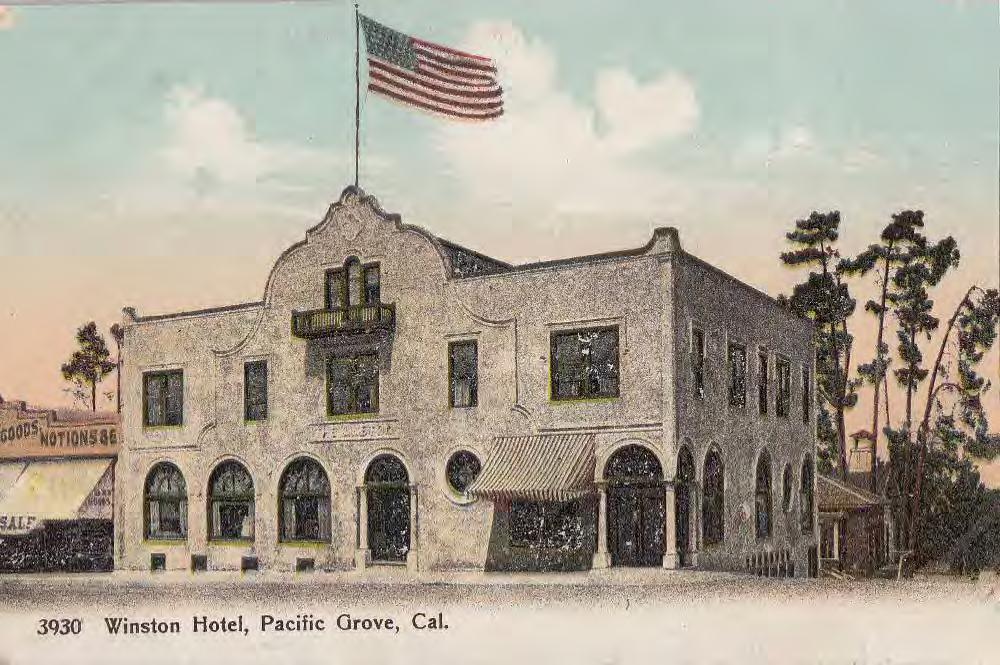
EXPANSION OF THE BUSINESS DISTRICT
In 1903 President Theodore Roosevelt paid a brief visit to Pacific Grove, riding out Lighthouse Avenue on a pleasure excursion from the Del Monte Hotel. He may as well been leading a symbolic charge, for 1903 brought with it the first in a rapid series of commercial developments that would dramatically remake the business district along Lighthouse Avenue. The first to appear was the twostory Hotel Del Mar, constructed in 1903 on the southwest corner of Lighthouse Avenue and 16th Street. The hotel included 46 rooms, while also featuring a dry goods store on the ground floor. Its construction was financed by Thomas A. Work, who would soon emerge as Pacific Grove’s most important developer of the early twentieth century.249
The construction of the Hotel Del Mar was quickly followed by the construction of the Winston Building, located directly across the street on the northwest corner of Lighthouse Avenue and 16th Street. Developed for Byron Calvin Winston and built by contractor Abraham Lee, the Winston Building opened for business on May 28, 1904. It included a bakery and ice cream room in its basement, while the first floor included a “women’s exchange” with a dining room on the kitchen. The second floor featured sixteen bedrooms and apartments, as well as a social hall. A large sitting room with balcony was located on the 3rd floor.250
Early postcard of Winston Hotel, n.d. (Courtesy Charles Huff)
Historic Context Statement – Final
Historic
(1903 –
31 October 2011 Page & Turnbull, Inc. 119
Historic Context Statement – Final City of Pacific Grove Historic Context (1903 – 1926) Pacific Grove, California
The multiplicity of uses was not uncommon for the era. What made the Winston Building truly notable is that it appears to have been the first building in Pacific Grove to be completed in the Mission Revival style, as well as the first to feature stucco exterior cladding. The Mission Revival style was then rising in popularity, promoted most prominently by the Southern Pacific Railroad, which used Mission-inspired designs for several of its rail stations. The style also reflected a rising nostalgia for California’s past, and in the coming decades buildings that attempted to mimic features used during the Spanish era in California would become extremely popular.
Directly west of the Winston Building—and constructed the same year—was R. L. Holman’s new department store. It, too, was on the architectural vanguard, as it appears to have been the first reinforced-concrete building constructed in Pacific Grove (no longer extant). Holman sold clothing, shoes, notions and other goods on the main floor, while furniture was displayed in the basement. Despite its modern construction methods, the building’s stepped parapet was a clear homage to the Western False Front design that marked the Grove’s earliest businesses.
Wholly unlike the Winston and Holman buildings—yet still a dramatic departure from Pacific Grove’s early commercial buildings—was the new and impressive Bank of Pacific Grove, constructed by Thomas A. Work at the northeast corner of Lighthouse and Forest Avenue in 1904 (known today as the Bratty Building). Featuring a dramatic stone-clad façade, the bank was the first of several buildings to intrude upon the capacious grounds of the El Carmelo Hotel, and doubtless the sale of the property could not have been completed unless it was the express desire of the PIC to see the land developed. In fact, prior to the building’s completion, the Bank of Pacific Grove had been operating out of the PIC office, which at that time was located a few steps away on the northwest corner of Lighthouse and Grand. Among the officers of the bank were Oliver S. Trimmer, president, while Bedson A. Eardley served as one of the directors. 251
 Holman’s Department Store, circa 1910 (Genie O’Meara Santini, reproduced in Images of America: Pacific Grove, p. 85)
Holman’s Department Store, circa 1910 (Genie O’Meara Santini, reproduced in Images of America: Pacific Grove, p. 85)
31 October 2011 Page & Turnbull, Inc. 120
The new bank was designed in the Romanesque Revival style by the Watsonville-based architect William Weeks, who—much like Thomas Work—would soon leave his stamp on many notable buildings in Pacific Grove. Overseeing construction was the McPhee Company of San Francisco, which used gray sandstone from Arizona and red sandstone from Colusa County to cover the building’s exterior. A town clock purchased by Edward Lewis would also be installed on the front of the building in 1910.252
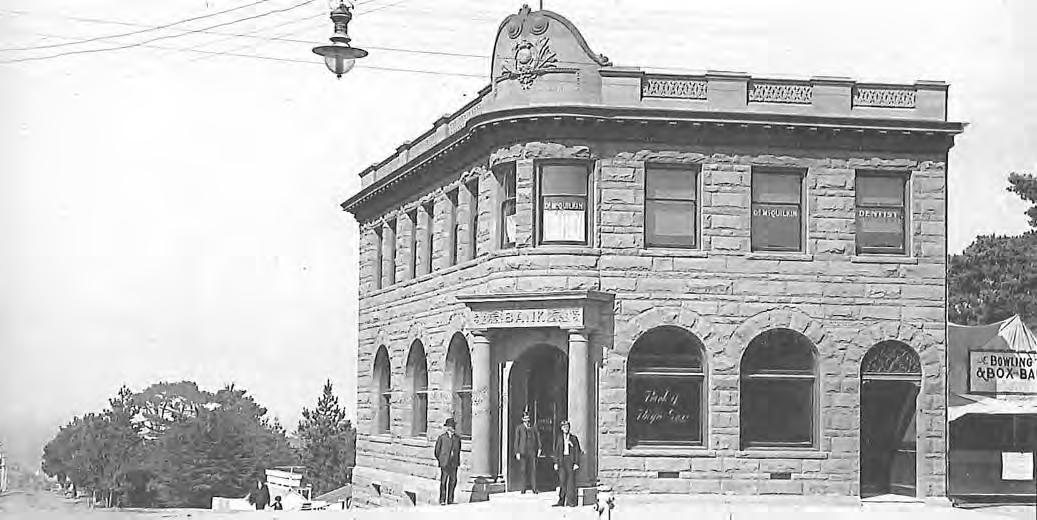
Thomas A. Work was born in Scotland in 1868, and had arrived in the Monterey area in 1883. One of his first jobs was working at the Bodfish Dairy in Pacific Grove, but he soon branched out into business for himself.253 As early as 1890, newspaper advertisements show him operating a feed lot and lumber yard, which was located on the west side of Forest Avenue north of Laurel Avenue. By 1892 he was operating a “Cheap Cash Store,” and appears to have quickly prospered in both the building supply business and real estate, including the sale of what would become the Carmel Highlands.254 By 1903 he was serving as a director for the First National Bank of Monterey, and had also gained control of the bathhouse at Lovers Point. He also operated a large lumber yard on the Pacific Grove-Monterey border, and developed portions of New Monterey. At one point he even formed a syndicate with the intention of purchasing all of the PIC’s land holdings in Pacific Grove.255
For the immediate future, however, Work’s next project was the development of the “Work Block” building, located directly adjacent to the Bank of Pacific Grove (extant). Completed in 1905, the Work Block was designed by Columbus J. Ryland, and wrapped around the bank in an L shape with entrances on both Lighthouse and Forest avenues.256 Its construction was unique for Pacific Grove at the time, featuring a combination of wood post, red sandstone and hollow cement block
Bratty Building, 1904. (C.K. Tuttle Collection, Pacific Grove Museum of Natural History, reproduced in Images of America: Pacific Grove, p. 87)
Historic Context Statement – Final City of Pacific Grove Historic Context (1903 – 1926) Pacific Grove, California 31 October 2011 Page & Turnbull, Inc. 121
City of Pacific Grove Historic Context (1903 – 1926) Pacific Grove, California
construction. The first floor included a hardware store, while a lodge hall was located on the second story.257 At the time of its completion, Sanborn maps indicate that the old cottages on the west side of Grand Avenue (then in use as cottages for the El Carmelo Hotel) were still standing immediately to the east as one of the last markers of the old Retreat.
Between 1905 and 1906 the Work Block was expanded eastward. An article of the period mentions that the building employed wood-frame construction, with a veneer of hollow-core, stone-faced concrete block. The plans were again drawn by William Weeks, and construction was managed by George Quentel, Work’s building supervisor.258 The eastern-most portion of this new building included the Colonial Theater, which was one of the first motion picture houses to open in Pacific Grove.259
Other new businesses included the New Pavilion Skating Rink, which opened at 500 Lighthouse in 1906. Financed by Alvah Hiserman, the building would be badly damaged by fire in 1911, and in 1925 it was remodeled into a plumbing shop for L.C. Ryan & Sons (no longer extant).260
Within a few years, the business district would primarily extend south of Lighthouse Avenue. By 1914, these included a one-story reinforced concrete building at 214 – 218 Forest Avenue that included three storefronts for a bakery, meat market, and the Wells Fargo Express office (extant) The building at 208 Forest was also extended to the rear of the lot for a plumbing store (extant). One block over, a bakery was built at 214 16th Street (no longer extant). To the southeast, a clothes cleaners building was also established on the southeast corner of Fountain and Laurel (extant but altered). Expansion of the business district is a key theme during this time period, and thus commercial properties from this era associated with this theme may be significant.
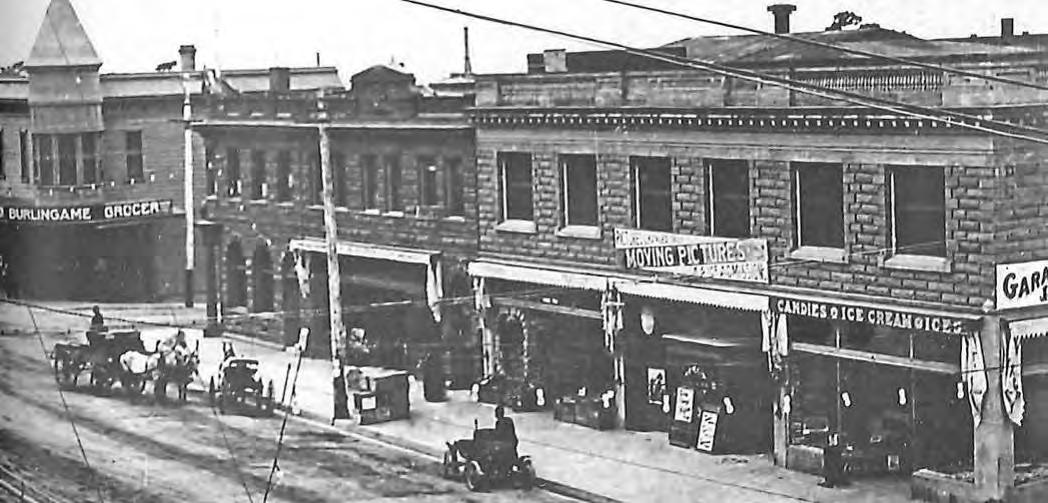 T.A. Work Block, circa 1912 (C.K. Tuttle Collection, Pacific Grove Museum of Natural History, reproduced in Images of America: Pacific Grove, p. 87)
T.A. Work Block, circa 1912 (C.K. Tuttle Collection, Pacific Grove Museum of Natural History, reproduced in Images of America: Pacific Grove, p. 87)
Historic Context Statement – Final
31 October 2011 Page & Turnbull, Inc. 122
LOVERS POINT REMADE
The beach at Lovers Point had been a focal point of recreation in Pacific Grove since the first retreat in 1875. Nevertheless, the development of dedicated recreational facilities at the beach had been fairly restrained throughout the late nineteenth century. A new bathhouse and pier had been constructed in the 1890s, but it was not until 1904 that Lovers Point began to develop in earnest as a resort unto itself. In fact, over the next decade the area would be ringed with an array of amusements and recreational facilities that far exceeded anything that would follow. Any remaining features from this period at Lovers Point may therefore be significant as examples of this active resort development.
In 1904, William Fielding Smith (1859 – 1947), commonly referred to as “Bathhouse Smith,” acquired a long-term lease to the beachfront land at Lovers Point from Thomas A. Work. Almost immediately Smith began work to enlarge the beach, blasting away the cliff rocks and cutting back the seawall a full forty feet (some of this rock was used for Work’s new building on Lighthouse Avenue). Caledonia Gulch—the drainage wash that had created the beach cove in the first place— was also filled in between the intersection of 17th Street and Ocean View Boulevard, and a drain pipe installed. This allowed 17th Street to be connected to Lovers Point.261
With the re-contouring of the land complete, Smith then constructed a new bathhouse, as well as a new boathouse, and brought in a small fleet of rental boats including rowboats, a motorboat, two sailboats and a fishing boat.262 Compared to earlier efforts, the new bathhouse was a marvel, featuring 180 dressing rooms and 25 bathrooms. A skylight illuminated a 45’ x 80’ heated cement pool known as the “plunge,” which was kept at 83 degrees and had a capacity of 120 people. That same year, a house was built for Smith at Lovers Point, while a one-story, wood-frame Japanese Tea House was built for Otosaburo Noda, who leased the land from Smith.263
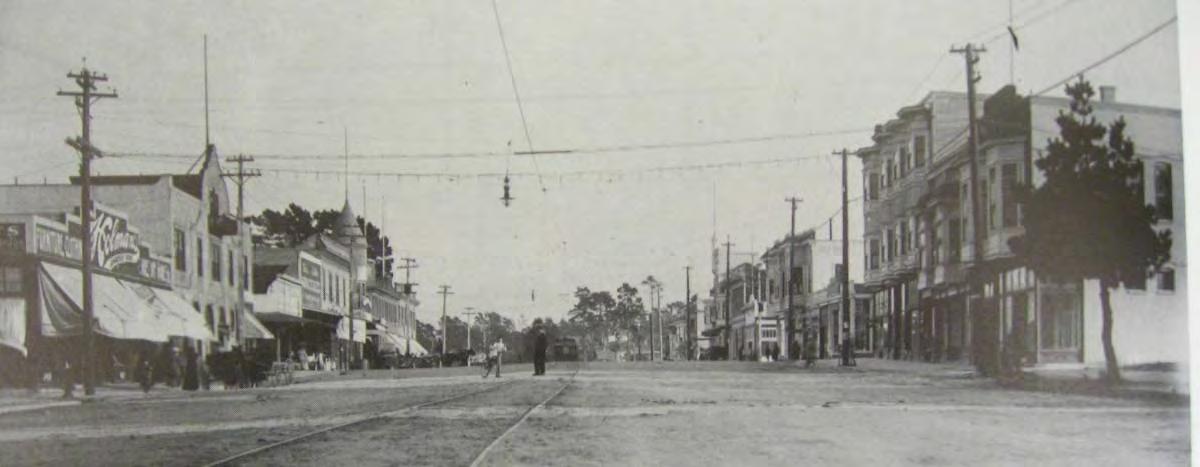 Lighthouse Avenue, 1912 (Erle C. Hanson, Monterey & Pacific Grove Street Car Era)
Lighthouse Avenue, 1912 (Erle C. Hanson, Monterey & Pacific Grove Street Car Era)
Historic Context Statement – Final City of Pacific Grove Historic Context (1903 – 1926) Pacific Grove, California 31 October 2011 Page & Turnbull, Inc. 123
By 1905, Smith had constructed a spectator’s gallery around the Plunge, and the following year had workers engaged in building the Casino Restaurant as an annex to the south side of the bathhouse.
A photo studio was also constructed. By 1907, the initial section of a pier had been constructed on the west side of the cove using granite blasted from the cliff face and covering it with cement. That same year the Beach Auditorium opened, featuring a stage theater and space for public dances. The Women’s Civic Club also opened up a “Vista Station” overlooking Second Beach.264 The Vista Station was designed by Emily E. Williams, who also designed several cottages along Chestnut Street.265
These developments were followed in 1909 by the construction of a bandstand at the beach, a box ball alley just north of the bathhouse, and an extension of the cement pier. This extension was made by erecting two twenty-foot concrete columns and then toppling them into the cove. The spaces between the columns were then filled, and continue to serve as a foundation for part of the concrete pier that remains today.266 In 1909, the Women’s Civic Club also convinced the PIC to install irrigation pipes in order to create a dahlia garden behind the Vista Station.267 In 1910, William F. Smith sold his interest in the property, but improvements continued, including the addition of a merry-go-round. By 1912, the Beach Auditorium was also being used to show silent motion pictures, and could seat up to 400 people.268 This dizzying array of entertainment choices meant that Lovers Point was now the most popular destination in Pacific Grove, although many of these attractions were torn down or removed within a few decades.
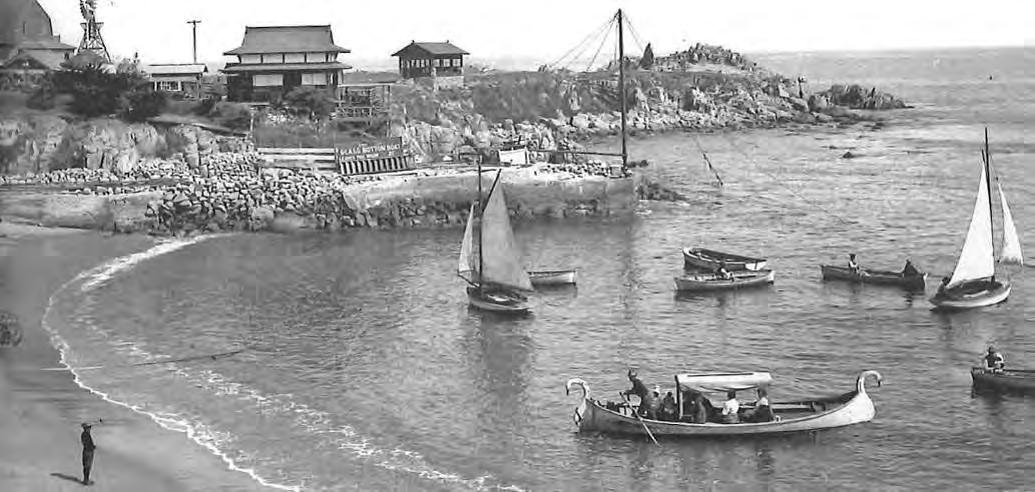 Lovers Point, circa 1907. (C.K. Tuttle Collection, Pacific Grove Museum of Natural History, reproduced in Images of America: Pacific Grove, p. 91)
Lovers Point, circa 1907. (C.K. Tuttle Collection, Pacific Grove Museum of Natural History, reproduced in Images of America: Pacific Grove, p. 91)
Historic Context Statement – Final City of Pacific Grove Historic Context (1903 – 1926) Pacific Grove, California 31 October 2011 Page & Turnbull, Inc. 124
Early postcard of Lovers Point, circa 1910 (California State Library)
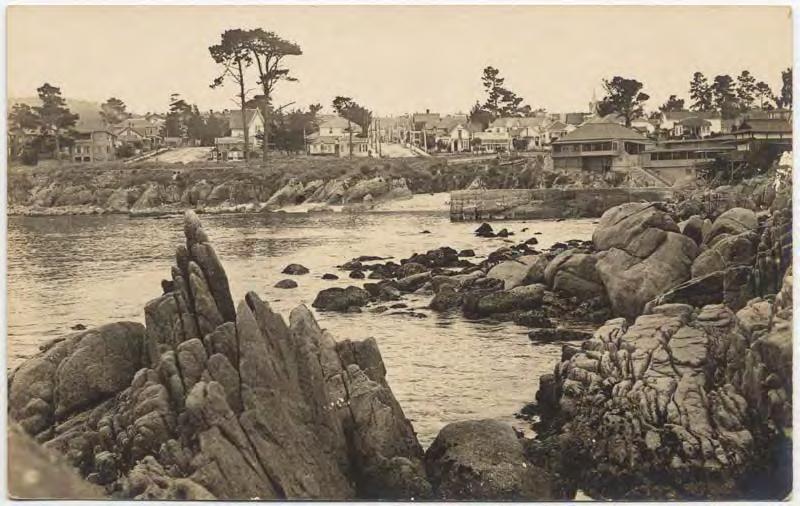
Perhaps the most unique building at Lovers Point was the Japanese Tea House, which had been financed by Japanese immigrant, Otosaburo Noda. The arrival of the Japanese in the Monterey Bay area was driven both by the Scott Act of 1888—which prevented further Chinese immigration to the United States—as well as Japanese governmental policies that encouraged immigration. As Japanese
 Circa 1910 photo of the beach area. From left to right: the Bath House, Beach Auditorium, photo studio, Smith residence, Japanese Tea House and Vista Building. (Monterey Public Library, California History Room clipping files)
Circa 1910 photo of the beach area. From left to right: the Bath House, Beach Auditorium, photo studio, Smith residence, Japanese Tea House and Vista Building. (Monterey Public Library, California History Room clipping files)
Historic Context Statement – Final City of Pacific Grove Historic Context (1903 – 1926) Pacific Grove, California 31 October 2011 Page & Turnbull, Inc. 125
City of Pacific Grove Historic Context (1903 – 1926) Pacific Grove, California
immigrants filtered into the Monterey Bay area, many took over roles that had previously been filled by the Chinese. They worked as agricultural laborers, railroad tie cutters, stove wood cutters, fishermen and abalone divers.269 Most appear to have lived in Monterey, and in the ensuing decades a small Japanese neighborhood would evolve near Lake Estero. The 1900 U.S. Census lists only one Japanese resident of Pacific Grove.
Otosaburo Noda was emblematic of the industriousness of the Japanese immigrants. He had arrived in the area in the 1890s and initially worked clearing forest land. By 1901, he had helped establish a Japanese fishing colony in the Cannery Row area, mainly to fish for salmon. Noda also noticed the prolific red abalone beds around Monterey and Pacific Grove, and subsequently worked with Gennosuke Kodani to help open a fishery. Unlike the Chinese, who collected the abalone from inshore areas, the Japanese pioneered the commercial harvest of abalone using diving equipment, particularly in the areas around Whaler’s Cove at Point Lobos.270
In 1904, Noda hired Kohachi Handa, a Japanese carpenter, to construct the Tea House—reputed to have been built without using a single nail. Its construction was most likely inspired by the success of the Japanese Tea Garden in San Francisco, which had been built for the 1894 Midwinter Fair in Golden Gate Park. As with its predecessor, the Tea House in Pacific Grove proved to be a major tourist attraction, featuring a fish pond and garden, and offering tea and rice cakes for sale.271 The facility operated until 1924 when it was destroyed by fire and not rebuilt.272
 Postcard of Japanese Tea House, 1912 (Courtesy Charles Huff)
Postcard of Japanese Tea House, 1912 (Courtesy Charles Huff)
Historic Context Statement – Final
31 October 2011 Page & Turnbull, Inc. 126
THE DESTRUCTION OF THE CHINESE FISHING VILLAGE
The turn of the century coincided with increasing demands from the residents of Pacific Grove and Monterey to remove the Chinese fishing village. There were a variety of reasons for this, some driven by ethnic prejudice and others that were purely economic. In 1900, the Chinese fishing village was the area’s only major industry with the exception of tourism and sporadic sand and coal mining efforts.273 However, the development of fish-canning facilities in Monterey would soon exert pressure on the Chinese fishermen, who continued to dry their catch prior to shipment—a method viewed as both obsolete and offensive. In particular, the smell of their squid drying operations led to constant complaints by citizens of Pacific Grove and Monterey, whose cities were steadily encroaching on the village. The fact that the village was also located on what was now a prime tract of coastal land ripe for development also did not go unnoticed. Indeed, the village stood on the only tract of oceanfront land at the eastern end of Pacific Grove that had yet to be subdivided.

In 1902 Mayor Johnson of Monterey presented a formal complaint to Bedson Eardley, then superintendant of Pacific Grove, about the smell of the squid drying operations. At the same time, the editor of the Monterey New Era mentioned that moving the Chinese out would make building sites at the city’s eastern end “immensely more valuable.”274 The PIC was initially reluctant to act. The company had promoted the village as an integral scenic spot along the 17 Mile Drive, and its presence was considered a vital part of the tourist economy.275 Public pressure increased, however, which led the PIC to offer to relocate the village to Pescadero Point on the 17 Mile Drive near what is today Pebble Beach. While this appears to indicate that the PIC was not wholly unsympathetic to the plight of its Chinese tenants, there are other indications that they were also intensely interested in the land.
In 1905 the PIC gave notice to the Chinese that their leases would not be renewed and the company stopped collecting rents. An order was also given that all of the villager’s buildings and fish-drying
 Early view of Japanese Tea House, n.d. (California Historical Society/USC Digital Archive, #CHS-42321)
Early view of Japanese Tea House, n.d. (California Historical Society/USC Digital Archive, #CHS-42319)
Early view of Japanese Tea House, n.d. (California Historical Society/USC Digital Archive, #CHS-42321)
Early view of Japanese Tea House, n.d. (California Historical Society/USC Digital Archive, #CHS-42319)
Historic Context Statement – Final City of Pacific Grove Historic Context (1903 – 1926) Pacific Grove, California 31 October 2011 Page & Turnbull, Inc. 127
racks were to be removed no later than February 1906.276 At the same time, an editorial piece appeared in a local paper under the heading “Chinatown Will Cease to Exist.” It stated that:
The announcement that the Pacific Improvement Co. has notified the Chinese to vacate the territory now known as Chinatown is one of the best pieces of news we have heard for a long time. It not only means that an eyesore will be removed from one of the most beautiful and picturesque spots on the bay shore, but that a highly desirable residence tract will be opened up. For it is the intention of the P.I. Col, as quickly as the Chinese can get away, which will be in about two or three months, to place the tract on the market. There are about thirty acres in the piece, extending from Lighthouse Avenue to the water front. The Chinese will move to Pescadero, on the 17-Mile Drive. Another excellent thing about this action is the P.I. Co., is that it will clear the way for the extension of the Ocean Boulevard, proposed to be constructed through New Monterey, to connect with Ocean View Avenue in Pacific Grove.277
Ironically, at the same time anti-Chinese sentiment was reaching a crescendo, residents of Pacific Grove held their first Feast of Lanterns celebration in 1905. This was patterned after celebrations held at the end of the summer encampments at Lake Chautauqua, New York, which featured choruses singing on lantern-lighted boats and a fireworks display. It was suggested that Pacific Grove hold its own festival patterned on an Chinese legend about a man searching for his daughter at the water’s edge. The first Feast of Lanterns was held at dusk on July 22, 1905, with numerous lanterns lighting the walk to the Lovers Point where the Fifteenth U.S. Infantry band gave a concert.278
Celebrations aside, the situation at Point Alones grew increasingly tense as the Chinese proved reluctant to leave and continued to stall for additional time.279 At the beginning of May 1906, the PIC stepped up its efforts to remove the Chinese—perhaps because of concerns that Chinese refugees from San Francisco’s Chinatown—which had been destroyed following the Great Earthquake and Fire of 1906—would increase the size of the village. J. P. Pryor, General Agent of the PIC in Pacific Grove, wrote his superiors that the Chinese “have no intention of moving,” and that “Something must be done to show the Chinese we mean business.”280
Eight days later, on the evening of May 16, 1906, fire broke out at the west end of the village. Bucket brigades were formed, and fire breaks were created by tearing down buildings in the fire’s path. Nevertheless, strong winds forced the Chinese to give up and the villagers rushed to drag whatever personal belongings they could to safety. By 10:00 p.m., only 16 out of over 100 buildings were left standing.281 During the fire, hundreds of white spectators had lined the railroad tracks and cheered the flames. Piles of belongings that the desperate Chinese had carried away to try and save were looted, as were the stores and dwellings that were not burned.282 One observer noted that, “Had it not been for a few of the officers present the Chinese would have lost everything they
Historic Context Statement – Final City of Pacific Grove Historic Context (1903 – 1926) Pacific Grove, California 31 October 2011 Page & Turnbull, Inc. 128
possessed.” Newspaper editorials lamented the looting behavior and questioned “the morality of such actions in a community dedicated to Christian principles.”283
There is no clear evidence that agents of the PIC set the fire—nor was this the first conflagration at the village. The village had experienced three fires in the previous decade, including a fire in 1899 that burned three quarters of the village to the ground. The difference this time was that the PIC management refused any attempts at rebuilding—sending a telegram to J. P. Pryor the day after the fire that he should “do anything necessary to prevent rebuilding.” The next day the PIC built a fence around the site and posted guards at the entrance.284 Nevertheless, the Chinese attempted to rebuild on the south side of the railroad tracks near the Joss house, but these buildings were quickly torn down by PIC guards.285 A few Pacific Grove residents did offer the refugees shelter, but also made it clear they wanted the Chinese out of the area. This is perhaps best evidenced by the fact that a fire relief fund reached a grand total of $29.286
The Chinese continued to resist removal, including the fisherman Quock Tuck Lee, who was arrested several times and named in lawsuits by the PIC.287 The situation remained tense until the summer of 1906, when Monterey property owner J. B. McAbee offered the Chinese twenty-year leases on his beach located a quarter mile east of Point Alones at what is today Cannery Row. The last to leave the Pacific Grove village was Quock Tuck Lee, who moved to McAbee Beach in May 1907.288 Many Chinese would subsequently work for the Monterey Fishing and Canning Company, which reduced fish heads and offal to fertilizer. They also continued to dry squid, but on the highway to Salinas outside of city jurisdiction.289 For its part, the PIC offered to build water mains and hydrants for the new village, and assisted in moving the surviving buildings. J. P. Pryor wrote
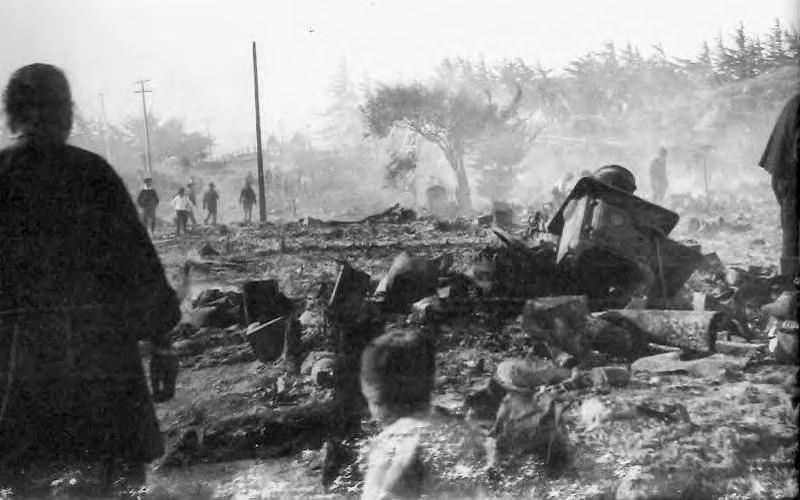 Aftermath of the fire at the Chinese fishing village, May 17, 1906. (J.K. Oliver; Monterey Public Library, California History Room, reproduced in Images of America: Pacific Grove, p. 20)
Aftermath of the fire at the Chinese fishing village, May 17, 1906. (J.K. Oliver; Monterey Public Library, California History Room, reproduced in Images of America: Pacific Grove, p. 20)
Historic Context Statement – Final City of Pacific Grove Historic Context (1903 – 1926) Pacific Grove, California 31 October 2011 Page & Turnbull, Inc. 129
that “I am inclined to rejoice, that we have escaped an incubus on our premises, and the transfer means a heavy increase in the value of the P.I. Co.”290
NEW ADDITIONS TO THE CITY
University Park
In the aftermath of the fire, the PIC appeared keen to avoid the perception that it had profited from the disaster. Thus, the PIC abandoned its plans to subdivide the village area into home sites and instead announced that it had donated the land to the University of California for a park and laboratory purposes. The company’s new plans also called for the construction of a subdivision called University Park, where faculty at the lab could purchase homes.291

The subdivision was recorded in 1909 and encompassed all the land north of Lighthouse Avenue between 1st Street and the Monterey border. In 1917, Hopkins Marine Laboratory relocated from
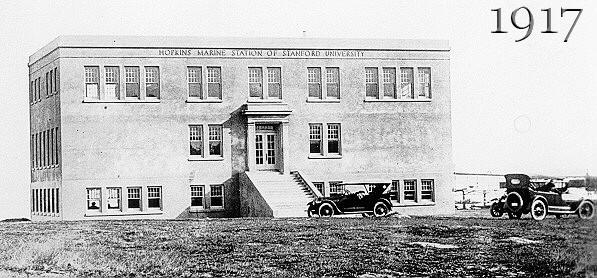 PIC Brochure, showing new neighborhoods, circa 1915 (Monterey Public Library, California History Room files)
Agassiz Building at Hopkins Marine Laboratory, 1917 (Wikipedia, http://en.wikipedia.org/wiki/Hopkins_Marine_Station)
PIC Brochure, showing new neighborhoods, circa 1915 (Monterey Public Library, California History Room files)
Agassiz Building at Hopkins Marine Laboratory, 1917 (Wikipedia, http://en.wikipedia.org/wiki/Hopkins_Marine_Station)
Historic Context Statement – Final City of Pacific Grove Historic Context (1903 – 1926) Pacific Grove, California 31 October 2011 Page & Turnbull, Inc. 130
Historic Context Statement – Final City of Pacific Grove Historic Context (1903 – 1926) Pacific Grove, California
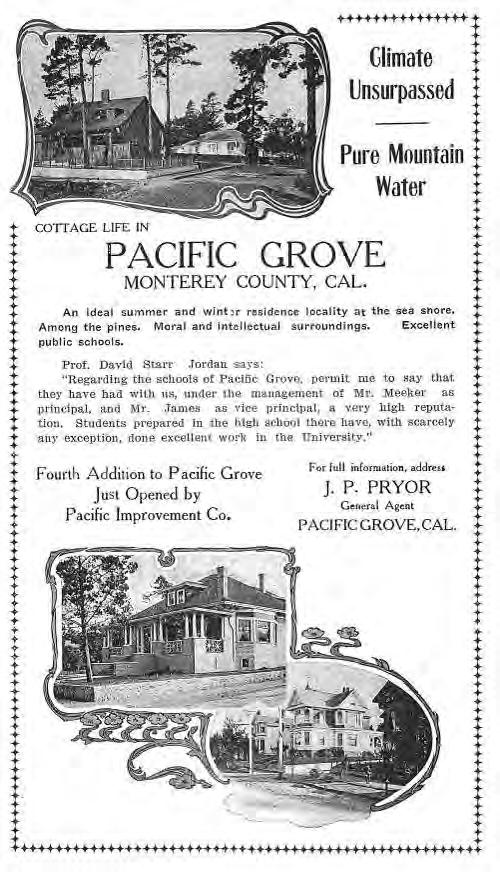
Lovers Point to the area, inaugurated by the construction of the Agassiz Laboratory, a three-story concrete building named in honor of one of the nation’s leading oceanographers. It would be followed in 1928 by the two-story concrete Loeb Laboratory, named for an experimental biologist who had worked in Pacific Grove from 1902 until 1910.292
Fourth and Fifth Additions
University Park was not the PIC’s first new subdivision of the 1900s. In 1905, the company had subdivided the Fourth Addition at the eastern end of the city, comprised of a wedge-shaped area bounded by Junipero Avenue on the south, Lighthouse Avenue on the north, and the Monterey border on the east. The western boundary was comprised of 6th Street between Junipero and Pine avenues, and 1st Street between Pine and Lighthouse avenues.
Advertisement for housing in the Fourth Addition, 1905-1906 (Pacific Grove City Directory)
31 October 2011 Page & Turnbull, Inc. 131
City of Pacific Grove Historic Context (1903 – 1926) Pacific Grove, California
The much-larger Fifth Addition was added in 1907, comprised of all the land between Junipero Avenue on the north, Sinex Avenue on the south, Alder Street on the west, and the Monterey border on the east. Together, these were the last major additions to the city that followed the traditional grid pattern set by the 1875 St. John Cox survey of the Retreat. Going forward, nearly all of Pacific Grove’s new subdivisions would feature curving streets that rejected the traditional street grid in favor of a more bucolic aesthetic.
The Hillcrest Tract
In 1911, the new “Hillcrest Tract” Subdivision was laid out, which included the area bounded by Sinex Avenue on the north, Forest Avenue on the east, an alley just north of Beaumont Avenue on the south, and the Monterey border on the east—but not including the David Avenue Reservoir. A brochure issued by the PIC around this time highlighted the new subdivision for its proximity to the school, stating that the tract “occupies the crest of the hill overlooking the town and the Bay of Monterey, commanding a magnificent view. The lots are covered with pine and oak trees, and prices are very reasonable. These lots are particularly desirable for families having children, as they adjoin the new High School Building and are only two and three blocks from the Primary and Grammar schools.”293
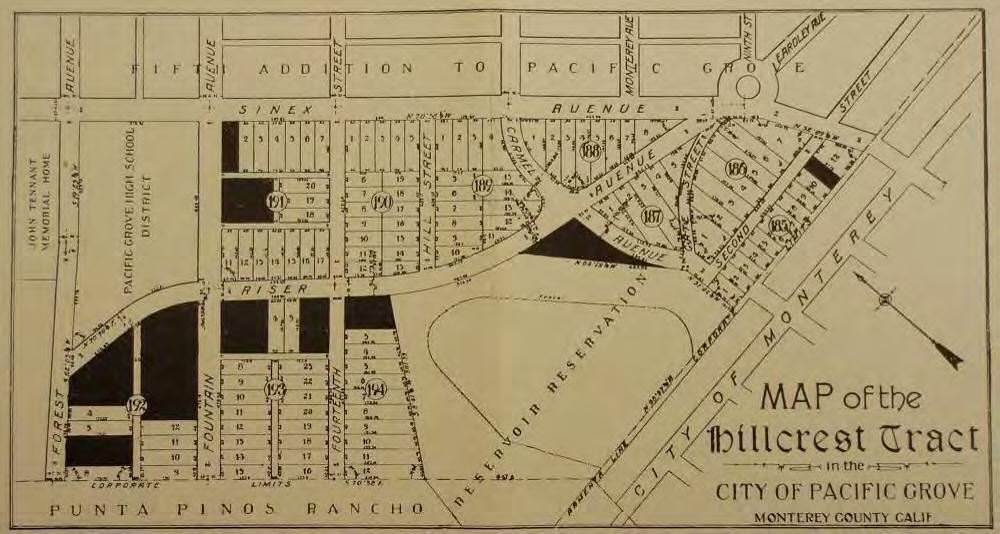 Map of Hillcrest Tract, in PIC Brochure, circa 1915 (Monterey Public Library, California History Room)
Map of Hillcrest Tract, in PIC Brochure, circa 1915 (Monterey Public Library, California History Room)
Historic Context Statement – Final
31 October 2011 Page & Turnbull, Inc. 132
The Beach Tract
Emblematic of this new pattern was the Pacific Grove Beach Addition, also known as the “Beach Tract,” recorded in 1916. Stretching from the confluence of Seapalm and Mermaid avenues on the east, to Asilomar Avenue on the west, the area featured a prime tract of coastal property divided into curving streets fanning out from a central park called the Esplanade. This design was clearly influenced by the “City Beautiful” movement, an important national urban planning trend in the early twentieth century. A promotional map produced by the PIC for the development shows that directly north of the Esplanade was a fan-shaped arrangement of streets called the “Civic Center,” which would be served by a proposed extension of the streetcar line along Del Monte Avenue. In keeping with the beach theme, streets were given nautical names such as Spray, Surf, Shell and Ripple.
The original layout of Pacific Grove Beach (1916) can be seen in this 1927 map. (Courtesy the Heritage Society of Pacific Grove)
In May 1916 the Monterey American described the property in glowing terms, stating:
Upwards of three hundred acres of beach property, lying within the city limits of Pacific Grove, overlooking Monterey Bay and the surrounding county, will be offered to the buying public within thirty days. This is the result of a recent action by the officials of the Pacific Improvement Company, owners of the tract, who apparently look for a revival in California seaside resorts. An elaborate scheme of
Historic Context Statement – Final City of Pacific Grove Historic Context (1903 – 1926) Pacific Grove, California 31 October 2011 Page & Turnbull, Inc. 133
subdivision is being perfected by Mark Daniels, who has had a corps of engineers on the property for sixty days. The streets are being cut to conform with the contour of the land. The main streets converge to a civic center which is intersected by the 17 Mile Drive. An esplanade, two hundred feet wide runs from the civic center to the ocean front … Daniels is incorporating a number of new ideas, including a tent city to be perfected along the lines of the tent homes, which have won favor in many places. 294
The mention of a tent city was a direct reference to the eastern extension of the Beach Addition, sometimes referred to as the Mermaid Alley subdivision. Bounded by Mermaid Avenue on the north, Ocean View Boulevard on the South, Lorelei Street on the east and Seapalm on the west, the area was labeled both as “Tent City” and “Bungalow City” on the PIC’s promotional map, and was distinguished from the larger Beach Tract by its noticeably smaller lots. According to the map, lots would be available at “$50 or more, according to location.”
The larger lots in the Beach Addition were promoted as having a staggered lot plan, which would give each lot double frontage to surrounding streets while preserving ocean views. Drawings of proposed “typical beach bungalows” were also shown, most of which show Craftsman style influence in their design.
The staggered subdivision plan of the Beach Addition is apparent today in several areas, such as the blocks bounded by Beach, Balboa, Esplanade and Ocean View Boulevard. However, the subdivision was extremely slow to develop, and very few homes were constructed in the area prior to 1930. In
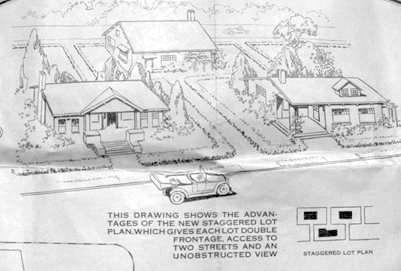 A PIC promotional map included this sketch of typical bungalows in the Beach Tract, 1919 (Courtesy the Heritage Society of Pacific Grove)
A PIC promotional map included this sketch of typical bungalows in the Beach Tract, 1919 (Courtesy the Heritage Society of Pacific Grove)
Historic Context Statement – Final City of Pacific Grove Historic Context (1903 – 1926) Pacific Grove, California 31 October 2011 Page & Turnbull, Inc. 134
fact, it was not until the 1950s that most of the area was built out. Conversely, the proximity of the Mermaid Avenue “Bungalow City” area to Lovers Point and downtown led to much more rapid development. By 1926, Sanborn maps indicate that approximately 40 percent of the Mermaid Avenue lots had been built out, primarily with small dwellings. This included an interesting row of three mirrored frame dwellings at 701 – 705 Mermaid Avenue, all of which feature detached garages and small gabled penthouses on the second story. By this time a set of two-story buildings known as the Wave Apartments had also been constructed nearby on oceanfront lots west of Lorelei Street where the old Hopkins Marine Station had stood. These were developed by James Z. Deas, setting the stage for denser development in this area.295
CIVIC IMPROVEMENTS
Pacific Grove’s population grew steadily, during the first three decades of the twentieth century. In 1910, the Del Monte Weekly stated that during the preceding years that had “been a steady, substantial growth but never a boom.” The two greatest improvements named were the city sewer system and about 20 miles of graded streets.296 By 1917, the population had grown to about 2,500 residents, and would climb to 4,750 by 1928.297 With this growth came an increasing need for improved civic facilities, which also tied in with Progressive Era calls for social and civic reforms. These included women’s suffrage and the temperance movement, but also included improvements in education and public health. As host to one of the West Coast’s most important meeting grounds for the

 Postcard of Ocean View Boulevard, showing very sparse development, 1919 (Courtesy Charles Huff)
Postcard of Ocean View Boulevard, showing very sparse development, 1919 (Courtesy Charles Huff)
Historic Context Statement – Final City of Pacific Grove Historic Context (1903 – 1926) Pacific Grove, California 31 October 2011 Page & Turnbull, Inc. 135
Historic Context Statement – Final
City of Pacific Grove Historic Context (1903 – 1926) Pacific Grove, California
Chautauqua—which was closely identified with the Progressive Era—the citizens of Pacific Grove embraced these ideals, which bore fruit through a number of key civic improvements, such as the library, city hall, museum, and several schools. Additionally, not far away from the new Hillcrest Tract subdivision, a valve house was constructed in the roundabout where 9th Street meets Eardley Avenue. As with many public buildings of the period, it also featured Spanish influenced architecture. Properties from this period capable of representing this theme of early twentieth century civic improvements therefore include buildings such as the library, museum, high school, city hall, and infrastructure upgrades.
Pacific Grove Library
One of the earliest civic-spirited developments was the construction of a new library using a grant from the Carnegie Foundation. The land was donated by the PIC and located on the northeast portion of the grounds of the El Carmelo Hotel. Completed in 1907, the Pacific Grove Library was designed in the Mission Revival style, featuring a series of arches at the entry and a red clay tile roof. The McDougall Brothers designed the building, and construction was carried out by Henry Chivers and the Granite Rock Company.298
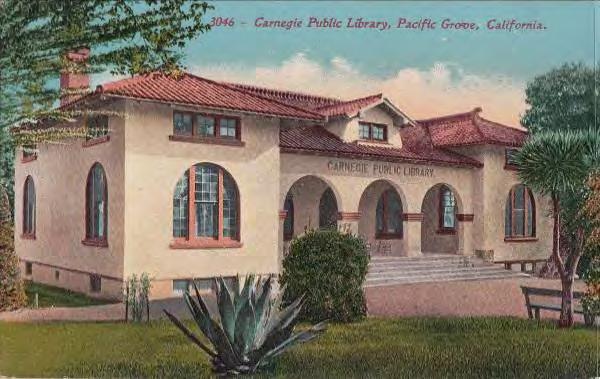
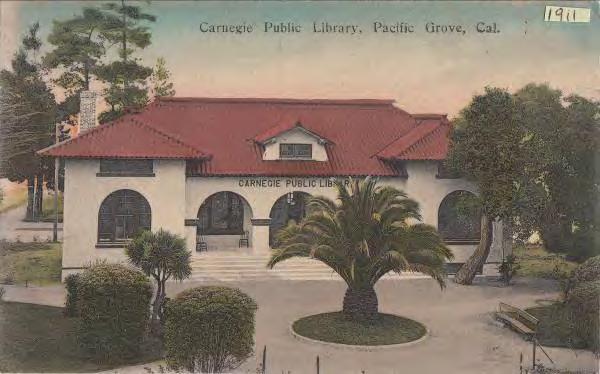 Valve house in roundabout, 9th Street and Eardley Avenue (Page & Turnbull, 2011)
Early postcards of Carnegie Public Library (Courtesy Charles Huff)
Valve house in roundabout, 9th Street and Eardley Avenue (Page & Turnbull, 2011)
Early postcards of Carnegie Public Library (Courtesy Charles Huff)
31 October 2011 Page & Turnbull, Inc. 136
Historic Context Statement – Final City of Pacific Grove Historic Context (1903 – 1926) Pacific Grove, California
In the coming decades, several additions would be made to the south side of the library, although many parts of the original interior remain intact at the rear of the present building. The original entry arches were also incorporated within the interior, and the additions likewise sought to preserve the overall Spanish-influenced architecture of the original design.
Lighthouse Avenue
Although Lighthouse Avenue (originally known as Lighthouse Road) had been developed in 1850s, Central Avenue was the more typical route into the heart of Pacific Grove. This was because the eastern section of Lighthouse Avenue, particularly from 10th Street to the Monterey border, crossed a steep slope. The area near 13th Street and Lighthouse Avenue was also likely boggy at times, as this area was near the head of drainage for the creek in Greenwood Park. Thus it was not until 1906 that the area east of 13th Street was finally graded and graveled. An article appearing in the Daily Review in August 1906 mention that:
Light House avenue, between the city limits on the east and Thirteenth street on the west, has just been graded and graveled by contractor J. C. Anthony and thrown open to the public for travel. Owing to the lay of the land it was necessary to make two roadways, one of which is many feet higher than the other at some points, and between the two roadways a space has been left for lawn. This portion will be at once sown to blue grass and flowers will also be planted.299
This arrangement with a median strip is still present today, although it initially met with resistance because of a lack of pedestrian crossings. A subsequent article in a September issue of the Daily Review states that:
There has been considerable complaint among the residents of the section of the city above the newly graded portion of Light House Avenue that they have to go a long distance around in order to reach the beach or call upon friends living north of the thoroughfare. Crossings are needed, but the manner of their construction and the material of which they should be composed is the problem which now confronts the city trustees.300
This problem was never resolved, as the 1914 Sanborn maps show that then, as now, the only extant crossings were those at 9th and 10th streets. These crossings were either completed between 1906 and 1914, or were original to the 1906 efforts owing to the flatter topography in that area.
Pacific Grove High School
With this growth came the need for expanded educational facilities, and in 1911 the new Pacific Grove High School was constructed on a large lot near the southeast corner of Forest and Sinex avenues. The school was designed by architect William Weeks. It was a wood-frame building featuring Classical Revival style details, including a prominent cornice and a raised basement with scored stucco designed to imitate more formal masonry. The central portion of the school was two
31 October 2011 Page & Turnbull, Inc. 137
City of Pacific Grove Historic Context (1903 – 1926) Pacific Grove, California
stories in height, flanked by one-story wings, and the entire upper portion of the building was clad with a brick veneer. As with the Pacific Grove Library, the school complex would be augmented in the ensuing decades with the addition of a new gymnasium, as well as a large auditorium in 1931 that was also designed by William Weeks. In 1946, the main school building was destroyed by fire, and architect Robert Stanton was put in charge of designing its replacement, which largely followed the footprint of the original building.301
Pacific Grove City Hall
At the same time that he was designing the Pacific Grove High School, William H. Weeks was also at work on designs for a new city hall in Pacific Grove. This would be the town’s first dedicated administrative building, and it was completed in 1912—a full 23 years after the city’s incorporation. Located on the southwest corner of Forest and Laurel avenues, the building was constructed by the Chivers Brothers at a cost of $6,000.302 Harry and Richard Chivers were major builders in Pacific Grove during the early twentieth century, and maintained an office on the corner of Rickett’s Row and 13th Street in 1907 (likely 149 13th Street).303
Architecturally, the new Pacific Grove City Hall featured an eclectic blend of design influences, including an entry with Classical columns, a bracketed cornice, and Craftsman-style windows topped by keystones. The most notable feature, however, was a three-story tower exhibiting Spanish Colonial Revival design elements, such as quatrefoil windows and a belfry with metal balconettes. The fire department also shared the building, and the tower was used to hang fire hoses to dry. The police department was likewise located within the building, which included a small jail cell.304 The building has undergone a number of alterations over the years; most recently, City Hall was renovated by San Francisco architecture firm Deems Lewis McKinley (DLM) in 2001. The building
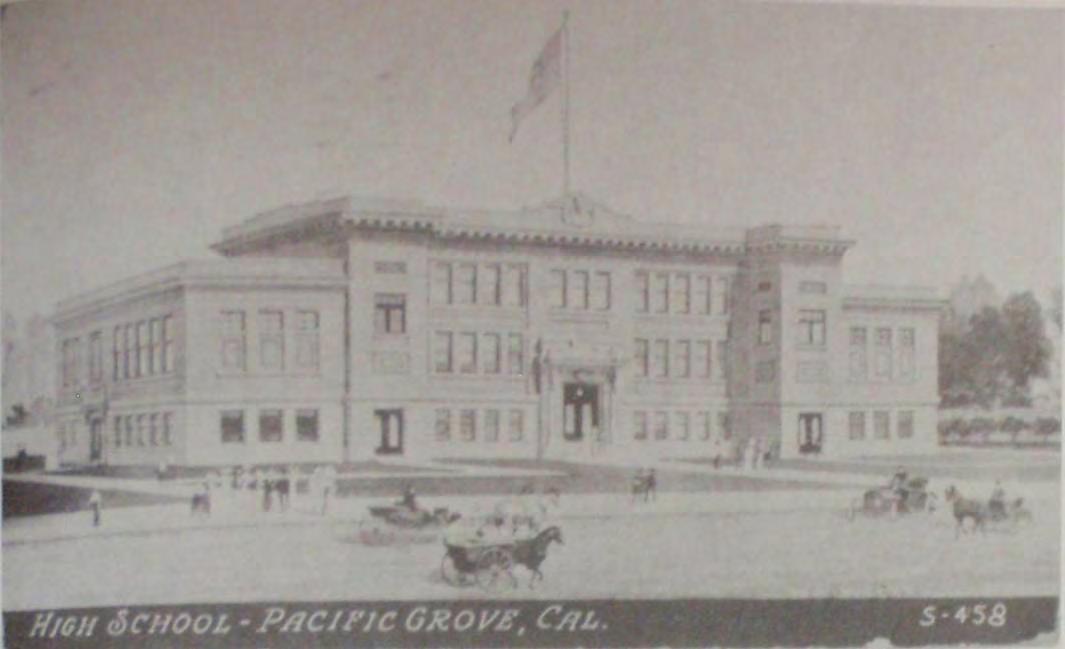 Postcard of Pacific Grove High School, 1906 (reproduced in Monterey Bay Yesterday, p. 3)
Postcard of Pacific Grove High School, 1906 (reproduced in Monterey Bay Yesterday, p. 3)
Historic Context Statement – Final
31 October 2011 Page & Turnbull, Inc. 138
Historic Context Statement – Final City of Pacific Grove Historic Context (1903 – 1926) Pacific Grove, California

received various interior and exterior changes, including construction of a substantial addition, alterations to the tower, and landscape improvements in the surrounding plaza.305
William H. Weeks
William H. Weeks (1862 – 1936) was one of California’s most prolific architects of the late nineteenth and early twentieth centuries, and is associated with a number of Pacific Grove’s most prominent buildings. Born in Canada to a building designer, his family later emigrated to the United States and by 1894 Weeks had opened an office Watsonville, California where he would live for the next eighteen years. In addition to designing numerous buildings in Watsonville, Weeks would eventually open branch offices in Salinas (1897), San Francisco (1905), Oakland (1924) and San Jose (1926). In total, Weeks would design hundreds of buildings located throughout California, including theaters, stores, courthouses, hospitals, industrial plants, hotels and churches. But he is perhaps best associated with schools and libraries, including the design of 22 Carnegie libraries constructed in California between 1902 and 1921.306 His designs tended to favor Neoclassical style details, although he would later embrace the transition to Spanish and Mediterranean-style designs.
City Hall, 1912 (Steve Travaille, reproduced in Images of America: Pacific Grove, p. 94)
31 October 2011 Page & Turnbull, Inc. 139
Historic Context Statement – Final City of Pacific Grove Historic Context (1903 – 1926) Pacific Grove, California
In addition to Pacific Grove High School and City Hall—as well as the Bank of Pacific Grove and the Thomas A. Work block previously discussed—Weeks’ work in Pacific Grove included the Post Office on Forest Avenue (1901), and Thomas Work’s residence at 176 Central Avenue (1909).307 The Osborne House (now known as the Beacon House) at 468 Pine Street (1902) has also been attributed to Weeks, although local historian Kent Seavey states that it is actually Plan #6 designed by architects Wolfe & McKenzie of San Jose.308
Point Pinos Lighthouse
Damage caused by the Great Earthquake of April 1906 was not nearly as severe in Pacific Grove as it was in cities farther to the north. On the whole, damage in Pacific Grove was described as “trifling,” and mainly consisted of fallen chimneys.309 Perhaps the building most affected was the Point Pinos Lighthouse, where the one-foot-thick masonry walls were badly cracked and the prisms jarred in the lens. The Lighthouse Board reported that the damage was so severe that the tower had to be rebuilt with reinforced concrete, which was accomplished in 1907. A new two-inch water pipe was also installed and connected with a 4,000 gallon redwood tank.310 In 1915, the lighthouse was finally electrified, increasing the strength of its beam. An article from the 1930s described the light as a “29,000-candlepower alternating beam, visible in clear weather from a distance of 15 miles, across four-fifths of the horizon. Its light, 189 feet above high tide, is intensified by powerful catadiptric lenses. The diaphragm of its foghorn is operated by compressed air.”311 Around the same time that electricity was installed, the long-time lighthouse keeper, Emily Fish, retired from service. She subsequently purchased a home at 691 Sinex Avenue in Pacific Grove.312
Pacific Grove Museum of Natural History
Pacific Grove’s Chautauqua Museum had formed in the 1880s around a collection of natural specimens—many of which were used during Chautauqua lectures held in the Grove. Sanborn maps indicate that by 1892 the Museum collections were housed in an octagonal shaped building on the grounds of the El Carmelo Hotel that had formerly been used as a “smoking room” That building was moved to the present site of the Pacific Grove Museum by 1897, and sometime before 1905 the building was augmented by connecting it at the rear to one of the old Retreat cottages that had stood on the west side of Grand Avenue. Around the same time, the old museum organization dissolved in 1900, and the Pacific Grove Museum Association incorporated with officers that included Mary Norton, Bedson A. Eardley and Dr. Oliver Trimmer.313 In 1902, the PIC donated the half-block lot on which the present museum stands, and in 1916 management of the museum was transferred to the City of Pacific Grove through a charter election.314
31 October 2011 Page & Turnbull, Inc. 140
Women’s Civic Club
The Women’s Civic Club of Pacific Grove was founded in 1903 by Julia Platt, Mrs. M. A. Chase, and others. It was dedicated to beautifying the city through a variety of projects, which included removing rubbish that had accumulated in city parks and on the town’s vacant lots. They also put up the city’s first street signs, and in 1907 had constructed the Vista Building at Lovers Point.315 For many years, the club also helped maintain a dahlia garden at Lovers Point.
In 1910 the Women’s Civic Club was granted a lease by the Pacific Grove Museum Association to construct a clubhouse on the southeast corner of their lot facing Grand Avenue. This was an Lshaped building constructed by joining two of the old Retreat cottages which were donated by the PIC. The design of the building was completed by Emily Williams, who had also designed the Vista Station for the Women’s Civic Club at Lovers Point. At that time, the President of the organization was Mrs. B. C. Winston, whose husband had constructed the Winston building in 1903.316 Over the years, the Civic Club would continue to be active in Pacific Grove, petitioning for the construction of cement sidewalks, raising funds for new fire-fighting equipment, and promoting the annual Pacific Grove home tours. The clubhouse continued in this location until the 1960s, when it was destroyed by fire.317
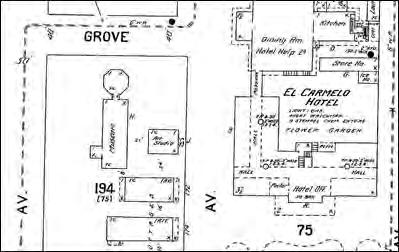
Municipal Park
During the 1910s, the western edge of the city’s improved areas largely ended at Alder Avenue. Around 1913, the city began contemplating converting a portion of the area into a park, and B. L. Hollenbeck led a committee to negotiate with the PIC over purchase of the land. The PIC offered twenty acres of land at $400 an acre if the city would build an incinerator and cease dumping garbage on the company’s beach property. Although there were some objections to the price and the demand for the incinerator, the committee gave its initial approval and recommended that the motion to purchase the park be put to a city vote. It is not certain what year the purchase was completed, but by 1916 a new Municipal Park—now George Washington Park—was added to the city, bounded by Alder, Dennett, and Short Street, with a western border that abutted portions of
1905 Sanborn Fire Insurance Map, showing the Pacific Grove Museum
Historic Context Statement – Final City of Pacific Grove Historic Context (1903 – 1926) Pacific Grove, California 31 October 2011 Page & Turnbull, Inc. 141
Historic Context Statement – Final
City of Pacific Grove Historic Context (1903 – 1926) Pacific Grove, California
Melrose and the 17 Mile Drive.318 Initially, the park appears to have been largely unimproved, although various facilities would be added in the ensuing decades.
Pine Street Grammar School
By the end of World War I, Pacific Grove’s school enrollment had grown to 1,000 students. To meet the demand for new classroom space, the old Pine Street School was replaced by the 16-room Pine Street Grammar School in 1921. The building was designed by architect Arthur W. Angel in the Spanish Colonial Revival style, and constructed by local contractor Theodore C. Dean using reinforced concrete. Sanborn maps indicate that several streets were closed in order to create the large block on which the school stands. From 1914 to 1945 Robert H. Down served as principal of the Pine Street School, and after his death in 1952 the school was renamed in his honor.319
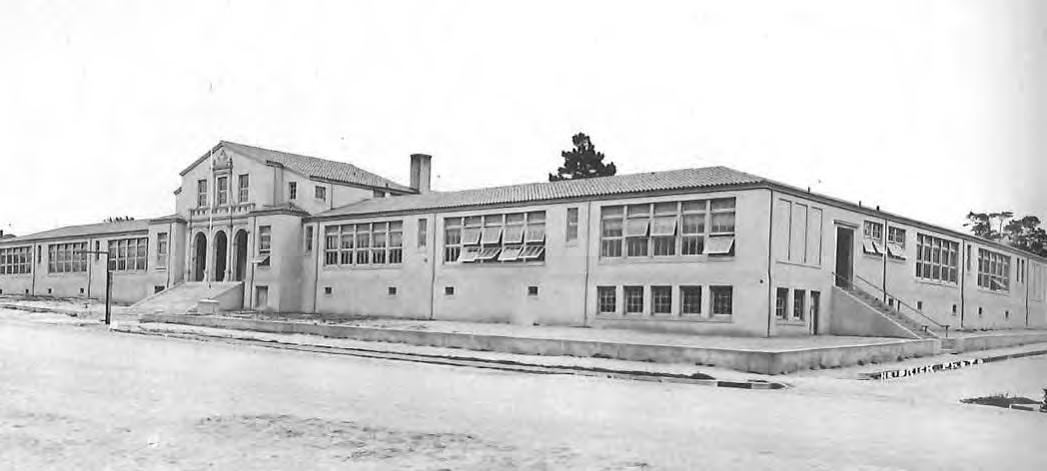
Medical Facilities
A variety of medical facilities were constructed in Pacific Grove during this period, including the Pine Grove Sanitarium at 254 Grove Acres (extant). Built as a private home in 1915, the building was converted by Dr. Amon T. Noe and nurse Roe Shephard into the Pine Grove Sanitarium. By 1923, Shephard and Dr. William Gratiot were operating the building as a small general hospital and it continued in use until at least 1934 when it was damaged by fire. The building was later converted to apartments.320
In 1926, another hospital and sanitarium was built at 510 Monterey Avenue by Jay and Addie Ellenwood (extant). Initially called the Ellenwood Hospital, it was later renamed the Bayview Hospital, offering surgery, obstetrics and general care, as well as a maternity ward. In 1943 the building was purchased by W. B. LaPorte and converted to apartments. 321
Pine Street Grammar School, 1923. Photo by A.C. Heidrick. (Monterey Public Library, California History Room, reproduced in Images of America: Pacific Grove, p. 112)
31 October 2011 Page & Turnbull, Inc. 142
Around the same time as the Ellenwood Hospital was constructed, noted Pacific Grove resident, Dr. Frank Hart, built 14 cottages on the block bounded by Pine, Locust, Laurel and Cedar. Built in 1924, the cottages were known as Whispering Pines and used to convalesce patients. The cottages were used at least until 1935 when Dr. Hart died. Today the cottages are still standing and used for residences.322
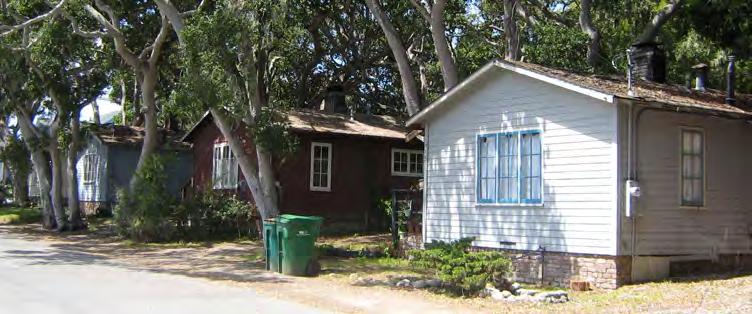
Del Monte Military Academy
The Del Monte Military Academy was founded in 1924 by Major John E. Quinn as a student military academy dedicated to providing students with a well-rounded education tempered by military discipline. The property was initially leased from Holden and Emma Warner (Emma managed the Del Monte Hotel), and situated on a large 4.6 acre parcel located southwest of what is today the intersection of Lighthouse Avenue and Ridge Road. Under Quinn’s direction, the Warner’s large Craftsman style residence at 263 Grove Acre Avenue was remodeled into a dormitory known as Lamb Hall, becoming the centerpiece of a compound surrounded by one-story frame
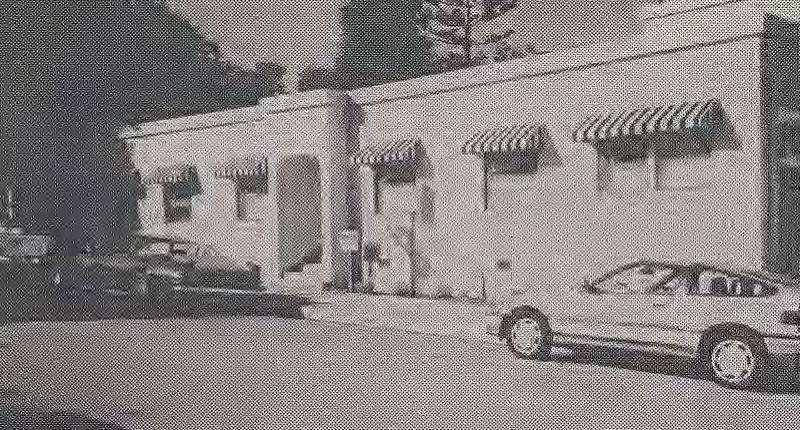 Ellenwood Hospital, constructed 1926 on Monterey Avenue. Photo circa 1980s. (Heritage Society of Pacific Grove, Board & Batten, Feb/Mar 2001)
Dr. Hart’s cottages on Cedar Street, built 1924. (Page & Turnbull, 2011)
Ellenwood Hospital, constructed 1926 on Monterey Avenue. Photo circa 1980s. (Heritage Society of Pacific Grove, Board & Batten, Feb/Mar 2001)
Dr. Hart’s cottages on Cedar Street, built 1924. (Page & Turnbull, 2011)
Historic Context Statement – Final City of Pacific Grove Historic Context (1903 – 1926) Pacific Grove, California 31 October 2011 Page & Turnbull, Inc. 143
Historic Context Statement – Final City of Pacific Grove Historic Context (1903 – 1926) Pacific Grove, California
classrooms, a dining hall and a residence for teachers.323 The latter appears to have been a circa 1914 building constructed by the Warners, which came to be known as Brokaw Hall, most likely named in honor of Capt. J. E. Brokaw, Commandant, and his wife, who served as the Academy’s secretary.324
In June 1924 the Academy counted 36 cadets who appear to have ranged from elementary through high-school aged children. The Academy proved unprofitable, however, and by 1932, the facility— operated as a corporation known as Urban Military Academy—was defunct.325
The Academy would subsequently be used as a camp for the Civilian Conservation Corps (CCC) during the Great Depression, and later converted to apartments by Nicholas Mikel. A newspaper article from the December 11, 1936, issue of The Tide mentions that Nicholas Mikel, the “new owner of the Del Monte Military Academy buildings” had announced that, “a group of apartments are to be constructed there. The existing structures are to be completely remodeled to fit their new purpose … In rebuilding the military academy structures, it is Mikel’s intention to transform them into modern apartment units.”326 Comparisons of the 1926 and 1962 Sanborn maps for the area indicate that Mikel converted the academy’s dormitories, classroom, and dining hall buildings to apartments, which in 1952 became part of Milar’s Motel.327 The two-story dormitory survives today as part of the Butterfly Grove Inn. Brokaw Hall was located within Pacific Grove’s Monarch Grove Butterfly Sanctuary, but in 2011 the building was declared an unsafe structure and demolished by the city.
PACIFIC GROVE’S PAINTERS
Given its picturesque seaside setting and association with the Chautauqua, it is not surprising that Pacific Grove enjoyed a long association with prominent painters. Their careers and periods of residency stretched across all of the timeframes discussed in this report, but most have been grouped within this period of significance in recognition that the early twentieth century was perhaps the most productive period of artistic endeavor in the city.
In part this was driven by the circa 1900 establishment of an artist studio for the El Carmelo Hotel, located on the west side of Grand Avenue across from the hotel. During this period it was common for popular resorts to provide spaces for visiting artists who could supply their guests with paintings of the local scenery. Comparisons of the 1905 and 1914 Sanborn maps suggest the studio was subsequently moved about 1910 to a lot on the east side of Fountain Avenue between Ricketts Street and Central Avenue, and was no longer extant by 1926.
In discussing Pacific Grove’s artists, it should also be mentioned that there are few published works highlighting the city’s position in the artistic community. Thus, most of the following information has been generously provided by Steve Hauk, one of the leading authorities on the subject and owner of Hauk Fine Arts in Pacific Grove.
Among the pioneer painters of Pacific Grove was the British-born artist William Constable Adam (1846-1931), who visited Pacific Grove in 1889 and subsequently made the city his home in 1906.
31 October 2011 Page & Turnbull, Inc. 144
Historic Context Statement – Final City of Pacific Grove Historic Context (1903 – 1926) Pacific Grove, California
Noted for his oil seascapes of the Monterey area, some of his works today hang in the Smithsonian.328 Adam also worked as a teacher, giving painting lessons at his house located at 450 Central Avenue adjacent to Greenwood Park (extant).329
Another early visitor was John Joseph Ivey (1842-1910), who was a popular Chautauqua lecturer and a professor of art at the University of Southern California. Between 1902 and 1907 he is known to have maintained a studio at the El Carmelo Hotel, and frequently painted watercolors of the Monterey Peninsula.330 According to Steve Hauk, it is believed that Ivey lived for a time at a house on Grand Avenue, but the current address is unknown.
Two other important early artists who maintained studios in Pacific Grove were Eugen Neuhaus (1879-1963) and Ernest Bruce Nelson (1889-1971). Neuhaus arrived in Pacific Grove following the destruction of his Bay Area studio by the 1906 Earthquake. He spent a year living in the city (studio location unknown), and it appears that the coastal fogs influenced a tonal shift in his paintings.331 Neuhaus later served as a lecturer at the University of California, Berkeley, and wrote a number of books on both California and American art.332 Ernest Bruce Nelson opened his studio in Pacific Grove in 1914, where he also taught art classes (location unknown). The following year, he was awarded a Silver Medal at the Panama-Pacific International Exposition in San Francisco, but by 1920 is known to have moved to New York City.
One of most prominent painters living in Pacific Grove was Charles Bradford Hudson (1865-1939). Born in Canada, Hudson worked as both a landscape painter and author, but is best known for his detailed illustrations of fish and other sea life for the United States Fish Commission.333 His work was recently the subject of a Smithsonian Catalog entitled Drawn to the Sea: Charles Bradford Hudson (1865-1939), Artist, Author, Army Officer, with Special Notice of His Work for the United States Fish Commission and Bureau of Fisheries. Hudson first visited Pacific Grove in 1903, eventually establishing a studio at 440 Asilomar Avenue, located in the dunes between Asilomar and Pico avenues. His primary residence was also located in Pacific Grove, although further research is required to determine the exact address.334
Charles Jacob Hittell (1861-1938), noted painter of Western landscapes and adobe buildings, lived for a time at 1661 Sunset Drive, using an adobe structure in the rear of the property for his studio (extant).335 Another noted resident artist of Pacific Grove was Sarah Cornelia Parke (1861-1937), who commissioned the Chivers Brothers to build a house for her at 270 Central Avenue in 1905 (extant). Parke was noted for painting local scenes in Pacific Grove, and opened the Pacific Grove Lending Library and Art Gallery in 1925 next to Grove Theater. The gallery then relocated to a spot adjacent to the First National Bank in 1930. Around this time she also acquired 105 and 109 5th Street in Pacific Grove.336
During the mid-twentieth century, Frank Harmon Myers (1899–1956) lived in Pacific Grove, and is recognized for his coastal paintings, many of which depict the Pacific Grove coastline. Burton S.
31 October 2011 Page & Turnbull, Inc. 145
Historic Context Statement – Final City of Pacific Grove Historic Context (1903 – 1926) Pacific Grove, California
Boundey (1979 – 1962) studied with famed artist, Robert Henri, and also lived in Pacific Grove. He is known to have painted murals for schools in Monterey, Salinas and Pacific Grove.
Two other artists who made contributions to Pacific Grove’s built environment were Albert Thomas DeRome (1885-1959), Euphemia Charlton Fortune (1885–1969). DeRome studied at the Mark Hopkins Institute in San Francisco and painted throughout California, Nevada and Arizona. Following a severe car accident in 1931, he settled in Pacific Grove where he painted many of the background scenes in the Pacific Grove Museum. In 2010, the museum also hosted an exhibition of his artwork entitled Depicting Nature: Albert T. DeRome. His place of residence in the city requires further research.337
Like DeRome, Euphemia Charlton Fortune attended the Mark Hopkins Insititute where she studied with noted California artist Arthur Frank Mathews, and would later work with William Merritt Chase. During the 1910s she made frequent visits to the Monterey area, and eventually moved to Monterey in 1927 where she helped found the Monterey Guild. Although famed for her impressionistic works, she is also noted for liturgical paintings, and in 1928 painted the interior of the original St. Angela’s Catholic Church in Pacific Grove at 325 Central Avenue (building extant).
DEVELOPMENT OF ASILOMAR
As Pacific Grove continued to grow in the early twentieth century, many of the old campground lots were lost to new development, and the central portion of the city became increasingly urban. However, the desire to enjoy natural splendors was still a key reason many visitors came to the area, and the largely undeveloped area west of the city emerged as a popular place for picnics and pleasure excursions. Among these areas was Moss Beach, so named because of the specimens of marine moss that washed up on the shore.338
In 1912 the PIC offered 30 acres of land near Moss Beach to the Young Women’s Christian Association (YWCA) after that organization’s traditional conference meeting place at the Hotel Capitola in Santa Cruz was destroyed by fire.339 At that time, the YWCA’s administrative committee was composed of several of the wealthiest and most influential women in California, including Phoebe Apperson Hearst—mother of successful publisher William Randolph Hearst—and Ellen Browning Scripps of Scripps publishing. Under the terms of the deed given by the PIC, the YWCA would agree to lease the land for one dollar per year, and to make at least $35,000 in improvements over the following decade.
Almost immediately the YWCA began a program of improvements using funds donated by its members. San Francisco architect, Julia Morgan—California’s first licensed female architect—was retained to design the facilities, which included an Assembly Hall Building (today known as Pheobe Apperson Hearst Social Hall) as well as the Engineer’s Cottage. Construction work on these early buildings was completed by contractors Proctor & Quentel of Pacific Grove.340 Large entrance gates were also constructed, and by July 1913 the facility opened to 300 young women, many of whom
31 October 2011 Page & Turnbull, Inc. 146
City of Pacific Grove Historic Context (1903 – 1926) Pacific Grove, California
would stay in tent houses until new facilities were constructed. A contest was also held that year to name the facility, won by a Stanford student, Helen Salisbury, who invented the word “Asilomar” based on the Spanish roots “asilo,” or refuge, and “mar,” or sea.341
In 1916 Ellen Browning Scripps purchased an additional twenty acres for the conference site, and around the same time the Southern Pacific Railroad constructed a passenger stop for Asilomar near the intersection of Crocker and Sinex avenues. Julia Morgan’s building program also continued, with several new buildings including the Chapel (1915); the Hilltop Cottage and Tide Inn used for employee housing (1915); the Scripps Lodge (1916) and later Merrill Hall (1928 – 1929).342 Morgan’s buildings at Asilomar were outstanding examples of the Arts and Crafts architectural style, which emphasized the use of natural materials and hand craftsmanship. Designed to blend into the seaside setting, the buildings were constructed using local lumber and stone, and the exteriors of the buildings were left unpainted. Today, Morgan’s buildings at Asilomar are a National Historic Landmark and considered “one of the nation’s finest expressions of the American Arts & Crafts movement.” 343 Morgan also designed at least one house located in Pacific Grove, the Lena Dinsmore House at 104 1st Street (extant).
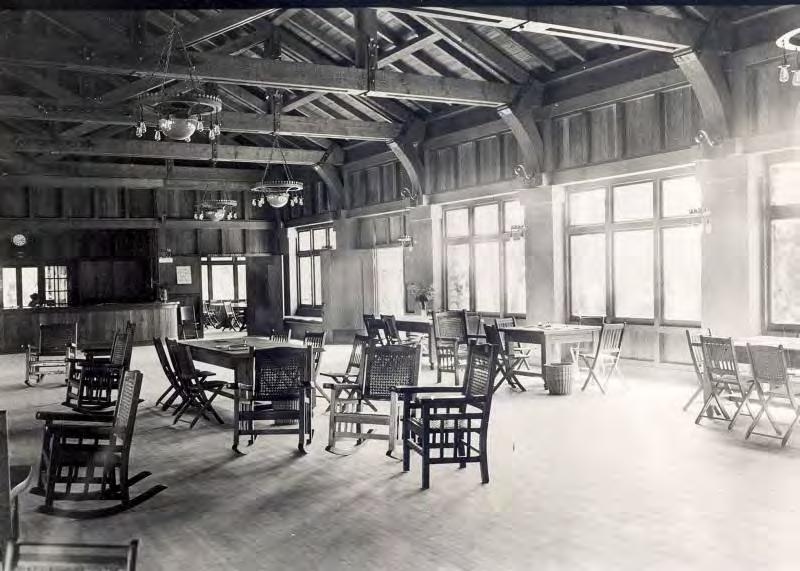 Phoebe Apperson Hearst Social Hall at Asilomar, designed by Julia Morgan (Asilomar State Park Office Archive)
Phoebe Apperson Hearst Social Hall at Asilomar, designed by Julia Morgan (Asilomar State Park Office Archive)
Historic Context Statement – Final
31 October 2011 Page & Turnbull, Inc. 147
Historic Context Statement – Final City of Pacific Grove Historic Context (1903 – 1926) Pacific Grove, California
By the 1920s Asilomar was open-year round, hosting a variety of religious organizations, women’s leadership meetings and other conferences in addition to the YMCA gatherings. In a sense, the facility was duplicating the exact role that Pacific Grove had played since the 1880s. Indeed, organizations such as the Sunday School Teacher’s Association began holding its annual meeting at Asilomar after World War I—around the same time that many of Pacific Grove’s older summer facilities were waning or had disappeared altogether.
WORLD WAR I
At the time the United States entered World War I in 1917, there were two military facilities located in the region. The military facility in Monterey—which had changed names several times since the American takeover of California—was not officially designated as the Presidio of Monterey until 1904. Further north was Fort Ord, which had been established as a military reservation at the end of the Civil War. Neither the Presidio nor Fort Ord had been particularly active in military affairs. In 1902, soldiers from the 15th Infantry and African-American “Buffalo Soldiers” from the 9th Cavalry had been assigned to Fort Ord, and for a time the African-American soldiers camped in Pacific Grove near the Chinese fishing village while their barracks were under construction.344 From 1907 to 1913 the School of Musketry was operated at the Presidio, serving as a forerunner of today’s Infantry Center at Fort Benning, Georgia.345
In 1917, as American entry into the war was looking increasingly likely, a military instruction camp was opened at Pacific Grove with 1,400 attendees. Soldiers from the Presidio cavalry were also sent to serve along the Mexican border.346 Around the same time, the government purchased 15,000 acres from David Jacks’ estate in order to develop an artillery range at Ford Ord. At the outbreak of war, 102 Pacific Grove men were called up in the first draft, including 10 aliens and one African American. Other Pacific Grove residents attended Victory Loan drives headed by former mayor, J.P. Pryor, who served as the president of the Central Coast Chapter, Pacific Coast National Defense League. Most citizens were enthusiastic in their support, but the local Committee for Public Safety also sternly warned that, “Those who are able to purchase Liberty Loan bonds and have not done so are known … their conduct toward purchases of Thrift Stamps and donations to the Red Cross will be closely observed and the slackers’ names subsequently divulged to the public.”347 No information was found to indicate where the Red Cross was located at this time, but Sanborn maps show that by 1926 the Red Cross was headquartered in the two-story building at 311 Forest Avenue (extant).
Over the course of World War I, three soldiers from Pacific Grove died in France. In addition to the human cost, the local tourist economy was also depressed by the war, leading to casualties of a different sort. This included the El Carmelo Hotel, which in 1907 had changed its name to the Pacific Grove Hotel. Up until this time the hotel’s operation had been subsidized by its owners, but the downturn in earnings during the war convinced the PIC to offer the building for sale at a price of $30,000. There were no takers. Thus, after thirty years of service the hotel was closed and dismantled in April 1918. Local merchant Wilford R. Holman bought the lot, and most of the old hotel’s lumber was hauled to Pebble Beach where it was used to help construct the Pebble Beach Lodge. 348
31 October 2011 Page & Turnbull, Inc. 148
DEL MONTE PROPERTIES
The construction of a new hotel at Pebble Beach was representative of an internal reorganization of the PIC that would have a profound effect on the future of Pacific Grove. Specifically, the PIC no longer felt that it could control the development of Pacific Grove in the manner that it wished. Thus, the decision was made to focus on improving other parts of the Monterey Peninsula where the company could exert greater influence. Leading the charge was Samuel Finley Brown Morse, who had become General Manager of the PIC in 1915. It was his recommendation that the PIC be split off from the Southern Pacific and reorganized as a new company known as Del Monte Properties. As part of the reorganization, the company would also divest itself of much of its land holdings in Pacific Grove. Recalling this period, Morse wrote:
In the development of Pacific Grove it occurred to me that there was little that could be done with the widely scattered lots owned by the Company throughout the developed section of the city. There was no architectural control to speak of, nor was there any opportunity left to handle an intelligent program of development. We decided to hold an auction and dispose of all the lots in this nature. … Lying west of the city, however, was a large piece of undeveloped property, and this we determined to develop and to control building by others so that the great natural beauty of the place would be preserved.349
This “large piece of undeveloped property” was the Pebble Beach area, where Morse advocated building of a golf course and lodge to help generate further interest in the area. This program was carried out, and in February of 1919 the Pebble Beach Golf Links and Del Monte Lodge opened to the public. Five days later, the Del Monte Properties Company completed the takeover of all of the PIC’s properties, which Morse described as:
18,000 acres of land on the Monterey Peninsula, all of the Pacific Grove and Pebble Beach areas, Del Monte Forest lands, the Los Laureles Rancho [more commonly called the Del Monte Rancho], Hotel Del Monte and all improvements, Pebble Beach Lodge and all improvements, and the capital stock of the Monterey County Water Works, which supplies water to the towns of Monterey, Pacific Grove and Carmel.350
Historic Context Statement – Final City of Pacific Grove Historic Context (1903 – 1926) Pacific Grove, California 31 October 2011 Page & Turnbull, Inc. 149
Pacific Grove Acres
Del Monte Properties soon began auctioning off its holdings in Pacific Grove, particularly the scattered individual lots that held little chance of coordinated development.351 However, in 1919 the company also filed a new subdivision map for a large area at the western end of the city known as Pacific Grove Acres (see map following page). The name was apt, as the individual parcels were larger than anything Pacific Grove had ever seen. Lots larger than an acre were the norm, and fourand five-acre lots were common. A few were even as large as seventeen acres. This resulted in a development pattern much more rural in feel, with houses spaced widely and set back considerably from the road. The streets also did not conform to the existing city grid, but rather were laid out in a rambling fashion with roads curving through the pine forest and out toward Asilomar. In fact, a fair portion of the new subdivision lay outside the city limits, which then roughly followed the line of Asilomar Avenue.352
Del Monte Properties Tract Office, 1920s (Monterey Public Library, California History Room)
Historic Context Statement – Final City of Pacific Grove Historic Context (1903 – 1926) Pacific Grove, California 31 October 2011 Page & Turnbull, Inc. 150
This was not the first subdivision of the area. An official City of Pacific Grove map completed in 1909 and on file at the Pacific Grove Heritage Society shows the presence of about two dozen parcels, all located south of Lighthouse Avenue and east of Grove Acre Avenue. The only exception was a triangular shaped area to the north formed by Jewell Avenue, Lighthouse and the 17 Mile Drive, then known as Dennett Avenue. Most lots were one or two acres, although a grouping of much smaller lots is also shown in the area bounded by Bentley Street, Dennett (17 Mile Drive), Lighthouse and Heacock avenues. The origins of this early unnamed subdivision are not clear, and by the time Pacific Grove Acres was recorded as a subdivision only a few homes had been constructed, including the Warner property used as the Del Monte Military Academy (described above). It also shows that the land between Alder Street (then the western limit of the city’s grid) and this earlier subdivision would become Municipal Park (later George Washington Park).
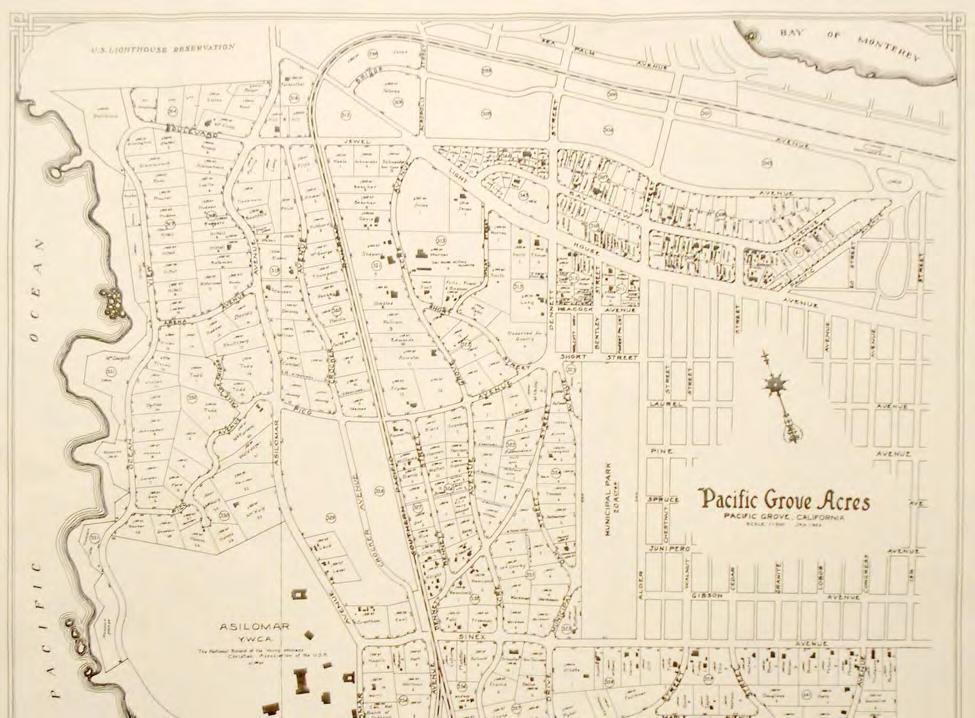 Map of Pacific Grove Acres, 1919 (Courtesy the Heritage Society of Pacific Grove)
Map of Pacific Grove Acres, 1919 (Courtesy the Heritage Society of Pacific Grove)
Historic Context Statement – Final City of Pacific Grove Historic Context (1903 – 1926) Pacific Grove, California 31 October 2011 Page & Turnbull, Inc. 151
Historic Context Statement – Final City of Pacific Grove Historic Context (1903 – 1926) Pacific Grove, California
Similarly, the same 1909 map shows that the area south of Sinex Avenue, from Congress Avenue on the east to Walnut Street on the west, had been divided into large lots. On subsequent maps of the area produced by the City of Pacific Grove’s Sewer Department, this area is identified as part of the Pacific Grove Acres subdivision, but it remains unclear exactly why these areas were subdivided earlier than the rest of the tract.
Regardless, development of the Pacific Grove Acres tract, much like the Beach Tract, was quite slow, and only a few dozen homes appear to have been constructed by the end of the 1920s. Many of the large parcels would also subsequently be subdivided into smaller lots, which would allow for denser residential development, as well as the development of new tourist facilities which steadily began creeping westward from the downtown area.
TRANSITIONS IN RESIDENTIAL DESIGN
Although the Victorian era may have ended with the death of British monarch, Queen Victoria, in 1900, houses featuring Victorian-era designs continued to be popular during the first years of the twentieth century. This included Pacific Grove’s “tent cottages,” which, with their simple massing and low-cost construction, proved to be quite a durable design inspiration. Cottages of this type continued to be built up until about 1910, as were somewhat larger Queen Anne style cottages, which frequently shared similar ornamentation, including patterned wood shingles and spindlework trim on their porches. The Pacific Grove Review of February 1904 reported that in “the last year upwards of one hundred new cottages have been built in the Grove and about twenty moved and repaired.”353 It appears that many of the tent cottages were used as rentals. A brochure for the city produced circa 1915 boasted that Pacific Grove had “hundreds of cottages, both furnished and unfinished, which may be rented at very reasonable rates.”354
The primary difference between tent cottages and the somewhat larger Queen Anne cottages is most evident in the massing. Tent cottages are almost exclusively simple rectangles with front-facing gable roofs, while the somewhat larger Queen Anne cottages frequently feature asymmetrical massing— most often expressed through a bay window located at one side of the primary façade. Queen Anne cottages are also more likely to have a hip roof, although their bay windows might be crowned with a pedimented gable end.
Other new housing styles were also gaining in popularity during this period. These included houses incorporating Classical Revival style details, such as windows topped by keystones, and cornices with dentil moldings. By contrast, the Craftsman style—which had its roots in the Arts and Crafts movement—largely rejected the emphasis on ornamentation. One of the city’s best examples of the Craftsman style is the Thomas A. Work house, designed by William Weeks and located at 176 Central Avenue. The house is a particularly strong example of the style, featuring river rock skirting, battered porch columns, and deep overhanging roof eaves. Most designs were far more modest, however, and simple Craftsman bungalows served as one of Pacific Grove’s most popular housing choices during the late 1910s and 1920s.
31 October 2011 Page & Turnbull, Inc. 152
A similar rejection of Victorian ornament is present in the Colonial Revival and Shingle styles, which were also popular at the beginning of the century. Colonial Revival houses sought to imitate aspects of early American residences, most often through the use of pediments above the entry. Houses based on Dutch Colonial designs from New York were also constructed, such as 441 Pine Avenue. These designs are most frequently marked by a gambrel roof. As its name suggests, the Shingle style emphasized wood shingle cladding. Based on English cottage precedents, Shingle style buildings often featured curving wall surfaces around windows, as well as flared eaves at the roofline.
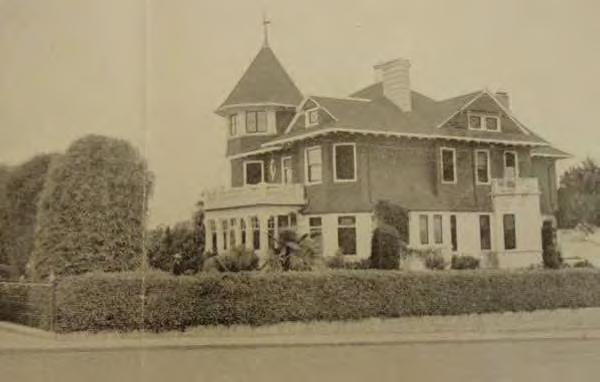
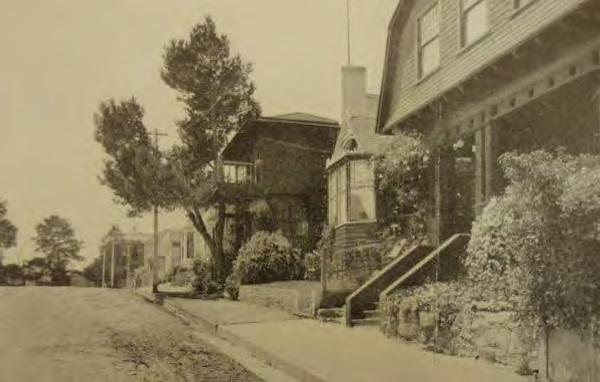
During the late 1910s and early 1920s, other styles began to take hold, including Prairie style buildings inspired by the designs of Frank Lloyd Wright. Far more popular, however, were buildings influenced by Spanish architecture, which would dominate the 1920s and 1930s. For the most part, these buildings were distinguished by design features that sought to mimic aspects of Spanish influenced architecture, such as red clay tile roofs, metal balconettes and the use of textured stucco to imitate adobe walls. These types of houses are also often grouped under the name of Mediterranean Revival architecture. The Spanish design impulse also included Pueblo Revival
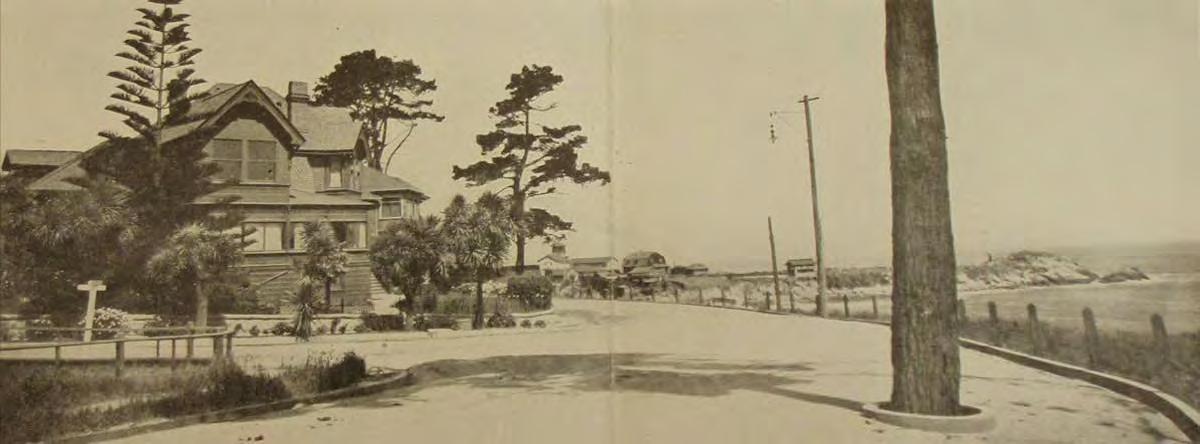 Photographs from a 1915 Pacific Improvement Company brochure highlighting the city’s residences (Monterey Public Library, California History Room)
Photographs from a 1915 Pacific Improvement Company brochure highlighting the city’s residences (Monterey Public Library, California History Room)
Historic Context Statement – Final City of Pacific Grove Historic Context (1903 – 1926) Pacific Grove, California 31 October 2011 Page & Turnbull, Inc. 153
architecture, inspired by the hybridization of Spanish and Native American designs used in the American southwest.
Mediterranean Revival style designs proved so popular that in several cases older Victorian homes were remodeled in the style in order to modernize them. This includes the enormous residence at 255 Ocean View (now used as the Maritime Inn), which was remodeled with Mediterranean Revival influences in 1925 by the Chivers Brothers—the same builders that constructed Pacific Grove’s City Hall.355 The Rensselaer Holman house at 769 Lighthouse Avenue also received a similar treatment. Perhaps the most enduring aspect of Spanish-influenced design was the use of stucco as an exterior cladding. Following World War I, the majority of all houses—regardless of their design—would employ stucco cladding rather than wood. This includes the Tudor Revival style, which also gained in popularity during the 1920s and into the 1930s.

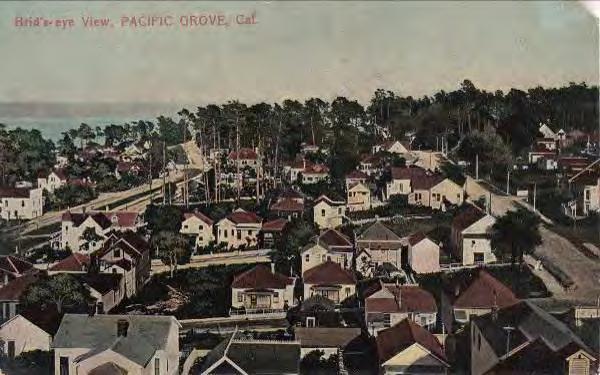
Perhaps the most unusually styled home of this period was a Chinese Pagoda house begun in 1926 for Doctor Bert Hanna. It is not clear why Hanna selected this design, and initially only the structural shell was constructed, with the interior completed over the ensuing decades. Addressed as 1501 Pico Avenue, the pagoda stood behind the main house closer to the road. It remains standing south of La Calle Corte near Asilomar.356
Residential buildings from this period may be significant for their architecture, as expressions of these new residential design trends, or as the work of a master architect or prominent builder. Groups of residences may also illustrate larger patterns of residential growth.
Postcards showing bird’s eye views of Pacific Grove, circa 1910 (Courtesy Charles Huff)
Historic Context Statement – Final City of Pacific Grove Historic Context (1903 – 1926) Pacific Grove, California 31 October 2011 Page & Turnbull, Inc. 154
END OF THE CHAUTAUQUA
During the 1910s, Pacific Grove was firmly in transition from a bucolic religious retreat into a more secular recreation area. Around 1910, the last of the PICs tent frames had been removed from “tent city,” and in 1913 the California Methodist Ministers Conference stopped holding annual meetings in the Methodist Church Assembly Hall.357 The fact that the Methodist ministers were no longer visiting Pacific Grove was a clear indication that the original spirit of the Retreat was giving way to a more modern form of tourism that emphasized recreation over spiritual meditation. Nevertheless, the Chautauqua meetings continued, although by this time their popularity was waning. Various factors have been cited for the decline of the Chautauqua, including the advent of motion pictures and radio, as well as an increase in the number of accredited colleges.358 The Chautauqua meetings themselves had also become an object of criticism for becoming commercially predictable scripted events produced by professional companies.

This was known as the “circuit Chautauqua,” or “tent Chautauqua,” which made its first national appearance in 1904 and its first appearance in Pacific Grove in 1906.359 Instead of events being produced by local or regional organizers, the circuit Chautauqua involved organized touring groups that moved from location to location, offering the same set of entertainment according to a set schedule. These commercial programs, which were held over the course of six days, typically involved about two-thirds music and drama, with the remaining third comprised of lectures. The stage productions, which had evolved from earlier poetry and play readings, were by far the most popular feature.360 By the 1920s the Ellison-White Lyceum and Chautauqua Association of Portland, Oregon, was producing the event in Pacific Grove.361 This included a visit in 1922, when the Chautauqua tent was pitched on a vacant lot where Holman’s Department Store is located today. In 1926, after a nearly fifty-year run, the final Chautauqua meeting was held in Pacific Grove.
 Chautauqua Tent Meeting, 1922. Photos by M.E. White. (Pat Hathaway Collection, reproduced in Images of America: Pacific Grove, p. 34)
Chautauqua Tent Meeting, 1922. Photos by M.E. White. (Pat Hathaway Collection, reproduced in Images of America: Pacific Grove, p. 34)
Historic Context Statement – Final City of Pacific Grove Historic Context (1903 – 1926) Pacific Grove, California 31 October 2011 Page & Turnbull, Inc. 155
RELIGIOUS DEVELOPMENT
Despite the decline of the Methodist Ministers Conference and the Chautauqua meetings, new churches continued to appear in Pacific Grove during this period. These included the First Baptist Church, constructed circa 1913 on the northeast corner of Laurel Avenue and 4th Street. The land for the church was purchased by Brenda Bodfish, who along with her husband Homer owned the Bodfish Dairy. The First Baptist Church would become Pacific Grove’s preeminent AfricanAmerican church, and is regarded as the “mother church” of many other African-American congregations on the Monterey Peninsula.362 The church appears to have been organized at the Samuel M. Farran Building located at 541 Lighthouse Avenue, which was then in use as the El Bethel Mission. An article in the Daily Review of July 1, 1907 states that a Reverend Lewis had come from San Jose to “canvass among the colored residents of this city, Monterey, and the Presidio of Monterey and his labors resulted in the organization of a Baptist church … The meeting was held at El Bethel Mission and was well attended by the colored people … some sixty colored residents of this vicinity have identified themselves with the organization.”363
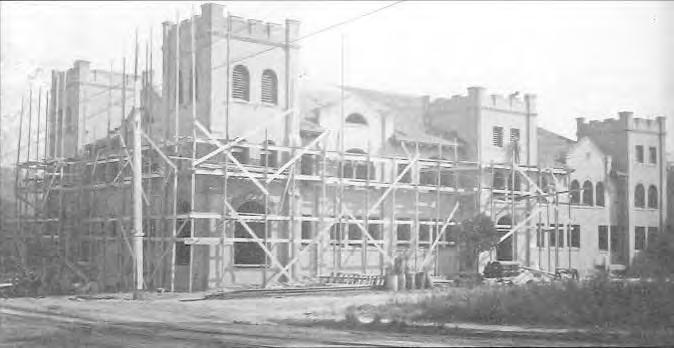
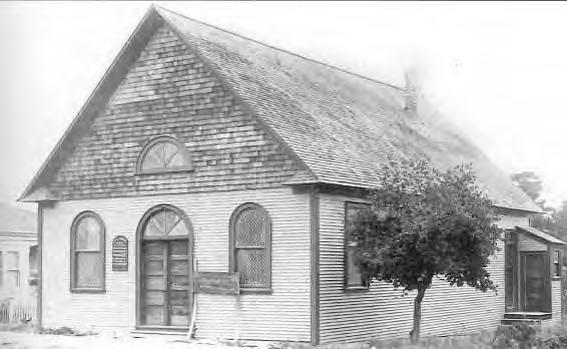
There are various explanations for why the church was organized in Pacific Grove. Certainly the purchase of the lot by Brenda Bodfish was a key factor, and the city’s tradition of religious tolerance—at least for Christian denominations—may also have made it attractive as a meeting place. Its location near the border with Monterey does not appear to have been associated with any enclave of African-American residents, but it may have facilitated attendance for African-American workers living in Monterey, as well as black soldiers serving at the Presidio. A review of the 1910 US Census reveals that Pacific Grove’s African-American population remained quite small during this period, and frequently engaged in domestic service. Some African-Americans lived in their own homes, while others are listed as boarders.
Although primarily an African-American church, it appears that during its early years the First Baptist congregation was interracial, attracting members from Monterey, Seaside, and other nearby communities.364 Nevertheless, Pacific Grove’s small African-American community was largely
First Baptist Church, circa 1912 (Heritage Society of Pacific Grove, reproduced in Images of America: Pacific Grove, p. 63)
Mayflower Congregational Church under construction, 1910 (C.K. Tuttle, Pacific Grove Museum of Natural History, reproduced in Images of America: Pacific Grove, p. 62)
Historic Context Statement – Final City of Pacific Grove Historic Context (1903 – 1926) Pacific Grove, California 31 October 2011 Page & Turnbull, Inc. 156
Historic Context Statement – Final City of Pacific Grove Historic Context (1903 – 1926) Pacific Grove, California
ignored by local papers, “noticed by the Review only with bad news or on special occasions … The Review did publish a notice of a revival week sponsored by [the church], but did not include the church in its Saturday column of scheduled services.”365 In either 1927 or 1931, the first chapter of the NAACP on the Monterey Peninsula was organized at the church, whose members included cannery workers, railroad employees and other laborers.366 The original church was demolished in 1965, and a new church completed on the same lot in 1966.
Little is known about the El Bethel Mission associated with the Baptist Church’s founding, although it appears to have operated in Pacific Grove for at least twenty-one years. The 1905 Sanborn map labels the Farran Building as a “mission,” while the 1914 and 1926 Sanborn maps show it as the “El Bethel Mission.” Research turned up few references to the organization, although in 1911 it published a quarterly newsletter called the El-Bethel Messenger.367
As previously mentioned, the original Gothic style Mayflower Congregational was destroyed by fire in March 1910. By the end of the year a new Mayflower Congregational Church designed by architect C. I. Birks was under construction and completed in 1911. The new church, while also designed in the Gothic Revival style, was a much larger building featuring a veneer of buff limestone brick produced in Seaside. The building also featured four dramatic three-story towers with embattled parapets arranged around the exterior. During the 1950s, all but one of these towers was removed due to problems with water leakage.368
The Church of Christ Scientist had been established in Pacific Grove at least as early as 1914, when Sanborn maps show it occupying one of the Retreat cottages adjacent to the Old Parlor on the southeast corner of Fountain and Ricketts. They also appear to have purchased or leased the former Pacific Grove Fire Department building nearby, which is shown as a public reading room. In the early 1920s the church purchased the lot at the northwest corner of Central and Fountain avenues and constructed a new building using lumber from the Pine Street School, which had recently been dismantled. The cornerstone of the new church was laid in 1923, and the building completed in a loose interpretation of the Colonial Revival style. In accordance with church policies, however, it was not formally dedicated until the building debt was paid off in 1930. The church was extensively remodeled to its current appearance in 1959.369
In 1925 the Bethlehem Evangelical Lutheran Church chapel was constructed on the southwest corner of Pine Avenue and 15th Street adjacent to the Robert Down School (extant). The church continued at this location until 1939 when the building was purchased by the school for use as adjunct classroom space. An October 13, 1939, article in The Tide states that it was purchased by the Board of Trustees for use as a kindergarten department due to increasing enrollment, which was expected to grow “until the end of the canning season in February.”370 While most cannery workers lived or boarded in Monterey, this reference appears to indicate that Pacific Grove’s schools were used to accommodate the overflow of children belonging to seasonal cannery employees.
31 October 2011 Page & Turnbull, Inc. 157
Historic Context Statement – Final City of Pacific Grove Historic Context (1903 – 1926) Pacific Grove, California
The church subsequently moved to 160 Monterey Avenue in 1939 into a building erected by the Theosophical Society. An addition was made in 1942 and another in 1948 which faced 11th Street and was used as a Parish hall. In 1957, the congregation moved to Cass Street in Monterey, and the former church currently appears to be in use as a private residence.371
The Theosophical Society Hall appears to have been constructed circa 1928. Theosophy is a spiritual movement that originated in New York City during the late nineteenth century. Among its tenets was a notion of universal brotherhood dedicated to the evolution and perfection of mankind in concert with an intelligent spiritual entity.372 The Theosophical Society is known to have been active in Pacific Grove at least as early as the 1910s, but as late as 1926 it appears in the city directory as being headquartered at the home of society president, Helen Cleaves, at 520 19th Street (extant).
A PEAK IN COMMERCIAL DEVELOPMENT
As Pacific Grove entered the “Roaring Twenties,” commercial development was steadily building to a crescendo that would culminate in the opening of two of the largest buildings ever constructed in the city’s history. These buildings introduced new architectural styles, construction methods and materials, and set precedents that would guide commercial development through the middle of the century. Likewise, by the close of the 1920s the clustering of shops, markets, theaters and social halls along Lighthouse Avenue reached a peak that would not be exceeded for several decades.
Among the first notable developments of this period was the opening of E. C. Smith’s two-story bank at 569 Lighthouse Avenue in 1916 (extant). This Neoclassical building came to be known as the Security State Bank and would later be expanded during the 1960s.373 Three years later, the dismantling of the Pacific Grove (El Carmelo) Hotel provided an opportunity for Wilford Holman to redevelop the property—reportedly purchased for $10,000 from Del Monte Properties. Wilford was the son of R. L. Holman—who had died in 1909. In 1919 Wilford constructed a large reinforced concrete auto garage, repair and supply store that spanned the entire block between Fountain and Grand avenues south of Central Avenue (extant). The garage could hold 90 cars and featured Pacific Grove’s first gas station.374
Construction of the garage was the first step toward the development of a new Holman’s Department Store, which would be much larger than any of the family’s previous operations. Excavation of a large basement area for the store started in 1923, which required blasting and scraping to cut through the rock that underlaid the site. When the new reinforced concrete Holman’s Department Store opened in 1924, it was hailed as one of the largest independent stores between San Francisco and Los Angeles, featuring expansive showrooms on the first floor and in the basement, as well as a wraparound mezzanine on the second story.375
31 October 2011 Page & Turnbull, Inc. 158
Architecturally, the new Holman’s building was typical of commercial buildings of the period, featuring restrained Classical Revival style details such as an arched window at the center of the primary façade and a modillioned cornice. To maximize lighting for the retail space, a full-width clerestory spanned the first floor, surmounted by ten bays of windows on the second floor. In 1931, the store would be enlarged with the addition of a third floor, as well a wood-frame fourth floor solarium. Photos from this period indicate that the current glass block windows are not original, and that the storefronts featured a somewhat different configuration and detailing.376
After the new Holman’s Department Store opened, the business’ prior location at the northeast corner of Lighthouse Avenue and 17th Street was redeveloped. In August 1925, the new Grove Theater opened on the lot, occupying an entire half-block lot adjacent to the Winston Hotel. The theater was built by general contractor William Sweeny, and was operated by the Golden State Theater & Realty Company. The building featured Spanish Colonial Revival style details and had been designed by the Reid Brothers, James and Merritt, who were among the best-known architects working in California at the time. During the 1920s in particular, the Reid Brothers designed a large number of movie “palaces” located throughout California. The Grove Theater was the first in the Monterey area to feature a pipe organ. Facing Lighthouse Avenue, the building included two storefronts flanking a large marquee hanging over the entrance, and in 1935 a large vertical blade sign would also be added above the marquee.377 For many years the theater also served as the Greyhound bus terminal, but the original theater building was destroyed by fire in 1951.378
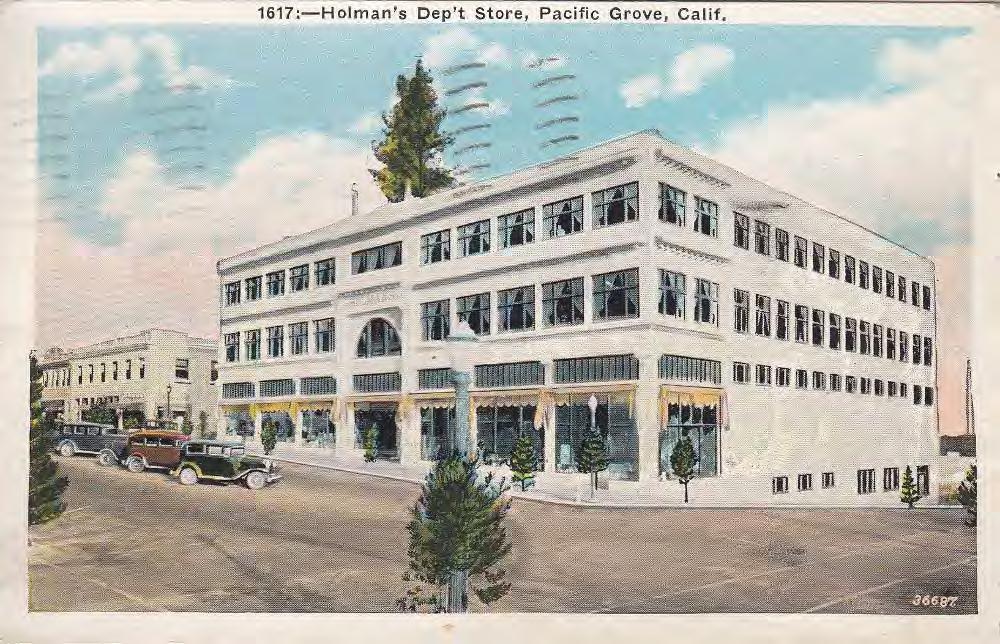 Postcard of Holman’s Department Store, circa 1930 (Courtesy Charles Huff)
Postcard of Holman’s Department Store, circa 1930 (Courtesy Charles Huff)
Historic Context Statement – Final City of Pacific Grove Historic Context (1903 – 1926) Pacific Grove, California 31 October 2011 Page & Turnbull, Inc. 159
Another notable development during this period was the opening of the Pacific Biological Laboratory by Edward F. Ricketts in 1923. The laboratory was located at 165 Fountain Avenue in what had been the Old Parlor during the earliest days of the Pacific Grove Retreat (no longer extant). Born in Chicago in 1897, Ricketts served in the Army Medical Corps during World War I, and later attended the University of Chicago for two years where he became interested in ecology. He subsequently came to California with his partner, Albert E. Galigher, and set up his biological supply business in Pacific Grove to provide specimens to schools and labs across the country.379
In 1928, Ricketts moved his lab to 740 Ocean View Avenue in Monterey where it would remain for the next two decades. During this period he lived with his wife, Anna, and three children at several homes in Pacific Grove, including 331 Lighthouse Avenue and later 221 4th Street.380 Ricketts’ insights as a biologist would later win him scientific acclaim, but it was his association with famed author John Steinbeck that would bring him his greatest notoriety. (A fuller discussion of both Ricketts and Steinbeck is included in the following chapter).
Other commercial developments taking place around this time was the circa 1925 construction of a new mortuary at 390 Lighthouse Avenue on the northeast corner with Monterey Avenue (extant, but altered). This was the Paul Mortuary, operated by J. K. Paul and his sons George and Leland.381 The Paul family would later erect a crematory in El Carmelo Cemetery during the 1940s.
The following year, Pacific Grove witnessed the completion of the city’s largest edifice with the opening of the five-story Forest Hill Hotel at 551 Gibson Avenue on July 1, 1926. Designed with Mediterranean Revival style influences, the reinforced concrete building featured 98 rooms and was built by the C.I. Weld Co. of San Francisco at a reported cost of $300,000. Two large reinforced
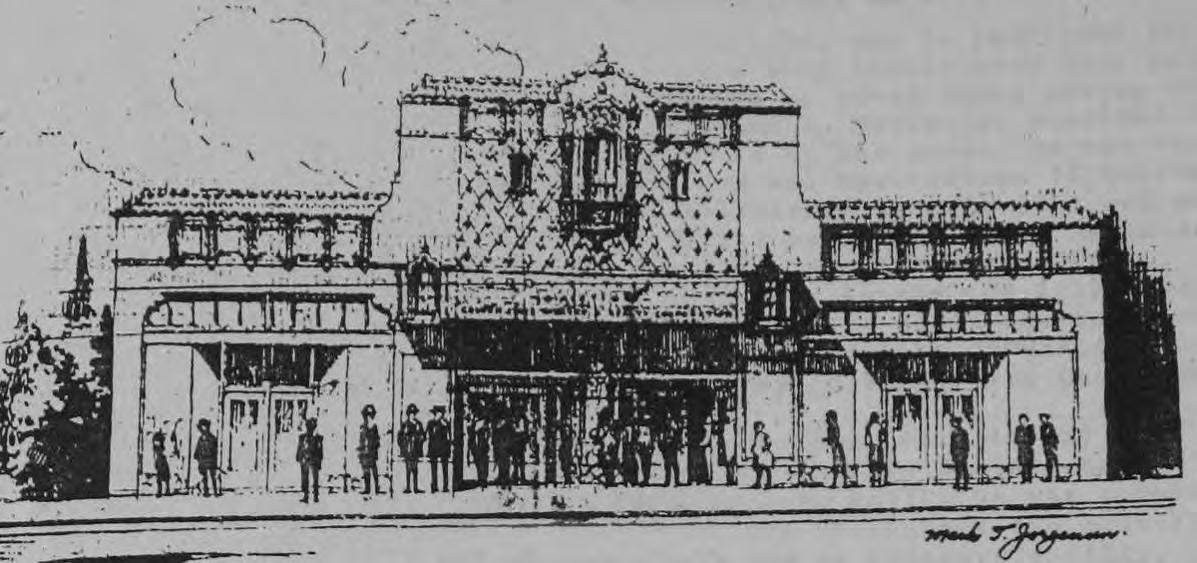 Original sketch of Grove Theatre, 25 April 1918 (Donald M. Howard, The Old Pacific Grove Retreat, 1875-1940)
Original sketch of Grove Theatre, 25 April 1918 (Donald M. Howard, The Old Pacific Grove Retreat, 1875-1940)
Historic Context Statement – Final City of Pacific Grove Historic Context (1903 – 1926) Pacific Grove, California 31 October 2011 Page & Turnbull, Inc. 160
concrete parking garages were also built adjacent to the hotel near the northwest corner of Fountain and Sinex avenues (original garages no longer extant). Financing for the hotel was provided by Samuel S. Parsons, a successful vegetable broker who had purchased a summer home in Pacific Grove in 1915. By 1923 Parsons had purchased the old Hollenbeck Block on Lighthouse Avenue, which he rebuilt around this time as a two-story building that included shops and annex rooms for the Forest Hill Hotel.382 Also included in the development was the purchase of lots for the Forest Hill Playground, located between 14th Street, Junipero, Fountain and Gibson avenues. A dwelling on the property was converted into a Girl Scout Home, and over the next fifteen years the city would repurchase the playground—today known as the Junipero Community Center—from Parsons under a lease-purchase agreements.383
Viewed as a group, the construction of Holman’s Department Store, the Grove Theater, and the Forest Hill Hotel represented the buoyant optimism of the 1920s, when Pacific Grove was increasingly within easy reach of automobile tourists, as well as becoming home to more and more year-round residents. Two of the buildings also represent important stylistic trends of the period, as both the Grove Theater and Forest Hill Hotel were constructed with Spanish-influenced architecture. Other commercial buildings also responded to this trend, including the remodeling of the Hotel Del Mar, which was recast as a Mediterranean Revival style building around this time through the addition of stucco cladding and red tile accents.384
 Postcard of the Forest Hill Hotel, 1925 (reproduced in Monterey Bay Yesterday, p. 8)
Postcard of the Forest Hill Hotel, 1925 (reproduced in Monterey Bay Yesterday, p. 8)
Historic Context Statement – Final City of Pacific Grove Historic Context (1903 – 1926) Pacific Grove, California 31 October 2011 Page & Turnbull, Inc. 161
THE ADVENT OF THE AUTOMOBILE
In Pacific Grove as elsewhere, the public embrace of the private automobile took many years to fully develop. During the early 1900s, actual horsepower—versus mechanical horsepower—was still the dominant means of moving people and goods. This is best evidenced by the continued construction of stable and horse feed shops well into the 1910s. In 1905, Joseph Gardner constructed a new twostory wood frame stable at 214 Fountain Avenue (extant). He also acquired part of adjacent planing mill building and converted it to a hay barn. Another one story concrete feed and hay storage building was constructed at 307 Forest Avenue by 1914. As these new buildings went up, the city lost one of its most important icons of the past: the Mammoth Stables was largely destroyed by fire in February of 1909. The tower of the stables, which was then owned by Thomas Luke, was partially saved by the fire department, but had to be torn down for safety reasons. A large new wood frame Mammoth Stable and Livery building was built in a new location at 228 – 230 Forest Avenue by 1914, covering the entire southern end of the block between Forest and 16th Street (extant). This allowed Grand Avenue to be graded through between Lighthouse and Laurel avenues for the first time.
At the same time as these stables were being constructed, the private automobile was quickly gaining in popularity, although not without reservations. As early as 1905 the City passed an ordinance making it illegal to operate an automobile, motor cycle or other powered vehicle faster than 10 mph.385 Nevertheless, as evidenced by Sanborn maps, the construction of buildings, parking lots, service stations and other auto-related infrastructure would have a tremendous impact on early twentieth century Pacific Grove, particularly in the central business district. Auto-related lightindustrial buildings such as these may therefore be significant as an example of this important trend.
Sometime before 1911, Thomas A. Work constructed a two-story, reinforced concrete auto garage and salesroom at 174 Grand Avenue, which spanned the entire block directly behind his buildings on Lighthouse Avenue (extant). As with his commercial block, the building features cast concrete cladding meant to imitate stone. It appears Work used the garage for both selling and servicing
Former Gardner Stables/Pacific Grove Garage, 212-216 Fountain Avenue. (Page & Turnbull, 2011)
Historic Context Statement – Final City of Pacific Grove Historic Context (1903 – 1926) Pacific Grove, California 31 October 2011 Page & Turnbull, Inc. 162
City of Pacific Grove Historic Context (1903 – 1926) Pacific Grove, California
Studebaker and Saxon automobiles.386 By 1914, another enormous reinforced concrete auto garage had been erected in place of the old Mammoth Stable building, spanning the entire block between Fountain and Grand (variously addressed as 227 – 233 Grand or 220 – 222 Fountain, and still extant). A former store at 307 Forest Avenue was also enlarged around this time and converted to an auto garage and repair shop. As more automobiles appeared in the city, the old stable buildings were converted to garages. By 1919, Gardner’s Stables at 212 – 218 Fountain Avenue had been refitted as the Square Deal Repair Shop.387 Similarly, the Mammoth Stable Livery was also converted to a garage and repair shop by 1915 that came to be known as the “City Hall Garage.”388
The popularity of the automobile was such that the PIC in 1913 announced that cars could not carry passengers for hire through the company gates on the 17 Mile Drive, and that the “17-Mile Drive organization said that autos were causing so much wear and tear on the Drive that, come the first of May, there would be a gate charge for road maintenance … Private horse-drawn vehicles would be passed free.”389 For a time, the PIC maintained its own garage for electric automobiles in what had been the Old Parlor building on the northeast corner of Fountain Avenue and High (now Ricketts) Street. 390
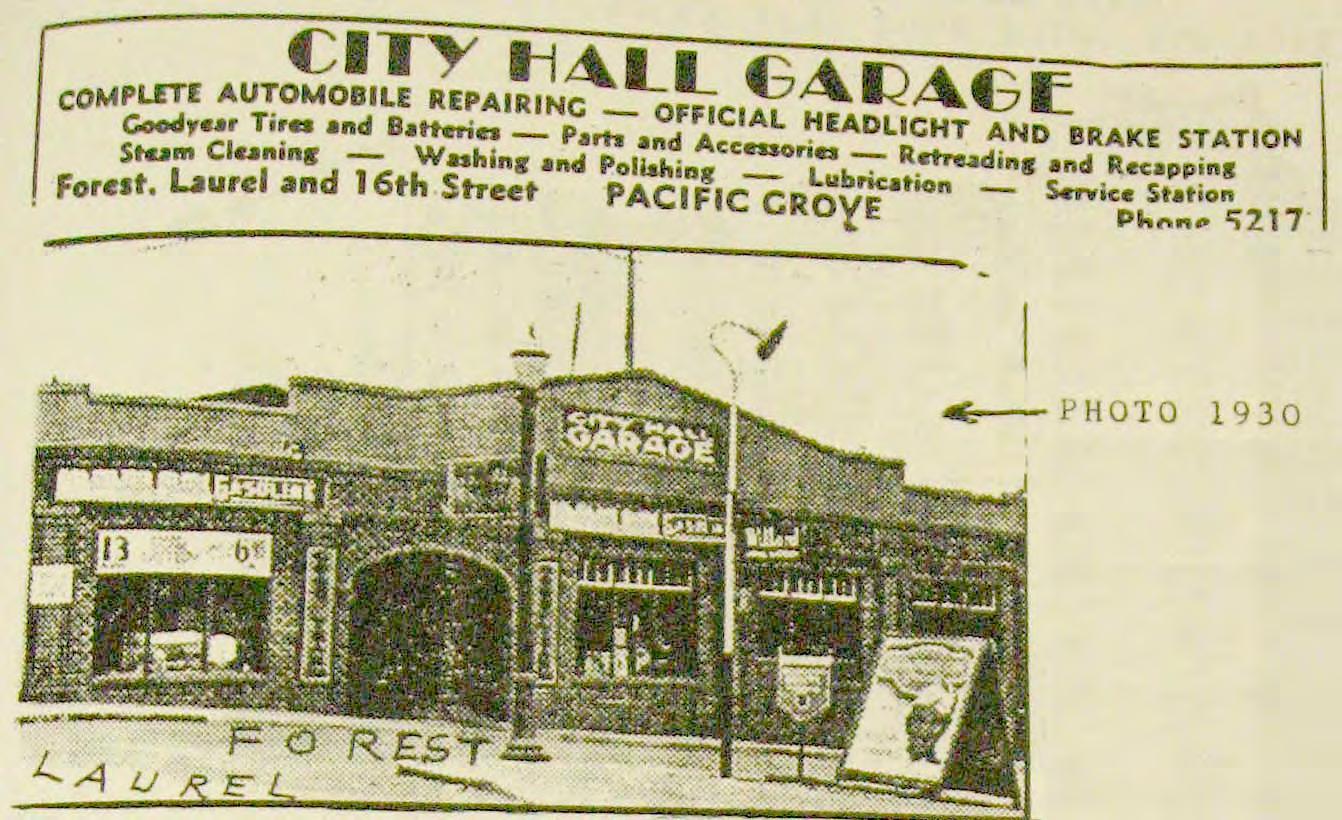 City Hall Garage, circa 1930. The above image shows a photograph of the garage and an advertisement from a city directory. (Donald M. Howard, The Old Pacific Grove Retreat, 1875-1940)
City Hall Garage, circa 1930. The above image shows a photograph of the garage and an advertisement from a city directory. (Donald M. Howard, The Old Pacific Grove Retreat, 1875-1940)
Historic Context Statement – Final
31 October 2011 Page & Turnbull, Inc. 163
Competition from the private automobile also pressured the streetcar system of the Monterey & Pacific Grove Railway Company. In 1905, the company had confidently extended its line down 19th Street to the Southern Pacific Depot. By the mid 1910s, however, the company was facing increasing competition from both private automobiles and motorized jitney services. After World War I the system began to lose money, and its debts further increased with the founding of the Bay Rapid Transit Company by J. Mason & Associates in 1922, whose Del Monte-Monterey-Pacific Grove bus line duplicated the route of the streetcar.391 The following year the streetcar era ended in Pacific Grove with the abandonment of all service on the line on July 20, 1923.392
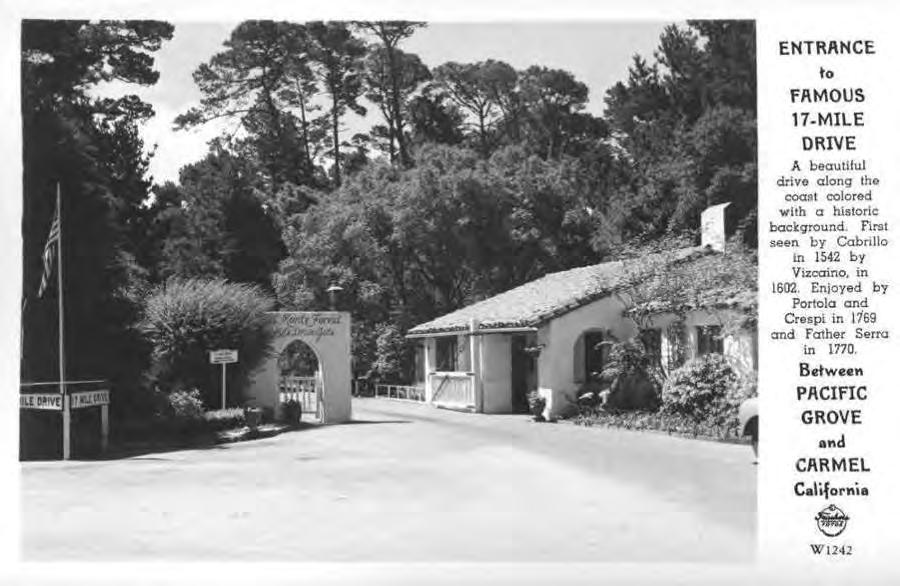 Due to increased automobile traffic, a gatehouse was erected at the entrance to 17-Mile Drive. Photo: 1947. (Pomona Public Library)
Due to increased automobile traffic, a gatehouse was erected at the entrance to 17-Mile Drive. Photo: 1947. (Pomona Public Library)
Historic Context Statement – Final City of Pacific Grove Historic Context (1903 – 1926) Pacific Grove, California 31 October 2011 Page & Turnbull, Inc. 164
Just as the streetcar was disappearing, Pacific Grove would see the construction of its first paved roads. In 1923 the Clark & Henery Construction Company—specialists in asphalt and paving—set up shop at the foot of Grove Acre Avenue near the end of the Southern Pacific Railroad Tracks. That year they received an $86,000 contract to pave 24.5 blocks of Lighthouse from 19th Street to the border of Monterey. A separate contract was also awarded to pave Forest Avenue to Sinex Avenue.393
By this time Pacific Grove’s auto-related facilities had grown to include gas and oil stations in several locations, including two stations on the west side of Central Avenue between Fountain and 15th Street, as well as a filling station on the southwest corner of Lighthouse Avenue and 17th Street (none extant). Within a few years, two of the oldest homes in Pacific Grove—including one built for Joseph O. Johnson in 1879—would be moved from the northeast corner of Fountain and Lighthouse in order to accommodate the construction of an Associated Oil Company filling station (replaced in 1960 by a newer station). Another filling station was constructed in 1927 at the foot of 17th Street across from the Lovers Point bath house.394 The impact of the automobile was so tremendous, that by 1926 four of the seven largest buildings in Pacific Grove were auto garages. These included the former Mammoth and Gardner stables, as well as the Thomas A. Work auto shop and a new garage constructed behind Holman’s Department Store.
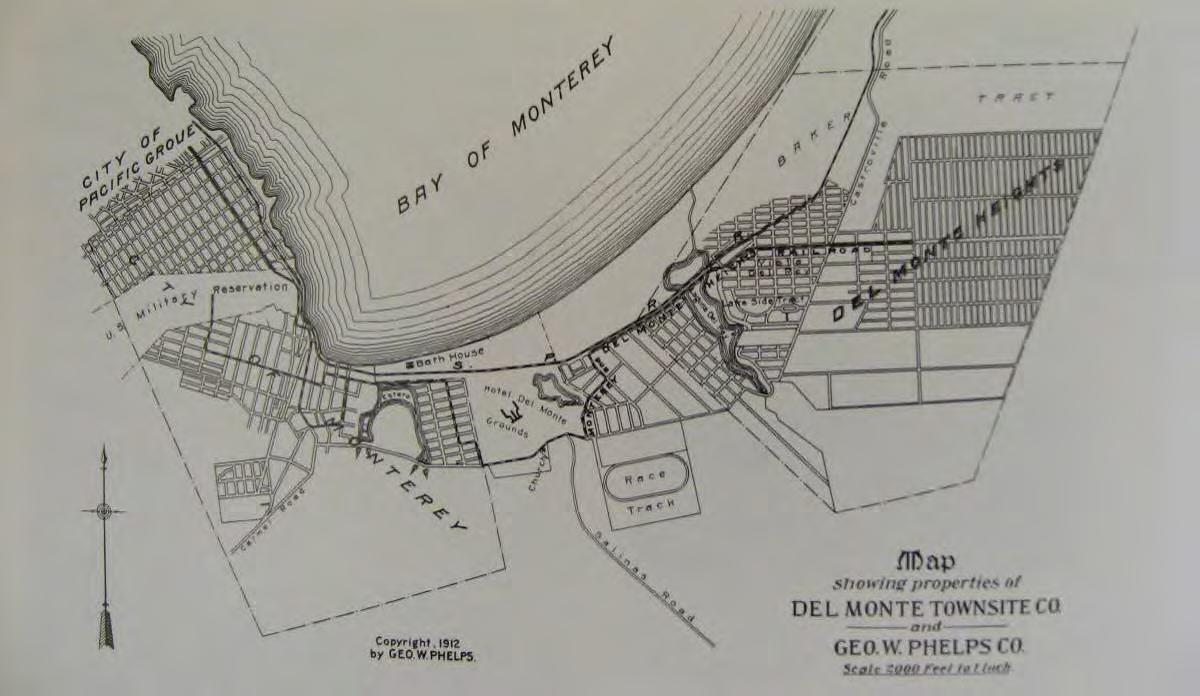 Streetcar map showing extent of service, 1912. Within a decade, the increased popularity of the private automobile causes the end of the streetcar era in Pacific Grove. (Erle C. Hanson, Monterey & Pacific Street Car Era, p. 42)
Streetcar map showing extent of service, 1912. Within a decade, the increased popularity of the private automobile causes the end of the streetcar era in Pacific Grove. (Erle C. Hanson, Monterey & Pacific Street Car Era, p. 42)
Historic Context Statement – Final City of Pacific Grove Historic Context (1903 – 1926) Pacific Grove, California 31 October 2011 Page & Turnbull, Inc. 165
Auto Camps and Cottage Courts
Between 1923 and 1929, the number of automobiles in the United States doubled from 13 million to 26 million registered vehicles.395 With this growth came a need for new facilities to serve the burgeoning automobile tourist industry. Auto camps proved especially popular, and were developed throughout the country as a reasonably-priced choice for automobile travelers. Many were crude by modern standards, offering only a parking space, a tent and common bathroom facilities. But more elaborate auto camps would also develop, serving as mini-resorts unto themselves with cabins, stores and service stations. Given Pacific Grove’s established position as a popular seaside resort, it was only natural that a number of auto camps developed during this period—in some ways serving as successors to the earlier “tent city” operations. Nearly all of these facilities were located in the relatively undeveloped piney woods at the western end of the city.
The first auto camp to appear was opened in 1920 by Guy Getz and Bert Tibbs, who provided a simple facility with canvas tents located near the intersection of Lighthouse Avenue and Grove Acre avenues. It was soon improved with electric lights and restrooms and dubbed the Pine Grove Camp—later known as the Pine Grove Court.396 By 1937 the facility included 35 cabins, but no camping spaces. Some buildings of this facility may still be extant across from Sea Breeze Inn, but precise identification is hampered by the unavailability of Sanborn maps for the western end of the city.397
The following year the Knight Cottage Court was opened at 428 Dennett Street by George and Edith Knight. It included 17 cottages spread out across a one acre lot located north of Sinex Avenue near Asilomar (does not appear to be extant).398 In 1922, the much larger Del Monte Forest Camp opened on 27 acres located south of the intersection of Lighthouse and Asilomar avenues. This facility appears to have had some connection with Del Monte Properties, as a company brochure produced in 1928 states that Del Monte Forest Camp “is a haven of comfort and pleasure for the camper. Every modern convenience of home is brought to your tent.”399 The Del Monte Forest Camp was managed by Charles Fackenthal, who also served as pastor of St. Mary’s-by-the-Sea and lived at 750 Laurel Avenue. His wife also maintained an extensive collection of Native American artifacts, many of which had been collected in Pacific Grove.400
R.L. Polk & Companies 1926 Pacific Grove City Directory indicates there were at least five auto camps in operation, described as “located in the pine forests near the ocean.” While this was an impressive start, the coming years would witness further development of new highways and road connections that would lead to the establishment of auto camps on a much larger scale.
INDUSTRIAL DEVELOPMENT
From its inception, Pacific Grove was developed primarily as a residential area, and industrial works of any kind were rare. In particular, after about 1915 auto repair facilities, garages and service stations (which are typically classified as light industrial properties) comprised the bulk of the city’s
Historic Context Statement – Final City of Pacific Grove Historic Context (1903 – 1926) Pacific Grove, California 31 October 2011 Page & Turnbull, Inc. 166
Historic Context Statement – Final City of Pacific Grove Historic Context (1903 – 1926) Pacific Grove, California
industrial development. Nevertheless, the city was home to a few larger industrial operations during this period, most of which revolved around lumber, sand mining, or boat construction.
The most familiar to residents of Pacific Grove was the large Loma Prieta Lumber Company lumber mill located north of the Southern Pacific Railroad tracks and southwest of Lovers Point. In addition to the lumber yards and sheds, Sanborn maps from 1905 and 1914 indicate that the Pacific Grove Planing Mill (later the Sierra Lumber Company Planing Mill) was located adjacent to the yard at what is today the northwest corner of Mermaid Avenue and 17th Street. A planing mill functioned as the final step in lumber processing, where seasoned wood was profiled and patterned it into different stocks for a variety of uses. By 1926, the planing mill had been removed and the Loma Prieta yard is shown as belonging to O. E. Chase. A second lumber yard operated by the Homer T. Hayward Lumber Company was also located south of the railroad tracks near the intersection of Briggs Avenue and 19th Street. It featured buildings for offices and sash and door storage. None of these buildings remain standing, and it does not appear these lumber operations were associated with any enclaves of dedicated worker housing or company dormitories.
Given the relationship between the Loma Prieta Lumber Company and the Southern Pacific, it seems likely that their lumber was frequently used for PIC projects. In 1914, Sanborn maps show that the PIC had reserved an entire block bounded by 14th Street, Sinex, Carmel and Gibson avenues for a PIC construction yard, which included a large stable and a blacksmith shop. Material from the company’s sand mining operations was also used for construction projects. A company brochure issued during the same period mentions that, the “the Pacific Investment Company will, for a limited time only, deliver rock and sand to such builders in PG at the cost of hauling, with no charge for material.”401
The other large lumber company in town belonged to Thomas A. Work. Around the turn of the century, Work had operated a lumber yard with a steam splitter on the northwest corner of Forest and Laurel avenues, which was said to process oak wood harvested from Carmel Valley.402 However, by 1912 Work had purchased a large lumber mill site from the David Jacks Corporation (Jacks died in 1909).403 Work’s mill was located on two large lots straddling the Pacific Grove/Monterey border in an area roughly bounded by Eardley Avenue on the north, Lighthouse Avenue on the west, Central Avenue on the east, and a lot south of David Avenue. Sanborn maps indicate that by 1926 the facility included a large planing mill, a lumber kiln, a glazing shop for windows, and areas for wood shingle storage. On the southwest corner of Central and Eardley avenues, it also included an auto garage and filling station, possibly to handle the company’s service trucks. This is supported by a May 12, 1912, article in the Pacific Grove Review, which stated that Work would now be handling all deliveries with auto trucks instead of horses. Sanborn maps indicate the lumber mill operated until at least 1962, although no facilities remain today except for the auto garage, now known as Monterey Motors and addressed as 95 Central Avenue.
31 October 2011 Page & Turnbull, Inc. 167
City of Pacific Grove Historic Context (1903 – 1926) Pacific Grove, California
Garage for T.A. Work’s lumber yard, now Monterey Motors, at 95 Central Avenue. (Page & Turnbull, 2011)
The third of Pacific Grove’s large industrial facilities during this period also centered on construction materials—the Pacific Improvement Company’s sand mining operations near Lake Majella. At the turn of the century, sand from the dunes near Asilomar was exported to sand the Southern Pacific Railroad tracks for better traction. Following the 1906 Earthquake there was a large need for sand products to help rebuild San Francisco, and operations there increased significantly in the years following the disaster. By 1920, a new motorized dragline was installed to mine the sand, which was soon augmented by a conveyor belt system feeding a grinding ball mill. This facility ground the sand into finer products appropriate for ceramics, glass, sandblasting, roofing paper, soap, and other uses.404
Del Monte Sand Plant, circa 1945 (Julian P. Graham; Pebble Beach Company Lagorio Archives, reproduced in Images of America: Pacific Grove, p. 101)

Historic Context Statement – Final
31 October 2011 Page & Turnbull, Inc. 168
City of Pacific Grove Context 1926) Pacific Grove, California
Rounding out Pacific Grove’s prominent industrial facilities at this time was Cochran and Peterson’s Monterey Boatworks, built on the site of the former Chinese fishing village in 1916 (extant). The facility was developed to serve Monterey’s fishing fleet and the growing fishing operations at Cannery Row. During the 1920s one of the shipwrights, Angelo Siino, took over management of the boatyard, and a second building was constructed in 1927 (today known as the Fisher Building). Between 1925 and 1941 the facility turned out 75 boats, including double-enders, Monterey Clippers, purse seiners and small working boats. They also built specialized fish hoppers capable of holding the sardine catch before processing. As the sardine industry declined, the boatyard began to concentrate on constructing sport fishing boats. One of their felucca fishing boats today hangs in the Monterey Bay Aquarium.
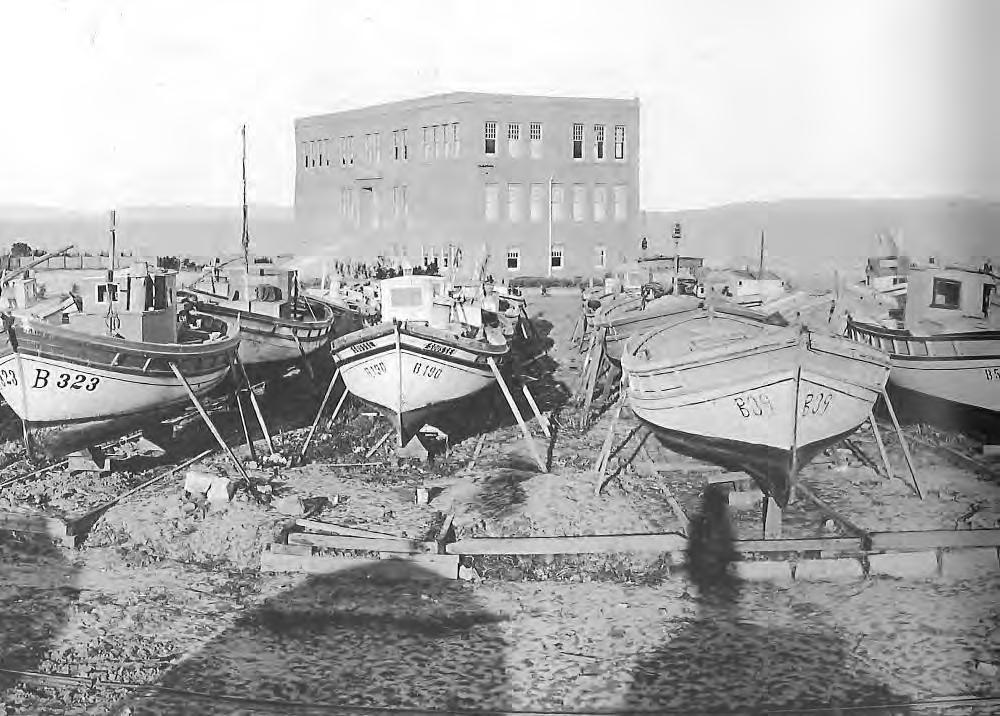 Monterey Boatworks, circa 1920. (A.C. Heidrick; Monterey Public Library, California History Room, reproduced in Images of America: Pacific Grove, p. 121)
Monterey Boatworks, circa 1920. (A.C. Heidrick; Monterey Public Library, California History Room, reproduced in Images of America: Pacific Grove, p. 121)
Historic Context Statement – Final
Historic
(1903 –
31 October 2011 Page & Turnbull, Inc. 169
Historic Context Statement – Final City of Pacific Grove Historic Context (1903 – 1926) Pacific Grove, California
ASSOCIATED PROPERTY TYPES & REGISTRATION REQUIREMENTS (1903 – 1926)
The primary theme of the “Pacific Grove Comes of Age” period is the maturation of the city, as evidenced by construction of new civic facilities, the arrival of large-scale commercial development along Lighthouse Avenue, and the use of new architectural styles and building materials. Other notable developments included the redevelopment of the beach area at Lovers Point into a fullydeveloped tourist destination, the destruction of the Chinese fishing village and subsequent redevelopment of China Point, as well as the end of the Chautauqua gatherings. The creation of Del Monte Properties as a successor firm to the Pacific Improvement Company and its influence on the sale of lots and development of subdivisions would also become an important force during this era. Finally, the growing influence of the private automobile is a theme that can be seen in commercial, light industrial, and residential development patterns. Property types associated with these significant themes include residential properties, commercial properties, civic & public assembly properties, light industrial properties, and cultural landscape elements. Although auto camps & cottage courts were an important property type during this period, there do not appear to be any extant examples today.
RESIDENTIAL PROPERTIES
The overwhelming majority of surviving buildings constructed between 1903 and 1926 are residential, primarily consisting of single-family homes with a small minority of multi-family residences. During the early years of the twentieth century many residences continued to display architectural devices more commonly associated with the late Victorian era. Conversely, by the end of this period, many residences in Pacific Grove were designed in period revival styles that represented a dramatic shift from earlier eras—most easily recognized by a transition from wood to stucco cladding.
Residential architecture of the period encompassed a wide range of styles, with the most popular roughly following a chronology that included the last examples of Victorian architecture (to about 1910); the Craftsman style (1905 to about 1930); the Colonial Revival style (1905 – 1955); and the extremely popular Spanish Colonial Revival style (1920s – 1950s). Vernacular style buildings were also quite common, while other styles were also present as a minority, including the Shingle and Tudor Revival styles. For the purposes of this discussion, the Spanish Colonial Revival style, sometimes referred to as Mediterranean Revival style or Spanish Eclectic, has been grouped with the related Pueblo Revival Style. No matter the name, these buildings are unified by their attempt to mimic architectural aspects of Spanish Colonial architecture.
As a general rule, most residences are rectangular, and most frequently only one story in height. Wood frame construction is near universal, although brick and stone structural systems are possible. Gable and hip roofs are by far the most common, although flat roofs (or combination roofs, such as gable and flat roofs) are also apparent. Houses typically feature a somewhat larger set back from the front lot line as compared to the previous period, but very few are deeply recessed on their lot. As the private automobile grew more popular during this period, it was not uncommon for residences
31 October 2011 Page & Turnbull, Inc. 170
Historic Context Statement – Final City of Pacific Grove Historic Context (1903 – 1926) Pacific Grove, California
constructed on larger lots to reserve space for a detached garage. Some properties also have associated site or landscape features, such as retaining walls, site walls, steps, fences, or large trees.
All residential buildings dating to this period would originally have had double-hung or casement wood-sash windows and wood paneled or glazed doors. Typical cladding varied depending on the age of construction. Through about 1910, wood board and batten and channel drop siding would have remained commonplace, while afterward wood shiplap, bevel and novelty siding grew in popularity. As previously mentioned, an extremely strong break in cladding conventions arrived with the advent of Spanish Colonial Revival and Tudor Revival style buildings, which were almost exclusively clad in stucco.
Building constructed during this period are most often found in the central portion of the city in the area bounded by the Eardley, Alder and Sinex avenues. This includes many areas of the original Retreat boundaries north of Lighthouse Avenue, indicating that a significant portion of these buildings were developed as infill adjacent to older neighbors. Indeed, Sanborn maps show that vacant lots remained common throughout Pacific Grove at this time, and therefore it is not unusual to find houses of the 1910s and 1920s side-by-side with Victorian residences. Scattered examples may also be found in the Hillcrest Tract, Beach Tract and Pacific Grove Acres subdivisions, where they are frequently the oldest buildings in the neighborhood.
There appears to be only one whole block development during this period—the block of cottages developed by Dr. Frank Hart located on the block bounded by Pine, Locust, Laurel and Cedar. Other concentrations of residences indicative of this era may be found along Chestnut and Walnut streets between Laurel and Lighthouse avenues; along Park and 19th streets between Laurel and Lighthouse avenues; and the area bounded by 13th Street, Carmel, Junipero and Spruce avenues.
No definitively identifiable enclaves of ethnic or working-class housing appear to have been constructed during this period. Throughout the early twentieth century, Pacific Grove’s population remained overwhelmingly white, and socioeconomically middle or upper middle class. Reviews of census returns show that ethnic minorities frequently lived as boarders, although some did live in their own homes.
31 October 2011 Page & Turnbull, Inc. 171
Architectural Styles & Character Defining Features
The following section provides an outline of the relevant residential architectural styles and the character-defining features associated with each style. These architectural styles can be applied to both small bungalows and grander residences.
1. Craftsman Style (1905 - 1930)
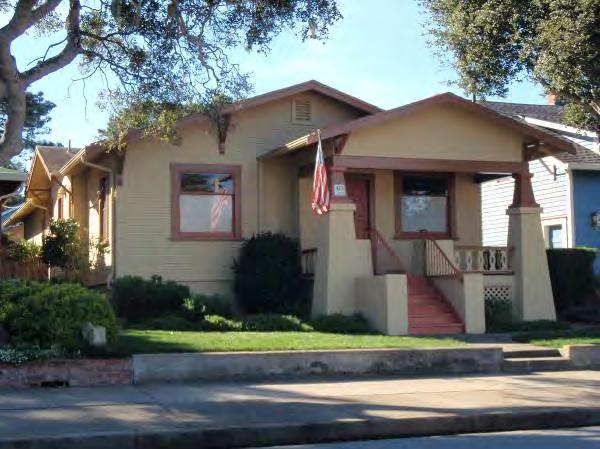


Simple rectangular massing
Front or side gable roofs with prominent knee braces and exposed rafter tails
Wood shingle, bevel, novelty or shiplap siding (sometimes in combination) are most common
Gable porches supported by “battered” columns which are wider at the base Windows with geometric division in the upper sash
Smooth river boulders as skirting, or at the base of chimneys (rare)
Historic Context Statement – Final City of Pacific Grove Historic Context (1903 – 1926) Pacific Grove, California Turnbull,
Elaborate Craftsman-style home of T.A. Work, 176 Central Avenue
Craftsman-style residence, 119 12th Street
Craftsman bungalow, with stucco plinths supporting battered porch columns, 419 Gibson
31 October 2011 Page &
Inc. 172
Three principal subtypes: Dutch Colonial gambrel roof designs; American FourSquare plans with hip roof and prominent entry porches; Side-gable roof forms with symmetrical facades
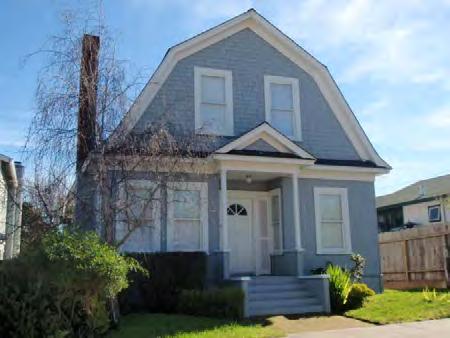
Entries often accented with a decorative crown supported by pilasters, or with a portico
Dormer windows
Frequently include Classical details, such as columns or pediments
Horizontal emphasis, often through the use of one story porches or wings Low-pitched roof with broad, overhanging eaves; roof edges may be flattened Horizontal banks of windows
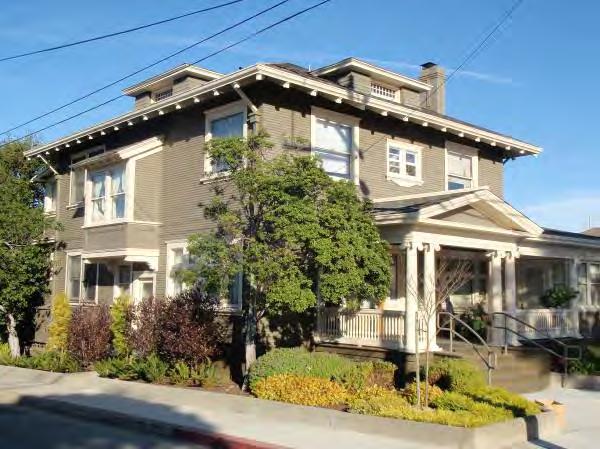
Side entries are not uncommon
City of Pacific Grove Context Pacific Grove, California Turnbull,
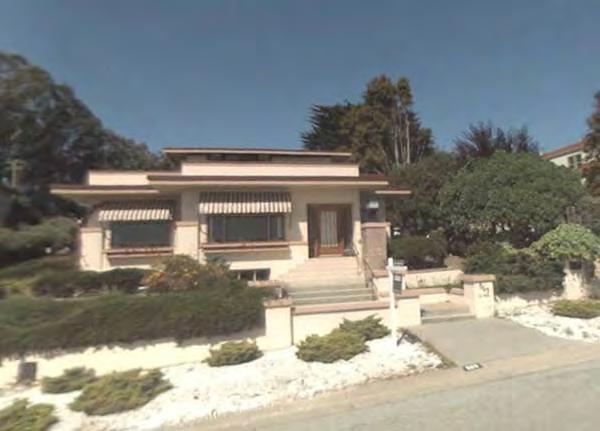 2. Colonial Revival Style (1905 - 1955)
Residence with American Foursquare form and both Craftsman- and Classical Revival-inspired details, 410 Central Avenue
Dutch Colonial Revival style residence, 609 19th Street
3. Prairie Style (1905 - 1925)
869 Del Monte Boulevard, built circa 1925 for Moralie E. Scholer (© Google 2011)
2. Colonial Revival Style (1905 - 1955)
Residence with American Foursquare form and both Craftsman- and Classical Revival-inspired details, 410 Central Avenue
Dutch Colonial Revival style residence, 609 19th Street
3. Prairie Style (1905 - 1925)
869 Del Monte Boulevard, built circa 1925 for Moralie E. Scholer (© Google 2011)
Historic Context Statement – Final
Historic
(1903 – 1926)
31 October 2011 Page &
Inc. 173
Wood shingle cladding, either entirely or as a prominent element
Wavy wall surfaces, particularly bulged “eyebrows” above windows
Steeply pitched rooflines, sometimes with gambrel or gable-on-hip configurations and flared eaves
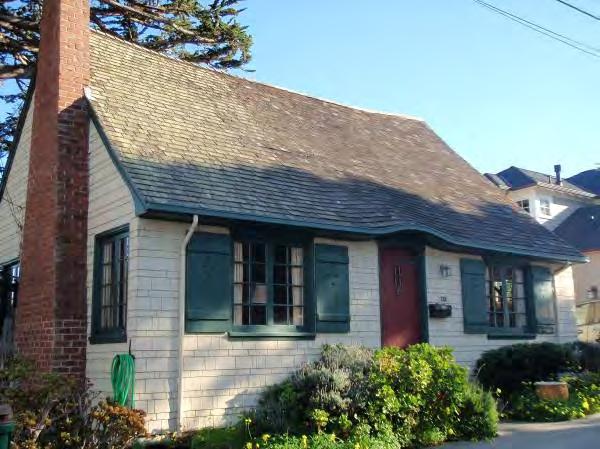
Frequently shed dormers on one or both sides of the roof peak
Simple bungalows forms with a hip roof are most common; often with dormer windows
Frequently have asymmetrical massing featuring angled or boxed bay windows
Wood beveled or channel drop cladding is most common Recessed porches are common.
City of Pacific Grove Context – Pacific Grove, California Turnbull,
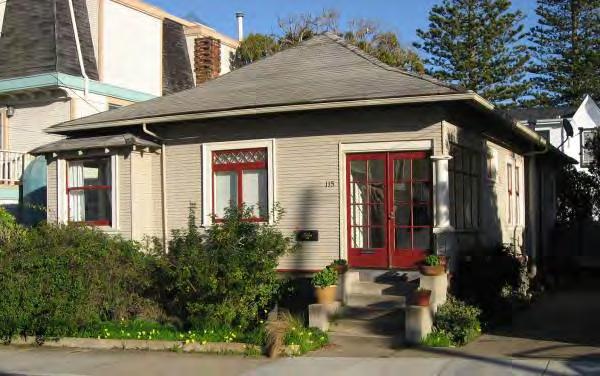
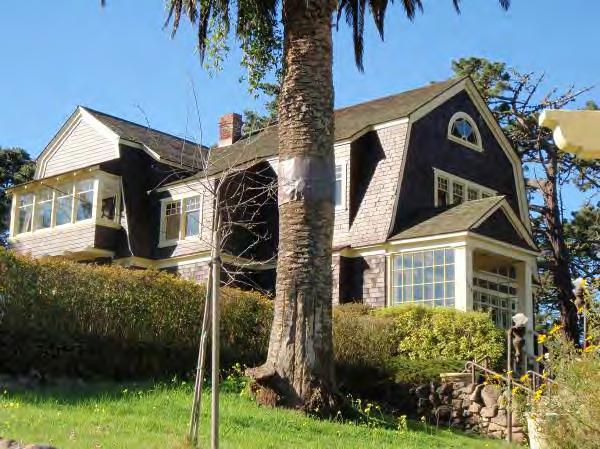 Historic Context
4. Shingle Style (1900 – 1915)
Shingle style residence at Hillcrest and Fountain
Shingled cottage with steeply pitched roof and “eyebrow” above door, 111 10th Street (ca. 1920)
5. Vernacular (1900 – 1930s)
Vernacular bungalow with hip roof, 115 17th Street (1905)
Historic Context
4. Shingle Style (1900 – 1915)
Shingle style residence at Hillcrest and Fountain
Shingled cottage with steeply pitched roof and “eyebrow” above door, 111 10th Street (ca. 1920)
5. Vernacular (1900 – 1930s)
Vernacular bungalow with hip roof, 115 17th Street (1905)
Statement – Final
Historic
(1903
1926)
31 October 2011 Page &
Inc. 174
5. Vernacular (1900 – 1930s), continued

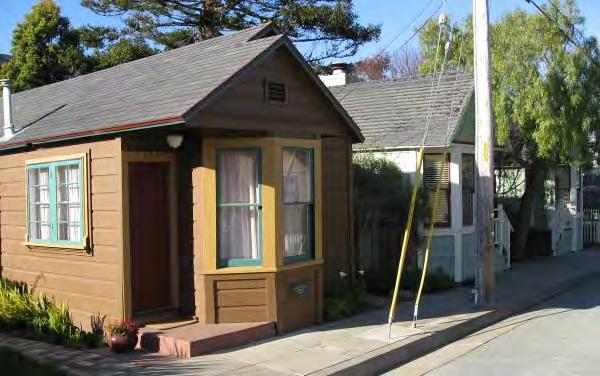
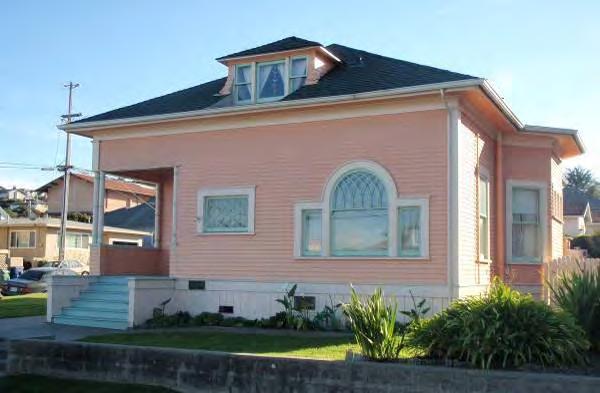 Rare example of turn-of-the-century bungalow with Classical Revival window details, 403 Central Avenue
Vernacular bay window cottages based on tent cottage precedents, 100 block of 16th Street (1905)
Unusual style beach cottages, 701 -705 Mermaid Avenue
Rare example of turn-of-the-century bungalow with Classical Revival window details, 403 Central Avenue
Vernacular bay window cottages based on tent cottage precedents, 100 block of 16th Street (1905)
Unusual style beach cottages, 701 -705 Mermaid Avenue
Historic Context Statement – Final City of Pacific Grove Historic Context (1903 – 1926) Pacific Grove, California 31 October 2011 Page & Turnbull, Inc. 175
City of Pacific Grove Historic – 1926) Pacific Grove, California
6. Spanish Colonial Revival Style (1920s – 1950s)
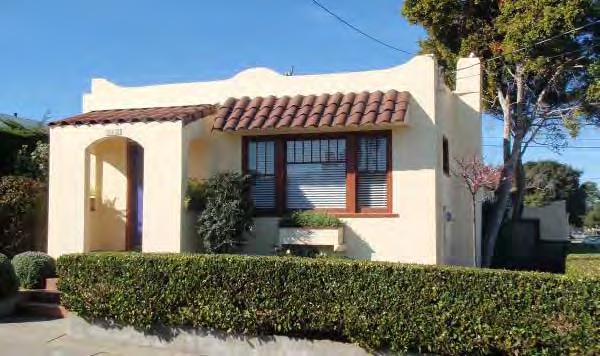
Rectangular or L-shaped massing is most common
Asymmetrical facades
Gable, or combination gable and flat roof (often with a shaped parapet for flat roofs)
Typically no roof overhang
Stucco cladding, either smooth or textured
Clay tile roofing; also clay tiles used as decorative accents
Arched openings
Stucco wing walls and courtyard enclosures
Metal balconettes beneath windows Clay pipe attic vents
Also includes related Pueblo Revival style buildings
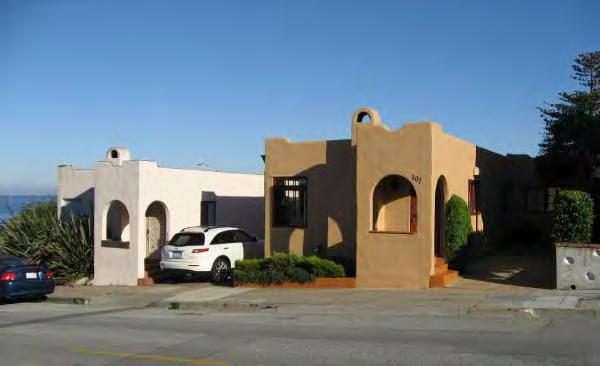 Typical Spanish Colonial Revival bungalow at 502 7th Street
Duplex with simplified Spanish Colonial Revival details, 313-315 1st Street
Pair of Pueblo Revival style residences, 105-107 Forest Avenue
Typical Spanish Colonial Revival bungalow at 502 7th Street
Duplex with simplified Spanish Colonial Revival details, 313-315 1st Street
Pair of Pueblo Revival style residences, 105-107 Forest Avenue
Historic Context Statement – Final
Context (1903
31 October 2011 Page & Turnbull, Inc. 176
Rectangular massing with asymmetrical facades
Steeply-pitched gable roofs, usually in combination of side and front-facing gables
Shallow eaves or eaveless
Stucco cladding, smooth or textured Arched entries, sometimes set within gabled porch elements
Rusticated masonry accents around doors and windows
Vertical attic vents in the gable end, sometimes with arched tops Exterior chimney, typically at the side
Significance
The table below discusses the significance of residential buildings from this era according to criteria established by the National Register of Historic Places, California Register of Historical Resources, and the Pacific Grove Municipal Code. It appears that many of the surviving residential buildings from this period are already listed on the City of Pacific Grove’s Historic Resources Inventory. California Municipal
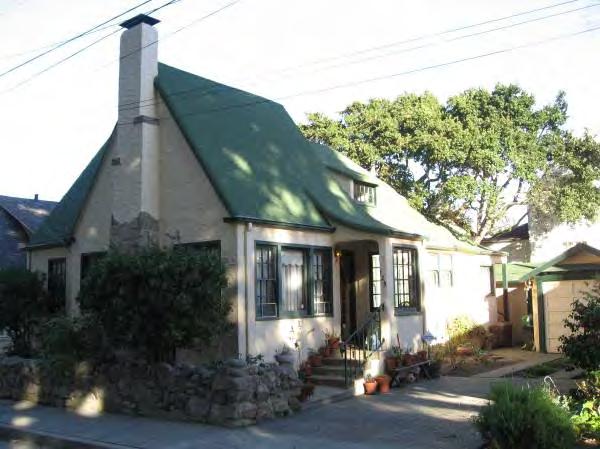
Significance Discussion A, B Events, Patterns & Trends
Residential buildings from this period may be significant for their association with the theme of residential development tied to a key period of city expansion. For example, residences in early twentieth century subdivisions such as the Hillcrest Tract or University Park may reflect the expansion of the city and the influence of the Pacific Improvement Company or Del Monte Properties.
Groups of residences may be better able to convey these patterns than individual structures; evaluators should consider the presence of historic districts that illustrate this criterion, though some properties may also qualify individually for their architectural merits or associations with prominent individuals (see below).
7. Tudor Revival Style (1920s – 1930s)
Tudor Revival style residence at 123 12th Street
Historic Context Statement – Final City of Pacific Grove Historic Context (1903 – 1926) Pacific Grove, California 31 October 2011 Page & Turnbull, Inc. 177
National/
Register PG
Code §23.76
A/1
City of Pacific Grove Historic Context – 1926) Pacific Grove, California
National/ California Register PG Municipal Code §23.76
Significance
Discussion
Residences from this period may also be associated with ethnic or cultural groups.
B/2 C Persons Residential buildings from this period may be significant for their association with persons important to Pacific Grove history. Large residences are more likely to be associated with significant persons, such as prominent merchants, artists, or city officials. If this is the case, however, the residence should be compared to other associated properties to identify which property(s) best represent that person’s achievements or reasons for being significant.
C/3 D, E, F, G, H, I, J, K Architecture/ Design New residential design trends were occurring during this period, and residential buildings from this period may therefore be significant for their architecture, as expressed by intact stylistic features, forms or construction methods. Buildings may also qualify as the work of a master architect or prominent builder, such as William Weeks, Julia Morgan, or the Chivers Brothers. Resources qualified under these criteria should be good examples of types and/or styles, and retain most of their original features. Simple bungalows and grander residences may both be significant under these criteria as examples of their respective typologies.
D/4 Information Potential Buildings, ruins or subsurface remains that have the potential to yield important information about construction methods and materials, or the evolution of local residential building development may be significant for their potential to provide information important to history. However, such examples would be extremely rare.
Integrity
In order to be eligible for listing in the local, state, or national historic registers, a residential property from the first decades of the twentieth century must retain sufficient integrity to convey its significance in association with residential development during this period. While most buildings undergo change over time, alterations should not significantly change the essential historic character
Historic Context Statement – Final
(1903
31 October 2011 Page & Turnbull, Inc. 178
Historic Context Statement – Final City of Pacific Grove Historic Context (1903 – 1926) Pacific Grove, California
of the buildings. The aspects of integrity deemed most important for this period are setting, design, materials, association and feeling.
Buildings from this era are much more common than those constructed during previous periods. They also have had less time to accumulate alterations. Thus, they require a somewhat higher overall standard of integrity versus previous periods. A property must retain most of the physical features that made up its historic character. Buildings would typically meet the threshold for addition to the local register if they meet the minimum eligibility requirements. Buildings qualified as individual resources at the state or national level should retain all or nearly all of their original features.
Minimum Eligibility Requirements:
Clear example of residential architecture from this period (simple bungalow or larger mansion)
Retains original form and roofline
Substantially retains the original pattern of window and doors
Retains some of its original ornamentation. (The retention of entry, window and/or roofline ornamentation should be considered most important)
Replacement of doors and windows is acceptable as long as they conform to the original door/window pattern and the size of the openings
Retention of the original cladding is important, but not absolute (see below)
Other Integrity Considerations:
It is apparent that houses continued to be moved during this period, and so integrity of location should not be considered a paramount concern.
It is generally acceptable for entry stairs and porch features to have been replaced, as these are subject to greater deterioration from weathering and use—particularly in a seaside setting. However, replacement porches should substantially conform to the original configuration. Incompatible porch replacement would likely jeopardize a residence’s eligibility for the National Register.
Rear additions that have respected the scale of the original building are generally acceptable. However, additions that compromise a building’s form and scale, are not acceptable.
The replacement of the original cladding—most frequently stucco or asbestos siding over wood—is generally a severe detriment to integrity. Typically, it is only acceptable as long as all of the remaining character-defining features are retained. The replacement of original cladding would also likely jeopardize a residence’s eligibility for the National Register.
The retention of original windows greatly enhances integrity of materials, and likewise enhances integrity of design and workmanship. However, it should be recognized that window replacement was common during the mid-20th century. Thus, the fact that a building does not retain its original windows should not—in and of itself—be viewed as an obstacle to historic registration. Far more important is that the building retain its original pattern of windows, and that the replacement windows are located within the original frame openings. The National Park Service notes that “a property that has lost some historic materials or
31 October 2011 Page & Turnbull, Inc. 179
City of Pacific Grove Historic Context (1903 – 1926) Pacific Grove, California
details can be eligible if it retains the majority of features that illustrate its style in terms of the massing, spatial relationships, proportion, pattern of windows and doors, texture of materials, and ornamentation.”405
A residence that was later altered into another style has lost association with this period, and may be considered to have association with the period during which it was altered—so long as it displays the character-defining features of the new style.
Many residences from the second half of this period—especially homes on larger lots— originally had associated automobile garages designed to coordinate with the architectural details of the main house. An early twentieth century Pacific Grove residence that retains its original garage would be considered to have especially high integrity. These outbuildings derive their significance from the significance of the residence, and are typically not eligible in their own right.
The presence of original site or landscape features is not essential, but could enhance a property’s significance and integrity. Properties that retain elements such as walls, fences, steps, paths, and heritage trees are likely to qualify for listing in the National Register.
Residences that have been converted to commercial use are still eligible for listing under all criteria as long as they retain their overall form and architectural character. While such buildings no longer retain their original use, they can still be fine examples of early twentieth century architectural styles and residential development patterns.
COMMERCIAL PROPERTIES
This was a key period of expansion of Pacific Grove’s central business district, which introduced new architectural styles, construction methods and materials. The greatest bursts of activity occurred at the beginning and ends of this period, particularly the developments of Thomas Work during the early 1900s, and the development of Holman’s Department store during the 1920s.
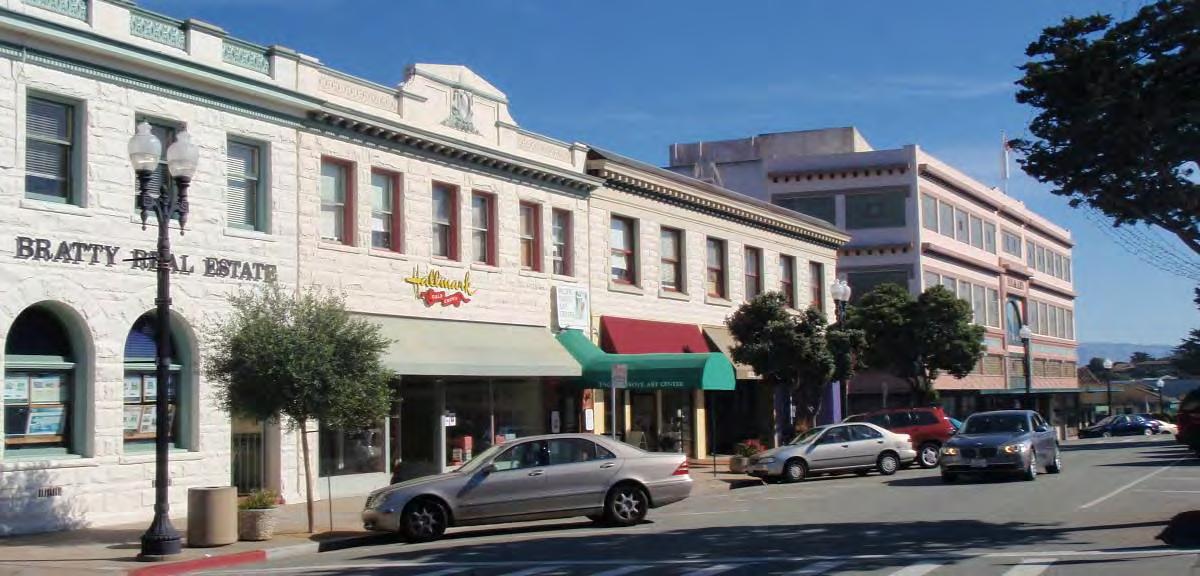 Twentieth century commercial development on Lighthouse Avenue, with the Bratty Building (1903), T.A. Work Block (1905) and Holman’s Department Store (1926)
Twentieth century commercial development on Lighthouse Avenue, with the Bratty Building (1903), T.A. Work Block (1905) and Holman’s Department Store (1926)
Historic Context Statement – Final
31 October 2011 Page & Turnbull, Inc. 180
Most buildings are one to two stories in height. Construction is typically wood, brick or reinforced concrete, which makes its first appearance during this era. Exterior finishes are brick or stucco. Roofs are generally flat, or incorporate a shallow gable concealed behind a parapet. Exterior finishes are typically stucco, although Thomas A. Work’ Bank of Pacific Grove was finished in sandstone, while the Work Block featured a veneer of cast concrete blocks meant to imitate stonework. Most of the buildings have been altered to varying degrees, but originally their storefronts would have included wood- or steel-framed window systems with plate glass windows. Wood doors, typically fully glazed, would have been most common.
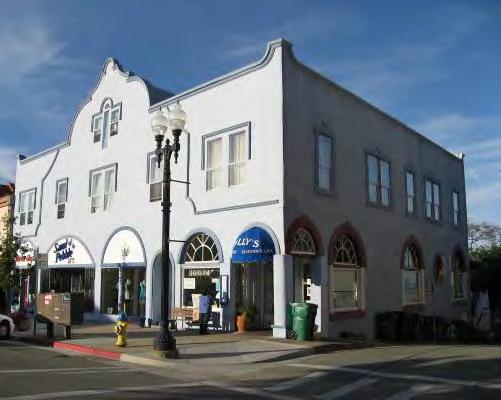
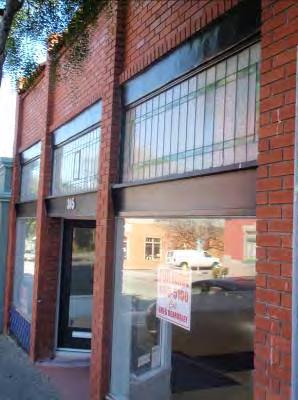
Stylistically, there is little cohesion between the new buildings, which range from simple Commercial style businesses, to buildings with Mission Revival, Romanesque Revival or Spanish Colonial Classical Revival influences. One unifying feature noted on two commercial buildings is distinctive leaded glass transom windows present at 305 Forest Avenue and 543 Lighthouse Avenue. This is also the first time that Pacific Grove’s commercial buildings show orientation towards the automobile, exemplified by the large reinforced concrete parking garages constructed behind the Work Block and Holman’s Department Store.
Nearly all surviving commercial buildings from this period are clustered along Forest, Fountain, Laurel and Lighthouse avenues in close proximity to Grand Avenue, following the development pattern set during the previous period. However, all of the most prominent commercial buildings of this period were focused on Lighthouse Avenue, demonstrating its arrival as the premier business address in the city.



Significance

The table below discusses the significance of commercial buildings from this era according to criteria established by the National Register of Historic Places, California Register of Historical Resources, and the Pacific Grove Municipal Code. It appears that most of these commercial buildings are already listed on the City of Pacific Grove’s Historic Resources Inventory.
 Left to right: Decorative leaded glass transoms at 305 Forest Avenue; Former Winston Hotel, modified for retail use, at 602-610 Lighthouse Avenue; Bank, 569-575 Lighthouse.
Left to right: Decorative leaded glass transoms at 305 Forest Avenue; Former Winston Hotel, modified for retail use, at 602-610 Lighthouse Avenue; Bank, 569-575 Lighthouse.
Historic Context Statement – Final City of Pacific Grove Historic Context (1903 – 1926) Pacific Grove, California 31 October 2011 Page & Turnbull, Inc. 181
National/ California Register PG Municipal Code §23.76
Significance
A/1 A, B Events, Patterns & Trends
Discussion
Commercial buildings from this period are significant for their associations with the theme of early twentieth century commercial development during a significant transitional period in Pacific Grove’s history. These buildings introduced new construction methods and materials, and set precedents that would guide commercial development through the middle of the century. They also include some of the largest and most impressive buildings ever constructed in the city, including Holman’s Department Store and the Forest Hill Hotel.
B/2 C Persons
Groups of intact commercial buildings would easily be qualified at the state or national levels as contributors to a historic district, although some would qualify individually for their architectural merits or associations with prominent individuals. Businesses owned by a member of an ethnic or cultural group may also represent the contributions of that group under this criterion.
Commercial buildings from this period may be significant for their association with persons important to Pacific Grove’s history, such as a prominent businessmen T.A. Work and Wilford Holman. If this is the case, however, the building should be compared to other associated properties to identify which property(s) best represent that person’s achievements or reasons for being significant. For commercial properties potentially eligible for the HRI, this criterion may also apply to businesses or organizations.
This period witnessed the introduction of new commercial designs and construction methods. Commercial buildings from this period are therefore likely to be significant for their architecture, as expressed by intact stylistic features, forms or construction methods. Buildings may also qualify as the work of a master architect or prominent builder.
C/3 D, E, F, G, H, I, J, K Architecture/ Design
Historic Context Statement – Final City of Pacific Grove Historic Context (1903 – 1926) Pacific Grove, California 31 October 2011 Page & Turnbull, Inc. 182
City of Pacific Grove Historic Pacific Grove, California
National/ California Register Municipal Code §23.76
Significance
Discussion
Individual resources qualified under these criteria should be good examples of types and/or styles, and retain most of their original features.
D/4 Information Potential Buildings, ruins or subsurface remains that have the potential to yield important information about construction methods and materials, or the evolution of local commercial building development may be significant for their potential to provide information important to history. However, such examples would be rare.
Integrity
In order to be eligible for listing in the local, state, or national historic registers, a commercial property must retain sufficient integrity to convey its significance as part of commercial development during this period. While most buildings undergo change over time, alterations should not significantly change the essential historic character of the buildings. As compared to residential development, commercial properties from this era are not common, and therefore consideration of a property’s relative rarity is warranted when considering integrity. Nevertheless, a commercial property must retain essential physical features that made up its historic character. The aspects of integrity deemed most important for this period are location, design, materials, association and feeling.
Buildings would typically meet the threshold for addition to the local register if they meet the minimum eligibility requirements. Buildings qualified as individual resources at the state or national level should retain a substantial majority of their original features. These include features such as clerestory windows, decorative trim, and prominent cornices or parapets. When assessing storefront alterations, particularly in multi-story commercial or mixed-use buildings, consider whether or not a storefront alteration is still subordinate to the overall character of the building.
Minimum Eligibility Requirements:
Clear example of commercial architecture from this period
Retains original form and roofline
Substantially retains the original pattern of window and doors. Storefront alterations, particularly in multi-story commercial buildings, can be acceptable (see integrity considerations below)
Retains at least some of its original ornamentation, if applicable. The retention of entry, window and/or roofline ornamentation should be considered most important.
Replacement of doors and windows may be acceptable as long as they conform, or substantially conform, to the original door/window pattern and the size of the openings
Historic Context Statement – Final
Context (1903 – 1926)
31 October 2011 Page & Turnbull, Inc. 183
PG
Other Integrity Considerations:
Commercial buildings from this period that retain their original storefront configurations are not common. In multi-story commercial buildings, ground floor alterations should be considered acceptable as long as they are subordinate to the overall character of the building. Similarly, storefront alterations that demonstrate evolving commercial design patterns associated with a subsequent historically significant context may be acceptable.
Rear additions that have respected the scale of the original building are generally acceptable. However, more recent additions, especially those that compromise a building’s form and scale, are not acceptable.
The replacement of the original cladding is only acceptable as long as enough characterdefining features are retained that the building can be clearly read as historic. In these instances, buildings should only be registered at the state or national levels as contributors to a district, rather than as individual resources.
AUTO CAMPS & COTTAGE COURTS
This period marked the emergence of auto camps and cottage courts as an increasingly important part of Pacific Grove’s tourist facilities. All were clustered toward the western end of the city in the Pacific Grove Acres subdivision, and typically included small wood frame vernacular structures featuring gable roofs and board and batten or wood shiplap siding. It does not appear that any buildings associated with auto camps of this period survive. The best candidates may be buildings surviving from the original Pine Grove Camp, although the lack of Sanborn maps for this area hampers definitive identification.
Should any auto camp buildings from this period be identified, they may be significant for their association with the nascent development of these facilities within the larger context of Pacific Grove’s tourist infrastructure. By necessity, many of these buildings would have been upgraded over time, but in order to qualify for historic designation they should retain most of the essential features that made up their historic character, namely the clustered configuration of cottages and other amenities.
CIVIC & PUBLIC ASSEMBLY PROPERTIES
Although civic development was a key facet of this period, the number of surviving buildings is actually quite small. These include the Pacific Grove Library and the Pine Street Grammar School (Robert Down School), as well as the Mayflower Church and the original building of the Bethlehem Evangelical Church. Several of the Julia Morgan-designed buildings at Asilomar may also be considered public assembly buildings, but these have already been declared a National Historic Landmark. While not strictly a civic facility, the Hopkins Marine Station Agassiz Laboratory is a significant institutional property founded during this period, and it shares many characteristics with the other properties in this category.
Historic Context Statement – Final City of Pacific Grove Historic Context (1903 – 1926) Pacific Grove, California 31 October 2011 Page & Turnbull, Inc. 184
These buildings are typically one to two stories in height, and most are of wood frame construction. The notable exceptions are the Pine Street Grammar School and Agassiz Laboratory, which were built using reinforced concrete. Exterior finishes may be brick, stucco or wood. Architecturally, there are few unifying elements connecting these buildings, other than the Spanish-influenced architecture of the Pacific Grove Library and the Pine Street Grammar School, both of which have stucco finishes. The Mayflower Church features strong Gothic Revival influences, while the Bethlehem Evangelical Church chapel was designed in the Craftsman style. These public assembly buildings are somewhat unified, however, by their location. Save for Asilomar, these buildings are all located in proximity to the downtown area, reflecting their status as important symbols of the city’s development.
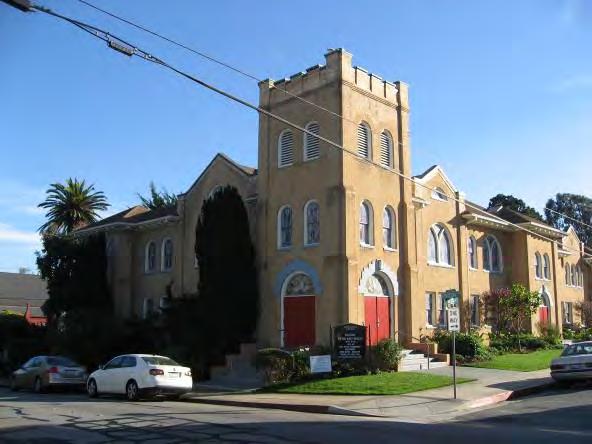
Significance
The table below discusses the significance of civic & public assembly buildings from this era according to criteria established by the National Register of Historic Places, California Register of Historical Resources, and the Pacific Grove Municipal Code. It appears that all of the surviving civic and public assembly buildings from this period are already listed on the City of Pacific Grove’s Historic Resources Inventory.
National/ California Register PG Municipal Code §23.76
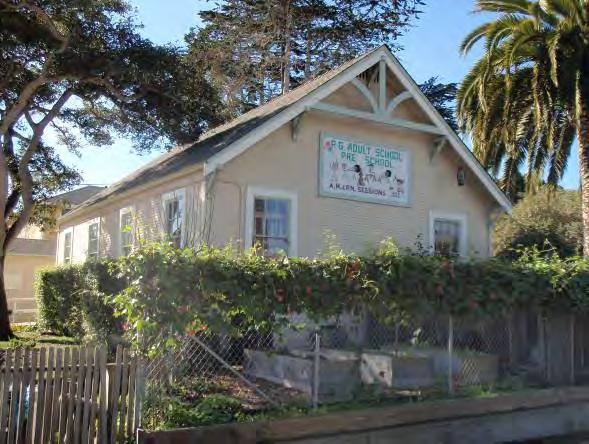
Significance
A/1 A, B Events, Patterns & Trends
Discussion
Civic & public assembly buildings from this period are significant for their associations with turn of the century civic and institutional development, which was a key historic theme of this period. Their significance is enhanced by their scarcity, as only five buildings of this type survive today. Civic & public assembly buildings
Left: Mayflower Congregational Church on 14th Street (1911). Right: Bethlehem Evangelical Church on Pine Street (1925), now the Pacific Grove Adult School Preschool.
Historic Context Statement – Final City of Pacific Grove Historic Context (1903 – 1926) Pacific Grove, California 31 October 2011 Page & Turnbull, Inc. 185
National/ California Register PG Municipal Code §23.76
Significance
Discussion
may also be associated with significant clubs, organizations, or ethnic groups under this criterion.
Please note that historic significance for a religious property cannot be established on the merits of a religious doctrine, but rather on secular terms for its architectural or artistic values or as a representation of important historic or cultural forces.
B/2 C Persons Civic & public assembly buildings from this period may be significant for their association with persons important to Pacific Grove’s history. If this is the case, however, the building should be compared to other associated properties to identify which property(s) best represent that person’s achievements or reasons for being significant.
C/3 D, E, F, G, H, I, J, K Architecture/ Design Civic & public assembly buildings from this period may be significant for their architecture. Buildings should demonstrate architectural merit in the form of intact stylistic features, forms or construction methods. Buildings may also qualify as the work of a master architect or prominent builder, such as William Weeks or Julia Morgan. Individual resources qualified under these criteria should be good examples of types and/or styles, and retain most of their original features.
D/4 Information Potential Buildings, ruins or subsurface remains that have the potential to yield important information about construction methods and materials, or the evolution of local building development may be significant for their potential to provide information important to history. However, such examples would be extremely rare.
As mentioned previously, if a church from this period is to be considered for listing in the National Register, it must also meet National Register Criteria Consideration A, which deals specifically with religious properties (see National Register Bulletin #15 – How to Apply the National Register Criteria For Evaluation). This information may also prove useful in evaluating the significance of a church for inclusion in the state or local register. Additionally, please note that under California Assembly Bill
Historic Context Statement – Final City of Pacific Grove Historic Context (1903 – 1926) Pacific Grove, California 31 October 2011 Page & Turnbull, Inc. 186
Historic Context Statement – Final City of Pacific Grove Historic Context (1903 – 1926) Pacific Grove, California
133, a religious property cannot be listed in the Pacific Grove HRI above the objection of the religious institution.
Integrity
In order to be eligible for listing in the local, state, or national historic registers, a civic & public assembly building must retain sufficient integrity to convey its significance as part of institutional development during this period. While most buildings undergo change over time, alterations should not significantly change the essential historic character of the buildings. Buildings would typically meet the threshold for addition to the local register if they meet the minimum eligibility requirements. Buildings qualified as individual resources at the state or national levels should retain a substantial majority of their original features. The aspects of integrity deemed most important for this period are location, design, materials, association and feeling.
Minimum Eligibility Requirements:
Clear example of civic and public assembly architecture of the period.
Retains original form and roofline
Substantially retains the original pattern of window and doors
Retains some of its original ornamentation. (The retention of entry, window and/or roofline ornamentation should be considered most important)
Replacement of doors and windows can be acceptable as long as they conform to the original door/window pattern and the size of the openings
Retention of the original cladding is crucial, but not absolute (see below)
Other Integrity Considerations:
Alterations that have included the use of conjectural decorative elements to create a false sense of history are not acceptable.
Additions that have respected the scale of the original building are generally acceptable.
The replacement of the original cladding is only acceptable as long as all or nearly all other character-defining features are retained. In these instances, buildings should only be registered at the state or national levels as contributors to a district, rather than as individual resources.
LIGHT INDUSTRIAL PROPERTIES
The overwhelming majority of surviving light industrial properties from this period are transportation related—primarily stables and automobile garages. This is indicative of the transition from horse to automobile travel during this period, especially in stables that were later converted to garages, such as Gardner’s Stables and the second incarnation of Mammoth Stables. Other light industrial buildings include scattered warehouses and supply facilities, as well as the boatyard at China Point.
31 October 2011 Page & Turnbull, Inc. 187
City of Pacific Grove Historic Context (1903 – 1926) Pacific Grove, California
Light industrial buildings of this period are overwhelmingly concentrated in the downtown area, where they are commonly sited directly adjacent to commercial facilities. In some cases, these buildings were developed in tandem with commercial properties, such as the parking garage for Holman’s Department Store. Another small grouping of industrial properties is located at the eastern edge of the city, including the Monterey Boatworks at China Point and the former garage used by the Thomas A. Work Lumber Yard.
Nearly all light industrial buildings from this period are one story height, and gable roofs are by far the most common. Prior to around 1915, most buildings are of wood frame construction, while reinforced concrete is more common afterward. A similar transition is evident in cladding, as earlier buildings typically feature wood or brick cladding, while later buildings typically have stucco finishes. As these buildings were purpose-built for specific activities, most feature utilitarian designs with minimal ornamentation. Most common is a flat-front design featuring a flat or stepped parapet to conceal the gable roof behind it.
These buildings typically featured at least one, if not several, large entrance bays to allow for the passage of vehicles and/or the loading of materials. Hinged or rolling wood doors would have been most common. Original windows would have typically incorporated wood sashes, although during the 1920s industrial steel sash windows became the norm. Most often, these steel windows feature awning or hopper mechanisms allowing the glass to swing outward. To maximize natural lighting, skylights are also common.

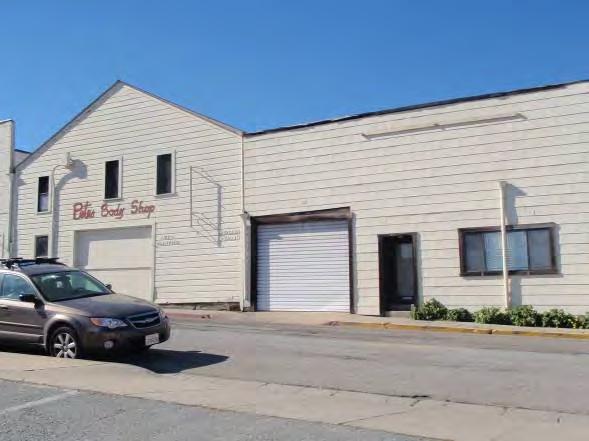
Significance
The table below discusses the significance of industrial buildings from this period according to criteria established by the National Register of Historic Places, California Register of Historical Resources, and the Pacific Grove Municipal Code.
Left: Former Gardner Stables/Pacific Grove Garage, 212-216 Fountain Avenue. Right: T.A. Work Garage, 174 Grand Avenue
Historic Context Statement – Final
31 October 2011 Page & Turnbull, Inc. 188
Historic Context Statement – Final
City of Pacific Grove Historic Context (1903 – 1926) Pacific Grove, California
National/ California Register PG Municipal Code §23.76
Significance
A/1 A, B Events, Patterns & Trends
Discussion
Industrial buildings from this period may be significant for their associations with industrial development during this period, particularly as it relates to themes including the advent of the private automobile. In some cases these buildings may also illustrate the transition from horse to motorized travel, as well as the development of garage facilities associated with commercial or larger industrial operations.
B/2 C Persons Industrial buildings from this period may be significant for their association with persons important to Pacific Grove’s history. If this is the case, however, the building should be compared to other associated properties to identify which property(s) best represent that person’s achievements or reasons for being significant.
C/3 D, E, F, G, H, I, J, K Architecture/ Design
Industrial buildings from this period may be significant for their architecture, as expressed by intact stylistic features, forms or construction methods. Buildings may also qualify as the work of a master architect or prominent builder. Individual resources qualified under these criteria should be good examples of types and/or styles, and retain most of their original features.
D/4 Information Potential Buildings, ruins or subsurface remains that have the potential to yield important information about construction methods and materials, or help demonstrate the evolution of local industrial development. However, such examples would be exceptionally rare.
Integrity
In order to be eligible for listing in the local, state, or national historic registers, an industrial property must retain sufficient integrity to convey its significance as part of development during this period. While most buildings undergo change over time, alterations should not significantly change their essential historic character. The aspects of integrity deemed most important for this period are location, design, materials, association and feeling.
31 October 2011 Page & Turnbull, Inc. 189
Buildings would typically meet the threshold for addition to the local register if they meet the minimum eligibility requirements. Buildings qualified as individual resources at the state or national level should retain a substantial majority of their original features.
Minimum Eligibility Requirements:
Clear example of industrial architecture from this period
Retains original form and roofline
Substantially retains the original pattern of window and doors
Replacement of doors and windows is acceptable as long as they conform, or substantially conform, to the original door/window pattern and the size of the openings
Retains original cladding (or the original cladding has been repaired/replaced in kind such that it substantially duplicates the original pattern)
CULTURAL LANDSCAPE ELEMENTS
Cultural landscapes from this period may include designed landscapes such as the Esplanade (1916), the Lighthouse Avenue median (1906), or other public parks. The development of Lovers Point as a tourist attraction also occurred during this period, and therefore the beach and its associated structures may significantly represent this trend.
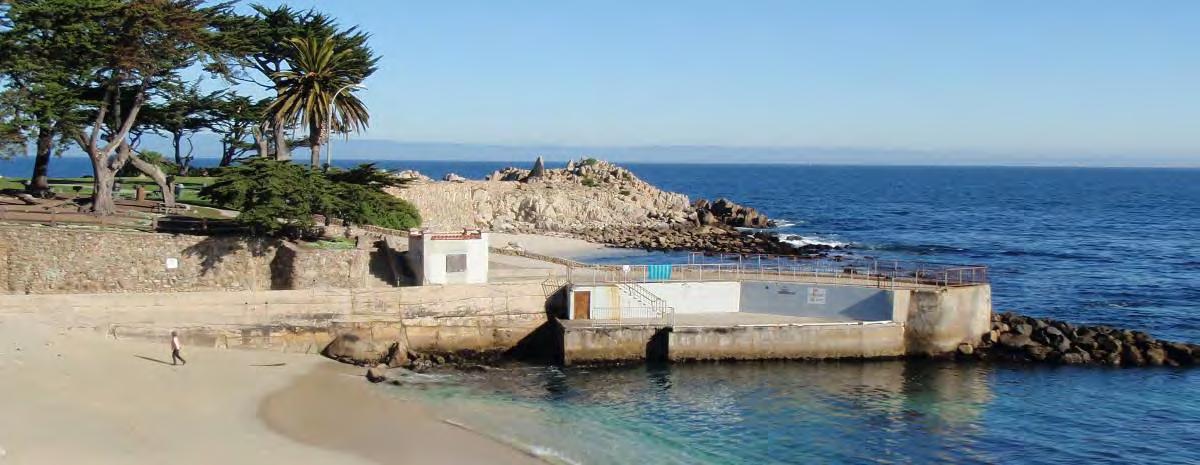
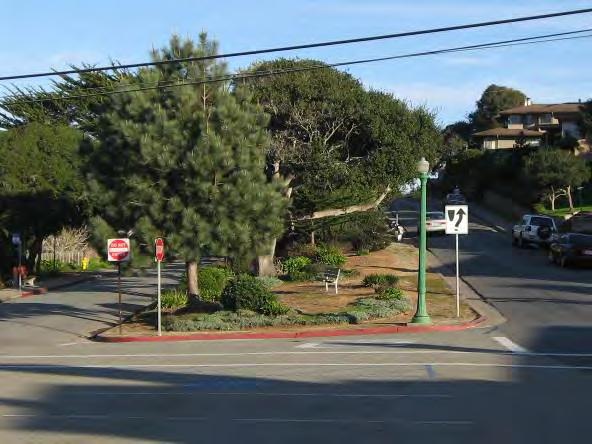
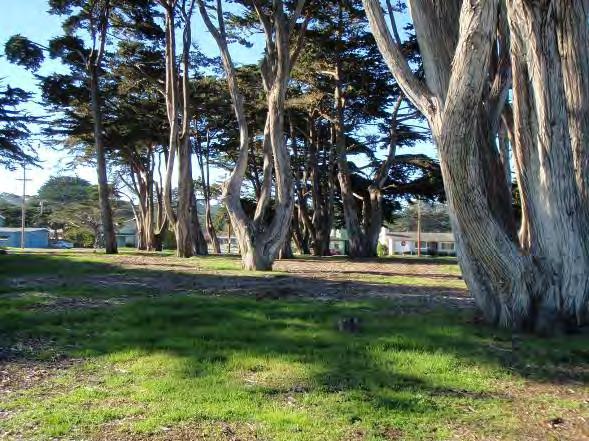 Top: Beach Tract Esplanade, Del Monte Boulevard (1916); Lighthouse Avenue Median (1906)
Bottom: Lovers Point beach and pier
Top: Beach Tract Esplanade, Del Monte Boulevard (1916); Lighthouse Avenue Median (1906)
Bottom: Lovers Point beach and pier
Historic Context Statement – Final City of Pacific Grove Historic Context (1903 – 1926) Pacific Grove, California 31 October 2011 Page & Turnbull, Inc. 190
Historic Context Statement – Final City of Pacific Grove Historic Context (1903 – 1926) Pacific Grove, California
Light standards from this period are still extant in some of Pacific Grove’s historic neighborhoods, such as those found along Forest Avenue in the Hillcrest Tract, and in the Spazier and Country Club Heights subdivisions. These items are not likely to be significant resources on their own, but may contribute to the overall character of a historic district. As mentioned previously, site features such as retaining walls, fences, and large specimen trees associated with a residence should be evaluated in conjunction with that residence. Similarly, landscaped or designed grounds of a church or other institutional facility (such as Asilomar) should be evaluated in conjunction with those properties.
Character-defining features that may collectively contribute to a cultural landscape from this period include:
Topography
Vegetation
Circulation (e.g. roads, paths, steps, and walls)
Site features and objects (e.g. fences, benches, lights, and sculptures)
Structures or buildings
Significance
The table below discusses the significance of cultural landscapes from this era according to criteria established by the National Register of Historic Places, California Register of Historical Resources, and the Pacific Grove Municipal Code. These properties do not appear to be listed in the City of Pacific Grove’s Historic Resources Inventory.
National/ California Register PG Municipal Code §23.76
Significance Discussion
A/1 A, B Events, Patterns & Trends
Cultural landscapes from this period may be significant as expressions of recreation and tourism during this period, or may illustrate important city-wide development trends. For example, the creation of a planted median enhanced Lighthouse Avenue’s position as the city’s main commercial corridor. Landscapes may have been the site of an important event, or reflect the influence of the Pacific Improvement Company or Del Monte Properties.
B/2 C Persons
Cultural landscapes from this period may be significant for their association with persons important to Pacific Grove history, such as “Bathhouse Smith” or other city officials. If this is the case, however, the site should be compared to other associated properties to identify which property(s) best represent that person’s achievements or reasons for being significant.
31 October 2011 Page & Turnbull, Inc. 191
Historic Context Statement – Final
City of Pacific Grove Historic Context (1903 – 1926) Pacific Grove, California
National/ California Register PG Municipal Code §23.76
Significance
Discussion
C/3 D, E, F, G, H, I, J, K Architecture/ Design Cultural landscapes from this period may be significant for their distinctive design values. In order to qualify under this criterion, the landscape must be purposefully designed, and must clearly express aesthetic principles or technological achievements in city planning, landscape architecture, engineering, or sculpture. For example, the Esplanade and surrounding streets in the Beach Tract were designed to utilize planning concepts from the City Beautiful movement. These properties may also be significant if they represent the work of a master landscape architect.
D/4 Information Potential Cultural landscapes from this period are not likely to yield important information not available in built resources or other extant documentary evidence.
Integrity
In order to be eligible for listing in the local, state, or national historic registers, a cultural landscape must retain sufficient integrity to convey its association with development tends during this period. Even more so than buildings, cultural landscapes—especially vegetation—are anticipated to experience change over time. An understanding of the landscape as a continuum through history is therefore critical in assessing its cultural and historic value, and a clear definition and understanding of the landscape’s period of significance is essential. In order for the landscape to have integrity, these character-defining features or qualities that contribute to its significance must be present. Landscapes qualified as individual resources at the local, state or national level should generally retain a majority of their original features. In some cases, changes subsequent to this period of development, such as later improvements to Lovers Point, may not be a detriment to the landscape’s integrity.
31 October 2011 Page & Turnbull, Inc. 192
Historic Context Statement – Final City of Pacific Grove Historic Context (1927 – 1945) Pacific Grove, California
E. City of Homes (1927 - 1945)
Promotional brochures from the 1920s and 1930s touted Pacific Grove as the “City of Homes,” emphasizing the city’s impressive residential architecture from previous periods. Although this period of development begins during the final years of the “Roaring Twenties,” the majority of the period is dominated by the impacts of the Great Depression, which simultaneously curbed private development while still allowing for several notable civic improvements. Some of the key events and historic themes of this period include the following:
Public ownership and management of the city’s key recreational facilities, including the beach facilities at Lovers Point, a new municipal golf course, and a new public auditorium.
The continued development of auto camps as a significant part of the city’s tourist infrastructure.
The impact of Depression-era work programs on the city, particularly the development or improvement of recreational facilities.
The protection of natural resources, including acquisition of the city’s coastline and the passing of the “butterfly ordinance.”
The influence of Cannery Row operations on Pacific Grove.
The impact of World War II on the city, including the internment of Japanese citizens.
Extant properties capable of representing these significant themes include residential properties, commercial properties, auto camps & cottage courts, civic & public assembly properties, industrial properties, and cultural landscape elements. The overwhelming majority of surviving buildings constructed between 1927 and 1945 are residential, primarily consisting of infill construction consistent with the town’s established character. Civic improvements were also a key facet of this period, and included four of the city’s most recognizable buildings: the Pacific Grove Museum, the Post Office, the Pacific Grove High School Auditorium (now the Pacific Grove Performing Arts Center), and the Loeb Laboratory at Hopkins Marine Station.
31 October 2011 Page & Turnbull, Inc. 193
Historic Context Statement – Final City of Pacific Grove Historic Context (1927 – 1945) Pacific Grove, California 31 October 2011 Page & Turnbull, Inc. 194 DAVID 17 MILE SINEX FOREST 9OCEANVIEW TH 16TH A S L O M A R LINE 117TH 9TH 7TH 18TH PICO CEDAR GIBSON 8TH IRVING PRESCOTT JEWELL 4TH PINE CONGRESS MASON OAK 6TH CENTRAL JUNIPERO LILY 11TH 12TH 10TH RECTRAIL WALNUT PARK FOUNTAIN CARMEL AGRAND LDER LAINE 5TH HWY68 3RD SU NSET WOOD HOFFMAN EARDLEY 2ND C R O C K E R 1ST 15TH GRO V E ACR E BELDEN 13TH SURF ARCHER LOCUST DELMONTE WILLOW M A J E L L A SPENCER BALBOA MILES BAYVIEW HIGH ALICE FOREST LODGE WITHERS SFBMORSE GRANITE CREST SHELL EGAN LINCOLN HILLCREST MONTEREY TERRY SKYLINE FUNSTON JESSIELOBOS CLAY CHESTNUT LOTTIE SPRUCE GRACE RIPPLE TAYLOR HARRISON PARCEL MAPLE FRANKLIN HELLAM VIA DELREY LYNDON FILMORE A R M Y SEAVIEW CYPRESS ROOSEVELT EVANS PR IVAT E B OL IO MORSE MERMAID NEWTON SYIDA BENITO SLOAT MELROSE LAWTON DRAKE SEAPALM SHAFTER PR ES DIO JOHNSON RA NS FO RD PACIFIC DENNETT CORAL HAWTHORNE MONTECITO ORTEGA RIDGE SHORT FOAM MCCLELLAN 14TH DEVISADERO JEFFERSON S T I L L W E LL FITCH AUSTIN STUART ARENA ORD RIFLE RANGE MADISON BEAUMONT SP RAY MACARTHUR CRAMDEN SERRA DEWEY HE RR MA NN R A I LR O A D R I G H T O F W AY RICKETTS ROW E V E R G R E E N SIREN DRYCREEK LEWIS GROVE HILLSIDE LIGHTHOUSE SPAZIER CPL EVANS TIMBER BWAINWRIGHT ISHOP BE NTLEY PATTERSON CHAPARRAL BEACON RACCOON RUTH ACACIA GATE LAUREL 20TH OLMSTEAD PINE HILL BRIGGS A C R O P O L S CABRILLO SGTFRONIUS BOWEN ROSEMONT PLUM ME R MARINO PINES COLTON CALEDONIA SAGE PIEDMONT FINFANTRY OREST HILL CPL EVANS EL C AL LE JO NE GLENLAKE V A D EL P I NA R KIT CA RS ON HACHIYA TR EASURE MONARCH KENET PAR AD ISE PAR K DAY SPANISH BAY PETRA TANGLEWOOD PAC I F C G R OV E UNION TODD AIR OFORCE TTER MORELAND ADOBE CLARK CAFFREY GARDEN WALCOTT L A U RI E ACORN LA SELVA CH UA LA R AVALON LORELEI NAVAJO FOREST PARK MARINE MOSS 19TH H E R R M A N N PINE PINE CYPRESS 13TH SUNSET MC CL EL LA N PRESIDIO PIEDMONT CROCKER JEWELL RANSFO RD PRESIDIO 14TH 14TH LIGHTHOUSE 2ND 2ND LAUREL PARK LOBOS NEWTON LAWTON RANSFORD LIGHTHOUSE OAK SHELL SHORT SPRUCE SLOAT FITCH CONGRESS CityofPacificGrove YearBuilt:1927-1945 1927-1929 1930-1939 1940-1945 Page&Turnbull,Inc./24June2011 ° Properties constructed during “City of Homes” period (1927-1945) (Page & Turnbull)
Historic Context Statement – Final City of Pacific Grove Historic Context (1927 – 1945) Pacific Grove, California 31 October 2011 Page & Turnbull, Inc. 195 DAVID 17 MILE SINEX FOREST 9OCEANVIEW TH 16TH A S L O M A R LINE 117TH 9TH 7TH 18TH PICO CEDAR GIBSON 8TH IRVING JEWELL PRESCOTT 4TH PINE CONGRESS MASON OAK 6TH CENTRAL JUNIPERO LILY 11TH 12TH 10TH RECTRAIL WALNUT PARK FOUNTAIN CARMEL AGRAND LDER LAINE 5TH HWY68 3RD SU NSET WOOD HOFFMAN EARDLEY 2ND C R O C K E R 1ST 15TH G RO V E ACR E 13TH BELDEN SURF ARCHER LOCUST DELMONTE WILLOW M A J E L L A SPENCER BALBOA MILES BAYVIEW HIGH ALICE FOREST LODGE WITHERS SFBMORSE GRANITE CREST SHELL EGAN LINCOLN HILLCREST MONTEREY TERRY SKYLINE FUNSTON JESSIELOBOS CHESTNUT LOTTIE SPRUCE CLAY GRACE RIPPLE TAYLOR HARRISON PARCEL MAPLE FRANKLIN HELLAM VIA DELREY LYNDON FILMORE A R M Y SEAVIEW CYPRESS ROOSEVELT EVANS PR IVAT E B OL IO MORSE MERMAID NEWTON SYIDA BENITO SLOAT MELROSE LAWTON DRAKE SEAPALM SHAFTER PR ESIDIO JOHNSON RA NS FO RD PACIFIC DENNETT CORAL HAWTHORNE MONTECITO RIDGE ORTEGA SHORT MCCLELLAN 14TH FOAM DEVISADERO JEFFERSON S T L L W E LL FITCH AUSTIN STUART ARENA ORD RIFLE RANGE BEAUMONT MADISON SP RAY MACARTHUR CRAMDEN SERRA DEWEY HE RR MA NN R A I LR O A D R G H T O F W AY RICKETTS ROW E V E R G R E E N SIREN DRYCREEK LEWIS GROVE HILLSIDE LIGHTHOUSE SPAZIER TIMBER CPL EVANS BWAINWRIGHT ISHOP BE NTLEY PATTERSON CHAPARRAL BEACON RACCOON RUTH ACACIA GATE LAUREL 20TH OLMSTEAD PINE HILL BRIGGS A C R O P O L S CABRILLO SGTFRONIUS BOWEN ROSEMONT MARINO PINES PLUM ME R CALEDONIA SAGE PIEDMONT FOREST HILL CPL EVANS EL C AL LE JO NE INFANTRY GLENLAKE V A D EL P I NA R KIT CA RS ON HACHIYA TR EASURE MONARCH KENET PAR AD IS E PAR K DAY SPANISH BAY PETRA TANGLEWOOD PAC I F C G R OV E UNION TODD AIR OFORCE TTER MORELAND ADOBE CLARK CAFFREY GARDEN WALCOTT L A U RI E ACORN LASELVA CH UA LA R AVALON LORELEI NAVAJO FOREST PARK MARINE MOSS 19TH H E R R M A N N PINE PINE CYPRESS 13TH SUNSET MC CL EL LA N PRESIDIO PIEDMONT CROCKER JEWELL RANSFO RD PRESIDIO 14TH 14TH LIGHTHOUSE 2ND 2ND LAUREL PARK LOBOS NEWTON LAWTON RANSFORD LIGHTHOUSE OAK SHELL SHORT SPRUCE SLOAT FITCH CONGRESS CityofPacificGrove Subdivisions&Annexations (1927-1945) Page&Turnbull,Inc./24June2011 ° ONT S Spazier’sAddition (1931) ORSELMSTEAD CountryClubHeights (1930s) FairwayHomes (1932) ESS OBOSOTTIE AY EVIS OceanViewTerrace (1940s) ON ERO S SeaViewTerrace (1940s) IORD SHO G T TP PresidioTerrace (1940s) Subdivisions and additions platted during “City of Homes” period (1927-1945) (Page & Turnbull)
Historic Context Statement – Final City of Pacific Grove Historic Context (1927 – 1945) Pacific Grove, California
PUBLIC OWNERSHIP OF THE WATERFRONT
Following the 1919 reorganization of the PIC as Del Monte Properties, the company worked to divest itself of its holdings in Pacific Grove and concentrate on the development of Pebble Beach. As part of this effort, the company began to entertain the possibility of selling all of its coastal waterfront property between Hopkins Marine Station and the Point Pinos Lighthouse to the city. Up until this time, only a “gentleman’s agreement” was in place, with the company promising that it would not allow any canneries in the city or erect buildings that obstructed coastal views.406 Much like the previous investments that the PIC had made in the city, the sale of the waterfront land by Del Monte Properties was governed both by economics and altruism. The company would ensure that portions of the 17 Mile Drive would remain a scenic gateway to Pebble Beach, and the value of its remaining holdings in Pacific Grove would likewise benefit. It would also engender a great deal of public goodwill. Samuel F. B. Morse said of the sale:
We determined that it was in the best interest (of Pacific Grove) … That the city own its own waterfront and that this waterfront be forever restricted against building or use other than what would be desirable to the citizens of Pacific Grove. This resulted in the sale of the waterfront at a nominal figure.”407
The prospect of the sale was met with eagerness by City Council member Charles K. Tuttle, who was alarmed by the prospect of development that might block coastal access. It was said that, “During a trip along the southern California coastline a number of years ago, C. K. Tuttle … perceived the all too frequent ‘Keep Out’ signs along the beaches. It irked him to find access to the ocean denied so many by the huge blocks of privately-owned waterfront property.” 408
In 1925 Councilman Tuttle made a motion to acquire the waterfront land through a lease-purchase arrangement, with the total cost not to exceed $12,000. After a series of negotiations, Del Monte Properties finally agreed to sell all of the land to the city for $6,000, and the sale was concluded in 1927.409 The city subsequently consolidated its hold on the waterfront through California Senate Bill Number 306, passed in 1931. This legislation granted Pacific Grove title to its waterfront to a depth of 60 feet, with the state ceding its title to the same area. The following year, the City Council adopted an ordinance establishing the area as a “Refuge and Marine Gardens” with a $300 fine or 30 days in jail for anyone caught taking any invertebrate animal life or marine plant life, except by hook and line.410
The forces that led the city to acquire its submerged lands—a unique arrangement in California—are not entirely clear. Certainly the “Marine Gardens” were a highlight of the glass bottom boat operations at Lovers Point. But there are also some indications that the legislation was geared toward curbing the abalone diving operations of Japanese fishermen. The fact that the bill passed the California legislature also suggests considerable political influence, which may have come through channels associated with Stanford University and Timothy Hopkins. A writer of the 1930s described the protected area as the “Hopkins Marine Life Refuge” which encompassed a “two-mile stretch of municipal beach water extending a thousand feet into the bay … persons not connected
31 October 2011 Page & Turnbull, Inc. 196
Historic Context Statement – Final City of Pacific Grove Historic Context (1927 – 1945) Pacific Grove, California
with the Marine Station or the university are prohibited by local ordinance from catching or collecting any marine life in this protected area.”411
DEPRESSION-ERA CIVIC PROJECTS
The Great Depression of the 1930s was a time of immense hardship for many Americans. To curb widespread unemployment, agencies such as the California State Emergency Relief Administration, as well as federal agencies such as the Civilian Conservation Corps (CCC) and the Works Progress Administration (WPA), were created to provide funding for a variety of work programs. The City of Pacific Grove also undertook a series of projects that, combined with state and federal aid, led to a number of civic improvements—particularly in the form of recreational facilities. Consequently, civic buildings and cultural landscapes from this period may be significant as representations of the Great Depression and associated federal work programs in Pacific Grove.
The impact of the financial crisis took several years to be fully realized in Pacific Grove. In fact, the city entered the 1930s with a considerable amount of optimism and economic momentum. Only a few years earlier, the city had witnessed the construction of two of the largest buildings in its history, and the city’s primarily middle-class demographics insulated it from hardships associated with industrial unemployment. Pacific Grove’s city government was also reorganizing itself at this time, producing some of the city’s first planning documents to deal with expected growth.
In 1927, the City began administration under a city-manager form of government, and by 1929 the City Council had created a Planning Commission.412 Its duties at the time were primarily in the field of zoning administration, but it also spent three years creating a traffic and master plan for the city.413 In part this was driven by the sale of the Del Monte Properties waterfront holdings to the city, as well an additional donation of land by the company for a municipal golf course.
Pacific Grove Golf Links
The land for the golf course was comprised of the old Bodfish Dairy site, which occupied a wedgeshaped area stretching westward from the intersection of 19th Street and Jewell Avenue out past Del Monte Avenue. In donating the land, Samuel F. B. Morse of Del Monte Properties likely felt that the new golf course would increase interest in the company’s Beach Tract subdivision, as well as the company’s new “Fairway Homes” subdivision (see the Residential Development section for more information). In 1931, a municipal bond was passed to provide materials for the new nine-hole golf course, which was designed by Jack Beaumont, namesake of Beaumont Avenue. The Pacific Grove Golf Links opened in 1932 with the first ball hit by Mayor Julia Platt.414 The election of a woman as mayor was unusual in California during this period, but it may be explained in part by the large number of widows who retired to Pacific Grove, as well as the long history of women’s organizations in the city.
31 October 2011 Page & Turnbull, Inc. 197
Pacific Grove High School Auditorium
At the same time the city was constructing the golf course, workers were also completing a large new Auditorium for the Pacific Grove High School. The building was designed in the Mediterranean Revival style by William Weeks, who had also designed the main school building in 1911. The new auditorium was the largest public venue yet constructed in the city, succeeding the Methodist Assembly Hall as the centerpiece of the city’s arts and music programs. The Auditorium could seat over 1,000 people, and was used by a variety of local organizations—including Pacific Grove’s summer music program, which continued to be popular. Most recently, the Auditorium was renovated as a community performing arts center.415

Acquisition and Redevelopment of Lovers Point
When Del Monte Properties sold its waterfront land to the city, the only area that had been exempted—other than the Hopkins Marine Station—was the commercial beach area at Lovers Point. Within a few years, however, momentum would build for the city to acquire this area as well.
Since 1917, the Lovers Point Bathhouse and beach area had been controlled by the McDougall family of Salinas, with ownership passing in 1923 to Mrs. Mattie L. McDougall after the death of her husband James.416 The beach concessions remained popular throughout the 1920s, but time and weathering eventually took their toll on the buildings, and by 1931 the city condemned the bathhouse as unsafe. In retaliation, Mattie McDougall fenced off the area, which denied public
Pacific Grove Golf Links, ca. 1934 (Pat Hathaway Collection, reproduced in Images of America: Pacific Grove, p. 103)
Historic Context Statement – Final City of Pacific Grove Historic Context (1927 – 1945) Pacific Grove, California 31 October 2011 Page & Turnbull, Inc. 198
Historic Context Statement – Final
City of Pacific Grove Historic Context (1927 – 1945) Pacific Grove, California
access to the beach. This drew the ire of Pacific Grove’s mayor, Dr. Julia B. Platt, who had been active in civic organizations since the turn of the century. Platt contended that the original deed issued by the PIC guaranteed public access to the beach, and in December 1931 used an axe to chop down a portion of the fence—much as Judge Langford had opened the old Retreat wagon gate in the 1880s.417 Platt stated at the time that, “Pacific Grove men were too timid to chop down the gate.”418
McDougall continued to erect barriers to the beach, which were repeatedly destroyed by Platt. By 1932, McDougall had filed a restraining order against Julia Platt, contending that she had on several occasions “used axes, saws, sledge hammers and files” to clear the entrance.419 The feud was subsequently resolved through the work of the next mayor, Sheldon Gilmer, who convinced McDougall to lease the property to the city with an option to purchase. Gilmer then supported a bond measure to acquire the Lovers Point property and construct a new municipal swimming pool to replace the bath house. A $60,000 bond measure was approved in May 1934, with $50,000 paid for the land and $10,000 earmarked for the new swimming pool. That same year, the City Council Bath House Advisory Committee also recommended that the old dance hall and McDougall house at Lovers Point be demolished.420
By this time the Monterey region was experiencing the full impact of the Great Depression, and both the Pacific Grove and Monterey Chambers of Commerce had begun issuing “trade warrants” in one and fifty-cent denominations in order to fund work and keep people employed.421 Pacific Grove’s ambitions to redevelop the Bath House were also hampered by increasing costs, and so it looked to the state and federal government for assistance. Ultimately, the redevelopment of the
 Dr. Julia B. Platt opens the gate to the bathhouse, 1931. (Heritage Society of Pacific Grove, reproduced in Images of America: Pacific Grove, p. 115)
Dr. Julia B. Platt opens the gate to the bathhouse, 1931. (Heritage Society of Pacific Grove, reproduced in Images of America: Pacific Grove, p. 115)
31 October 2011 Page & Turnbull, Inc. 199
City of Pacific Grove Context (1927 – 1945) Pacific Grove, California
property became a $45,000 State Emergency Relief Administration project, with the city contributing $20,000 and the government providing the rest in labor.422
The old bath house was demolished and a new outdoor salt water pool called “The Plunge” was opened in 1935 as part of the Feast of Lanterns celebrations.423 This work also included the construction of a boiler room to heat the pool, was well as new dressing rooms which replaced the old dance hall and boxball alley.424 Around the same time, Nathaniel Sprague constructed a small concrete office building on the concrete pier where tickets were sold for the glass bottom boat rides (extant).425 More beach beautification projects funded by the WPA followed, including construction of the rock wall terracing and stairways leading down from the pool to the beach, as well as barbecue and picnic areas. By 1939 most of these projects had been completed, although a newspaper article of that year mentions that dressing rooms for bathers had yet to be completed.426
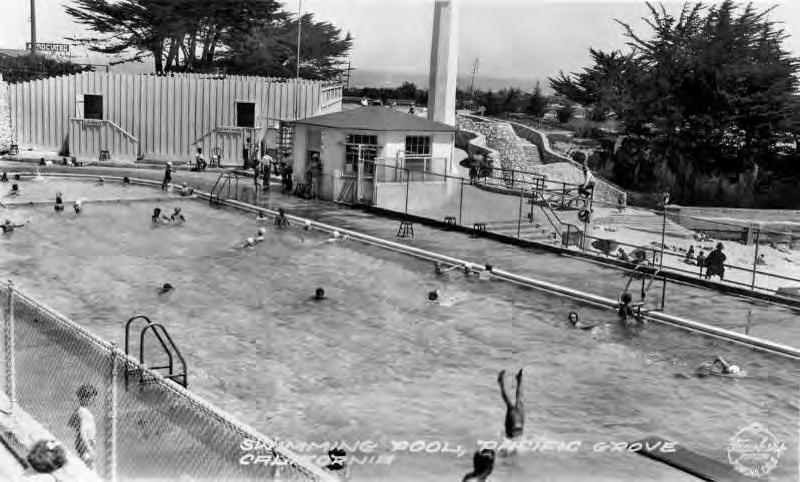
Municipal Ballpark
The WPA and Civilian Conservation Corps were also instrumental in helping to complete other recreation-related projects in Pacific Grove, including the construction of a new municipal baseball park. In 1932, the city inaugurated a recreation program which included men’s and boy’s baseball leagues. About the same time, the city traded land with Del Monte Properties and acquired a site for a new ballpark located at 17 Mile Drive and Short Street in a “pine-sheltered amphitheater formed by the Del Monte Properties’ old abandoned quarries.”427 At the time, the site was described as
Swimming Pool at Lovers Point, 1940 (Pomona Public Library)
Historic Context Statement – Final
Historic
31 October 2011 Page & Turnbull, Inc. 200
Historic Context Statement – Final
City of Pacific Grove Historic Context (1927 – 1945) Pacific Grove, California
“little more than a swamp,” and soon CCC crews were at work improving the area’s drainage and constructing the baseball diamond and bleachers, which were completed in 1933.428
Nearby, the old Del Monte Military Academy was converted into a CCC camp, and then used as a camp school for the State Emergency Relief Administration, which housed single women who sewed uniforms for CCC employees working in Carmel Valley. Federal funding was also used to rebuild the Boy and Girl Scout Homes (presumably clubhouses) and improve the golf course.429 The impact of these relief programs was so significant that in 1938, Pacific Grove’s City Manager stated that less than half of the civic projects undertaken in the last five years could have been completed using only city funds. The most important projects were listed as drainage facility work, the beach improvements, and construction of the salt-water pool.430 By 1941, the city counted fourteen parks, as well as the golf course, baseball park, and a roque court (a type of croquet court) which had stood in Jewell Park since the turn of the century.
Pacific Grove Museum
Some fifty years after its founding, a new Pacific Grove Museum was constructed in 1932 on the same lot the museum had occupied since the 1890s. Unlike most of the civic projects of the 1930s, construction of the museum was not funded by federal works programs, but rather was the gift of Pacific Grove resident, Mrs. Lucie A. Chase—with the opening ceremony held on her ninetieth birthday. The new museum was designed in the Spanish Colonial Revival style and was reported to have cost $40,000. It originally consisted only of the wing located on the western half of the lot; the eastern portion was then occupied by the Women’s Civic Improvement Club, which Mrs. Chase had also helped found. In 1935 the American Association of Museums named the museum as one of the best of its size in the United States, and in keeping with its Chautauquan roots, the building continues to house important natural history collections. The present eastern annex of the museum was constructed in 1985. Of interest, Chase had once owned the Page Cottage at 550 Ocean View Boulevard, which she and her husband expanded into what is today the Seven Gables Inn.431 In 1925, Chase also constructed the Prairie-style residence located at 1051 Ocean View Boulevard.432
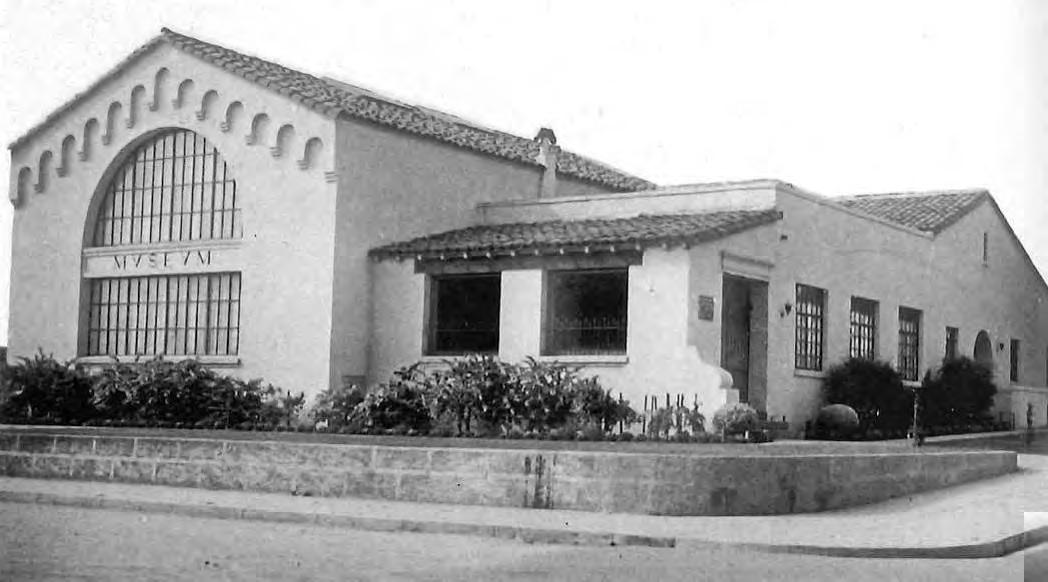 Pacific Grove Museum of Natural History, circa 1935 (Photo by Beauford Fisher; courtesy Phyllis Fisher Neel, reproduced in Images of America: Pacific Grove, p. 112)
Pacific Grove Museum of Natural History, circa 1935 (Photo by Beauford Fisher; courtesy Phyllis Fisher Neel, reproduced in Images of America: Pacific Grove, p. 112)
31 October 2011 Page & Turnbull, Inc. 201
City of Pacific Grove Historic Context (1927 – 1945) Pacific Grove, California
A New Post Office
Although America was beginning to pull out of the Great Depression by the late 1930s, WPA funding was also responsible for the construction of a new U.S. post office at 680 Lighthouse Avenue in 1938. Designed by architect Louis A Simon and constructed at a cost of $55,000, its opening was attended by over 1,000 residents.433 As with the Pacific Grove High School Auditorium and the Pacific Grove Museum, the building was designed in the Spanish Colonial Revival style, which proved to be the most popular style for both civic and commercial buildings constructed during this period in Pacific Grove.
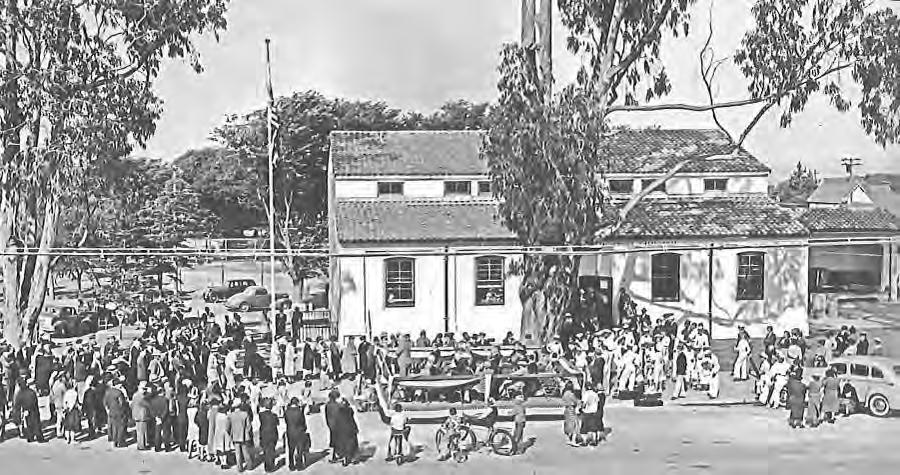
In 1939, Russian-born artist, Victor Arnautoff, painted a mural of scene at the Lover’ Point beach on the interior, which survives today.434 Arnautoff had trained for a time with the prominent artist, Diego Rivera, and was then serving on the faculty of the California School of Fine Arts. His work in Pacific Grove was carefully supervised, as several years earlier his mural, “Metropolitan Life,” painted in San Francisco’s Coit Tower, was viewed to be tinged with Communist references.435
Another WPA mural was also commissioned for the Pacific Grove High School, completed by Gus Gray and the noted writer and artist, Bruce Ariss Jr. (1911 – 1994). This work, however, was subsequently destroyed by a fire.
Dedication of the new post office, 8 October 1938 (Pat Hathaway Collection, reproduced in Images of America: Pacific Grove, p. 114)
Historic Context Statement – Final
31 October 2011 Page & Turnbull, Inc. 202
City of Pacific Grove Historic Context (1927 – 1945) Grove, California

Chamber of Commerce

In 1938, a new building was constructed for the Chamber of Commerce at 584 Central Avenue.436 This was a modest hip-roofed building, but apparently an improvement over its former building, which was originally constructed as a bandstand for the El Carmelo Hotel and had been located across the street in Jewell Park. The building continues to be occupied by the Pacific Grove Chamber of Commerce today.

Loeb Laboratory
In 1928, the two-story reinforced concrete Loeb Laboratory was constructed as part of the Hopkins Marine Station at China Point. Named for biologist Jacques Loeb, the building was designed in a U shape, with one-story flat-roofed wings flanking a two-story hip-roofed section at center. The wings were largely utilitarian in design, while the central section showed Spanish architectural influences, including a red clay tile roof. Sanborn maps indicate that a small auxiliary building featuring a heating plant and carpenter’s shop was also built a short distance away to the northeast.
Fraternal Organizations
Fraternal organizations continued to be popular in Pacific Grove during this period, but the only new development associated with such organizations appears to have been the construction of a new two-story Odd Fellows Hall and classroom building at 225 Laurel Avenue circa 1940 (extant). The building is largely utilitarian in design, featuring a hip roof and stucco cladding. Sanborn maps indicate the hall was occupied by the Odd Fellows through at least 1962, although today it is used as the Blind and Visually Impaired Center of the Monterey Peninsula.
The Butterfly Ordinance
Following the 1932 ordinance protecting Pacific Grove’s marine life, in November of 1938 the City passed the “Butterfly Ordinance,” designed to protect the thousands of Monarch butterflies that
 Left: Original Chamber of Commerce, formerly El Carmelo Hotel Bandstand, 1925 (C.K. Tuttle Collection, Pacific Grove Museum of Natural History #41.4-1018-BPL),
Right: New Chamber of Commerce on Central Avenue, 1938 (Monterey Peninsula Herald, 25 February 1938)
Left: Original Chamber of Commerce, formerly El Carmelo Hotel Bandstand, 1925 (C.K. Tuttle Collection, Pacific Grove Museum of Natural History #41.4-1018-BPL),
Right: New Chamber of Commerce on Central Avenue, 1938 (Monterey Peninsula Herald, 25 February 1938)
Historic Context Statement – Final
Pacific
31 October 2011 Page & Turnbull, Inc. 203
Historic Context Statement – Final City of Pacific Grove Historic Context (1927 – 1945) Pacific Grove, California
visited Pacific Grove during their annual migrations between Canada and Mexico. The ordinance called for a $500 fine or six months imprisonment for anyone caught molesting Monarch butterflies. Among those who had previously collected butterflies was Edward Ricketts for his biological supply laboratory.
Although this ordinance had no immediate effect on the city’s built environment, it did anticipate by many decades the environmental movement, making Pacific Grove one of the earliest cities to enact legislation protecting its natural resources. It also had a profound effect on the way the city promoted itself, with the Monarch butterfly emerging as one of the most recognizable icons of Pacific Grove. By 1939, the city directory stated that Pacific Grove’s motto was “City of Homes,” but that “our new slogan: Follow the Butterflies to Pacific Grove.” That same year, the city’s ParentTeacher Association organized the first annual Butterfly Pageant held at the Municipal Ballpark. This event would grow during the 1940s to include all public, private and church schools, and by the 1950s as many as 1,500 students would parade down Lighthouse during the festival.437 A newspaper article in 1941 declared that Monarch butterflies are a community trademark “until today almost as many of the brightly-hued creatures are pasted on the back windows of speeding automobiles as are found flitting through the Peninsula’s tall pine forests.”438 That same article also mentioned that, “Butterfly grove was moved a few yards back when a new auto court went up and some old trees came down.”
The annual visits of the Monarch butterflies had caught the attention of writers at least as early as 1911, when an article in the Overland Monthly mentioned that:
Behind the quiet town is an extensive pine-forest where a sight of almost unique interest awaits the careful observer. About October of each year, immense numbers of Monarch butterflies begin to appear in the gardens of Pacific Grove, alighting upon flowers, bushes, and vegetation of almost any kind After making various excursions, they settle on certain of the pine-trees that line the road leading to the light-house at Point Pinos, and remain there until early in March of the following year … They are not disturbed by the noise of wagons or motor-cars passing on the neighboring roads; though there were driven away one season by the noise of heavy blasts of dynamite exploded by men who were constructing new roadways through the forest.439
For many years, the majority of the Monarch butterflies roosted in the pines of George Washington Park. However, it was reported that, “as the Monterey pines in the park aged, losing the lower branches where the Monarchs like to protect themselves from the wind, the butterflies all but abandoned it.”440 Some of the new roosting sites were located quite close to developable land, and in 1990 Pacific Grove residents agreed to a tax increase in order to purchase 2.4 acres of Monarch butterfly habitat that was threatened by development. Today this area is known as the Monarch Grove Sanctuary, located near Lighthouse Avenue and Short Street.
31 October 2011 Page & Turnbull, Inc. 204
El Carmelo Cemetery
In October 1945 the city acquired El Carmelo Cemetery through ordinance 79 N.S. Prior to that time, ownership of the cemetery grounds had been controlled primarily by two entities. Between 1909 and 1921, the cemetery was owned by Hind Harper, who subsequently sold his interest in the burial ground to the El Carmelo Cemetery Association. In turn, the Association granted the city control of the cemetery in 1945, which included a Perpetual Care Trust consisting of cash and securities in the amount of $23,746.441
However, the portion of the site originally donated by David Jacks for the burial of Methodist Ministers remained in the hands of the Trustees of the California Annual Conference of the Methodist Episcopal Church. In July 1945 the Methodists agreed to sell their portion of the cemetery to the city for $10, but reserved a “continuous right to all grave sites.”442 In 1987, the city concluded a new agreement with the Methodist Church, which specified that the city would reserve 787 grave sites for Methodist ministers. The remaining 4,226 planned sites would be owned by the city and available for sale to the public. Today the oldest portion of the cemetery features wooden grave markers and upright monuments, while sections that have been opened more recently have burial markers that are flush with the ground.
The “Magic Carpet”
During the early 1940s, Pacific Grove resident Hayes Perkins began planting the Pacific Grove shoreline across from his home at 667 Ocean View Boulevard (extant) with a variety of plants including geraniums, scarlet aloe and mesembryanthemum. As these plantings took hold, money was raised to help him clear new areas for landscaping, and by 1947 the city installed water pipes to the garden to provide irrigation. In time, the lavender-colored blooms of the mesembryanthemum would come to be known as Pacific Grove’s oft-photographed “Magic Carpet,” and in 1947 he was honored by the inauguration of the city’s first “Flower Day.” In 1950, a plaque was placed on a boulder across from his house to honor his efforts, and the area is today known as Perkins Park.443
FROM AUTO CAMPS TO COTTAGE COURTS
During the Depression, the relative affordability of auto camps meant that they were able to endure and even prosper while other types of tourist accommodations struggled. In Pacific Grove, their popularity was also aided by the development of a new highway connection that put the city within easier reach of travelers. In 1923, Wilford Holman had begun lobbying for the development of a road connection between Pacific Grove and the new highway linking Monterey and Carmel. He enlisted the help of Samuel Morse of Del Monte Properties, who agreed to donate much of the land for the right-of-way—in no small part to protect unwanted intrusion into the Pebble Beach area. Forest Avenue was chosen as the starting point for the new road, and the highway was completed in 1930 as the Carmel-Pacific Grove Highway, subsequently designated as part of Highway 68. In 1972 it was renamed the Holman Highway in honor of its earliest supporter.444
Historic Context Statement – Final City of Pacific Grove Historic Context (1927 – 1945) Pacific Grove, California 31 October 2011 Page & Turnbull, Inc. 205
Historic Context Statement – Final City of Pacific Grove Historic Context (1927 – 1945) Pacific Grove, California
Even before its construction was complete, new auto camps continued to develop in Pacific Grove. In 1927, Camp Ideal was opened by M. V. Santos near the intersection of Asilomar and Lighthouse avenues. 445 By 1937, Camp Ideal featured fifteen cabins as well as trailer facilities and a gas station. The cabins were described as having two rooms with pine floors, a shingle roof, and board and batten walls inside and out—an arrangement quite similar to the early tent cottages of the old Pacific Grove Retreat. 446 Research in this area is hampered by the lack of Sanborn maps, but Camp Ideal appears to have been redeveloped as the Lighthouse Lodge, although the posts for the original Camp Ideal sign may survive near the entrance.
Camp Ideal was followed in 1928 by the Kil Kare Auto Camp operated by Charles and Ella Sebree. This camp was located on three acres along Lighthouse Avenue, and featured cabins, showers and Red Crown gasoline.447 In 1933, it was renamed as “Sebree’s Lodges & Tourist Camp.” It appears this camp may have later been redeveloped as the Sea Breeze Auto Court by Charles Lemos. In 1937, the Sea Breeze Auto Court was described as having 17 cabins for rent on 4.5 acres. Natural rock fireplaces were also constructed for the enjoyment of guests, and the camp boasted that it was the closest auto court to town. The facility could also accommodate “trailer houses” with fixtures for delivering water. 448 It appears likely that some of the cabins associated with this camp are still present at the Sea Breeze Inn and Cottages, located at 1100 Lighthouse Avenue.
Another facility, Carl’s Camp Cottages, was also opened in 1928 by Charles Carl on the northwest corner of Sinex and Crocker avenues. By 1937 it was described as having nine units on two acres built in the “Carmel style of individuality … No attempt to cater to trailer or camper type of tourists.”449 At the time, it was reported that several new cottages were planned for a one-acre lot across from the entrance to Asilomar. These new cottages may be part of the current Rosedale Inn, although further research is required. Carl’s Camp Cottages operated until at least 1956, when it was known as the Carlwal Cottage Court (no longer extant).450
Perhaps the most well-known of all the auto camps was the 17-Mile Drive Cottage Court, developed between 1928 and 1929 by Fred Workman. The camp was spread out across nine acres located at 1000 Sinex Avenue. In 1928 it was reported as having eight, three-room cottages and six, two-room cottages—each with its own kitchen and small bath. Over the course of the following year, some sixty additional cottages were constructed in rapid succession, described as having white exteriors and oiled pine interiors. Workman also built small swimming pools, a general store, office, filling station and a small restaurant. By 1937, the 17-Mile Drive Cottage Court was reputed to be the fourth largest in California between Los Angeles and San Francisco. By that time it had grown to occupy 11 acres, and at capacity could house 220 people, along with additional trailer facilities.451 In 1961, Workman sold the entire block, and many of the cabins were rented out to low-income tenants. The old buildings were subsequently torn down in 1985 and replaced by the 17-Mile Drive Village complex.452
31 October 2011 Page & Turnbull, Inc. 206
At least as early as 1930 the City of Pacific Grove was also operating its own campground in Municipal Park, today known as George Washington Park. This facility appears to have primarily served tent campers, as the city directory of 1930 states that visitors may find a “camping ground among the pines … the city owns the ground and has had it equipped with newer connections.”
Notwithstanding the city campground, many residents were alarmed by the rapid development of the auto camps, and in 1930 a new “campground ordinance” was passed that prohibited the establishment of any new campgrounds. Existing campgrounds also could not be enlarged. However, because there was no formal definition of what constituted a campground, cottage court owners worked around the ordinance by taking out permits for new single-family homes—which by law should have required a lot of no less than 4,000 square feet. Then City Manager Erwin Dames explained that allowing them to build was the best way he knew of to get rid of [tent] campgrounds, in his interpretation of the ordinance.453
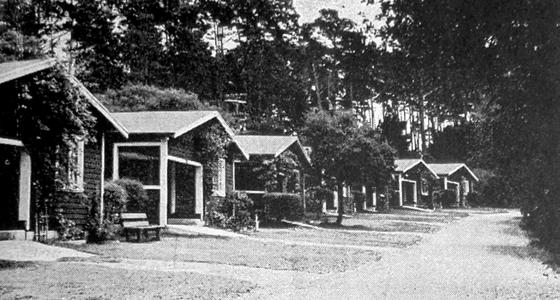
In 1937, residents in the Asilomar area complained that these new buildings violated the campground ordinance, which in November 1937 led Pacific Grove voters to repeal the old ordinance in favor of a new one that allowed the improvement of existing auto camps as long as plans were submitted and public hearings held. It entirely prohibited new campgrounds, which were defined as using portable tents—except for the campground in Municipal Park. At the time of the ordinance there were at least seven cottage courts operating in Pacific Grove.454 The city’s municipal camp would close in the 1940s in part due to declining business.455
Although no extant cottage courts from this period have been definitively identified, should one be discovered—such as remnants of the Sea Breeze Auto Court or Rosedale Inn—it may be significant for its association with the nascent development of these auto-related facilities within the larger context of Pacific Grove’s tourist infrastructure.
RESIDENTIAL DEVELOPMENT
Given the economic difficulties of the time, residential development was relatively scant during this period, with most new construction taking place either before or after the worst years of the Depression. City directories of the era indicate that Pacific Grove’s population grew rapidly from



 Advertisement for 17-Mile Drive Cottage Court, 1960 (Pacific Grove City Directories)
Pacific Grove Municipal Campground, 1938 (Monterey Peninsula Herald, 25 February 1938)
Advertisement for 17-Mile Drive Cottage Court, 1960 (Pacific Grove City Directories)
Pacific Grove Municipal Campground, 1938 (Monterey Peninsula Herald, 25 February 1938)
Historic Context Statement – Final City of Pacific Grove Historic Context (1927 – 1945) Pacific Grove, California 31 October 2011 Page & Turnbull, Inc. 207
Historic Context Statement – Final City of Pacific Grove Historic Context (1927 – 1945) Pacific Grove, California
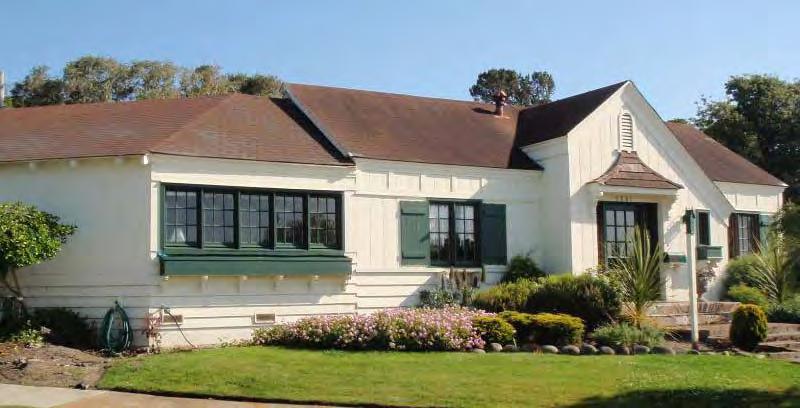
4,750 in 1928, to 5,550 in 1930. By the end of the 1930s, however, less than 500 new residents had moved to the city. Nevertheless, this was a period of expansion, both physically and stylistically, including the early development of two of the city’s more affluent subdivisions. Residential buildings from this period are not currently well-represented in the City’s Historic Resources Inventory, but they may be capable of conveying strong patterns of residential growth. This may include residences designed in one of the new period revival styles, cohesive residential blocks developed during this period, or clusters of housing associated with a specific subdivision.
The Spazier Subdivision
The Spazier Subdivision was recorded in 1928 as a project of the Monterey County Holding Company, and was named for its president, M. Spazier. It encompassed the blocks bounded by 19th Street, Sinex, Forest and Hillcrest avenues, immediately west of the Pacific Grove High School. Although only about half of the available lots were developed by the end of the 1930s, the size and architectural detail of the houses that were constructed—including fine examples of Mediterranean Revival style architecture—are indicative that it was intended to be a relatively affluent neighborhood. In this respect, it is one of the first subdivisions in the city to show clear socioeconomic distinctions. Clearly, large and ornate residences had been constructed previously in many areas of the city—perhaps most concentrated in the area between Central Avenue and Ocean View Boulevard. But these were not enclaves. Sanborn maps indicate that large houses were frequently constructed immediately adjacent to much humbler neighbors.
The Monterey County Holding Company also appears to be connected with development of the Country Club Heights subdivision to the south. An article appearing in the Monterey Peninsula Herald of January 29, 1931, states that the building at 1001 Forest Avenue was constructed by the Monterey County Holding Company at a cost of $5,000 as a “novel office building” with a reception hall, a general office and private office. According to the article, the office building was, “seemingly radical in design, the building is unorthodox only by comparison with prevailing types of architecture on the Monterey Peninsula. The design is early rural English.” The building is further said to presage
Office Building developed by M. Spazier, 1001 Forest Avenue (Page & Turnbull, 2011)
31 October 2011 Page & Turnbull, Inc. 208
Historic Context Statement – Final
City of Pacific Grove Historic Context (1927 – 1945) Pacific Grove, California
“what is hoped will be a period of unprecedented activity in Country Club Heights and Spazier Subdivision.” The architect of the building was by J. W. Swope, general manager and superintendant of the Monterey County Holding Company. Swope had also designed the city hall in Portland, Oregon, and worked for the city of San Francisco as an architect.456 Further evidence of the connection between the Spazier and Country Club Heights subdivisions is evident in the distinctive metal light standards within these neighborhoods, as well as along adjacent areas of Forest Avenue.
Fairway Homes
As previously mentioned, the Fairway Homes subdivision was associated with the development of the city’s golf course, constructed on land donated by Del Monte Properties. The subdivision was recorded in 1932, and comprised primarily of areas along Jewell, Bay View and Foam avenues, as well as areas adjacent to the Beach Tract.457 It is unclear how many speculative homes were built by Del Monte Properties, but the number was likely small. More commonly, the company could provide buyers with various standardized architectural plans, or coordinate custom designs through architects that were kept on retainer. A brochure issued circa 1928 states that the company was affiliated with an “up to the minute architectural and building department” so that “every idea of yours may be incorporated in any plan you decide upon.”458
Map of Fairway Homes Tract, 1932 (Pebble Beach Company, reproduced in Images of America: Pacific Grove, p. 103)
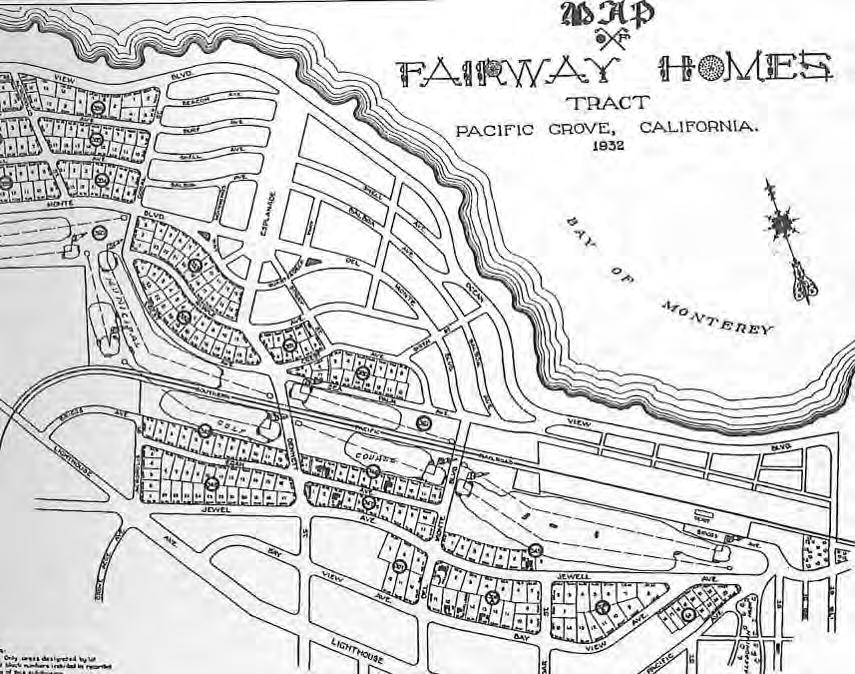
31 October 2011 Page & Turnbull, Inc. 209
Historic Context Statement – Final City of Pacific Grove Historic Context (1927 – 1945) Pacific Grove, California
In 1935, a model home was constructed by Del Monte Properties at 830 Jewell Avenue overlooking the golf course (extant, but altered). Designed by architect Robert Stanton, the house was completed “according to the specifications of the Federal Housing Administration’s home ownership plan.”459
The model home appears to have been based on a prototype factory-built “honeymoon cottage” that Stanton had previously worked on with noted architect, Wallace Neff.460 To attract buyers to the Fairway Homes model home, an open house contest was held, and a newspaper article of the time mentions that the house contained numerous modern conveniences, including an electric fan in the kitchen and a chimney reinforced with steel to withstand earthquakes. The timing of its construction was not auspicious, however, and only a handful of homes were constructed in the subdivision prior to World War II. During the 1950s, however, both Fairway Homes, as well as the adjacent Beach Tract, would develop in earnest.
The fact that the model home at 830 Jewell had been constructed to the specifications of Federal Housing Administration (FHA) plan was not insignificant. The FHA had been created by the National Housing Act of 1934, and was designed to improve the purchasing terms for prospective home buyers. By the mid 1930s, it was the primary vehicle for most people to purchase homes, and builders rushed to meet the demand. Advertisements from 1938 for both the G. A. Good Lumber Company and the Homer T. Hayward Lumber Company—respectively located north and south of the railroad tracks near Lovers Point, state that the they were willing to make loans according to the FHA plan, with the Hayward Lumber Company offering a 90 percent loan-to-value ratio at a term of five percent.461 That lumber companies had gone into the mortgage business is indicative of their need to secure business at a time when private development was grindingly slow.
Other developments of the period were less ambitious than Fairway Homes. About 1930, a bungalow court featuring “six stucco buildings” was developed on the south side of Lighthouse Avenue between Chestnut and Alder streets. These had been developed by Thomas A. Work, who sold them to Pacific Grove realtor M. W. Crowley, in June 1930 for approximately $21,000 (extant). Though many were subsequently altered, these buildings appear to have originally been designed in the Pueblo Revival style, and at the time a newspaper article mentions that the “appearance of the court is to be further enhanced by the landscaping of the grounds surrounding with gardens in keeping with the modern appearance of the group.”462
Into the Hills
This period also witnessed the first concerted development reaching into the hills along Forest Avenue, almost certainly because of that thoroughfare’s recent development as a connection to the Holman Highway. These new subdivisions were all located east of Forest Avenue and included the triangular area formed by Beaumont and Morse avenues on the Monterey border, as well the Ocean View Terrace, Sea View Terrace and Presidio Terrace subdivisions roughly bounded by Forest, David, Devisadero and Bishop avenues. Bishop Avenue was almost certainly named for James D. Bishop, who had developed the Pine View Nursery in 1928 near Congress and David avenues in Del Monte Park. Following the construction of the Holman Highway in 1930, he moved his nursery to the Presidio Terrace tract near the intersection of Bishop and Forest.463 Build out of these areas was
31 October 2011 Page & Turnbull, Inc. 210
quite slow, and prior to 1945 only a handful of homes were built, primarily clustered near the intersection of Beaumont and Olmstead avenues, as well as another cluster near the intersection of Seaview and Stuart avenues.
Many of these homes—which appear to have been constructed during the late 1930s—were vernacular designs that presaged the Ranch houses of later years. Between 1925 and 1935, architecture in Pacific Grove had been dominated primarily by Spanish influenced designs, particularly the Mediterranean Revival style, such as two homes at 411 and 415 Park Street that were constructed by M. J. Murphy, a prominent builder at the time. The Spanish influence was also realized in the Pueblo Revival style homes, such as the bungalow court described previously. Tudor Revival and Cape Cod style bungalows were also common. But by the late 1930s a stylistic shift was underway, with Minimal Tradition designs becoming commonplace, as were vernacular style buildings based on English cottage precedents. Some Victorian homes were also “modernized” during this period, including the Queen Anne style Martin House at 283 Lighthouse Avenue. In 1938 it was altered with Art Moderne influences by E. C. Ricklefs, who also converted the house into apartments for two families.

The majority of residences constructed during this period were located south of Pine Street, although the continued presence of scattered empty lots meant that they were also built in areas of the original Retreat boundaries more closely identified with Victorian architecture.
COMMERCIAL DEVELOPMENT
As with residential development, the opening of new businesses during this period was hampered by the economic hardships of the Depression. In fact, the majority of new commercial buildings constructed during this period were all in place before 1933. As with the city’s civic buildings, nearly all of the commercial buildings of this period were designed with Spanish-influenced architecture.
283 Lighthouse Avenue, a Queen Anne residence altered with Art Moderne influences (Page & Turnbull, 2011)
Historic Context Statement – Final City of Pacific Grove Historic Context (1927 – 1945) Pacific Grove, California 31 October 2011 Page & Turnbull, Inc. 211
City of Pacific Grove Historic Context (1927 – 1945) Pacific Grove, California
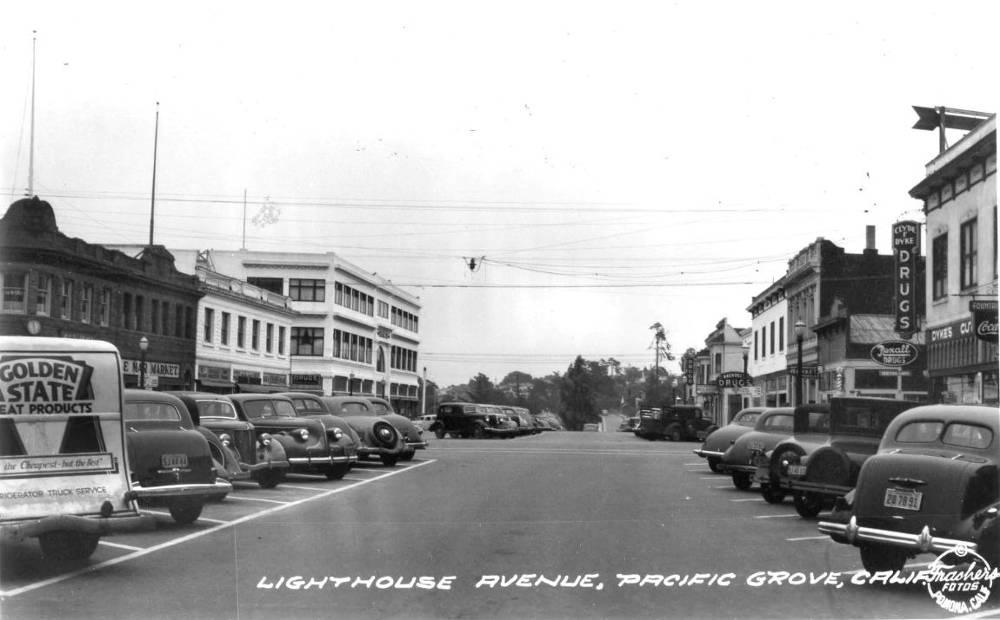
Commercial buildings from this period may be significant as examples of the modest expansion of the commercial district, as well as increasing architectural cohesion and the dominance of the Spanish Colonial Revival style.
Among the most prominent was the First National Bank, completed in 1930 by Thomas A. Work on the northwest corner of Lighthouse and Grand avenues (extant). By this time Work was considered the most successful businessman in the city, said to have furnished “ninety percent of the commodities used in the construction of the town, including business houses, churches, schools and private residences,” and that he “owns more cottages than any other one citizen in Pacific Grove.”464
To construct the building, Work had razed the old Robson Block in 1929, erecting in its place a new Spanish Colonial Revival bank and office building said to be influenced by the design of the Kocher and Merrill buildings in Carmel. The bank opened on January 11, 1930, with a contemporary newspaper article describing it as having gone “all the way in following the Spanish motif” and that the completed building “brings an unusual beauty to the business district. When the many external finishing touches are applied, it will have an air of informality, of quaint charm, quite different form the rigid, stern plainness of many buildings or the flamboyant ornateness of others.”465 Thomas Work served as president of the bank, and it was reported that a carving over the bank door included a scene of Work struggling with baggage and an unruly horse. The building also provided commercial space for “prominent” stores, as well as professional offices on the second floor.466
Lighthouse Avenue, 1940 (Pomona Public Library)
Historic Context Statement – Final
31 October 2011 Page & Turnbull, Inc. 212
Historic Context Statement – Final
City of Pacific Grove Historic Context (1927 – 1945) Pacific Grove, California
Although Holman’s Department Store added a third floor and rooftop solarium in 1931, it was by no means the only furniture store in town. In 1932 a large new Mediterranean Revival style furniture store was constructed for the Rose Brothers at 480 Lighthouse Avenue on the northwest corner of 13th Street (extant).467 Though located on a prominent corner near downtown, this lot does not appear to have been previously developed, and may have stood vacant because of drainage issues associated with the nearby stream in Greenwood Park.
Around the same time that the Rose Brothers store was constructed, a new two-story Mediterranean Revival style mixed-use building was constructed by the Raymond Brothers at 230 Grand Avenue. This was called the Varien Building, named after a longtime resident who had operated a barber shop nearby on Forest Avenue. The new building included the Pacific Grove Cleaners store on the ground floor, and a four-room apartment above. A one-story pressing plant was located adjacent. Today, this location continues to house Pacific Grove Cleaners.468
An aerial photo from 1936 indicates that another large store had opened by that time at 167 Fountain Avenue, replacing the Old Parlor that had previously been used for Edward Ricketts for his laboratory. By 1962, Sanborn maps show the building was being used as a furniture store, with hospital supplies stored in the rear.
CANNERY ROW & JOHN STEINBECK
The pioneering efforts of the Chinese fisherman at Point Alones to develop Monterey Bay as a commercial fishery was in many respects the precursor to the development of Cannery Row in Monterey. However, it would ultimately take a confluence of several cultures, including American, Chinese, Japanese, Italian, Portuguese and Scandinavian, to give rise to the famous row of canneries. The earliest of the canning facilities had developed around the turn of the century, primarily to pack salmon. But the focus soon shifted to sardines after Sicilian fisherman discovered that using fast haul lampara nets greatly increased the catches.469
Improvements were also made in the canning and cleaning process, including several inventions developed at the Booth Cannery under the supervision of Knut Hovden, a Norwegian-born manager at the facility. In 1916, Hovden opened his own cannery (today the site of the Monterey Bay Aquarium), but by this time fish reduction at the canneries had become far more profitable than the actual canning itself. Most of the sardine catch was either processed into sardine oil for paint and soap manufacturing, or reduced to fish meal fertilizer. The smell of these operations was infamous, and it was joked: “Carmel by the Sea, Pacific Grove by God, and Monterey by the smell!”470
Most of the workers employed in the Canneries lived near the Pacific Grove border in an area known as New Monterey. This was practical, as the area lay directly above the canning facilities. But the prohibition against the sale of alcohol may also have influenced the fact that few cannery workers appear to have lived in Pacific Grove. A notable exception was Knut Hovden, who in 1920
31 October 2011 Page & Turnbull, Inc. 213
Historic Context Statement – Final City of Pacific Grove Historic Context (1927 – 1945) Pacific Grove, California
purchased the home of Dr. Oliver S. Trimmer at 230 6th Street, and lived there with his wife until 1928.471
The American Can Company
While no canneries were located in Pacific Grove, the city did have one large facility tied to the Cannery Row operations in Monterey. During the late 1920s, large purse seine boats were introduced into Monterey Bay, which greatly increased the size, capacity and range of the fishing fleet. Offshore floating reduction plants were also developed, and during the 1930s record catches exceeding 200,000 tons were made.472 It is during this period that the American Can Company constructed a massive can manufacturing facility adjacent to the Pacific Grove-Monterey city border, located on the block bounded by Dewey, Sloat, Eardley and Ocean View Boulevard. Opened in 1927, the plant soon gained fame for producing the “famous Monterey one-pound oval sardine can” for fish packers at Cannery Row.473
The American Can Factory was one of the only large industrial operations in Pacific Grove. It included three primary sections: a one-story reinforced concrete shipping office at its western end; a 36’ tall wood frame production area clad with corrugated metal at center; and an eastern section with steel columns supporting a register roof lined with skylights. A 1941 book describing Pacific Grove’s industrial operations said of the plant:
Transported by truck from Monterey’s Municipal Wharf, huge sheets of tin are converted by the $1 million factory into oval cans used by the sardine canneries at Monterey. Other industries located in Pacific Grove are two boatbuilding yards, the larger established in 1915 and equipped for construction and repair of all types of fishing and pleasure craft. A planing mill and lumber yard and a steam laundry, both built before the enactment of restraining ordinances, comprise the remainder of the city’s industries.”474
John Steinbeck
At the time the description of the American Can Company was published, the famed writer John Steinbeck was then living in Pacific Grove at 425 Eardley Avenue. This location, only a few blocks above the canneries, proved fertile inspiration for the writer, and within a few years he would complete one of his most famous works, Cannery Row, published in 1945.
Born in Salinas in 1902, Steinbeck had a long and significant association with Pacific Grove, primarily through a family cottage purchased by his father, John Ernst Steinbeck, Sr., at 147 11th Street in 1903.475 At the time it appears that Steinbeck Sr. purchased two lots: one on the southeast corner of 11th and High (now Ricketts Row) where the cottage was constructed, and the other lot immediately south which was reserved for a garden. The Sanborn maps from 1905 indicate that vacant lots were still plentiful in this area at the time, even though it had been some 30 years since the initial subdivision.
31 October 2011 Page & Turnbull, Inc. 214
After attending Stanford University, Steinbeck lived in several locations before moving into the family cottage in Pacific Grove in 1930 with his wife, Carol Henning. Steinbeck was then struggling financially, and helped his father enlarge the structure while also pursuing his writing. This included enclosing the front porch, building a fireplace in the living room, and relocating the main entrance to the south side of the cottage.476 Steinbeck lived at the cottage until 1936, producing five novels: The Pastures of Heaven (1932); To a God Unknown (1933); The Red Pony (1933); Tortilla Flat (1935); and In Dubious Battle (1936). He subsequently moved to Los Gatos between 1936 and 1941, although it is said he frequently visited Pacific Grove during this period, which included the publication of Of Mice and Men (1937) and the Grapes of Wrath (1939). In 1941 he moved to the house on Eardley Avenue, which he owned between 1941 and 1943. Steinbeck would return again to the family cottage between 1948 and 1950, after which he moved to New York.477
Steinbeck and Edward Ricketts
In 1930, during Steinbeck’s initial period of residency at the cottage, he was introduced to Edward F. Ricketts, who had recently moved his Pacific Biological Laboratory from 165 Fountain Avenue in Pacific Grove to 740 Ocean View Avenue in Monterey. During the 1930s, Ricketts amassed a detailed intertidal record of the West Coast and in 1939 Stanford University published his landmark work, Between Pacific Tides, which continues to be regarded as one of the most authoritative works on the intertidal zone. For a time, however, the director of Stanford’s Hopkins Marine Station, Dr. W. K. Fisher, slowed publication of the work because he felt it was not appropriately scientific and had a “certain vulgarity.”478 During this period Ricketts lived at several homes in Pacific Grove, including 331 Lighthouse Avenue and later 221 4th Street.
 Steinbeck Cottage at 147 11th Street, n.d. (Courtesy the Heritage Society of Pacific Grove)
Steinbeck Cottage at 147 11th Street, n.d. (Courtesy the Heritage Society of Pacific Grove)
Historic Context Statement – Final City of Pacific Grove Historic Context (1927 – 1945) Pacific Grove, California 31 October 2011 Page & Turnbull, Inc. 215
Historic Context Statement – Final City of Pacific Grove Historic Context (1927 – 1945) Pacific Grove, California
During the 1930s Ricketts and Steinbeck developed a close relationship, and in 1940 traveled together on a marine expedition to Baja Mexico and the Gulf of California, resulting in the book Sea of Cortez: A Leisurely Journal of Travel and Research published in 1941 by Ricketts and Steinbeck. Ricketts also served as the basis for “Doc” in Steinbeck’s Cannery Row novel, with the name of his company changed to “Western Biological Laboratory.”
In 1948 Ricketts was killed in his car at a railroad crossing in New Monterey by a Del Monte Express train on its way to Pacific Grove.479 As a tribute to his friend, Steinbeck subsequently republished a portion of their book in 1951 as The Log from the Sea of Cortez with a preface about Ed Ricketts. In 1994, the City of Pacific Grove renamed High Street—which formed the corner of both Ricketts’ original laboratory on Fountain Avenue, as well as the Steinbeck family cottage on 11th Street—as Ricketts’ Row.
Bruce Ariss
Among Steinbeck and Ricketts’ close circle of friends were Bruce Ariss, Jr. and his wife, Jean. The couple was highly influential in the Monterey area artistic community, and lived in Pacific Grove from 1934 to 1937, although more research is required to determine the location.480 They then moved to a house constructed by Bruce in the “Huckleberry Hill” area of New Monterey. This was part of a small art colony that had been founded by the noted artist, Ellwood Graham.481 In 1936 Bruce Ariss and August Gay completed a large mural for the Pacific Grove High School that was subsequently destroyed by a fire in 1946.482 Bruce Ariss also accompanied Ricketts and Steinbeck on the expedition to the Sea of Cortez.
RELIGIOUS DEVELOPMENT
Relatively few new churches were established in Pacific Grove during this period. As previously mentioned, the Bethlehem Evangelical Lutheran Church moved in 1939 from a location on Pine Street into a building at 160 Monterey Avenue that had previously been erected as the Theosophical Society Hall. This same building had also been used by a Catholic congregation in Pacific Grove.
In 1928, the first meetings for the St. Angela Merici Parish—better known as St. Angela’s Catholic Church—were held at the Theosophical Society Hall. Within a year church members erected a new wood-frame church building at 325 Central Avenue (extant).483 The design of the church was fairly restrained, consisting of a one-story (double-height) hall with a small corner tower. The interior, however, was decorated by the Monterey Guild, founded by noted painter Euphemia Charlton Fortune, whose paintings were used on the altar. By the 1950s, church membership had outgrown the original church, and in August 1956 ground was broken for current St. Angela’s Church located at 9th Street and Lighthouse avenues.484 During the 1960s the original church was used as a gym for St. Angela’s School, but in the mid-1970s the building was purchased by the Monterey-Korean Central Presbyterian Church.
31 October 2011 Page & Turnbull, Inc. 216
Historic Context Statement – Final City of Pacific Grove Historic Context (1927 – 1945) Pacific Grove, California
Another church building was constructed circa 1940 at 409 Pine Avenue for the Church of Jesus Christ of Latter Day Saints. Designed in a vernacular style, the wood frame building features stucco cladding and is capped by a combination gable and flat roof. Sanborn maps indicate that it continued in use by the Latter Day Saints until at least 1962, but is today occupied by the Community Missionary Baptist Church.
WORLD WAR II
Even before the outbreak of World War II, the turbulent events taking place in Europe and Asia convinced U.S. military officials that the country should embark on a program of military preparedness. In the Monterey area, this was made most visible by activity at Ford Ord, which had been improved during the 1930s using WPA funding to construct new roads and clear encampment areas. As early as January 1940 the first joint Army and Navy maneuvers were held at the post, involving over 10,000 troops and 1,000 vehicles.485 In 1940, hundreds of wooden barracks were erected, and the 7th Infantry Division became the first major Army unit to occupy the camp. By the end of 1941, approximately $12 million dollars worth of improvements had been made, and by the end of the war Fort Ord emerged as one of the largest and most important military facilities on the West Coast.486
The Presidio of Monterey also grew active during this period. Between the two world wars the post had been home to the 11th Cavalry and the 2nd Battalion, 76th Field Artillery, which remained at the Presidio until 1940. In 1941, the post became a reception center for selectees, and for a while it housed the headquarters of the III Corps. Around the same time, the Del Monte Hotel was used as a flight training center by the U.S. Navy. 487
The whirlwind of military activity, particularly at Ford Ord, had an immediate effect on Pacific Grove’s economy. An August 1, 1941 article in the Pacific Grove Tide mentions that:
The town has benefited in that local carpenters, plumbers and other building tradesman now have plenty of work at high wages … Pacific Grove has benefited from the military establishment in the fact that all rentable houses now are rented, many of them at unusual prices … a year ago it seemed that every house in town was for sale … Pacific Grove has benefited by a large amount of new home construction. This has been brought about by the increased scale of rents. Many local people have found it cheaper to own a home through FHA payments, than to pay rent. There has been little speculative building … Stores catering particularly to the military trade have not been established here … If the army were ordered away tomorrow, our business district would experience a falling-off in patronage, but there would be no establishments automatically closing because they had put all their eggs in the military basket.
31 October 2011 Page & Turnbull, Inc. 217
Historic Context Statement – Final City of Pacific Grove Historic Context (1927 – 1945) Pacific Grove, California
Perhaps the most dramatic event of World War II in the Pacific Grove area came shortly after Pearl Harbor, when a Japanese submarine attempted to sink a Richfield oil tanker off Pebble Beach. Coastal communities in California were considered at particular risk of attack, and thus for most of the war access to the majority of Pacific Grove’s beachfront was restricted. One battery of the African-American 54th Coast Artillery manned 155 mm guns along the shoreline, and between May and December 1943, 120 men of the Pacific Grove Beach Patrol were encamped near the Point Pinos Lighthouse. Residents were also asked to keep blackout curtains on their windows.488
Like so many communities across the country, Pacific Grove’s residents aided the war effort by purchasing war bonds, growing Victory gardens, and participating in scrap drives. This included the donation of the metal fountain that had been located on the grounds of the El Camelo Hotel, as well as a Spanish cannon that stood in front of the Pacific Grove Museum.489 The metal cresting that had once graced the roofs of many Pacific Grove Victorian-era residences was similarly taken down and donated to the war effort. The rationing of goods became the norm, including food, gasoline, clothing and building materials. Thus, few if any non-military buildings were constructed in Pacific Grove during the war years.
Given the influx of military and civilian personnel, many of Pacific Grove’s blue laws—such as restrictions on certain types of dancing—were repealed in 1941. The sale of alcohol, however, remained prohibited.490 By far the greatest hardship of the war was the loss of several of Pacific Grove’s citizens on foreign battlefields, including Thomas Gall, who in 1942 became first resident to lose his life in the war. Three Navy fliers also lost their life in March 1944, when their low-flying torpedo bomber snagged a power line and crashed on the grounds of the Pinehurst mansion at 1081 17 Mile Drive.
Pacific Grove’s industrial facilities also joined in the war effort. Thomas A. Work’s large lumber yard at David and Central avenues manufactured wooden assault landing craft.491 The Del Monte sand plant, now operated by the Owens-Illinois company, also produced materials for the war effort. In 1936, the plant had been modernized with additional equipment, including a clam shell loader with a 400-foot belt conveyor that brought sand to the plant so it could be screened, dried and then placed into sacks. Between 1942 and 1943 the plant was largely rebuilt, with new shop buildings, maintenance sheds and offices to meet the changing needs of the industry. The sand was purchased from Del Monte Properties and then shipped to Owens-Illinois factories in Oakland and Los Angeles where it was used to produce glass.492 A newspaper article at the time reported that the rebuilding work was carried out entirely by local contractors, and that the plant employed between 25 and 30 staff members.493
Asilomar during the War
Asilomar had its own role in the homefront effort during World War II, providing rooms for families of servicemen stationed at Fort Ord and other nearby military facilities. Prior to that time, the Depression had placed tremendous pressure on YWCA funding for Asilomar, which had never been financially self-sufficient. The crisis reached a head in 1934, when the YWCA voted to close
31 October 2011 Page & Turnbull, Inc. 218
Historic Context Statement – Final City of Pacific Grove Historic Context (1927 – 1945) Pacific Grove, California
the facility, as well as all other YWCA conference centers in the United States. The property was put up for sale, but found no buyers.
In 1936, David and Paulsen Visel leased the property for use as a motel, but in 1940 it was turned over to the National Youth Administration—another New Deal work program—for use as a training camp. In 1943, with military activities on the Monterey Peninsula reaching a crescendo, the YWCA decided to make all empty rooms available to families of military personnel, who would stay there until the end of the war.494
Japanese Internment
Among the darker aspects of World War II in Pacific Grove was the forced relocation and internment of the city’s Japanese residents, many of whom were native born. The city’s Japanese population was not large—there were only a handful of families living in Pacific Grove prior to the war, including the Ichiuji, Murakami, Sugano and Uchida families. But despite their small numbers, they had integrated themselves into the city’s commercial community, particularly in dry cleaning and shoe repair enterprises. As early as 1911, G. Masuda and M. Suzuki were operating the New Grove Cleaning and dyeing works at 301 Fountain Avenue. Pacific Grove historian, Donald Howard, states that this building was part of the old Gosbey Building that had formerly occupied 569 Lighthouse Avenue.495 Today, parts of that building appear to remain extant on the lot, indicated by the presence of a small gable roof incorporated within a larger building.
In 1919, Kikujiro Ichiuji purchased a shoe-repair shop known as the Grove Shoe Hospital, which occupied a number of locations over the years, staying in business as a family concern until 1984.496 Similarly, during the early 1920s, Kakutaro Uchida, purchased a dry cleaning business in Pacific Grove, which became Pacific Grove Cleaners at 230 Grand Avenue.497
The Japanese residents of Pacific Grove do not appear to have been concentrated in any particular neighborhood. By contrast, many of the Japanese residents living on the Monterey Peninsula resided in a close-knit community in Monterey near Lake Estero. On the eve of World War II, these families operated about two dozen retail businesses, many of which were tied to fishing and ship chandlery. A Japanese American Citizens League (JACL) hall had also been built at 424 Adams Street in Monterey in 1926 (extant), but the Pacific Grove and Monterey communities did not interact much, except for church on Sundays.498
In February 1942, President Franklin D. Roosevelt signed Executive Order 9066, which allowed military commanders to exclude persons from “military areas” at their discretion. Initially, this was primarily aimed at persons of German and Italian ancestry, but a subsequent Civilian Exclusion Order issued in May ordered all persons of Japanese ancestry—whether or not they were American citizens—to report to assembly centers where they would be assigned to “relocation centers.” Japanese residents of Pacific Grove were assigned to internment camps scattered across the western United States: the Uyeda family was sent to Topaz, Utah, and the Uchida family was sent to Poston,
31 October 2011 Page & Turnbull, Inc. 219
Arizona.499 Also included was noted artist Miki Hayakawa (1899 – 1953) who had arrived in Pacific Grove in 1939 and was sent to an interment camp in Santa Fe, New Mexico.500
During the war, the Grove Shoe Hospital was kept open as a shoe-shining business by a person named Clay Spats, and Kikujiro Ichiuji would return to manage the store following the war’s end. Others were not as fortunate. After the war the JACL hall, which had been converted into an armory, was used as a hostel for returning Japanese Americans who had lost their homes. The JACL also assisted returning families with compensation claims.501
ASSOCIATED PROPERTY TYPES & REGISTRATION REQUIREMENTS (1927 – 1945)
The dominant themes of the “City of Homes” period are recreation and tourism, the Great Depression, and World War II. Specifically, this period saw new public ownership and management of the city’s key recreational facilities, the rise of auto camps as a significant part of the city’s tourist infrastructure, the protection of natural resources via acquisition of the city’s coastline and the passing of the “butterfly ordinance,” and the improvement of recreational facilities as part of Depression-era work programs. The influence of Monterey’s Cannery Row operations on Pacific Grove would also prove to be a major factor. Property types associated with these significant themes include residential properties, commercial properties, auto camps & cottage courts, civic & public assembly properties, industrial properties, and cultural landscape elements.
RESIDENTIAL PROPERTIES
The overwhelming majority of surviving buildings constructed between 1927 and 1945 are residential, primarily consisting of single-family residences consistent with the town’s established character. Generally speaking, these buildings exist as infill rather than cohesive developments, although they may occasionally be found in small groups. Given wartime rationing of building materials, it also appears that few if any private buildings were constructed during World War II.
Residential architecture of the period encompasses a range of styles, with the most popular roughly following a chronology that included the Spanish Colonial Revival style (1920s - 1930s), which also includes the related Pueblo Revival style; Tudor Revival style (1920s – 1930s); the Minimal Traditional Style (1930s – 1940s); and the Ranch Style (1940s – 1970s). As was the case in previous eras, vernacular buildings are common, most frequently appearing as simplified versions of Craftsman style buildings or following English cottage precedents.
As a general rule, most residences are rectangular or L-shaped, and typically only one story in height. However, in recognition of the growing dominance of the automobile, during the 1930s split-level houses begin appearing, typically with second-story bedrooms above an integral garage. Wood frame construction is near universal, although brick structural systems are possible. Gable roofs are most common, although hip roofs (or combination gable and hip roofs) are also apparent. Building associated with the Spanish Colonial Revival and Pueblo Revival styles most frequently have flat or combination gable and flat roofs.
Historic Context Statement – Final City of Pacific Grove Historic Context (1927 – 1945) Pacific Grove, California Turnbull,
31 October 2011 Page &
Inc. 220
Historic Context Statement – Final
City of Pacific Grove Historic Context (1927 – 1945) Pacific Grove, California
Houses typically feature a moderate set back from the front and rear lot lines, which is consistent with patterns established around the turn of the century. The growing dominance of the private automobile increases the likelihood of encountering detached garages, although beginning in the mid-1930s houses for the first time begin to be constructed with integral garages.
Multi-unit construction is extremely rare with only a few examples noted during reconnaissance efforts. These include 419 Forest Avenue, which originally consisted of a circa 1910 residence converted into a four-unit apartment building and remodeled with Spanish architectural influences.
Nearly all residential buildings dating to this period would have originally featured wood-sash windows and wood doors—although industrial steel-sash casement windows were occasionally used. Typical cladding varied depending on architectural styles. Spanish Colonial Revival and Tudor Revival buildings are almost exclusively clad in stucco, while Minimal Traditional houses most frequently feature wood shiplap siding.
These buildings may be found as scattered infill throughout the central portion of the city, but are most common south of Pine Avenue. Clusters of residences constructed during this period may be found on 19th Street between Pine and Junipero avenues; Gibson Avenue between Fountain and Carmel avenues; and the east side of 17 Mile Drive between Melrose and Sinex avenues.
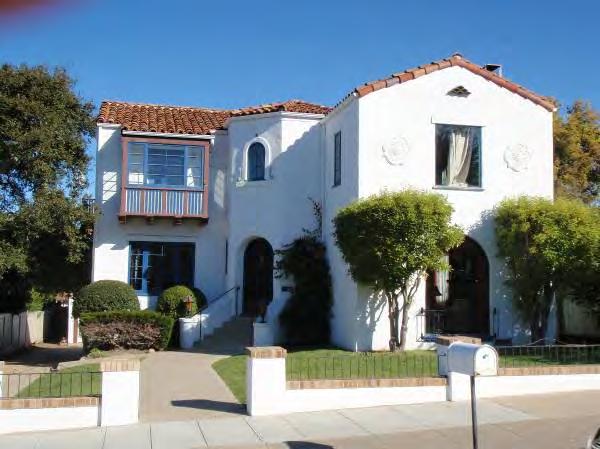
Architectural Styles & Character Defining Features
The following section provides an outline of the relevant residential architectural styles and the character-defining features associated with each style. Residences from this period are typically one story in height, and are generally modestly-sized bungalows.
Rectangular or L-shaped massing is most common
Asymmetrical facades
Gable, or combination gable and flat roof (often with a shaped parapet for flat roofs)
Typically no roof overhang Stucco cladding, either smooth or textured Clay tile roofing; also clay tiles used as decorative accents
Arched openings Stucco wing walls and courtyard enclosures
Metal balconettes beneath windows
Clay pipe attic vents
Also includes related Pueblo Revival style
1. Spanish Colonial Revival Style (1920s – 1950s)
Spanish Colonial Revival villa in Country Club Heights,
31 October 2011 Page & Turnbull, Inc. 221
528 Beaumont
Rectangular massing with asymmetrical facades
Steeply-pitched gable roofs, usually in combination of side and front-facing gables
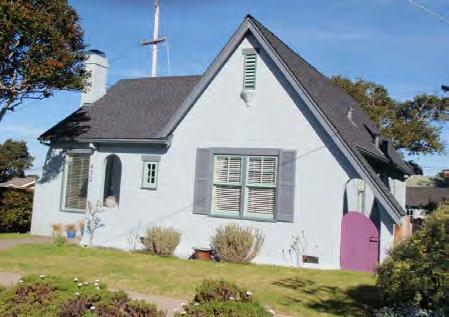
Shallow eaves or eaveless
Stucco cladding, smooth or textured Arched entries, sometimes set within gabled porch elements
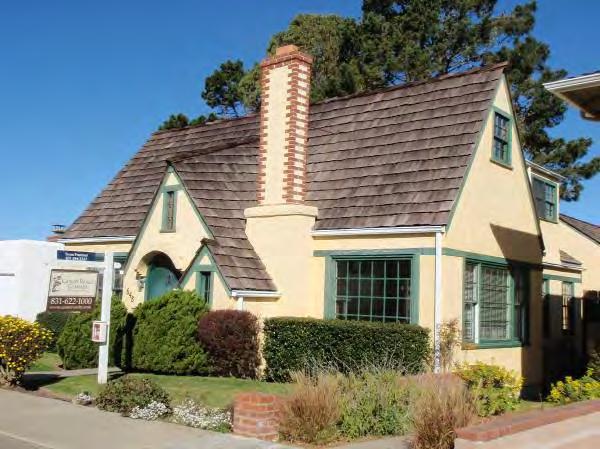
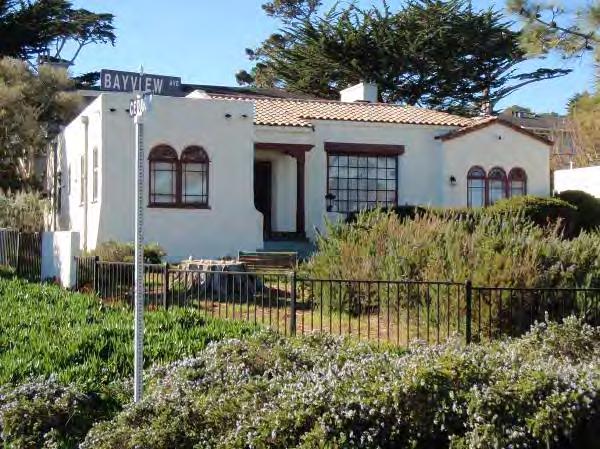
Rusticated masonry accents around doors and windows
Vertical attic vents in the gable end, sometimes with arched tops
Exterior chimney, sometimes with decorative brickwork
Historic Context Statement – Final
City of Pacific Grove Historic Context (1927 – 1945) Grove,
1. Spanish Colonial Revival Style (1920s – 1950s), continued
Spanish Colonial Revival residence in the Beach Tract, 831 Bayview
2. Tudor Revival Style (1920s – 1930s)
Tudor Revival-style residence at 648 Spazier
Tudor Revival-style residence at 420 Gibson Avenue
Pacific
California 31 October 2011 Page & Turnbull, Inc. 222
Significance
Rectangular or L-shaped massing Eaveless gable roofs, usually in combination of a side and front-facing gable
Typically shiplap wood siding Porches with wood posts Decorative trim in gable ends, often with a scalloped edge Decorative window shutters
Rectangular or shallow L-shaped massing with a horizontal emphasis Hip roofs are typical, but gable roofs are also common. Shallow eaves
Typically shiplap wood siding Integral porches with wood posts, or shed extensions of the main roof at the entry. Decorative window shutters Garages less common prior to World
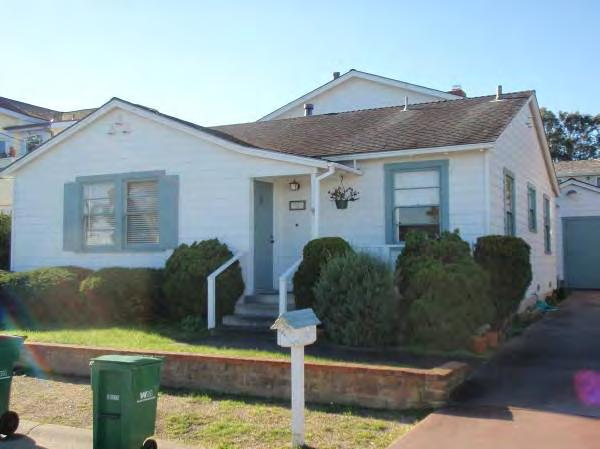
The table below discusses the significance of residential buildings from this era according to criteria established by the National Register of Historic Places, California Register of Historical Resources, and the Pacific Grove Municipal Code. It appears that few residences constructed during this period are currently listed on the City of Pacific Grove’s Historic Resources Inventory.
National/ California Register PG Municipal Code §23.76
A/1 A, B Events, Patterns & Trends
Significance
Discussion
Residential buildings from this period may be significant for their association with the theme of residential development, particularly when they illustrate strong patterns in the growth and character of
City of Pacific Grove Context – 1945) Pacific Grove, California Turnbull,
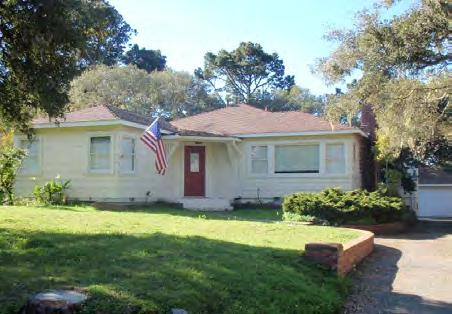 3. Minimal Traditional Style (1930s – 1940s)
911 Ripple Avenue, circa 1940
4. Traditional Ranch Style (1940s – 1970s)
Ranch style residence at 1120 Seaview
3. Minimal Traditional Style (1930s – 1940s)
911 Ripple Avenue, circa 1940
4. Traditional Ranch Style (1940s – 1970s)
Ranch style residence at 1120 Seaview
Historic Context Statement – Final
Historic
(1927
31 October 2011 Page &
Inc. 223
City of Pacific Grove Historic 1945) Pacific Grove, California
National/ California Register PG Municipal Code §23.76 Significance
Discussion
residential neighborhoods. This would include generally cohesive residential blocks developed during this period, or clusters of housing associated with a specific subdivision, such as the Spazier Subdivision. Residences from this period may also illustrate the importance of FHA loans on development in Pacific Grove.
Groups of residences may be better able to convey these patterns than individual structures; evaluators should consider the presence of historic districts that illustrate this criterion, though some properties may also qualify individually for their architectural merits or associations with prominent individuals (see below).
B/2 C Persons Residential buildings from this period may be significant for their association with persons important to Pacific Grove history, such as John Steinbeck, Ed Ricketts, or a prominent local artist. If this is the case, however, the residence should be compared to other associated properties to identify which property(s) best represent that person’s achievements or reasons for being significant.
Residential buildings from this period may be significant for their architecture, as expressed by intact stylistic features, forms or construction methods. Buildings may also qualify as the work of a master architect or prominent builder. Resources qualified under these criteria should be good examples of types and/or styles, and retain most of their original features.
D/4 Information Potential Buildings, ruins or subsurface remains that have the potential to yield important information about construction methods and materials, or the evolution of local residential building development may be significant for their potential to provide information important to history. However, such examples would be extremely rare.
C/3 D, E, F, G, H, I, J, K Architecture/ Design
Historic Context Statement – Final
Context (1927 –
31 October 2011 Page & Turnbull, Inc. 224
Integrity
Historic Context Statement – Final City of Pacific Grove Historic Context (1927 – 1945) Pacific Grove, California
In order to be eligible for listing in the local, state, or national historic registers, a residential property must retain sufficient integrity to convey its significance in association with residential development during this period. While most buildings undergo change over time, alterations should not significantly change the essential historic character of the buildings. The aspects of integrity deemed most important for this period are location, setting, design, materials, association and feeling.
Buildings from this era have not had as long a period to accumulate changes, and thus require a higher overall standard of integrity versus previous periods. A property must retain most of the physical features that made up its historic character. Buildings would typically meet the threshold for addition to the local register if they meet the minimum eligibility requirements. Buildings qualified as individual resources at the state or national level should retain all or nearly all of their original features.
Minimum Eligibility Requirements:
Clear example of residential architecture from this period
Retains original form and roofline
Retains the original pattern of window and doors
Retains original cladding (or the original cladding has been repaired/replaced in kind such that it substantially duplicates the original pattern)
Retains most of its original ornamentation, if applicable.
Other Integrity Considerations:
Prior replacement of doors and windows can be acceptable, but the replacements must conform to the original size of the openings. All other character-defining features must be retained.
It is acceptable for entry stairs or steps to have been replaced, as these are subject to greater deterioration from weathering and use.
Only rear additions that have respected the scale of the original building are generally acceptable.
Many residences from this period originally had an associated detached automobile garage designed to coordinate with the architectural details of the main house. A Pacific Grove residence that retains its original detached garage should be considered a particularly good example. These outbuildings derive their significance from the significance of the residence, however, and are typically not eligible in their own right.
COMMERCIAL PROPERTIES
Given the hardships of the Great Depression, new commercial construction was relatively sparse during this period, with most of it concentrated prior to 1935. These buildings typically are one to two stories in height, and construction is typically reinforced concrete. Architecturally, most of the buildings were designed with Spanish Colonial Revival influences, and thus nearly all buildings feature stucco cladding.
31 October 2011 Page & Turnbull, Inc. 225
Roofs are generally gable or flat, although some buildings, such as the First National Bank, incorporate both gable and flat sections. Originally, nearly all buildings would have incorporated plate glass window systems in their storefronts, with wood-sash windows used elsewhere. Wood doors, typically fully glazed, would have been used prior to about 1930, after which fully glazed metal doors become more common. Here it is worth noting that the third floor addition to Holman’s Department store did not originally included glass block windows, which is a later alteration dating to the 1950s.
All or nearly all new commercial development during this period is concentrated in or near the central business district, although this period did witness the extent of commercial development encompass areas a bit further to the east along Lighthouse Avenue. It appears that several commercial buildings constructed during this period are currently listed on the City of Pacific Grove’s Historic Resources Inventory.
Significance
The table below discusses the significance of commercial buildings from this era according to criteria established by the National Register of Historic Places, California Register of Historical Resources, and the Pacific Grove Municipal Code.
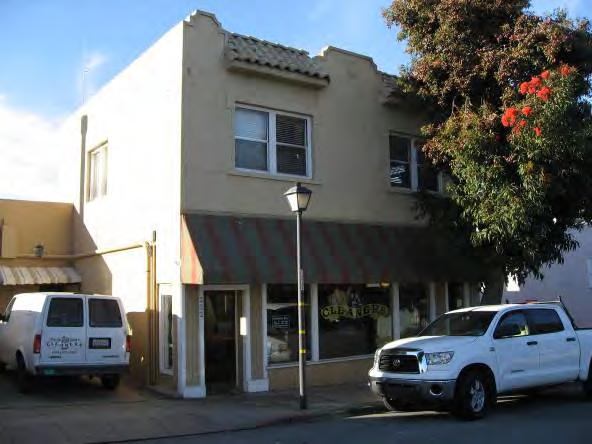
Significance
A/1 Events, Patterns
Discussion
Commercial buildings from this period may be significant for their association with the theme of commercial development during this period, which witnessed both modest expansion of the commercial district, as well as increasing architectural cohesion. Most buildings would most easily be qualified at the
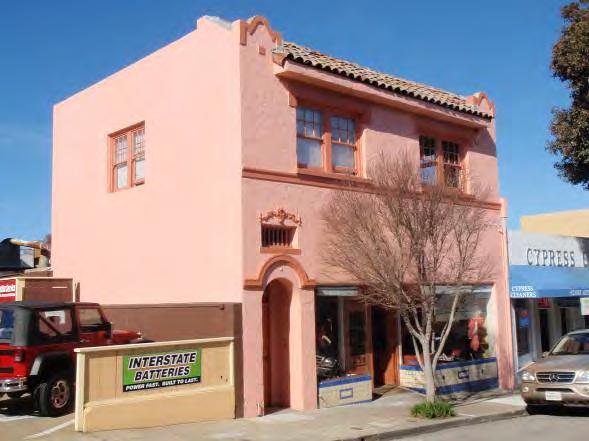 Spanish Colonial Revival-style commercial buildings, 220-230 Grand Avenue, circa 1930s
Spanish Colonial Revival-style commercial buildings, 220-230 Grand Avenue, circa 1930s
Historic Context Statement – Final City of Pacific Grove Historic Context (1927 – 1945) Pacific Grove, California 31 October 2011 Page & Turnbull, Inc. 226
National/ California Register PG Municipal Code §23.76
A, B
& Trends
National/ California Register PG Municipal Code §23.76
Significance
Discussion
state or national level as contributors to a historic district, although some would qualify individually for their architectural merits or associations with prominent individuals. Businesses owned by a member of an ethnic or cultural group may also represent the contributions of that group under this criterion.
B/2 C Persons Commercial buildings from this period may be significant for their association with persons important to Pacific Grove’s history, such as a prominent merchant. If this is the case, however, the building should be compared to other associated properties to identify which property(s) best represent that person’s achievements or reasons for being significant. For commercial properties potentially eligible for the HRI, this criterion may also apply to businesses or organizations.
C/3 D, E, F, G, H, I, J, K Architecture/ Design
Commercial buildings from this period may be significant for their architecture, as expressed by intact stylistic features, forms or construction methods. Buildings may also qualify as the work of a master architect or prominent builder. Individual resources qualified under these criteria should be good examples of types and/or styles, and retain most of their original features.
D/4 Information Potential Buildings, ruins or subsurface remains that have the potential to yield important information about construction methods and materials, or the evolution of local commercial building development may be significant for their potential to provide information important to history. However, such examples would be rare.
Integrity
In order to be eligible for listing in the local, state, or national historic registers, a commercial property must retain sufficient integrity to convey its significance as part of commercial development during this period. While most buildings undergo change over time, alterations should not significantly change the essential historic character of the buildings. Commercial properties from this era are not common, and therefore some discretion is warranted when considering integrity (see
Historic Context Statement – Final City of Pacific Grove Historic Context (1927 – 1945) Pacific Grove, California 31 October 2011 Page & Turnbull, Inc. 227
Historic Context Statement – Final
City of Pacific Grove Historic Context (1927 – 1945) Pacific Grove, California
below: “Other Integrity Considerations”). Nevertheless, a commercial property must retain essential physical features that made up its historic character. The aspects of integrity deemed most important for this period are location, design, materials, association and feeling.
Buildings would typically meet the threshold for addition to the local register if they meet the minimum eligibility requirements. Buildings qualified as individual resources at the state or national level should retain a substantial majority of their original features. However, discretion should be exercised when assessing storefront alterations—particularly in multi-story commercial or mixed-use buildings where a storefront alteration may be subordinate to the overall character of the building.
Minimum Eligibility Requirements:
Clear example of commercial architecture from this period
Retains original form and roofline
Substantially retains the original pattern of window and doors. Storefront alterations, particularly in multi-story commercial buildings, may be acceptable.
Retains a substantial portion of its original ornamentation
Retains original cladding
Replacement of doors and windows is acceptable as long as the replacement have substantially conformed to the original door/window pattern and the size of the openings
Other Integrity Considerations:
Commercial buildings from this period that retain their original storefront configurations are not common. In multi-story commercial buildings, ground floor alterations may be considered acceptable as long as they are subordinate to the overall character of the building. Similarly, storefront alterations that demonstrate evolving commercial design patterns associated with a subsequent historically significant context may be acceptable.
Replacement/repair of the original cladding may be acceptable if it has been replaced in kind and substantially duplicates the original pattern
Rear additions that have respected the scale of the original building are generally acceptable. However, more recent additions, especially those that compromise a building’s form and scale, are not acceptable.
AUTO CAMPS & COTTAGE COURTS
The wave of auto camp and cottage court construction that had begun in the early 1920s carried through into this period, and today appears to be represented by at least some extant built resources. These include cabins associated with the Sea Breeze Auto Court developed at 1100 Lighthouse Avenue in 1937, as well as buildings associated with Milar’s Motel developed around the same period (today known as the Butterfly Grove Inn). It is important to note, however, that several of the Milar’s Motel buildings were actually constructed as part of the Del Monte Military Academy. However, these were likely refurbished for use as tourist facilities and thus have been grouped with this period of development.
31 October 2011 Page & Turnbull, Inc. 228
City of Pacific Grove Pacific Grove, California
All of the cottage courts developed during this period were clustered toward the western end of the city in the Pacific Grove Acres subdivision. These included areas near or adjacent to Lighthouse Avenue, as well as areas closer to Asilomar. These buildings typically included small wood frame vernacular structures featuring gable or hip roofs and wood board and batten, channel drop or shiplap siding. Duplex or dormitory type structures are also possible.

Most cottage courts were arranged around a loop drive or central parking area, and frequently features offices, as well as ancillary buildings such as camp stores, restroom facilities and fire pits. As mentioned earlier in this document, the lack of Sanborn maps for this area hampers definitive identification of many properties. Thus further research should be employed when qualifying these types of buildings for historic listing.
Significance
The table below discusses the significance of auto camp and cottage court buildings from this era according to criteria established by the National Register of Historic Places, California Register of Historical Resources, and the Pacific Grove Municipal Code. Currently it appears that few auto camp developments from this period are currently listed in the City of Pacific Grove’s Historic Resources Inventory. The only such development noted was the Butterfly Grove Inn (formerly Milar’s Motel) at 1073 Lighthouse Avenue.
Significance
A/1 Events, Patterns & Trends
Discussion
Auto camp and cottage court buildings from this period may be significant for their association with the development of auto-related tourist facilities, which was a key facet of the city’s identity and economic base during this period. Their significance may be enhanced by their relative scarcity, as few auto camp facilities
See Breeze Inn and Cottages at 1100 Lighthouse Avenue, a typical auto camp developed in 1937
Historic Context Statement – Final
Historic Context (1927 – 1945)
31 October 2011 Page & Turnbull, Inc. 229
National/ California Register PG Municipal Code §23.76
A, B
Historic Context Statement – Final
City of Pacific Grove Historic Context (1927 – 1945) Pacific Grove, California
National/ California Register PG Municipal Code §23.76
Significance
Discussion
from this period are known to exist.
B/2 C Persons Auto camp and cottage court buildings from this period may be significant for their association with persons important to Pacific Grove’s history. If this is the case, however, the building should be compared to other associated properties to identify which property(s) best represent that person’s achievements or reasons for being significant.
C/3 D, E, F, G, H, I, J, K Architecture/ Design Auto camp and cottage court buildings from this period may be significant for their architecture, as expressed by intact stylistic features, forms or construction methods. The evaluation of cottage courts should also take into account the relationship between the cottages and related facilities (e.g., reception office, fire pits, parking areas), such that the whole is considered as an ensemble. Buildings may also qualify as the work of a master architect or prominent builder. Individual resources qualified under these criteria should be good examples of types and/or styles, and retain most of their original features.
D/4 Information Potential Buildings, ruins or subsurface remains that have the potential to yield important information about construction methods and materials, or the evolution of local building development may be significant for their potential to provide information important to history. However, such examples would be exceptionally rare.
31 October 2011 Page & Turnbull, Inc. 230
Historic Context Statement – Final City of Pacific Grove Historic Context (1927 – 1945) Pacific Grove, California
Integrity
In order to be eligible for listing in the local, state, or national historic registers, an auto camp or cottage court building must retain sufficient integrity to convey its significance as part of development during this period. While most buildings undergo change over time, alterations should not significantly change the essential historic character of the buildings. The aspects of integrity deemed most important for this period are location, design, materials, association and feeling.
Buildings would typically meet the threshold for addition to the local register if they meet the minimum eligibility requirements. Buildings qualified as individual resources at the state or national level should retain a substantial majority of their original features.
Minimum Eligibility Requirements:
Clear example of auto camp/cottage court design
Substantially retains original configuration (e.g., cluster of cottages and at least some of the original related facilities)
Retains original form and roofline
Substantially retains the original pattern of window and doors
Retains some of its original ornamentation, if applicable.
Retains original cladding (or the original cladding has been repaired/replaced in kind such that it substantially duplicates the original pattern)
Replacement of doors and windows may be acceptable as long as they conform to the original door/window pattern and the size of the openings
CIVIC & PUBLIC ASSEMBLY PROPERTIES
Civic improvements were a key facet of this period, and included four of the city’s most recognizable buildings: the Pacific Grove Museum, the Post Office, the Pacific Grove High School Auditorium (now the Pacific Grove Performing Arts Center), and the Loeb Laboratory at Hopkins Marine Station. On a smaller scale, new public assembly buildings included the Chamber of Commerce building, the Odd Fellows Hall on Central Avenue, as well as the Theosophical Hall on Monterey Avenue
These buildings are typically one-to-two stories in height, and their construction frequently varies according to scale and architectural style. The Pacific Grove Museum, the Post Office, Auditorium and Loeb Laboratory were all constructed using reinforced concrete, and all were designed with Spanish Colonial Revival influences. While this style is most frequently associated with stucco cladding, the Auditorium building is clad with a brick veneer. Gable, hip or combination gable and flat roofs were used, either wholly or partially clad in red clay tiles. Originally, these buildings would have incorporated wood or metal doors, and wood sash or steel-sash windows.
31 October 2011 Page & Turnbull, Inc. 231
The smaller-scale buildings employ wood frame construction, and feature hip or gable roofs. Most buildings are clad with stucco, and originally would have incorporated wood-sash windows. Architecturally there is little cohesion between these buildings, and most are vernacular in nature.
The Chamber of Commerce, Post Office, and Pacific Grove Museum are all located in the downtown area, which remained the most popular area for civic architecture. However, the rest are sited further afield, illustrating the city’s growth during this period and the increasing need to site public buildings in proximity to new residential areas.
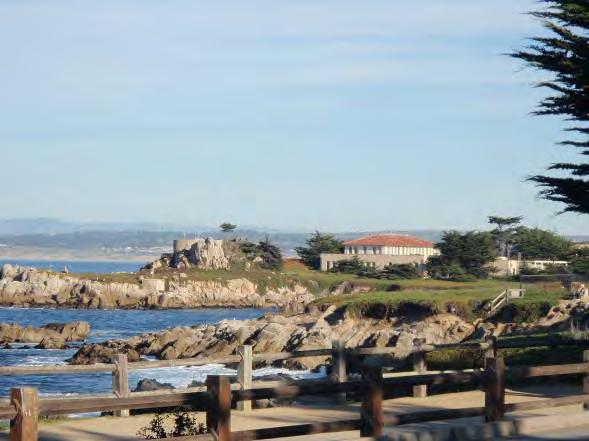
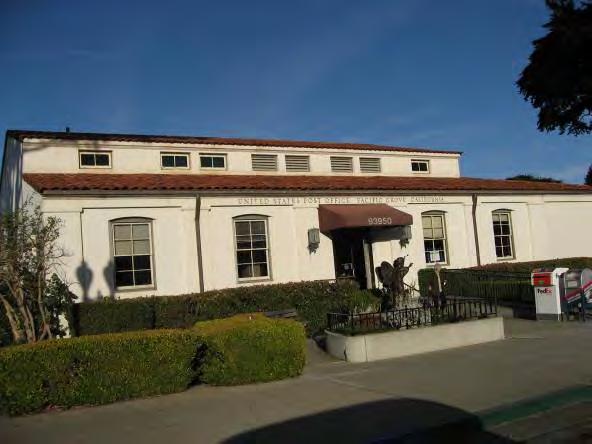
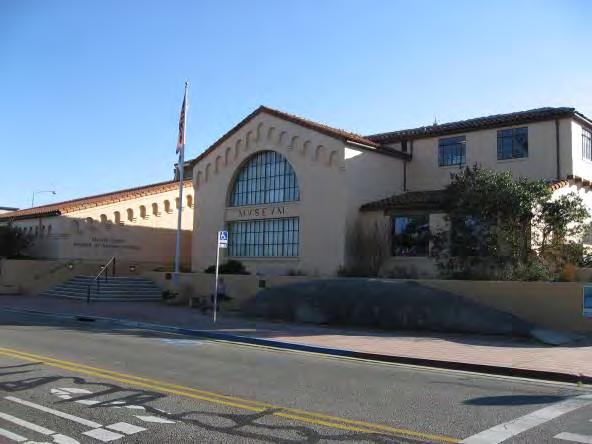

Significance
The table below discusses the significance of civic & public assembly buildings from this era according to criteria established by the National Register of Historic Places, California Register of Historical Resources, and the Pacific Grove Municipal Code. It appears that most of the surviving civic and public assembly buildings from this period are already listed on the City of Pacific Grove’s Historic Resources Inventory. The exceptions are the former Theosophical Society Hall and the Odd Fellows Hall.
Top: Pacific Grove High School Auditorium (left) and Pacific Grove Museum (right) Bottom: Pacific Grove Post Office (1938, left) and Hopkins Marine Station (right)
Historic Context Statement – Final City of Pacific Grove Historic Context (1927 – 1945) Pacific Grove, California 31 October 2011 Page & Turnbull, Inc. 232
National/ California Register PG Municipal Code §23.76
Significance
A/1 A, B Events, Patterns & Trends
B/2 C Persons
Architecture/ Design
Discussion
Civic & public assembly buildings from this period may be significant as expressions of civic and cultural values tied to Depression-Era development of the city. These buildings, whether funded privately or through government work programs, symbolized the ability of Pacific Grove’s citizens to act collectively during a period of extreme economic hardship, and their significance is enhanced by their relative scarcity. Civic & public assembly buildings may also be significant under this criterion for their association with social, community, or ethnic groups.
Please note that historic significance for a church or other religious property cannot be established on the merits of a religious doctrine, but rather on secular terms for its architectural or artistic values or as a representation of important historic or cultural forces.
Civic & public assembly buildings from this period may be significant for their association with persons important to Pacific Grove’s history. If this is the case, however, the building should be compared to other associated properties to identify which property(s) best represent that person’s achievements or reasons for being significant.
Civic & public assembly buildings from this period may be significant for their architecture, as expressed by intact stylistic features, forms or construction methods. In particular, the Pacific Grove Museum, Post Office and High School Auditorium are among the finest examples of Spanish Colonial Revival design in the city. Buildings may also qualify as the work of a master architect or prominent builder, such as William Weeks. Individual resources qualified under these criteria should be good examples of types and/or styles, and retain most of their original features.
D/4 Information Potential Buildings, ruins or subsurface remains that have the potential to yield important information about construction methods and materials, or the evolution
City of Pacific Grove Historic Context 1945) Pacific Grove, California Turnbull,
C/3 D, E, F, G, H, I, J, K
Historic Context Statement – Final
(1927 –
31 October 2011 Page &
Inc. 233
National/ California Register Municipal Code §23.76 Significance
Discussion
of local building development may be significant for their potential to provide information important to history. However, such examples would be extremely unlikely.
As mentioned previously, if a church from this period is to be considered for listing in the National Register, it must also meet National Register Criteria Consideration A, which deals specifically with religious properties (see National Register Bulletin #15 – How to Apply the National Register Criteria For Evaluation). This information may also prove useful in evaluating the significance of a church for inclusion in the state or local register. Additionally, please note that under California Assembly Bill 133, a religious property cannot be listed in the Pacific Grove HRI above the objection of the religious institution.
Integrity
In order to be eligible for listing in the local, state, or national historic registers, a civic & public assembly building must retain sufficient integrity to convey its significance as part of development during this period. While most buildings undergo change over time, alterations should not significantly change the essential historic character of the buildings. The aspects of integrity deemed most important for this period are location, design, materials, association and feeling.
Buildings would typically meet the threshold for addition to the local register if they meet the minimum eligibility requirements. Buildings qualified as individual resources at the state or national level should retain a substantial majority of their original features.
Minimum Eligibility Requirements:
Clear example of civic and public assembly architecture of the period.
Retains original form and roofline Substantially retains the original pattern of window and doors
Retains some of its original ornamentation. (The retention of entry, window and/or roofline ornamentation should be considered most important)
Replacement of doors and windows may be acceptable as long as they conform to the original door/window pattern and the size of the openings
Retains original cladding (or the original cladding has been repaired/replaced in kind such that it substantially duplicates the original pattern)
Other Integrity Considerations:
Rear additions that have respected the scale of the original building are generally acceptable. However, additions that compromise a building’s form and massing are not acceptable.
Historic Context Statement – Final City of Pacific Grove Historic Context (1927 – 1945) Pacific Grove, California 31 October 2011 Page & Turnbull, Inc. 234
PG
Historic Context Statement Final
City of Pacific Grove Historic Context (1927 – 1945) Pacific Grove, California
INDUSTRIAL & LIGHT INDUSTRIAL PROPERTIES
Industrial development during this period was quite sparse, and only a few light industrial buildings dating to this period appear to be extant. However, this period also witnessed the construction of Pacific Grove’s largest surviving industrial facility: the American Can Company, which filled the entire block bounded by Dewey, Sloat, Eardley and Ocean View Boulevard.
Other than the American Can Company building, light industrial facilities of this period followed earlier precedents in design and materials. Most were one story height and comprised of wood frame or reinforced concrete construction. Roofs are typically gable, and stucco finishes are most common. Most are also utilitarian in design, and typically featured at least one large entrance bay to allow for the passage of vehicles. Original windows would have most typically incorporated industrial steel sashes with awning or hopper mechanisms.
Light industrial buildings of this period are typically located in proximity to the downtown area, but examples may also be found at the extreme western edge of the city along Central Avenue near the Monterey border.
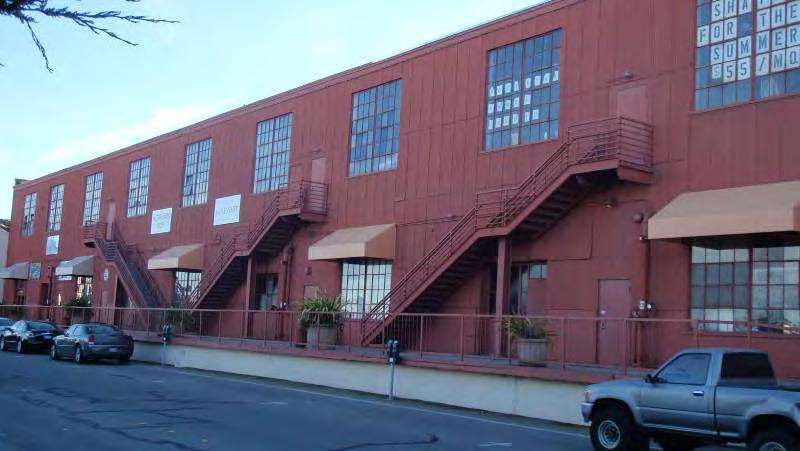
Significance
The table below discusses the significance of industrial buildings from this period according to criteria established by the National Register of Historic Places, California Register of Historical Resources, and the Pacific Grove Municipal Code. It is unclear how many industrial buildings of this period are currently listed on the City of Pacific Grove’s Historic Resources Inventory, although the former American Can Company is included.
National/ California Register PG Municipal Code §23.76
Significance
A/1 A, B Events
Discussion
Industrial buildings from this period may be significant for their associations with industrial development
American Can Company building, Ocean View Boulevard
–
31 October 2011 Page & Turnbull, Inc. 235
City of Pacific Grove Historic Context (1927 – 1945) Pacific Grove, California
National/ California Register PG Municipal Code §23.76 Significance
Discussion
during this period, particularly as it relates to themes including the development of Cannery Row. Industrial facilities repurposed for new used during World War II may also be significant for those associations, although no extant examples are known.
B/2 C Persons Industrial buildings from this period may be significant for their association with persons important to Pacific Grove’s history. If this is the case, however, the building should be compared to other associated properties to identify which property(s) best represent that person’s achievements or reasons for being significant.
C/3 D, E, F, G, H, I, J, K Architecture/ Design Industrial buildings from this period may be significant for their architecture, as expressed by intact stylistic features, forms or construction methods. Buildings may also qualify as the work of a master architect or prominent builder. Individual resources qualified under these criteria should be good examples of types and/or styles, and retain most of their original features.
D/4 Information Potential Buildings, ruins or subsurface remains that have the potential to yield important information about construction methods and materials, or help demonstrate the evolution of local industrial development. However, such examples would be exceptionally rare.
Integrity
In order to be eligible for listing in the local, state, or national historic registers, an industrial property must retain sufficient integrity to convey its significance as part of development during this period. While most buildings undergo change over time, alterations should not significantly change the essential historic character of the buildings.
Buildings would typically meet the threshold for addition to the local register if they meet the minimum eligibility requirements. Buildings qualified as individual resources at the state or national level should retain a substantial majority of their original features.
Minimum Eligibility Requirements:
Clear example of industrial architecture from this period
Historic Context Statement – Final
31 October 2011 Page & Turnbull, Inc. 236
Retains original form and roofline
Retains original work bays/vehicular openings
Retains original cladding (or the original cladding has been replaced in kind and substantially duplicates the original pattern)
Substantially retains the original pattern of windows and doors
CULTURAL LANDSCAPE ELEMENTS
Cultural landscapes from this period may include designed landscapes such as the Pacific Grove Golf Links (1931) and other public parks. Items from this era might also contribute to a cultural landscape at Lovers Point, first established during previous periods. As in previous periods, site features such as retaining walls, fences, and large specimen trees associated with a residence should be evaluated in conjunction with that residence. Similarly, landscaped or designed grounds of a church or other institutional facility should be evaluated in conjunction with those properties.

Character-defining features that may collectively contribute to a cultural landscape from this period include:
Topography
Vegetation
Circulation (e.g. roads, paths, steps, and walls)
Site features and objects (e.g. fences, benches, lights, and sculptures)
Structures or buildings
Recreational use
Significance
The table below discusses the significance of cultural landscapes from this era according to criteria established by the National Register of Historic Places, California Register of Historical Resources, and the Pacific Grove Municipal Code. These properties do not appear to be listed in the City of Pacific Grove’s Historic Resources Inventory.
Pacific Grove Golf Links
Historic Context Statement – Final City of Pacific Grove Historic Context (1927 – 1945) Pacific Grove, California 31 October 2011 Page & Turnbull, Inc. 237
City of Pacific Grove Historic Context (1927 – 1945) Pacific Grove, California
National/ California Register PG Municipal Code §23.76
Significance
Discussion
A/1 A, B Events, Patterns & Trends Cultural landscapes from this period may be significant as illustrations of the city’s important Depression-era civic improvements, namely the new public ownership and management of the city’s key recreational facilities. Landscapes may have been the site of an important event.
B/2 C Persons Cultural landscapes from this period may be significant for their association with persons important to Pacific Grove history, such as Mayor Julia Platt, or other city officials. If this is the case, however, the site should be compared to other associated properties to identify which property(s) best represent that person’s achievements or reasons for being significant.
C/3 D, E, F, G, H, I, J, K Architecture/ Design Cultural landscapes from this period may be significant for their distinctive design values. In order to qualify under this criterion, the landscape must be purposefully designed, and must clearly express aesthetic principles or technological achievements in city planning, landscape architecture, engineering, or sculpture. These properties may also be significant if they represent the work of a master landscape architect.
D/4 Information Potential Cultural landscapes from this period are not likely to yield important information not available in built resources or other extant documentary evidence.
Integrity
In order to be eligible for listing in the local, state, or national historic registers, a cultural landscape must retain sufficient integrity to convey its association with development tends during this period. Even more so than buildings, cultural landscapes—especially vegetation—are anticipated to experience change over time. An understanding of the landscape as a continuum through history is therefore critical in assessing its cultural and historic value, and a clear definition and understanding of the landscape’s period of significance is essential. In order for the landscape to have integrity, these character-defining features or qualities that contribute to its significance must be present. Landscapes qualified as individual resources at the local, state or national level should generally retain a majority of their original features. In some cases, changes subsequent to this period of development—such as the addition of the “back nine” to the Pacific Grove Golf Links in the 1950s—may not be a detriment to the landscape’s integrity.
Historic Context Statement – Final
31 October 2011 Page & Turnbull, Inc. 238
Historic Context Statement – Final
City of Pacific Grove Historic Context (1946 – 1966) Pacific Grove, California
F. Suburban Expansion (1946 -1966)
The post-war years in Pacific Grove ushered in the largest and most rapid expansion of the city’s population in its history. Population figures given in city directories show the city’s pre-World War II population of around 6,000 had grown to 8,750 by 1947. By 1953 the population grew to nearly 11,000, and by 1960 would reach 12,000—as well as an additional 4,140 people in the suburban area, which included Del Monte Park (1,855) and the Monterey Country Club (2,285).This had a wide range of repercussions, including the rapid development of new residential subdivisions, as well as new civic, commercial and religious facilities. The primary themes and events of this period include:
The post-war growth of the city, primarily in the form of single-family residences constructed in the hills south of downtown and along the city’s western edge. This includes a departure from the original grid layout of streets, as well as the build-out of older subdivisions where development had previously been sparse.
The proliferation of hotels and motels, as well as the increasing construction of multi-family dwellings throughout the city.
Expansion of civic infrastructure to accommodate growth, including new schools, a city yard, and firehouse.
The continued impact of automobiles on the city, including the clearance of older buildings for parking lots.
Infill and redevelopment of the central business district, as well as commercial development of Forest Avenue.
Redevelopment of the beach area at Lovers Point.
Extant properties capable of representing these significant themes include residential properties, commercial properties, motels & cottage courts, civic & public assembly properties, and light industrial properties. Of these, civic & public assembly buildings are most likely to distinctively embody characteristics of Modern architectural styles. There do not appear to be any significant cultural landscapes from the post-war period. Few resources constructed during this period are currently listed on the City of Pacific Grove’s Historic Resources Inventory.
31 October 2011 Page & Turnbull, Inc. 239
Historic Context Statement – Final City of Pacific Grove Historic Context (1946 – 1966) Pacific Grove, California 31 October 2011 Page & Turnbull, Inc. 240 DAVID 17 MILE SINEX FOREST 9OCEANVIEW TH 16TH A S L O M A R LINE 117TH 9TH 7TH 18TH PICO CEDAR GIBSON 8TH IRVING PRESCOTT JEWELL 4TH PINE CONGRESS MASON OAK 6TH CENTRAL JUNIPERO LILY 11TH 12TH 10TH RECTRAIL WALNUT PARK FOUNTAIN CARMEL AGRAND LDER LAINE 5TH HWY68 3RD SU NSET WOOD HOFFMAN EARDLEY 2ND C R O C K E R 1ST 15TH GRO V E ACR E BELDEN 13TH SURF ARCHER LOCUST DELMONTE WILLOW M A J E L L A SPENCER BALBOA MILES BAYVIEW HIGH ALICE FOREST LODGE WITHERS SFBMORSE GRANITE CREST SHELL EGAN LINCOLN HILLCREST MONTEREY TERRY SKYLINE FUNSTON JESSIELOBOS CLAY CHESTNUT LOTTIE SPRUCE GRACE RIPPLE TAYLOR HARRISON PARCEL MAPLE FRANKLIN HELLAM VIA DELREY LYNDON FILMORE A R M Y SEAVIEW CYPRESS ROOSEVELT EVANS PR IVAT E B OL IO MORSE MERMAID NEWTON SYIDA BENITO SLOAT MELROSE LAWTON DRAKE SEAPALM SHAFTER PR ES DIO JOHNSON RA NS FO RD PACIFIC DENNETT CORAL HAWTHORNE MONTECITO ORTEGA RIDGE SHORT FOAM MCCLELLAN 14TH DEVISADERO JEFFERSON S T I L L W E LL FITCH AUSTIN STUART ARENA ORD RIFLE RANGE MADISON BEAUMONT SP RAY MACARTHUR CRAMDEN SERRA DEWEY HE RR MA NN R A I LR O A D R I G H T O F W AY RICKETTS ROW E V E R G R E E N SIREN DRYCREEK LEWIS GROVE HILLSIDE LIGHTHOUSE SPAZIER CPL EVANS TIMBER BWAINWRIGHT ISHOP BE NTLEY PATTERSON CHAPARRAL BEACON RACCOON RUTH ACACIA GATE LAUREL 20TH OLMSTEAD PINE HILL BRIGGS A C R O P O L S CABRILLO SGTFRONIUS BOWEN ROSEMONT PLUM ME R MARINO PINES COLTON CALEDONIA SAGE PIEDMONT FINFANTRY OREST HILL CPL EVANS EL C AL LE JO NE GLENLAKE V A D EL P I NA R KIT CA RS ON HACHIYA TR EASURE MONARCH KENET PAR AD ISE PAR K DAY SPANISH BAY PETRA TANGLEWOOD PAC I F C G R OV E UNION TODD AIR OFORCE TTER MORELAND ADOBE CLARK CAFFREY GARDEN WALCOTT L A U RI E ACORN LA SELVA CH UA LA R AVALON LORELEI NAVAJO FOREST PARK MARINE MOSS 19TH H E R R M A N N PINE PINE CYPRESS 13TH SUNSET MC CL EL LA N PRESIDIO PIEDMONT CROCKER JEWELL RANSFO RD PRESIDIO 14TH 14TH LIGHTHOUSE 2ND 2ND LAUREL PARK LOBOS NEWTON LAWTON RANSFORD LIGHTHOUSE OAK SHELL SHORT SPRUCE SLOAT FITCH CONGRESS CityofPacificGrove YearBuilt:1946-1966 1946-1949 1950-1951 1960-1966 Page&Turnbull,Inc./24June2011 ° Properties constructed during “Suburban Expansion” period (1946-1966) (Page & Turnbull)
Historic Context Statement – Final City of Pacific Grove Historic Context (1946 – 1966) Pacific Grove, California 31 October 2011 Page & Turnbull, Inc. 241 DAVID 17 MILE SINEX FOREST 9OCEANVIEW TH 16TH A S L O M A R LINE 117TH 9TH 7TH 18TH PICO CEDAR GIBSON 8TH IRVING JEWELL PRESCOTT 4TH PINE CONGRESS MASON OAK 6TH CENTRAL JUNIPERO LILY 11TH 12TH 10TH RECTRAIL WALNUT PARK FOUNTAIN CARMEL AGRAND LDER LAINE 5TH HWY68 3RD SU NSET WOOD HOFFMAN EARDLEY 2ND C R O C K E R 1ST 15TH G RO V E ACR E 13TH BELDEN SURF ARCHER LOCUST DELMONTE WILLOW M A J E L L A SPENCER BALBOA MILES BAYVIEW HIGH ALICE FOREST LODGE WITHERS SFBMORSE GRANITE CREST SHELL EGAN LINCOLN HILLCREST MONTEREY TERRY SKYLINE FUNSTON JESSIELOBOS CHESTNUT LOTTIE SPRUCE CLAY GRACE RIPPLE TAYLOR HARRISON PARCEL MAPLE FRANKLIN HELLAM VIA DELREY LYNDON FILMORE A R M Y SEAVIEW CYPRESS ROOSEVELT EVANS PR IVAT E B OL IO MORSE MERMAID NEWTON SYIDA BENITO SLOAT MELROSE LAWTON DRAKE SEAPALM SHAFTER PR ESIDIO JOHNSON RA NS FO RD PACIFIC DENNETT CORAL HAWTHORNE MONTECITO RIDGE ORTEGA SHORT MCCLELLAN 14TH FOAM DEVISADERO JEFFERSON S T L L W E LL FITCH AUSTIN STUART ARENA ORD RIFLE RANGE BEAUMONT MADISON SP RAY MACARTHUR CRAMDEN SERRA DEWEY HE RR MA NN R A I LR O A D R G H T O F W AY RICKETTS ROW E V E R G R E E N SIREN DRYCREEK LEWIS GROVE HILLSIDE LIGHTHOUSE SPAZIER TIMBER CPL EVANS BWAINWRIGHT ISHOP BE NTLEY PATTERSON CHAPARRAL BEACON RACCOON RUTH ACACIA GATE LAUREL 20TH OLMSTEAD PINE HILL BRIGGS A C R O P O L S CABRILLO SGTFRONIUS BOWEN ROSEMONT MARINO PINES PLUM ME R CALEDONIA SAGE PIEDMONT FOREST HILL CPL EVANS EL C AL LE JO NE INFANTRY GLENLAKE V A D EL P I NA R KIT CA RS ON HACHIYA TR EASURE MONARCH KENET PAR AD IS E PAR K DAY SPANISH BAY PETRA TANGLEWOOD PAC I F C G R OV E UNION TODD AIR OFORCE TTER MORELAND ADOBE CLARK CAFFREY GARDEN WALCOTT L A U RI E ACORN LASELVA CH UA LA R AVALON LORELEI NAVAJO FOREST PARK MARINE MOSS 19TH H E R R M A N N PINE PINE CYPRESS 13TH SUNSET MC CL EL LA N PRESIDIO PIEDMONT CROCKER JEWELL RANSFO RD PRESIDIO 14TH 14TH LIGHTHOUSE 2ND 2ND LAUREL PARK LOBOS NEWTON LAWTON RANSFORD LIGHTHOUSE OAK SHELL SHORT SPRUCE SLOAT FITCH CONGRESS CityofPacificGrove Subdivisions&Annexations (1946-1966) Page&Turnbull,Inc./24June2011 ° LES TON N DelMontePark (1951) OREST IHIL EDMONT L ForestHill (1957) 4T STEAD E ForestAvenueTract (1950s) PowersSubdivision (1950s) NinePondsPark (1960s) BeaufordPlace (1950s) IDGE MeltonPark (1963) WELL PineGarden (1950s) WeldonGrove (1950s) SunshineCourt (1950s) PedersenCourt (1960s) WorkmanTracts (1955) ES UNSET N MarinoPines (1955) NEX IIBSON Rosemont (1950s) CROCKE O R GroveAcre (1955) EMO A T C Subdivisions and additions recorded during “Suburban Expansion” period (1946-1966). Many of these post-war tracts were further subdivided from older plats. (Page & Turnbull)
Historic Context Statement – Final City of Pacific Grove Historic Context (1946 – 1966) Pacific Grove, California
RESIDENTIAL EXPANSION
In the fifteen years following the end of World War II, residential development in Pacific Grove was as intensive as it had ever been in the city’s history. This not only included suburban-type developments in areas such as Del Monte Park, but also included the build out of areas subdivided decades before, such as the Beach Tract and Pacific Grove Acres. A large amount of development also appeared as infill construction in lots in the original Retreat, as well as the First through Fifth additions to the city.
Geographic Information System (GIS) analysis using construction dates provided by the Assessor’s Office indicates that approximately 723 buildings were constructed during the 1940s, rising to 1,302 during the 1950s. By comparison, these numbers exceed all the extant buildings in Pacific Grove constructed between 1870 and 1940.
Build-Out & Further Subdivision of Existing Neighborhoods
Within the city limits, the majority of new development took place in the Fairway Homes, Beach Tract and Pacific Grove Acres subdivisions, all of which had been platted years earlier by the Pacific Improvement Company or by Del Monte Properties. During the late 1940s, Jewell and Egan avenues adjacent to the Golf Links were largely built out, as were many lots to the north along Crest Avenue. By the close of the 1950s, however, nearly all the lots in the Beach Tract had been developed, as well as significant areas in Pacific Grove Acres. Here, much of the focus was centered on Pico, Grove Acre and Crocker avenues, with much less development occurring west of Asilomar Avenue.
As opposed to the Beach Tract, which had been subdivided in 1919 and typically featured much smaller lot sizes, residential development at the west end of the city reflected the larger lots sizes, which more easily accommodated the sprawling Ranch style designs that became popular in California after the war. Houses were sited much deeper on their lots, and there was less need to clear trees. Thus, today the west end of Pacific Grove still retains large portions of the original pine forest, while the small lots of the original Retreat meant that the majority of trees in the “Piney Paradise” had to be removed in order to make way for development.
Several of the larger, multi-acre parcels in Pacific Grove Acres were developed as small subdivisions during the 1950s and early 1960s. This included the Marino Pines, Powers, and Workman Tract subdivisions, all opened around 1955 at the city’s southern limits and built out by the end of the decade. The lot sizes in these new subdivisions were generally much larger than the 30 x 60 lots that characterized the older, 19th century subdivisions. For example, the Powers Subdivision was comprised of seven, approximately 62 x 90 foot lots, while the adjacent Marino Pines Subdivision featured lots as large as 68 x 190 feet. Such lots could accommodate larger homes, as well as provide space for front and backyards—both attractive features for families during the post-World War II “baby boom.” A few concentrated developments also occurred within more established neighborhoods. This included the wholesale development of the block bounded by Alder, Walnut, Junipero and Gibson avenues during the late 1940s. Similarly, a small strip at the eastern edge of the
31 October 2011 Page & Turnbull, Inc. 242
city was also built out at this time, comprised of the area east of 2nd Street between Sinex and Junipero avenues. However, because the layout of these neighborhoods reflects the City Beautiful movement, not post-war suburban trends, the residences in these areas are generally not able to accurately demonstrate the post-war suburban development theme.
New Suburbs
The late 1940s also marked the period when residential construction increasingly focused on undeveloped areas in the hills adjacent to Forest Avenue. This area had already been home to sporadic development, particularly in the Country Club Heights area along Beaumont and Morse streets, where scattered buildings had been constructed as early as the 1920s and 1930s. At this time, the city’s southern limit ran roughly along the lines of Marino Pines, and Sunset Drive was frequently referred to as the County Road. Following the war, however, the area developed in earnest, as did the Ocean View Terrace, Sea View Terrace and Presidio Terrace subdivisions to the southeast, located in an area roughly bounded by David, Divisadero, Bishop and Forest avenues. In particular, Seaview Avenue appears to have been developed wholesale during the late 1940s.
Development then moved south and west into what is today Del Monte Park, opened around 1950. This area was then outside the city limits, and had previously been occupied by the Pine Ridge
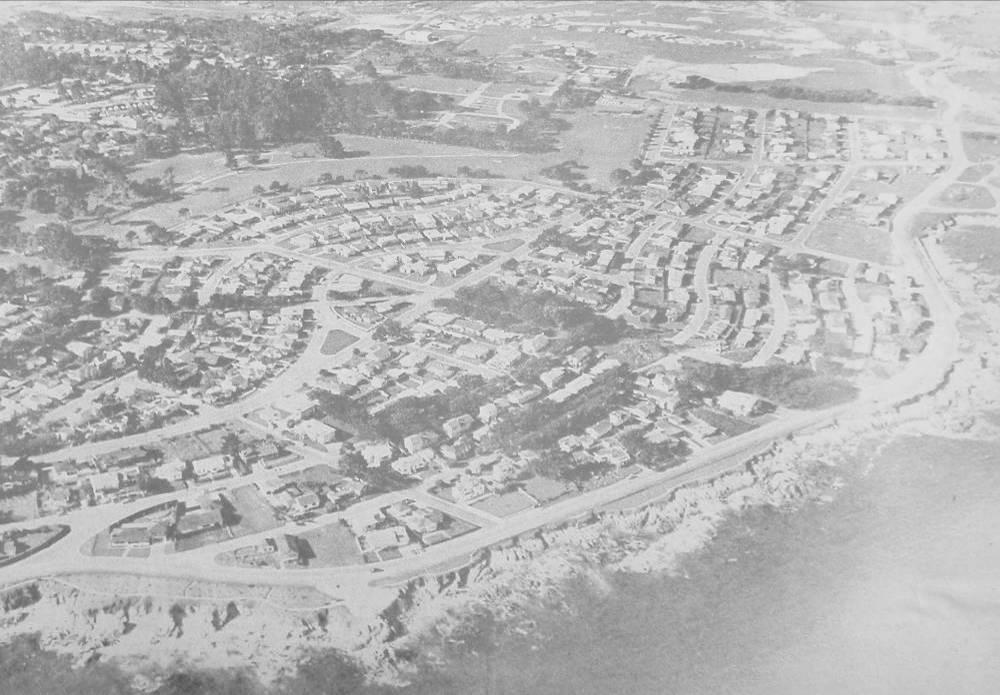 1961 Aerial Photograph, showing post-war build-out of the Beach Tract, which had been subdivided in 1919 (Monterey Peninsula Herald, 8 May 1961)
1961 Aerial Photograph, showing post-war build-out of the Beach Tract, which had been subdivided in 1919 (Monterey Peninsula Herald, 8 May 1961)
Historic Context Statement – Final City of Pacific Grove Historic Context (1946 – 1966) Pacific Grove, California 31 October 2011 Page & Turnbull, Inc. 243
Historic Context Statement – Final City of Pacific Grove Historic Context (1946 – 1966) Pacific Grove, California
Dairy, which traced its origins to a ranch first developed by Felipe Neri Gomez in the 1870s. Following Gomez’s death in 1907, part of his land—known as the Gomez Tract—was purchased by Louise Dobbins, who developed a dairy on the property. It was subsequently sold several times, and in 1924 became known as the Pine Ridge Dairy.502 Another part of the Gomez Ranch was developed as the Pacific Grove Nursery, opened in 1920 by Murray White. Shortly before the opening of Del Monte Park, a sawmill operated by the General Box Company also operated between 1949 and 1950 on a parcel south of Shafter Avenue.503
Following its subdivision, Del Monte Park developed rapidly. By 1954, the loop area around Syida Drive, Benito Court and nearby Kenet Place were all built out, followed by the build out of the area encircled by Forest Hill Boulevard, Pine Circle and Ransford Avenue in 1957. By 1960, most of the residential lots east of Montecito and south of Miles Avenue had all been developed, although sporadic infill also occurred during the 1960s and later. It was not until 1972, however, that Del Monte Park was annexed by the city.
Del Monte Park developed as a prototypical suburban-style development of the 1950s, employing curving streets, loops and cul-de-sacs, which wholly rejected the urban grid. The influence of the automobile is also readily apparent, with nearly all houses featuring paved driveways and integral garages. Despite this orientation to car travel, however, houses were also sited much farther back from the street than they had been during earlier periods of city’s history. This provided space for landscaped front yards, which by this time were considered a necessary amenity by most home buyers. Another characteristic of Del Monte Park—as well as many other mid-century subdivisions—is that there is also almost no interaction between residential and commercial areas; residents would drive to go shopping, not walk. The only notable exception in Del Monte Park was Phillip’s Park Grocery, opened in 1949 in a small hip-roofed building at 1202 Shafter Avenue (extant).
Generally speaking, most of Pacific Grove’s mid-century residences employed relatively simple designs—quite frequently variants of the Ranch or Modern Contemporary styles.504 This included several “post-adobe” buildings, named for a construction method developed by Carmel builder Hugh Comstock during the 1930s and 1940s. Comstock used timber framing in-filled with watertight adobe bricks, and in 1948 published an instructional booklet about the technique.505 It was adapted by at least a few builders in Pacific Grove, including Phil Haskins, who in 1950 built the first post-adobe house in Pacific Grove at 888 Maple Street (extant).506 Local historian Kent Seavey states that several other examples are extant, including several along Maple Avenue and Bishop avenues, as well as along Forest Avenue in the Forest Hill area.
A few high-style Modernist residences were also constructed in Pacific Grove. This includes the Kong House, designed by noted Carmel architect, Marcel Zedletsky, and constructed at 859 Seapalm Avenue in 1961.508 Zedletsky practiced in the Monterey area between 1960 and 1974, and subsequently became an instructor at California Polytechnic State University in San Luis Obisbo.
31 October 2011 Page & Turnbull, Inc. 244
507
COMMERCIAL DEVELOPMENT
As described above, residential development during the post-war era accommodated an increasing reliance on the automobile, and corresponding changes occurred to the design of commercial properties. In Pacific Grove, this car-focused lifestyle resulted in the construction of new commercial building types, such as large gas stations and shopping centers with expansive surface parking, especially along Forest Avenue.
Other than Phillip’s Park Grocery, the closest shopping options for residents living in Del Monte Park area was the new commercial strip developing along Forest Avenue south of David Avenue. Almost certainly, this area developed with an overtly commercial character because of its proximity to the large volume of automobile traffic along Forest Avenue. Among the earliest business to locate there was the Forest Hill Court Store, opened in 1949 by Dode and M. A. Davis at 1188 Forest Avenue (extant). This location was then outside the city limits, and thus the store was able to offer a “complete line of liquors.” The building was constructed at the rear of a commercial court that included three other establishments facing a large parking area.509 As opposed to the other buildings, however, the Forest Hill Court Store was constructed in a decidedly Modern style, with a slanted shed roof that rose from back to front.
By 1951, the new Forest Hill Market was completed to the south, along with a new Chevron gas station at Forest Avenue and Prescott Lane in 1952.510 By the end of the 1950s several more commercial buildings were constructed on the east side of Forest Avenue, although pinpointing the exact extent of development is hampered by a lack of Sanborn maps for the area.
New commercial buildings also appeared in downtown Pacific Grove during this period, including the Super Save Market at 242 Forest Avenue, today known as the Grove Market. Constructed circa 1955, the building is one of Pacific Grove’s most distinctive Modern-style structures, featuring concrete arches supporting a barrel vaulted roof, and wide expanses of window glass. Commercial buildings such as this may be significant as examples of mid-century modern architectural styles.
MIDCENTURY REDEVELOPMENT
The two decades following World War II was a period of buoyant growth, both in Pacific Grove and across the country. While much of this growth occurred in suburban settings, downtown areas were also redeveloped. In large part this was deemed necessary in order to replace outmoded buildings with new facilities. However, a tremendous amount of pressure also came from the growing ubiquity of the private automobile, which forced downtown businesses to provide parking in order to compete with suburban shopping centers. Pacific Grove was fortunate in this respect, as it had already developed several parking garages by the 1920s, and vacant lots remained available in the central business district into the 1950s. Nevertheless, some buildings were demolished for parking lots during this period, and more would follow in the coming decades. The popularity of the
Historic Context Statement – Final City of Pacific Grove Historic Context (1946 – 1966) Pacific Grove, California 31 October 2011 Page & Turnbull, Inc. 245
Historic Context Statement – Final City of Pacific Grove Historic Context (1946 – 1966) Pacific Grove, California
automobile also pressured the railroads, and after nearly 75 years of service Pacific Grove would see the end of passenger rail service before the end of this period.
Downtown Demolitions
As early as 1949, Pacific Grove Planning Commissioner, Wilford R. Holman, recommended that the city “acquire for parking lots all except 100 feet of frontage on Lighthouse Avenue in lots bounded by (a) Laurel, 15th and Fountain, and (b) Laurel, 17th and 18th streets.”511 Although this plan was not adopted, several older buildings were subsequently demolished in order to create parking lots. These included the old Del Mar Hotel, demolished in 1953 to make way for the current Bank of America parking lot.512 Construction of the new L-shaped bank also necessitated the demolition of a twostory store that had been constructed in the 1890s, as well as a two-story flats building constructed around the turn of the century on 17th Street.
Similarly, the Security National Bank constructed by E. C. Smith in 1916 at 569 Lighthouse Avenue was enlarged during the early 1960s through the construction of a new two-story addition at the southeast corner of Lighthouse and Forest avenues.513 This new wing was designed to blend with the original bank design, including a continuation of the cornice at the roofline. To make way for the new bank wing, one of Pacific Grove’s oldest commercial buildings—a small one-story Western False Front-style grocery constructed around 1886 (the J. B. Norton Building)—was demolished.514
Some older buildings were also demolished because of safety concerns. In 1958, the building at 214 Grand Avenue—then in use by the Full Gospel Pentecostal Church—was declared in dangerous condition by city officials and ordered to be torn down within 90 days. This was another of Pacific Grove’s oldest buildings, having served as the Retreat’s first post office and later used by the Salvation Army during the 1920s. At the same time, the city also condemned two other buildings: a vacant store at 210 Grand Avenue (subsequently demolished), as well as a building at 216 Grand Avenue occupied by Walters Rug and Upholstery Cleaners. The building’s owner, Wilford R. Holman, asked for a postponement in order to complete renovations to the property, and it remains standing today.515
Doubtless the most iconic building to be demolished during this period was the old Methodist Episcopal Church and Assembly Hall at 620 Lighthouse Avenue. Built in 1889 as a successor to the Chautauqua Hall, it had initially served as the centerpiece of the summer retreat season and accommodated a multitude of functions over the ensuing decades. By the 1950s, however, the congregation appears to have outlived the space, and a 1956 tourist brochure mentioned that the building was for sale.516 In 1962 the congregation broke ground on a new church at 915 Sunset Drive, which was completed in 1963. That same year the old Assembly Hall was demolished and subsequently replaced by a commercial development. Around the same time, the First Baptist Church of Pacific Grove also replaced their church building (see section on Religious Development).
31 October 2011 Page & Turnbull, Inc. 246
Historic Context Statement – Final City of Pacific Grove Historic Context (1946 – 1966) Pacific Grove, California
In 1965, another of Pacific Grove’s oldest and largest structures—the John Tennant Memorial Home at Forest and Sinex avenues—was demolished and subsequently replaced by the Canterbury Woods retirement home.517 Around the same time, the 1879 house built by Dr. Frank F. Jewell on the northwest corner of Forest Avenue and Park Place was torn down, having been described by some as a “firetrap.” 518
The redevelopment of some of Pacific Grove’s buildings also occurred by accident. In June 1951 a fire largely destroyed the Grove Theater, which was rebuilt the following year and later converted for use as stores and offices.519 Other buildings underwent changes in use. In 1954, CaliforniaNevada Methodist Homes purchased the Forest Hill Hotel and converted it into a retirement home.520 New buildings were also added to the hotel grounds around this time. Sanborn maps indicate that by 1962, a large wood frame dormitory had been constructed at the western end of the hotel grounds, while a new reinforced concrete health unit building was constructed on the south side.
The Railroad is Retired Passenger rail service had reached an all-time high during World War II, as soldiers were moved across the country from induction centers, to training camps, to ports of embarkation. But during the post-war era, the construction of new highways and popularity of the private automobile led to a steady decline in the number of passengers traveling by rail. This included the Southern Pacific’s operations in Pacific Grove, which by the 1950s were in severe decline. This stemmed from the simple fact that it had become much faster to reach the city by car. A tourist guide of the era mentions that the Southern Pacific’s Del Monte Special train arrived in Monterey at 7:00 p.m., unloaded for a half-hour, and then proceeded to Pacific Grove. Given the delay, the guide mentions that “Most people [traveling to Pacific Grove] are met at the Monterey S-P station … or go over by Bay Rapid Transit bus or in their own car.”521
In 1957 the Southern Pacific decided to cease passenger service to Pacific Grove, and the depot closed on September 15.522 The station sat idle for a number of years, and was subsequently burned down during a practice exercise by the Pacific Grove Fire Department in 1962. This was not the end of all rail operations, however. Special “sand trains” continued to make runs out to the sand mining operations near Lake Majella until the late 1970s.523 In part because of environmental concerns due to solid waste filtering onto Asilomar Beach, the sand plant was demolished in April of 1978, heralding the final end of rail operations.524 Today, the former railroad right-of-way east of Lovers Point has been redeveloped as a walking path. The former Homer T. Hayward Lumber Yard, located south of the railroad tracks was moved circa 1965 to a new location at Crocker and Sinex avenues, where it presently remains in business.
31 October 2011 Page & Turnbull, Inc. 247
CIVIC GROWTH
The tremendous post-war growth forced city officials to scramble to keep up with demands for public services, and over the next fifteen years the city would embark on a number of new civicrelated projects to support the growing number of residents.
As early as 1946, the city was already considering plans to construct a new fire station and bath house, as well as grappling with increasingly divisive zoning issues. This included considerable debate as to whether Pacific Grove should annex the Asilomar area in order to recoup fees for sewer connections.525 By 1949 there was also talk of a proposed annexation of the Hilltop Park area between Jessie and Devisadero streets in New Monterey.526
By this time the city had already commenced work on the projects contemplated in 1946. This included a new reinforced concrete fire station, located on the south side of Pine Avenue between 16th and 17th streets (extant). Previously, the fire department occupied a space in City Hall, but the new facility proved larger than City Hall itself, featuring a two-story wing on its west end and a three-story tower for drying hoses. Completed about 1949, the fire station replaced a Victorian era residence that had previously stood on the large lot.
Lovers Point Remade Again
Likewise, between 1948 and 1949 the beach facilities at Lovers Point were remade for the fourth time in sixty years. In 1948 a new snack bar was built on the south side of the Plunge, operated by Carol and Bert Walker, who also owned a restaurant where the Lovers Point Inn is located today.527
Also in 1948, Nathaniel Sprague, long-time owner of the glass bottom boat concession died, and his son John Russell Sprague took over the business, operating it until 1966.528
A comparison of Sanborn Maps from 1926 (left) and 1962 (right) illustrates the changes to the bathhouse and Lovers Point in the post-war era.
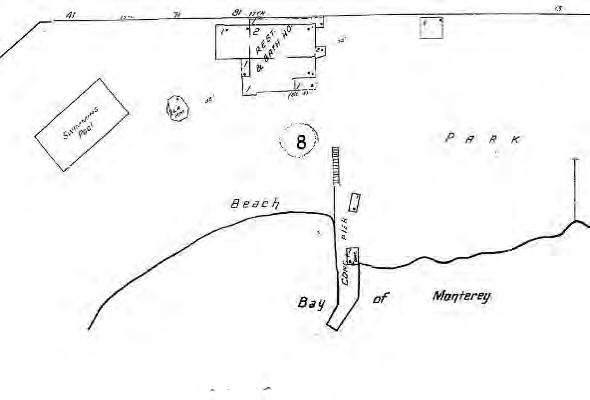
Far more major changes to Lovers Point arrived in 1949, when the City Council approved plans to construct a new bath house north of the Plunge in an area previously occupied by the Auditorium. The Robert Jones firm served as architects, while construction was handled by the F. C. Stolte Company. The Thomas A. Work lumber yard provided woodwork. Completed in July of that year
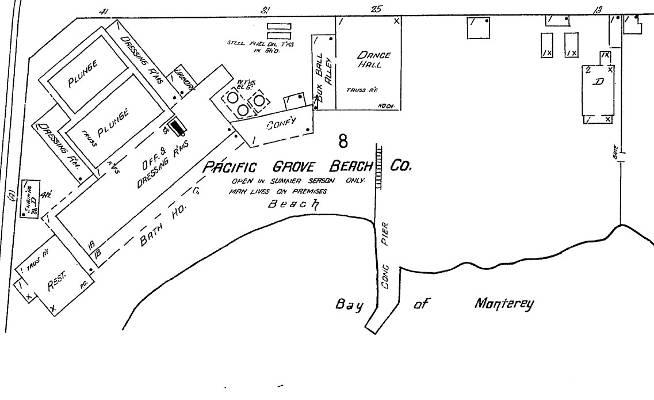
Historic Context Statement – Final City of Pacific Grove Historic Context (1946 – 1966) Pacific Grove, California 31 October 2011 Page & Turnbull, Inc. 248
Historic Context Statement – Final City of Pacific Grove Historic Context (1946 – 1966) Pacific Grove, California
at a cost of $47,000, the new bath house featured a restaurant called the Pacific Grove Bath House Soda Fountain and Lunch Room above the dressing rooms.529
The lunch counter was remodeled between 1959 and 1960 by new owner Sal Lucido and renamed Slats Roof Garden Restaurant. In 1969, this would become the first establishment in Pacific Grove to receive a liquor license. The building was remodeled again in 1975 and renamed the Old Bath House.530 Around the same time the municipal pool had fallen into poor condition and in 1973 was condemned. The city subsequently demolished the pool and installed volleyball courts and a wading pool in its place.531
New Schools
Given the tremendous growth of this period, as well as the post-war baby boom, it is not surprising that the city’s most ambitious projects during this period were all focused on school construction—a need made all the more acute after a large wing of the old Pacific Grove High School was destroyed by fire in 1946. As reconstruction efforts moved forward at the high school, two new elementary schools also opened. These included the new Lighthouse Elementary School, completed about 1948 on a parcel of land located southeast of the intersection of Lighthouse Avenue and Ridge Road (now the Pacific Grove Adult Education center at 1025 Lighthouse Avenue). The school was designed by Robert Stanton, and included a wood frame building constructed in a boomerang shape facing Lighthouse Avenue, as well as auxiliary classrooms to the south along Ridge Road.532 The building is largely utilitarian in design, although it does show some mild influences of Modern style architecture.
About 1952 the 17 Mile Drive Elementary School was constructed a short distance away at 224 17 Mile Drive (extant). This small facility included only two wood frame buildings, with one for administration and another for classrooms. During this same period, the need to accommodate recreational facilities for Pacific Grove’s children drove the construction of a new Youth Recreation Club, dedicated in 1950 by Bing Crosby and located directly adjacent to the west side of City Hall (no longer extant).533 Of interest, the Ketchum Barn located nearby at 607 Laurel Avenue (today headquarters of the Pacific Grove Heritage Society) is shown on Sanborn maps of the period as being used as tire storage for City Hall.
As the children of the post-war baby boom grew older, Pacific Grove also constructed a new high school in 1961 at 615 Sunset Drive near its intersection with Forest Avenue. This was the city’s largest educational facility to date, with a number of individual classroom wings, as well as large athletic fields that stretched west all the way to Congress Avenue. It featured a distinctly Modernist design, with low-slung gable roofs supported by concrete block columns, and classrooms illuminated by window walls. When completed, its construction allowed the old high school on Forest Avenue to be converted to a middle school.
At least until the late 1950s, the massive old high school auditorium constructed in 1931 continued to be used for concerts produced by the Monterey Peninsula Concert Association. Likewise, the old
31 October 2011 Page & Turnbull, Inc. 249
Historic Context Statement – Final City of Pacific Grove Historic Context (1946 – 1966) Pacific Grove, California
high school also hosted the Pacific Grove Adult School, which had begun in 1934 and was described as the most active in the state with 1,500 adults attending classes in everything from painting to marine biology to landscaping.534 Given the emphasis on adult education and music appreciation, it seems clear the some of the old impulses from the Chautauqua years still permeated the city’s cultural life.535
By 1962 the city’s Board of Education offices were housed in a circa 1910 two-story residence at 716 Lighthouse Avenue. Of interest, this building is labeled on a 1914 Sanborn map as having plaster on the outside—almost certain a reference to stucco. Today the building remains standing and is occupied by businesses, although it was somewhat altered after 1962 with the addition of a tower at the center of the roof.
City Maintenance Yard
Other city-funded projects of this era included the construction of a new yard for city work vehicles and other equipment near the Del Monte Sand Plant at Sunset Drive and Crocker Avenue. The plans were approved in 1957, and the land purchased from Del Monte Properties for $30,250. An additional $50,000 was earmarked for construction.536 Buildings slated for the new yard included garages and servicing facilities for city equipment, a warehouse, and shower facilities for sanitation crews. A related article from that same year states that originally the city had considered using part of Washington Park north of Pine Avenue for the yard, but met with large protests at the Pacific Grove Planning Commission meeting.537 The city yard is still in use today, operated by the Public Works Department and addressed as 2100 Sunset Drive.
New city infrastructure constructed around this time also included a Pacific Gas & Electric substation, built in 1958 on the west side of Grand Avenue between Spruce and Junipero avenues (extant). Although neighbors were not pleased with the development of a substation immediately adjacent to their homes, construction of the facility did not require demolishing any residences— only the relocation of a small, detached auto garage that had previously stood on the lot. The fact that large vacant lots persisted in the midst of blocks initially developed in the late nineteenth century and early twentieth century is indicative of Pacific Grove’s scattered development pattern during those periods.538
Municipal Golf Links
Another major civic project of the era was the expansion of the municipal golf course into a full 18hole course, begun in 1959. Constructed just below the Point Pinos Lighthouse on land leased from the Federal Government, the nine new holes were completed by 1961.539 The new section became the first nine holes of the course, while the original section became the back nine. At the time, the golf course clubhouse stood near Pacific and Jewell avenues, but would subsequently be moved to its present site near El Carmelo cemetery.540
31 October 2011 Page & Turnbull, Inc. 250
Asilomar Refurbished & Sold
Following the financial difficulties of the Great Depression and war years, the YWCA Asilomar Committee refurbished the camp in 1947 as a hotel and full-service conference facility. In 1951, however, Asilomar was put up for sale, which led local citizens to petition the State of California to acquire the facility for a park. The state indicated its interest in purchasing the nearby dunes for ecological reasons, but resisted the idea of taking over management of the buildings. As a compromise, the state agreed to take title to the property, but the leasing and management of the conference center would be the responsibility of the City of Pacific Grove. The official transfer took place on July 1, 1956, with the conference center and 91 acres of land becoming a new unit of the California State Park system.541
As part of the agreement between the State of California and the City of Pacific Grove, a non-profit entity was established to oversee Asilomar’s operations, with the Board of Directors initially composed of members of the Pacific Grove City Council. In the late 1950s, the Board directed San Francisco architect John Carl Warnecke to design a new twenty-year master plan for the facility, which would allow for the construction of several additional buildings over the coming years. In 1965, management of the non-profit agency was transferred to citizens appointed by the Pacific Grove mayor, and during the 1970s more than a dozen additional acres of land would be added to the park.542 Despite the close relationship between the City of Pacific Grove and Asilomar, the area
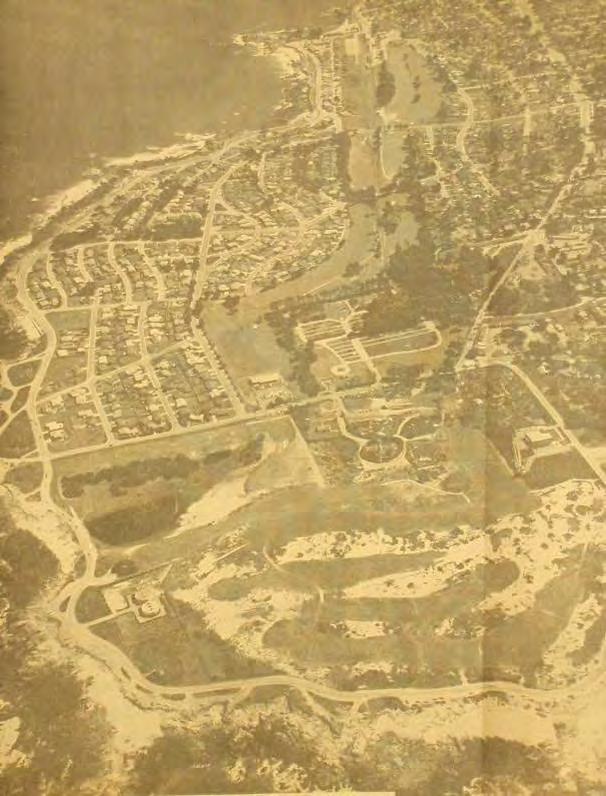 1961 aerial photograph showing the newly-expanded municipal golf links (Monterey Peninsula Herald, 9 August 1961)
1961 aerial photograph showing the newly-expanded municipal golf links (Monterey Peninsula Herald, 9 August 1961)
Historic Context Statement – Final City of Pacific Grove Historic Context (1946 – 1966) Pacific Grove, California 31 October 2011 Page & Turnbull, Inc. 251
Historic Context Statement – Final City of Pacific Grove Historic Context (1946 – 1966) Pacific Grove, California







would not be annexed to Pacific Grove until 1980.543 In 1987, the Julia Morgan-designed buildings were declared a National Historic Landmark.
Plans for a New Civic Center
One of the largest projects contemplated by the city in the late 1950s envisioned a dramatic redevelopment of the area around Jewell Park. In 1958 a bond issue was proposed to construct a new Civic Center on the block bounded by Park Place, Fountain Avenue, Grand Avenue and Ocean View Boulevard—an area then described as “blighted.” The Civic Center would face Jewell Park and include a new city hall, jail and police station surrounded by parking lots which could also be used by visitors to Lovers Point. The poor state of City Hall was cited as the primary reason for the redevelopment project, with a newspaper article stating that the “offices in the old city hall are little more than cubbyholes. The roof leaks and foundations are cracked.”544 Although the bond measure
1959 Asilomar Master Plan by John Carl Warnecke and Associates (Monterey Public Library, California History Room)
31 October 2011 Page & Turnbull, Inc. 252
City of Pacific Grove Historic Context (1946 – 1966) Pacific Grove, California
failed, it does speak to the desire of city government to modernize and improve its facilities during this period—an impulse which carried over into private businesses and religious facilities as well.
MOTELS AND COTTAGE COURTS
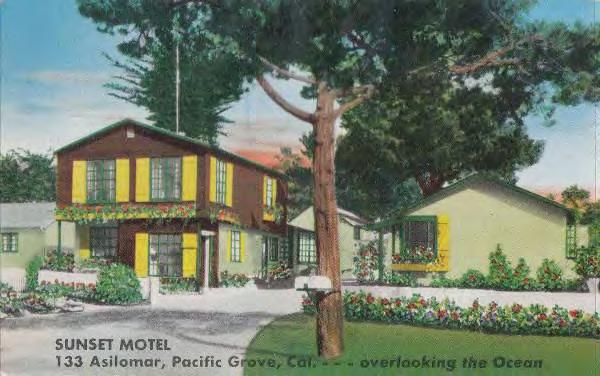

Pacific Grove continued to actively promote itself as a tourist-friendly resort area following World War II. City directories of the era repeatedly highlight the scenery, parks and recreational facilities, proclaiming Pacific Grove featured the “greatest number of public parks of any city of its kind in the state … a number of supervised children’s playgrounds … the tourist will find plenty to see and do … marine gardens, fishing, tennis and a municipal golf course. ” While the auto camps continued to be popular during this period—in 1956 the 17-Mile Drive Cottage Court counted 80 cottages and a trailer court—new motels and hotels were also constructed. These cottage courts and motels may be significant as representations of the continued development of auto-related tourist facilities during the post-war era, or may be important for their architectural design (especially if they served as prototypes for future properties).
Among the earliest and largest was Borg’s Motel and Apartments, constructed circa 1949 in what appears to be two phases. An article from 1948 indicates that R. R. Borg’s plans for a 23-unit apartment building on Lorelei Street were approved, which appears to be the eastern wing of the current motel complex, constructed on land formerly occupied by the Hopkins Marine Laboratory.545 This is a two-story wood frame building capped by a hip roof and designed in a shallow H shape to accommodate parking along Lorelei Avenue. The two-story gable-roofed wing on the north side of Lorelei Avenue was completed no later than 1956, when Borg’s is described as having “59 modern units.” Sanborn maps indicate this wing replaced the earlier Wave Apartments which had stood on the lot, and construction of the parking lot to the south forced the demolition or relocation of at least eight small cottages and several detached garages constructed around 1920. Altogether, Borg’s represented the largest motel constructed in Pacific Grove since the Forest Hotel in 1926.
Postcards for the Bide-A-Wee Motel (left) and Sunset Motel (right), 1950s (Courtesy Charles Huff)
Historic Context Statement – Final
31 October 2011 Page & Turnbull, Inc. 253
The majority of new tourist facilities, however, were concentrated at the west end of Lighthouse Avenue. These included Wilkie’s Motel (now Wilkie’s Inn) at 1038 Lighthouse Avenue, opened in 1955. The Butterfly Lodge at 1050 Lighthouse Avenue was also described as “comparatively new” in the 1956 city directory. By this time, the city counted four hotels, sixteen motels (primarily auto courts) and one trailer court.546 Along with Milar’s Motel, the Butterfly Lodge and Washington Park were also singled out as among the best places to see the Monarch butterflies during their annual migrations.547
Much as the new auto camps had stirred city government to restrain their growth during the 1930s, the construction of new motels and apartment complexes also raised zoning concerns during the 1950s. In the early post-war years, the city still had no master plan to guide its development. A 1946 newspaper article mentions that the Planning Commission typically met “only on special occasions, to argue requests for ‘spot zoning,’ report minor violations of the zoning law, and hear appeals from special interests.”548 However, the article does mention that the city adopted a “modern, unified building code” that year, and that the citizens benefited from zoning restrictions that prevented “rampant commercialism.”549
By 1958, the city had adopted a land use plan, but officials still found it difficult to deal with the rapid growth in an effective manner. Language from that plan stated in part that: “Zoning and rezoning is often considered and adopted in a piecemeal fashion, based only on its effect on property within a couple hundred feet. The effect that each change has on the entire city is seldom considered.” The plan concluded that “motel and apartment zoning is higher than warranted.” Nevertheless, population growth was deemed necessary to guarantee positive cash flow for the city, and the city projected that by 1980 the city would have a population of 23,000 residents.550
Construction of the Caribbean Motel (now the Lovers Point Inn) in 1964 set off a new round of debate about the city’s growth. The objection was not necessarily to having a new motel, but rather its architecture, with many residents complaining about the long blank wall on its south façade. Resident quotes in a contemporary news article ranged from, “It ruins the most attractive area of PG,” to “The front of it is beautiful, but the back is hideous.”551 The new building replaced the old Surfside Motel, which appears to have been composed of several small buildings on the west side of Mermaid Alley. The Caribbean Motel had also been given a variance to construct the 52-unit motel, where only 12 units were legally allowed.
Historic Context Statement – Final City of Pacific Grove Historic Context (1946 – 1966) Pacific Grove, California 31 October 2011 Page & Turnbull, Inc. 254
By this time the O. E. Chase Lumber Yard on the north side of the railroad tracks had been removed and the area was being redeveloped as the Monarch Pines Mobile Home Park. Designed as a retirement community, the mobile home park included bylaws restricting the age of owners to at least 55 years of age.552 Thus it would appear that Pacific Grove, as it had at the turn of the century, continued to attract a sizeable number of retirees. Homeowners within the park did not actually own the land, but rather purchased shares in a corporation which entitled them to use the space. Photos accompanying the newspaper article show that the park was only partially occupied in 1964, and that the railroad crossing sign was still up in accordance with the operations of the trains travelling to and from the sand mining operations at Lake Majella.
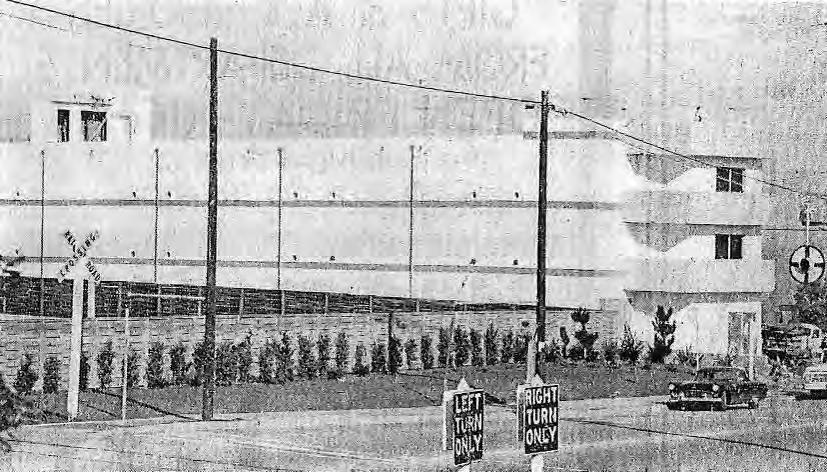
RELIGIOUS & COMMUNITY DEVELOPMENT
As the city expanded, many religious and community groups remodeled and added to their existing facilities, or built new buildings that were better-suited for life in a modern, post-war city. In fact, civic and public assembly properties from the post-war era comprise some of Pacific Grove’s best examples of modern architectural styles.
Fraternal Organizations
Since 1930, the majority of Pacific Grove’s civic and fraternal organizations had met in Work Hall, located in the Thomas Work Block on Lighthouse Avenue. This included the Masons, who continued to meet in the building until 1950 when they constructed their own Masonic Hall at 698 Central Avenue (extant).553 This large, L-shaped building featured concrete block construction clad with stucco, and replaced three tent cottages that previously occupied the lot. The building features a prominent front-facing gable, but has few windows and is largely unornamented save for a Masonic symbol applied to the façade. The Masonic Hall appears to have been developed in conjunction with the adjacent commercial building at 700 Lighthouse Avenue, which is shown as an office on the 1962 Sanborn map. Today, the Masonic Hall continues to be occupied by Pacific Grove Lodge #331 Free and Accepted Masons.
Caribbean Motel, 1964 (Monterey Public Library, California History Room clipping files)
Historic Context Statement – Final City of Pacific Grove Historic Context (1946 – 1966) Pacific Grove, California 31 October 2011 Page & Turnbull, Inc. 255
Churches
In 1956, St. Angela’s Church broke ground on a new church building, and by 1962 had developed the largest religious complex in Pacific Grove. The main church building at 9th Street and Lighthouse Avenue was constructed of reinforced concrete with a brick veneer, and replaced four dwellings that had previously stood on the parcel. To the north, an L-shaped reinforced concrete school spanned eight previously undeveloped lots on the block bounded by 8th, 9th, Central and Ricketts Avenue. South of the school, a circa 1890s two-story Victorian-era residence was converted to the church rectory, In 1961, the church also constructed an adjunct classroom building immediately south of the rectory. At the time, the original church building on the southeast corner of 8th and Central Avenue served as the school gymnasium. Architecturally, the design of the main church building shows clear Modern style influences, featuring a prominent front-facing gable roof with broad eaves. This same basic massing proved a popular choice for many institutional buildings of the period, including the Masonic Hall constructed in 1950, as well as the new Methodist Church in 1963.
Across the street from St. Angela’s, a new wood frame Seventh Day Adventist Church was constructed during the 1950s at 375 Lighthouse Avenue (extant). Designed in a shallow H shape, the building takes advantage of the sloping lot by rising from one story at the front, to two stories in the rear. The primary façade—which faces Monterey Avenue—features a front-facing gable end topped with an octagonal steeple. The church also operated a school at that time.
While the demolition of the old Methodist Episcopal Church and Assembly Hall in 1963 represented the loss of one of the city’s architectural icons, construction of the new church building at 915 Sunset Drive that same year resulted in one of the most dramatic new buildings of the midcentury. Although simply massed with a front-facing gable roof, the building’s primary façade featured hatched stickwork spreading out from two wood columns supporting the roof purlins. At either side, bent wood beams extended over walkways in a manner reminiscent of the flying buttresses used on medieval churches. A large surface parking lot to the east provided ample
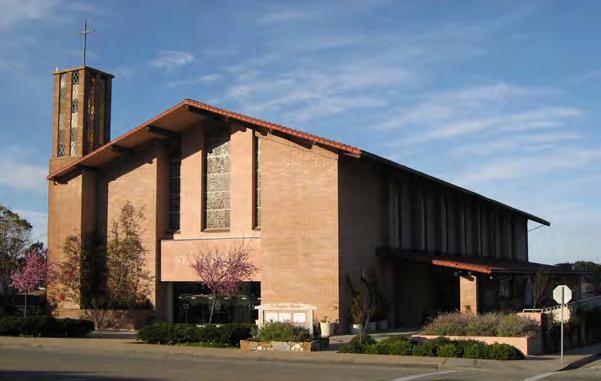 St. Angela’s Church, constructed on Lighthouse Avenue in 1959 (Page & Turnbull, 2011)
St. Angela’s Church, constructed on Lighthouse Avenue in 1959 (Page & Turnbull, 2011)
Historic Context Statement – Final City of Pacific Grove Historic Context (1946 – 1966) Pacific Grove, California 31 October 2011 Page & Turnbull, Inc. 256
Historic Context Statement – Final City of Pacific Grove Historic Context (1946 – 1966) Pacific Grove, California
parking, and may have been symbolic of parking constraints that led the congregation to leave the old church.
The First Baptist Church of Pacific Grove also replaced their original church building around this time. By 1962, Sanborn maps indicate the old church building had been joined at the rear with a one-story frame building located immediately east on the same lot. Both these buildings were demolished in 1965, and a new church building constructed in 1966 under the direction of Reverend Richard Nance.554 Decidedly Modern in style, the new facility featured a colonnaded exterior typically associated with New Formalism. In 1987, a large two-story adjunct facility was constructed on a vacant lot to the east and connected to the 1966 building by a one-story hyphen.
In 1959, the First Church of Christ, Scientist at 522 Central Avenue also modernized their 1920s building by encapsulating it with additions on the east and north ends, as well as adding curved window walls on the north and south facades. Viewed as a group, the design of these new churches clearly show an embrace of the Modern aesthetic by Pacific Grove’s congregations, and are among the city’s more striking examples of Modern architecture.
POST WAR MILITARY PROJECTS
The end of World War II did not bring an end to military activities in the Monterey area. In part, this stemmed from the emerging Cold War, which required new kinds of military capabilities and specialists. In June 1946 the Military Intelligence Service Language School was established at the Presidio of Monterey, re-designated as the Army Language School in 1947. The Department of Defense subsequently created the Defense Language Institute (DLI) as a joint service program in 1963, and by the 1970s the DLI at Monterey served as one of the Defense Department’s primary foreign language instruction centers.555
In 1947, the U.S. Navy purchased the Del Monte Hotel, which during the war had been used as a pre-flight training center. In 1951, it was converted to the Naval Postgraduate School, offering a variety of engineering and science courses. The Navy also remained active in Pacific Grove. In 1952, the U.S. Navy acquired a 4.5 acre parcel of the Point Pinos Lighthouse reservation in order to build an air interceptor training facility for navy pilots and ground personnel. Constructed at a cost of $281,000, the new building was located east of the Lighthouse and addressed as 1352 Lighthouse Avenue. The fortress-like building had no windows, and was designed to resist the forces of an atomic bomb. In 1963 it was deactivated as a training facility and became a Fleet Numerical Weather Facility, which provided atmosphere and ocean current data through the National Oceanic and Atmospheric Administration (NOAA).556
In 1974 the Fleet Numerical Weather Facility moved to the Monterey airport, with the building subsequently used as a naval reserve training facility, hosting monthly military drills for reserve officers based in the San Francisco area. The building was renovated in 1989, but by 1994 had been deactivated. The following year the Navy transferred the facility to NOAA’s National Marine
31 October 2011 Page & Turnbull, Inc. 257
Historic Context Statement – Final City of Pacific Grove Historic Context (1946 – 1966) Pacific Grove, California
Fisheries Service, and it was subsequently occupied by the Pacific Fisheries Environmental Group. Today, the facility is known as the NOAA Southwest Fisheries Science Center and includes a staff of oceanographers who analyze sea surface and ocean current data.557 On its exterior, the building features 32 panels comprising a nearly 400-foot-long mural, completed about 2008 as part of the Pacific Grove Historical Mural Project.558
It is not presently clear how many military personnel lived in or retired to Pacific Grove during this period, but it seems likely that some would choose to make the city their home. This would include personnel from Fort Ord, which continued to operate as a major military training center during this period. From the 1950s through 1970s Fort Ord also served as a staging area for units departing for wars in Korea and Vietnam, and was subsequently used as headquarters of the 7th Infantry Division before being closed in 1994.
INDUSTRIAL DEVELOPMENT
A few new light industrial buildings were also developed in Pacific Grove’s downtown area during this period, including a new plumbing supply warehouse and sheet metal works at 307 to 309 Grand Avenue (extant); a new auto repair shop at 510 Lighthouse Avenue (no longer extant), and a gas station at 520 Lighthouse Avenue, built about 1962 (extant, but now used as a produce market). Among the more prominent new industrial facilities located outside downtown was the Pacific Grove Laundry, built by Del Monte Properties at 801 Sunset Avenue circa 1952. The Internationalstyle building was designed by one of California’s most prominent mid-century architects, Gardner Dailey, in collaboration with Skidmore, Ownings & Merrill.559 The building was originally clad with redwood siding that has since been painted. 560
By far the largest industrial operation in the city was National Automatic Fibers, Inc., which had taken over the old American Can Company facility near Cannery Row. The company manufactured auto upholstery, and by 1962 was served by a spur of the Southern Pacific Railroad. Nearby, on the
Pacific Grove Laundry, designed by Gardner Dailey circa 1952. (Page & Turnbull, 2011)
31 October 2011 Page & Turnbull, Inc. 258
Historic Context Statement – Final City of Pacific Grove Historic Context (1946 – 1966) Pacific Grove, California
southeast corner of Dewey and Sloat, a Quonset hut was erected and presumably used for light industrial purposes. The Monterey County Assessor dates the hut’s installation to 1948, but Pacific Grove resident Inga Daumer reports that the hut’s foundation is stamped November 22, 1952 “by Bentley.” This building was likely World War II surplus, and is today used for auto repair.
ASSOCIATED PROPERTY TYPES & REGISTRATION REQUIREMENTS (1946 – 1966)
The preeminent theme of the “Suburban Expansion” period is the post-war growth of the city, reflecting the corresponding dominance of the automobile. This included expansion of civic infrastructure to accommodate population growth; construction of single-family residences in new subdivisions that departed from the original grid layout of streets; the build-out of older subdivisions where development had been sparse; construction of multi-family residences; infill and redevelopment of the central business district and Lovers Point; and the continued impact of automobiles, including clearance of older buildings for parking lots. The proliferation of hotels and motels also demonstrated changes in the city’s tourist industry. Property types associated with these significant themes include residential properties, commercial properties, motels & cottage courts, civic & public assembly properties, and light industrial properties. Of these, civic & public assembly buildings are most likely to distinctively embody characteristics of Modern architectural styles. There do not appear to be any significant cultural landscapes from the post-war period. Few resources constructed during this period are currently listed on the City of Pacific Grove’s Historic Resources Inventory.
RESIDENTIAL PROPERTIES
The overwhelming majority of properties from this era are residential, primarily consisting of singlefamily houses. However, this period marks the first appearance of larger apartment complexes, as well as the increasing frequency of duplexes and other smaller multi-unit buildings.
While many properties appear as scattered infill, this period also marks the first appearance of largescale suburban style developments such as Weldon Grove, Marino Pines and Del Monte Park. These differed from previous developments in that they tended to be far more self-contained, homogenous, and laid out with street patterns that did not conform to a traditional city grid.
Regardless of location, most residences of this period share many similarities. Nearly all are of wood frame construction, and typically rectangular or L-shaped in plan. Buildings are typically set back from the street, featuring both front and rear yards. One-story houses predominate, although split level and two-story designs are also present. Hip or gable roofs are most common, and most would have originally featured exposed rafter tails at the roofline.
Stucco siding is by far the most common cladding, although wood shiplap, board and batten and clapboards were also used. Some buildings also have asbestos shingle cladding, which by this point in time may have been original or a very early alteration. Driveways and integral garages also become
31 October 2011 Page & Turnbull, Inc. 259
City of Pacific Grove Historic Context (1946 – 1966) Pacific Grove, California
widespread during this period, with an increasingly large portion of both the lot and residence designed to accommodate automobiles.
As originally constructed, most buildings would have featured double-hung or casement wood-sash windows, although by 1960 aluminum window systems were gaining in popularity. Unglazed paneled wood doors were most typical, and the use of concrete entry steps was near universal.
Residential architecture of the period was dominated by a fairly narrow range of styles, with the Ranch style by far the most common. Scattered examples of Minimal Traditional and Colonial Revival style buildings also persisted into the 1950s, as did Mediterranean Revival designs. Here, the term Mediterranean Revival has been used to indicate a more stripped down interpretation of Spanish influenced architecture—evidenced primarily by clay tile roofs. Vernacular buildings are also common, particularly in the Asilomar area where development tended to be more individualistic. Several examples of mid-century Modern style architecture were noted during this study, such as along the 1100 block of Ripple Avenue, but these are not common. Similarly, a few examples of Art Moderne style residences were noted, such as 632 Spazier Avenue, but these are quite rare.
As previously discussed, residential buildings constructed during this period are most common in the Beach Tract, Pacific Grove Acres, and in areas south of Sinex Avenue. In particular, the subdivisions lining Forest Avenue south of Hillcrest Avenue were developed almost entirely during this period.
Development of multi-unit buildings during this period appears to have become more commonplace during the mid-1950s, and accelerated through the 1960s and 1970s. Most frequently they include three to six units, although a few larger complexes were also constructed. Many of these designs appear to be loose interpretations of the Monterey style, distinguished by the use of second story balconies overhanging the first story, such as 842, 845 and 880 Lighthouse Avenue. Just as common, however, are more utilitarian apartment complexes with little exterior ornamentation.
Regardless of style, most multi-family residences of the period were two stories in height, clad in stucco, and capped by a hip roof. Not infrequently garage parking is inserted beneath the structure. These buildings are typically located in Pacific Grove Acres—particularly in proximity to Lighthouse Avenue—where the larger lot sizes permitted their development. Elsewhere, they are generally found along or in close proximity to princi pal streets, such as Central Avenue.
The following section provides an outline of the relevant residential architectural styles and the character-defining features associated with each style. Suburban Ranch style ranch residences are the most common property type in Pacific Grove, as well as California as a whole, and therefore careful consideration should be given to qualifying these buildings as historic resources.
Historic Context Statement – Final
31 October 2011 Page & Turnbull, Inc. 260
Architectural Styles & Character Defining Features
The following section provides an outline of the relevant residential architectural styles and the character-defining features associated with each style:
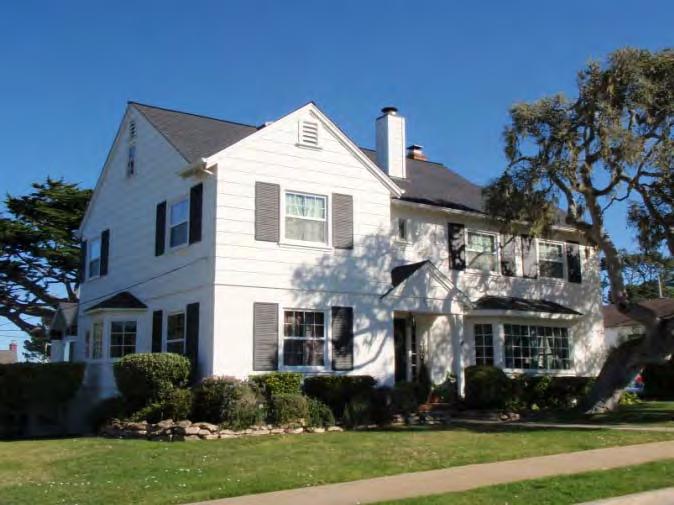
Rectangular or shallow L-shaped massing with a horizontal emphasis Hip and gable roofs are most common. Shallow eaves, often with exposed rafter tails
Typically stucco or wood shiplap siding, sometimes in combination Integral porches with wood posts, or shed extensions of the main roof at the entry. Frequently a garage Decorative window shutters
Side-gable roof forms are most common after World War II Second-story overhangs are not uncommon
Entries often accented with a decorative crown supported by pilasters, or with a portico
Dormer windows are common Decorative shutters are common
Historic Context Statement – Final City of Pacific Grove Historic Context (1946 – 1966) Pacific Grove, California Turnbull,
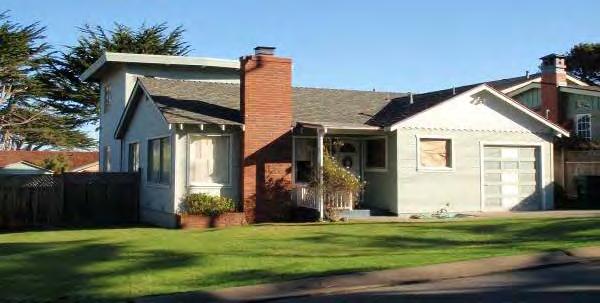 1. Traditional Ranch Style (1940s – 1970s) Del Monte Boulevard Olmsted Avenue
2. Colonial Revival Style (1940s – 1960s)
Colonial Revival style residence, 626 Hillcrest
1. Traditional Ranch Style (1940s – 1970s) Del Monte Boulevard Olmsted Avenue
2. Colonial Revival Style (1940s – 1960s)
Colonial Revival style residence, 626 Hillcrest
31 October 2011 Page &
Inc. 261
1268
1041
3. Modern Style (1940s – 1970s)

Can be found in single-family homes or apartment complexes
Two principal subtypes based on shed or gable roofs; both have broad overhanging eaves
Rectangular massing most common Sometimes asymmetrical facades
Posts or poles supporting gable ends and overhangs are common
Cladding often a combination of stucco, brick, wood or concrete block
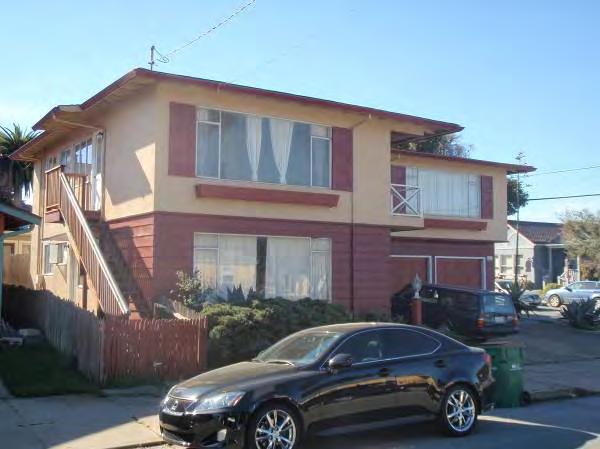
Large brick chimneys on the primary facade are not uncommon
City of Pacific Grove 1966) Pacific Grove, California Turnbull,
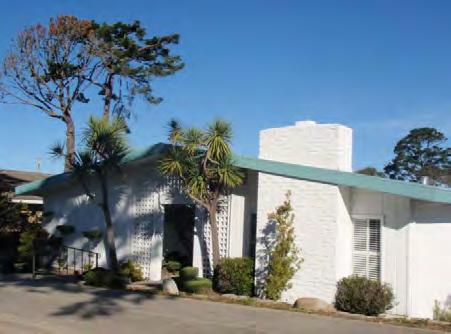 Modern style residence at 1218 Shell. Note shed roof over garage and entry
Modern style residence, 502 Platt
Modern apartment complex, 601 Forest
Modern style residence at 1218 Shell. Note shed roof over garage and entry
Modern style residence, 502 Platt
Modern apartment complex, 601 Forest
Historic Context Statement – Final
Historic Context (1946 –
31 October 2011 Page &
Inc. 262
Significance
The table below discusses the significance of residential buildings from this era according to criteria established by the National Register of Historic Places, California Register of Historical Resources, and the Pacific Grove Municipal Code.
National/ California Register PG Municipal Code §23.76 Significance Discussion
A/1 A, B Events, Patterns & Trends
Although the single-family and multi-unit residences constructed in Pacific Grove during the post-war era are tied to the largest expansion of residential development in the city’s history, these resources are not likely to be individually significant under this criterion. Suburban development patterns in California are typically better represented by groups of residences because the street grid, landscaping and homogeneous, speculative buildings can combine to clearly illustrate this theme.
In Pacific Grove, though, most of the post-war construction of single-family homes occurred in the Beach Tract, Fairway Homes, and Pacific Grove Acres, all of which had been laid out in previous decades. Because the layout of these neighborhoods reflects the City Beautiful movement, not post-war suburban trends, the residences in these areas are not able to accurately demonstrate the post-war suburban development theme. Planned subdivisions such as Marino Pines and Del Monte Park do not appear to be significant examples of post-war planning trends, and thus are not likely to qualify for national, state, or local listing under this criterion.
B/2 C Persons Residential buildings from this period may be significant for their association with persons important to Pacific Grove history. If this is the case, however, the residence should be compared to other associated properties to identify which property(s) best represent that person’s achievements or reasons for being significant.
Historic Context Statement – Final City of Pacific Grove Historic Context (1946 – 1966) Pacific Grove, California 31 October 2011 Page & Turnbull, Inc. 263
City of Pacific Grove Historic Context – 1966) Pacific Grove, California
National/ California Register PG Municipal Code §23.76
Significance
C/3 D, E, F, G, H, I, J, K Architecture/ Design
Discussion
Residential buildings from this period may be significant for their architecture, as expressed by intact stylistic features, forms or construction methods. However, suburban Ranch style buildings are extremely common in Pacific Grove and California as a whole. Thus, architectural significance is best reserved for buildings that demonstrate particularly strong artistic merit, or that clearly demonstrate the influence of a particular architect or builder. Consideration should also be given to examples of styles that are relatively rare as compared to other residential buildings of the period. Resources qualified under these criteria must be excellent examples of types and/or styles, and retain most of their original features.
In order to qualify for national, state, or local listing under this criterion, a mid-century residence must be an outstanding example of a Modern architectural style, and should ideally represent the work of a master architect.
D/4 Information Potential Buildings, ruins or subsurface remains that have the potential to yield important information about construction methods and materials, or the evolution of local residential building development may be significant for their potential to provide information important to history. However, such examples are extremely unlikely.
Integrity
In order to be eligible for listing in the local, state, or national historic registers, a residential property must retain sufficient integrity to convey its significance in association with residential development during this period. While most buildings undergo change over time, alterations should not significantly change the essential historic character of the buildings. The aspects of integrity deemed most important for this period are location, setting, design, materials, association and feeling.
Residential buildings from this era are more common than those from any other period, and likewise have had the least time to accumulate changes. Thus they require a fairly strict interpretation of significance and integrity. Buildings would typically meet the threshold for addition to the local
Historic Context Statement – Final
(1946
31 October 2011 Page & Turnbull, Inc. 264
Historic Context Statement – Final City of Pacific Grove Historic Context (1946 – 1966) Pacific Grove, California
register if they meet the minimum eligibility requirements. Buildings qualified as individual resources for the National or California Registers should retain all or nearly all of their original features.
Minimum Eligibility Requirements:
Exceptional example of residential architecture from this period
Retains original form and roofline
Retains the original pattern of window and doors
Retains its original entry, window and/or roofline ornamentation
Retains original cladding
Replacement windows must conform to the size of the original openings Additions are generally not acceptable
Other Integrity Considerations:
Residences qualified as historic resources for their association with historic events or persons need not be “exceptional” examples of residential architecture. However, they should retain the majority of features present when the event occurred, or when the building was associated with a significant individual.
COMMERCIAL PROPERTIES
Commercial development in Pacific Grove during this period was relatively modest as compared to the rapid pace of the residential construction. However, this period also witnessed the first determined expansion of commercial development into the hills above the city, almost wholly concentrated along Forest Avenue.
Most commercial buildings of the period are one story in height, clad in stucco, brick veneer or wood shiplap siding—sometimes in combination. Structurally, most feature wood frame or reinforced concrete construction. Roofs are generally flat, although barrel vault or shed style roofs are also present. Storefronts are usually configured as window walls featuring plate glass and metal assemblies, and entries typically consist of single or paired fully-glazed metal doors.
There is generally little architectural cohesion, although the influence of Modern style architecture is apparent in the construction of the Forest Hill Court Store and the Grove Market. Perhaps the single most unifying element is that all commercial developments of the period show clear orientation to the automobile. Whereas previously most commercial buildings were constructed flush with the sidewalk, post-war commercial buildings are usually set back or constructed on lots large enough to accommodate parking areas. Strip shipping areas were also developed, with the individual businesses sharing a large common parking area. This is most common along the upper reaches of Forest Avenue, including the Forest Hill Market and Forest Hill Court developments.
Commercial buildings of this period are most commonly located downtown where they appear as infill, or along the upper reaches of Forest Avenue. A small cluster of commercial development is
31 October 2011 Page & Turnbull, Inc. 265
also present along Central Avenue near the Monterey border. It appears that very few, if any, commercial buildings of this period are currently listed on the City of Pacific Grove’s Historic Resources Inventory.
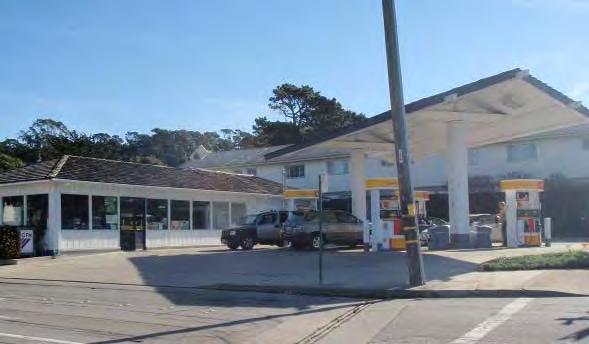
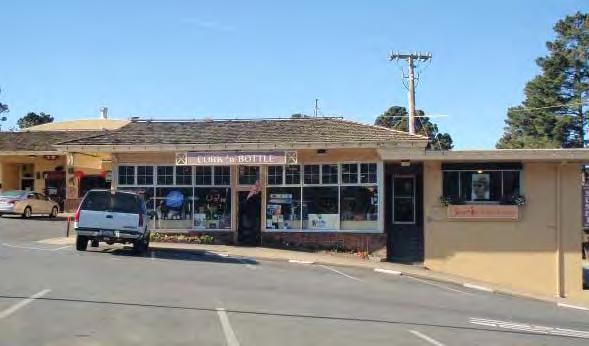
Significance
The table below discusses the significance of residential buildings from this era according to criteria established by the National Register of Historic Places, California Register of Historical Resources, and the Pacific Grove Municipal Code.
National/ California Register PG Municipal Code §23.76
Significance
A/1 A, B Events, Patterns & Trends
Discussion
Commercial buildings from this period may be significant for their association with mid-century commercial development in Pacific Grove. This would be best illustrated by commercial properties constructed in proximity to new residential areas, where their presence helped establish new patterns of commercial development. However, few buildings are likely to be individually significant, but rather would be best qualified as contributors associated with a larger development pattern, or within the context of individual strip developments.
Historic Context Statement – Final City of Pacific Grove Historic Context (1946 – 1966) Pacific Grove, California Turnbull,
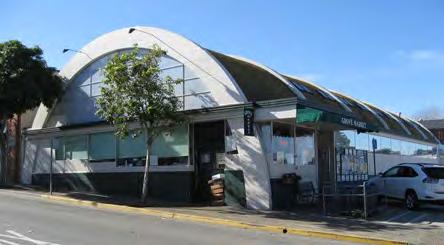 Top: Grove Market, 242 Forest Avenue (left). Concrete block commercial building, 304 Grand Avenue (right) Bottom: Postwar commercial development along Forest Avenue included strip malls and gas stations.
Top: Grove Market, 242 Forest Avenue (left). Concrete block commercial building, 304 Grand Avenue (right) Bottom: Postwar commercial development along Forest Avenue included strip malls and gas stations.
31 October 2011 Page &
Inc. 266
City of Pacific Grove Historic Context (1946 – 1966) Pacific Grove, California
National/ California Register PG Municipal Code §23.76
Significance
Discussion
B/2 C Persons Commercial buildings from this period may be significant for their association with persons important to Pacific Grove’s history, such as a prominent merchant. If this is the case, however, the building should be compared to other associated properties to identify which property(s) best represent that person’s achievements or reasons for being significant. For commercial properties potentially eligible for the HRI, this criterion may also apply to businesses or organizations.
C/3 D, E, F, G, H, I, J, K
Architecture/ Design Commercial buildings from this period may be significant for their architecture, as expressed by intact stylistic features, forms or construction methods. Buildings may also qualify as the work of a master architect or prominent builder. Individual resources qualified under these criteria should be good examples of types and/or styles, and retain most of their original features.
D/4 Information Potential Buildings, ruins or subsurface remains that have the potential to yield important information about construction methods and materials, or the evolution of local commercial building development may be significant for their potential to provide information important to history. However, such examples are extremely unlikely.
Integrity
In order to be eligible for listing in the local, state, or national historic registers, a commercial property must retain sufficient integrity to convey its significance as part of commercial development during this period. While most buildings undergo change over time, alterations should not significantly change the essential historic character of the buildings. These buildings have not had as long to accumulate alterations, and thus a fairly strict interpretation of integrity is warranted. The aspects of integrity deemed most important for this period are location, setting, design, materials, association and feeling.
Buildings would typically meet the threshold for addition to the local register if they meet the minimum eligibility requirements. Buildings qualified as individual resources for the California or National Registers should retain a substantial majority of their original features.
Historic Context Statement – Final
31 October 2011 Page & Turnbull, Inc. 267
Minimum Eligibility Requirements:
Clear example of commercial architecture from this period
Retains original form and roofline
Retains all or nearly all of the original storefront configuration.
Retains a substantial portion of its original ornamentation
Retains original cladding
Other Integrity Considerations:
The replacement of some storefront materials can be acceptable as long as it does not fundamentally alter the storefront configuration (overall pattern of windows, doors, display areas, etc.).
Replacement of doors and windows on secondary facades may be acceptable as long as the original storefront configuration is retained.
Additions are generally only acceptable if they are set back from the primary facade and respect the building’s essential form. In particular, rear additions that have respected the buildings’ scale are generally acceptable.
MOTELS & COTTAGE COURTS

The development of new tourist lodgings during this period generally falls into two categories: cottage courts which continued patterns developed in the 1920s through the 1940s, and conventional motel developments which were typically larger and more centralized.
 Borg’s Motel, Ocean View Boulevard
Borg’s Motel, Ocean View Boulevard
Historic Context Statement – Final City of Pacific Grove Historic Context (1946 – 1966) Pacific Grove, California 31 October 2011 Page & Turnbull, Inc. 268
Historic Context Statement – Final City of Pacific Grove Historic Context (1946 – 1966) Pacific Grove, California
All of the cottage courts developed during this period continued to be located toward the western end of the city in the Pacific Grove Acres subdivision, and in some cases represented the redevelopment of earlier auto camps. This included Camp Ideal, today known as the Lighthouse Lodge at 1150 Lighthouse Avenue. As with the earlier cottage courts, these developments typically featured discrete clusters of small, one-story individual or duplex wood frame cabins organized around a loop road or courtyard parking area. Frequently, these cottage courts were served by a dedicated office, which may also have been connected to a residence for the manager. Other features of cottage court developments might include dedicated outdoor cooking facilities or fire pits, as well as swimming pools and/or other recreational amenities. Wood shiplap or board and batten cladding is most common, although stucco cladding is also possible.
The larger motels of the period were typically two stories in height, and their design was more closely attuned to apartment complex developments, with one or two large multi-unit buildings serviced by a large parking area. Wood frame construction was most common, as were hip or gable roofs. Wood shiplap or stucco cladding is most common. Examples include Wilkie’s Motel (now Wilkie’s Inn) at 1038 Lighthouse Avenue, which is designed in a long U shape at the rear of a large parking lot. As with the cottage courts, Wilkie’s was located toward the western end of the city along Lighthouse Road. But two of the more prominent motel developments of the period were both located directly adjacent to Lovers Point: Borg’s Motel and the Caribbean Motel (now the Lovers Point Inn). Architecturally, there is little cohesion between these buildings, and most are vernacular in nature. The Caribbean Motel does show some influence of the Art Moderne style, but this is principally concentrated on only a small portion of the facade.
Significance
The table below discusses the significance of auto camp and cottage court buildings from this era according to criteria established by the National Register of Historic Places, California Register of Historical Resources, and the Pacific Grove Municipal Code. It appears that very few, if any, motels and cottage courts developed during this period are currently listed on the City of Pacific Grove’s Historic Resources Inventory.
A/1 A, B Events Motel and cottage court buildings from this period may be significant for their association with the development of auto-related tourist facilities, which continued to be a key facet of the city’s identity during the post-war era. This significance is best realized by buildings that served as prototypes for subsequent developments, or that clearly demonstrate important patterns of development, such as the spatial organization of auto courts (criterion C/3).
31 October 2011 Page & Turnbull, Inc. 269
National/ California Register PG Municipal Code §23.76 Significance Discussion
City of Pacific Grove Historic Context – 1966) Pacific Grove, California
National/ California Register PG Municipal Code §23.76
Significance
Discussion
B/2 C Persons Motel and cottage court buildings from this period may be significant for their association with persons important to Pacific Grove’s history. If this is the case, however, the building should be compared to other associated properties to identify which property(s) best represent that person’s achievements or reasons for being significant.
C/3 D, E, F, G, H, I, J, K Architecture/ Design Motel and cottage court buildings from this period may be significant for their architecture, as expressed by intact stylistic features, forms or construction methods. The evaluation of cottage courts should also take into account the relationship between the cottages and related facilities (e.g., reception office, fire pits, parking areas), such that the whole is considered as an ensemble. Buildings may also qualify as the work of a master architect or prominent builder. Individual resources qualified under these criteria, however, should be excellent examples of types and/or styles, and retain nearly all of their original features.
D/4 Information Potential Buildings, ruins or subsurface remains that have the potential to yield important information about construction methods and materials, or the evolution of local building development may be significant for their potential to provide information important to history. However, such examples would be extremely unlikely.
Integrity
In order to be eligible for listing in the local, state, or national historic registers, a motel or cottage court property must retain sufficient integrity to convey its significance as part of development during this period. While most buildings undergo change over time, alterations should not significantly change the essential historic character of the buildings. Because these buildings have not had as long to accumulate changes, a fairly strict interpretation of integrity is warranted. The aspects of integrity deemed most important for this period are location, design, materials, association and feeling.
Historic Context Statement – Final
(1946
31 October 2011 Page & Turnbull, Inc. 270
City of Pacific Grove Historic Context (1946 – 1966) Pacific Grove, California
Buildings would typically meet the threshold for addition to the local register if they meet the minimum eligibility requirements. Buildings qualified as individual resources at the state or national level should retain all or nearly all of their original features.
Minimum Eligibility Requirements:
Clear example of motel or cottage court architecture
If cottage court, retains original configuration of cottages and associated amenities
Retains original form and roofline
Retains the original pattern of window and doors
Retains most of its original ornamentation, if applicable
Retains original cladding
Replacement of doors and windows may be acceptable, but they must conform to the original door/window pattern and the size of the openings
CIVIC & PUBLIC ASSEMBLY PROPERTIES
The explosive population growth during this period resulted in a dramatic wave of civic and public assembly building construction, represented most frequently by the development of new schools and churches.
Church buildings of the period—more than any other property type—show a clear embrace of Modern style architecture. Most new church buildings were constructed using reinforced concrete and featured prominent front-facing gables with broad eaves. Exterior finishes are typically brick or stucco, although a combination of claddings is possible.
The educational facilities constructed during this period show a clear demarcation according to age. The earlier buildings, such as the 17 Mile Drive and Lighthouse Elementary schools, are both wood frame buildings employing utilitarian designs. Similarly, the reconstructed portion of old Pacific Grove High School, while much larger than the elementary schools, is also a wood frame building and shows little architectural detailing. All of these buildings were complete by about 1952. The new Pacific Grove High School constructed a decade later, however, was constructed using reinforced concrete and concrete block, and shows strong Modern style design influences including prominent gable roofs with broad eaves.
These churches and schools are scattered throughout the city, but unlike previous periods, very few are located in the downtown area. This is symbolic of the city’s growth during this period, which was primarily focused at the periphery.
Historic Context Statement – Final
31 October 2011 Page & Turnbull, Inc. 271
Significance
The table below discusses the significance of civic & public assembly buildings from this era according to criteria established by the National Register of Historic Places, California Register of Historical Resources, and the Pacific Grove Municipal Code. It appears that very few, if any, civic
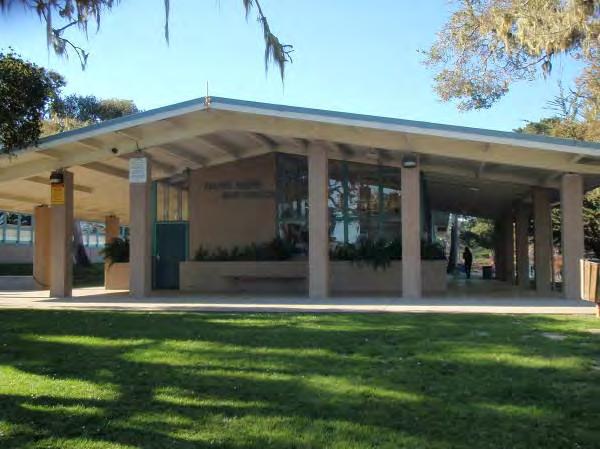
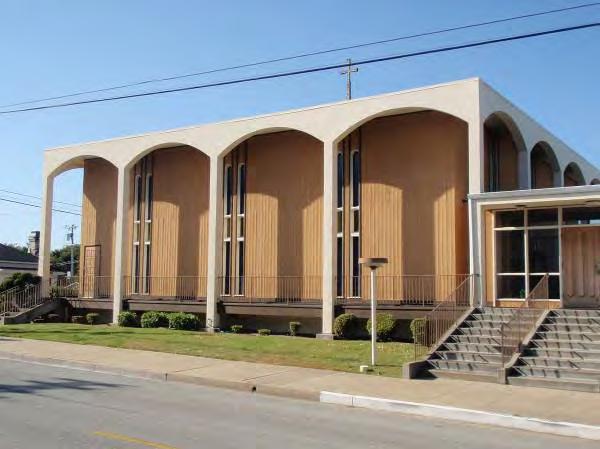
Historic Pacific Pacific Grove, California Turnbull,

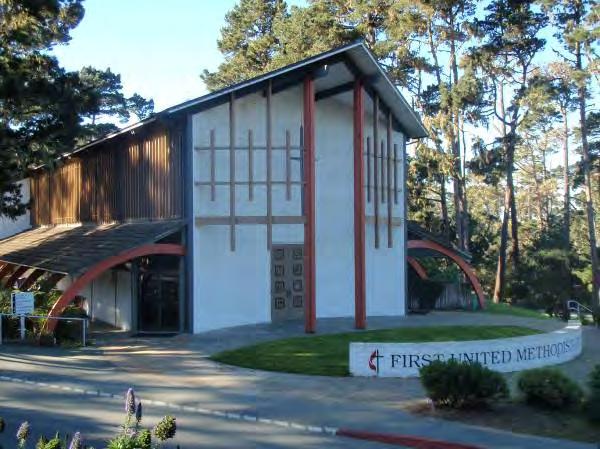 First Baptist Church, 246 Laurel
First United Methodist Church, Sunset Boulevard
Masonic Hall, 30 Congress
Pacific Grove Fire Department, Pine Street
Pacific Grove High School, Sunset Boulevard
Pacific Grove Middle School, Forest Avenue
First Baptist Church, 246 Laurel
First United Methodist Church, Sunset Boulevard
Masonic Hall, 30 Congress
Pacific Grove Fire Department, Pine Street
Pacific Grove High School, Sunset Boulevard
Pacific Grove Middle School, Forest Avenue
Context Statement – Final City of
Grove Historic Context (1946 – 1966)
31 October 2011 Page &
Inc. 272
and public assembly buildings from this period are currently listed on the City of Pacific Grove’s Historic Resources Inventory.
National/ California Register PG Municipal Code §23.76 Significance Discussion
A/1 A, B Events, Patterns & Trends
Civic & public assembly buildings from this period may be significant as expressions of civic and cultural values tied to the dramatic post-war growth of the city. Collectively, this was among the most fruitful periods of institutional development during the city’s history, and the buildings frequently represent both the optimistic spirit of the period, as well as the need to upgrade facilities.
Please note that historic significance for a church or other religious property cannot be established on the merits of a religious doctrine, but rather on secular terms for its architectural or artistic values or as a representation of important historic or cultural forces.
B/2 C Persons
Civic & public assembly buildings from this period may be significant for their association with persons important to Pacific Grove’s history. If this is the case, however, the building should be compared to other associated properties to identify which property(s) best represent that person’s achievements or reasons for being significant.
Architecture/ Design
Civic & public assembly buildings from this period may be significant for their architecture, as expressed by intact stylistic features, forms or construction methods. In particular, St. Angela’s Church, the First Baptist Church and the new Methodist Episcopal Church are among the city’s most striking examples of Modern architecture. Buildings may also qualify as the work of a master architect or prominent builder. Individual resources qualified under these criteria should be good examples of types and/or styles, and retain most of their original features.
D/4 Information Potential Buildings, ruins or subsurface remains that have the potential to yield important information about construction methods and materials, or the evolution
Historic Context Statement – Final City of Pacific Grove Historic Context (1946 – 1966) Pacific Grove, California Turnbull,
C/3 D, E, F, G, H, I, J, K
31 October 2011 Page &
Inc. 273
Significance
Discussion
of local building development may be significant for their potential to provide information important to history. However, such examples would be extremely unlikely.
As mentioned previously, if a church from this period is to be considered for listing in the National Register, it must also meet National Register Criteria Consideration A, which deals specifically with religious properties (see National Register Bulletin #15 – How to Apply the National Register Criteria For Evaluation). This information may also prove useful in evaluating the significance of a church for inclusion in the state or local register.
Integrity
In order to be eligible for listing in the local, state, or national historic registers, a civic & public assembly building must retain sufficient integrity to convey its significance as part of development during this period. While most buildings undergo change over time, alterations should not significantly change the essential historic character of the buildings. Buildings qualified as individual resources at the state or national levels should retain a substantial majority of their original features. The aspects of integrity deemed most important for this period are location, design, materials, association and feeling.
Minimum Eligibility Requirements:
Clear example of an institutional property from this period
Retains original form and roofline
Retains original pattern of windows and doors
Retains original cladding
Retains most of its original ornamentation
LIGHT INDUSTRIAL PROPERTIES
Industrial development during this period appears quite sparse, and was most typically associated with the development of auto facilities and small warehouses. As with commercial properties, a major differentiation between pre- and post-war industrial architecture is a clear orientation to automobiles/trucks as evidenced by driveways, loading platforms and large vehicular openings. Buildings are typically only one story in height, and reinforced concrete, concrete block or steel frame construction is near universal. Stucco cladding is typical. Roof shapes are typically flat or barrel-vault. Original windows would typically be steel-sash or wood sash with awning or hopper mechanisms. Though many industrial buildings of this period are utilitarian and have restrained ornamentation, International style influenced architecture was also gaining in popularity. Generally speaking, new industrial buildings of the period would most likely be located in proximity to automobile routes.
National/ California Register Municipal Code §23.76
Historic Context Statement – Final City of Pacific Grove Historic Context (1946 – 1966) Pacific Grove, California 31 October 2011 Page & Turnbull, Inc. 274
PG
City of Pacific Grove Historic Context 1966) Pacific Grove, California
Significance
The table below discusses the significance of industrial buildings from this period according to criteria established by the National Register of Historic Places, California Register of Historical Resources,
National/ California Register PG Municipal Code §23.76
Significance Discussion
A/1 A, B Events Industrial buildings from this period may be significant for their associations with industrial development, although this was a very small component of the city’s development during this period. Few buildings are likely to be individually significant, but rather would be best qualified as contributors associated within a larger industrial development pattern, if identified.
B/2 C Persons Industrial buildings from this period may be significant for their association with persons important to Pacific Grove’s history. If this is the case, however, the building should be compared to other associated properties to identify which property(s) best represent that person’s achievements or reasons for being significant.
C/3 D, E, F, G, H, I, J, K
Architecture/ Design Industrial buildings from this period may be significant for their architecture, as expressed by intact stylistic features, forms or construction methods. Buildings may also qualify as the work of a master architect or prominent builder. For example, the Pacific Grove
Historic Context
Pacific Grove Laundry at 801 Sunset Boulevard, designed by Gardner Dailey circa 1952.
Quonset hut at Dewey Street and Sloat Avenue
Statement – Final
(1946 –
31 October 2011 Page & Turnbull, Inc. 275
City of Pacific Grove Historic 1966) Pacific Grove, California
National/ California Register PG Municipal Code §23.76
Significance
D/4 Information Potential
Discussion
Laundry (pictured above) may be significant as an example of master architect Gardner Dailey’s work. Individual resources qualified under these criteria, however, should be excellent examples of types and/or styles, and retain nearly all of their original features.
Buildings, ruins or subsurface remains that have the potential to yield important information about construction methods and materials, or help demonstrate the evolution of local industrial development. However, such examples would be exceptionally rare.
Integrity
In order to be eligible for listing in the local, state, or national historic registers, an industrial property must retain sufficient integrity to convey its significance as part of development during this period. While most buildings undergo change over time, alterations should not significantly change their essential historic character. The aspects of integrity deemed most important for this period are location, design, materials, association and feeling.
Buildings would typically meet the threshold for addition to the local register if they meet the minimum eligibility requirements. Buildings qualified as individual resources at the state or national level should retain all or nearly all of their original features.
Minimum Eligibility Requirements:
Clear example of industrial architecture from this period
Retains original form and roofline
Retains the original pattern of window and doors
Retains original cladding
Replacement of doors and windows may be acceptable, but they must conform to the original size of the openings Additions are generally not acceptable.
CULTURAL LANDSCAPE ELEMENTS
With the exception of the addition of nine holes to the Pacific Grove Golf Links in the 1950s (discussed in previous period, when golf course was established), there do not appear to be any significant cultural landscapes extant from this period of development. However, if any, their significant landscapes are discovered, they should be evaluated using the same methodology identified in previous periods.
Historic Context Statement – Final
Context (1946 –
31 October 2011 Page & Turnbull, Inc. 276
G. Modern Pacific Grove (1967 – present)
Pacific Grove’s extended period of post-war growth continued through the late 1960s and into the 1970s. This included the annexation of adjacent areas, as well as the build out of many of the city’s remaining undeveloped lots. In 1969, the city also lifted its nearly century-old ban on alcohol sales, ending Pacific Grove’s standing as the last “dry” town in California.
According to city directories, the city’s population in 1965 was pegged at 12,850 residents, with an additional 1,855 persons in Del Monte Park. By 1970, the city’s population had grown to 13,505, with an additional 3,400 persons in the unincorporated areas. In total, the city counted 5,968 housing units. An even greater burst of growth followed, described as a “building boom” which peaked in early 1972, resulting in the development of the “remaining large parcels of land within the city …”561
ANNEXATIONS & GENERAL PLAN
In 1973, the City of Pacific Grove’s Planning Board published a new General Plan that described the city’s post-war expansion: The unforeseen explosion in urban growth which characterized the late 1950’s and the decade of the 60’s was a nation-wide phenomena … Until the 1960’s urban growth was considered analogous to progress, however, the anarchistic urban sprawl which typified the 1960’s was more analogous to a cancer than to any positive societal value. The Monterey Peninsula was more fortunate than most urban areas during the 1960’s, although here too urban growth accelerated at a tremendous rate … The 1963 – 1965 growth period was generally regarded by the municipal government in a positive light in part because the intra-urban expansion was dispersed. In 1966 the city updated its 1958 Land Use Plan essentially reiterating conclusions from the earlier plan and proposing some minor recommendations. During 1971 the city established a Planning Department as a step toward surveying and analyzing existing urban conditions and developing a new General Plan.562
According to the 1973 General Plan, the city expected rapid growth to continue into 1975, when the city’s population would reach 14,500—with 3,600 in the unincorporated area (Del Monte Park, Pacific Grove Acres, Asilomar and the County Club).563 To attempt to deal with this growth, the General Plan acknowledged that there would be trade-offs, both in terms of the cost of living, as well as architectural quality.
Although some growth is projected for Del Monte Park, the primary area of growth … is projected for land owned by Del Monte Properties to the west of Congress Avenue … if scattered urban and residential development is allowed to take place in the area set aside for future development, the relative cost of living in PG would increase and the quality of development would probably decrease … The alternative to “residential sprawl” is the logical and planned treatment of the developed part of the area.564
Historic Context Statement – Final City of Pacific Grove Historic Context (1967 – present) Pacific Grove, California 31 October 2011 Page & Turnbull, Inc. 277
Historic Context Statement – Final City of Pacific Grove Historic Context (1967 – present) Pacific Grove, California 31 October 2011 Page & Turnbull, Inc. 278 DAVID 17 MILE SINEX FOREST 9OCEANVIEW TH 16TH A S I L O M A R LINE 117TH 9TH 7TH 18TH PICO CEDAR GIBSON 8TH IRVING JEWELL PRESCOTT 4TH PINE CONGRESS MASON OAK 6TH CENTRAL JUNIPERO LILY 11TH 12TH 10TH RECTRAIL WALNUT PARK FOUNTAIN CARMEL AGRAND LDER LAINE 5TH HWY68 3RD SUNSET WOOD HOFFMAN EARDLEY 2ND C R O C K E R 1ST 15TH G R O V E AC R E 13TH BELDEN SURF ARCHER LOCUST DELMONTE WILLOW M A J E L L A SPENCER BALBOA MILES BAYVIEW HIGH ALICE FOREST LODGE WITHERS SFBMORSE GRANITE CREST SHELL EGAN LINCOLN HILLCREST MONTEREY TERRY SKYLINE FUNSTON JESSIELOBOS CHESTNUT LOTTIE SPRUCE CLAY GRACE RIPPLE TAYLOR HARRISON PARCEL MAPLE FRANKLIN HELLAM VIA DEL REY LYNDON FILMORE A R M Y SEAVIEW CYPRESS ROOSEVELT EVANS PR IVAT E BOL O MORSE MERMAID NEWTON SYIDA BENITO SLOAT MELROSE LAWTON DRAKE SEAPALM SHAFTER PR ESID O JOHNSON RA NS FO RD PACIFIC DENNETT CORAL HAWTHORNE MONTECITO RIDGE ORTEGA SHORT MCCLELLAN 14TH FOAM DEVISADERO JEFFERSON S T L L W E LL FITCH AUSTIN STUART ARENA ORD RIFLE RANGE BEAUMONT MADISON SP RAY MACARTHUR CRAMDEN SERRA DEWEY HE RR MA NN R A LR O A D R I G H T O FW AY RICKETTS ROW E V E R G R E E N SIREN DRYCREEK LEWIS GROVE HILLSIDE LIGHTHOUSE SPAZIER TIMBER CPL EVANS BIWAINWRIGHT SHOP BENTLEY PATTERSON CHAPARRAL BEACON RACCOON RUTH ACACIA GATE LAUREL 20TH OLMSTEAD PINE HILL BRIGGS A C R O P O L S CABRILLO SGTFRONIUS BOWEN ROSEMONT MARINO PINES PLUMMER CALEDONIA SAGE PIEDMONT FOREST HILL CPL EVANS EL C AL LE JO N E INFANTRY GLEN LAKE V I A D E L P N A R K T CA RS ON HACHIYA TREASURE MONARCH KENET PAR ADISE PARK DAY SPANISH BAY PETRA TANGLEW OOD PAC F I C G R O V E UNION TODD AIR OFORCE TTER MORELAND ADOBE CLARK CAFFREY GARDEN WALCOTT L A U R E ACORN LASE LVA CH UA LAR AVALON LORELEI NAVAJO FOREST PARK MARINE MOSS 19TH H E R R M A N N PINE PINE CYPRESS 13TH SUNSET MC CL EL LA N PRESIDIO PIEDMONT CROCKER JEWELL RANS FORD PRESIDIO 14TH 14TH LIGHTHOUSE 2ND 2ND LAUREL PARK LOBOS NEWTON LAWTON RANSFORD LIGHTHOUSE OAK SHELL SHORT SPRUCE SLOAT FITCH CONGRESS Page&Turnbull,Inc./24June2011 ° PI UNSET RENA LODGE S YIDAR A ILLSIDE AGE P E D M O OREST OTTER LARK CORN 1 INE IEDMONT ANS FORD ANSFORD NBISHOP T DOBE E LMSTEAD CEANVIEW IN CO ECTRAIL C ALDER URF UCE VANS MELROSE EAPALM ACIFIC HORT P EWEY RI F W IREN EACON H ONARCH AC ODD VALON ARINE OSS 9TH INE ROCKER ND AUREL AK HELL LOAT9TH 116TH17THC18TH EDAR ARMEL GRAND SPR RICKETTS 0T ARDEN NDOBOS IGHTHOUSE HORT CityofPacificGrove CityLimits:1873-2011 1875 -PacificGroveRetreat,St.JohnCox 1919 -DelMontePropertiesMap 1943 -ZoningMap,MontereyPublicLibrary 1889 -OriginalIncorporatedCityLimits 1947-1966 -USGSQuadrangles 1973 -PacificGroveGeneralPlan 2011 -CurrentCityLimits Map showing changes to city limits since Pacific Grove’s founding in the nineteenth century (Page & Turnbull)
The resulting Land Use Plan was to increase density in the city’s central and eastern areas, which included many of the oldest neighborhoods in the city. This included all the land north of Central Avenue east of Pacific Avenue, as well as all the land north of Pine Avenue from 13th Street to the Monterey border.565 New commercial growth would continue to be directed to the downtown area “to provide a compact readily accessible retail district. Off-street parking within the downtown area is presently provided by several parking lots, both public and private …”566
The city also aggressively annexed areas during the 1960s and 1970s. This included Point Pinos in May 1966 (84 acres); Del Monte Park in 1972 (195 acres); areas around Sunset Avenue in March 1975 (14.81 acres); Forest Grove Numbers 1 and 2 in 1976 (20.11 acres); and Asilomar in 1979 (130.70 acres). By 1994, the city’s total area grew to 1,830 acres.567
HERITAGE SOCIETY & HISTORIC PRESERVATION ORDINANCE
One consequence of the city’s growth was the ongoing demolition of its older buildings. Beginning in 1975, residents worked with city staff to document 528 historic homes located in the Retreat area. This led to the formation of the Heritage Society of Pacific Grove in 1976, and was followed in 1977 by a historic survey of 350 homes conducted by the Pacific Grove Planning Department using a grant from the State of California. This survey resulted in part in the 1978 publication of Pacific Grove: An Early Seaside Retreat Revisited by Wendy Salisbury Howe. Within a decade, the city began work on a historic preservation element as part of the city’s General Plan. This was driven by the City Council, which in July 1985 had decreed an interim moratorium on the demolition of any building constructed prior to 1925 until a historic preservation element could be developed as part of the city’s General Plan.568
In 1993, the city held hearings on a proposed Historic Preservation Ordinance which would become part of the city’s new General Plan. This ordinance would “require the owners of structures built before 1927 to get special city permits before demolishing or drastically changing their appearance. The ordinance would apply to about a fourth of the houses in the city. It is intended to maintain the ‘existing scale and the eclectic styles’ of Pacific Grove.”569 At the time, the city’s Community Development Director stated that under the interim moratorium, at least fifty demolition permits were requested and all but six had been approved.570 That same year, Holman’s Department Store closed, and a measure was placed on the ballot the following year to allow the building to be converted to condominiums and hotel use. It passed with eighty-four percent voter approval.571
Generally speaking, very few new developments made during this period would qualify for historic designation. The National Register imposes a baseline rule that buildings or structures should be at least fifty years old before they can be considered historic. However, some exceptions can be made if a resource is “exceptionally important.” Typical examples have included buildings associated with the Civil Rights Movement, as well as buildings and structures used as part of NASA’s space exploration program. The California Register does not specify a strict age requirement, so long as it can be demonstrated that sufficient time has passed to understand a building’s historic importance.
Historic Context Statement – Final City of Pacific Grove Historic Context (1967 – present) Pacific Grove, California 31 October 2011 Page & Turnbull, Inc. 279
City of Pacific Grove Context (1967 – present) Grove, California
DIGITAL RESEARCH, INC.
Pacific Grove may, however, be associated with an event during this period that—with additional research—could be shown to qualify as exceptionally important. In 1976, personal computing pioneer Gary Kildall (1942 – 1994) and his wife Dorothy McEwen founded a company known as Digital Research, Inc. in Pacific Grove.572 While Kildall is widely recognized for his pioneering work with CD-ROM technology and early digital media, he is perhaps best known for the invention of an operating system called CP/M. In 1980, the IBM corporation approached Kildall about purchasing this operating system for its computers. While that deal fell through, IBM subsequently licensed a CP/M operating system clone known as PC-DOS from Bill Gates, founder of Microsoft. Kildall threatened IBM with legal action for infringing on the design of his operating system, and subsequently accepted an offer by IBM to offer the CP/M operating system as an alternative to PCDOS. It is the opinion of some computing experts that while CP/M was not a commercial success, its design was the forerunner of the operating systems that now power the majority of the world’s computers and led to the personal computing revolution.573
It appears that Gary Kildall worked out of several buildings in Pacific Grove, including offices at 716 Lighthouse Avenue, 734 Lighthouse Avenue, and 801 Lighthouse Avenue. The building at 734 Lighthouse Avenue was at one time raised from its foundation in order to install a large computing device in the basement.574 The company subsequently developed larger offices at 160 Central Avenue and grew to over 200 employees.575 However, it is believed that the code for CP/M was written at 801 Lighthouse Avenue, as well as in a small studio located behind the Kildall residence at 781 Bayview Avenue.576 If it can be demonstrated that the operating system was in fact developed in one of these buildings, its association with the advent of personal computing has the potential to make it exceptionally important and eligible for the California or National Registers.
Historic Context Statement – Final
Historic
Pacific
31 October 2011 Page & Turnbull, Inc. 280
V. REFERENCES
A. Bibliography
PUBLISHED WORKS
Barrows, Henry D. and Luther A. Ingersoll. A Memorial and Biographical History of the Coast Counties of Central California. Chicago: Lewis Publishing Co., 1893.
Butner, Evelyn M. and William T. Butner. The Chautauqua Connection. Pacific Grove: The Heritage Society of Pacific Grove, 1980.
Clifford, Mary Louise and J. Candace Clifford. Women Who Kept the Lights – An Illustrated History of Female Lighthouse Keepers. Williamsburg: Cypress Communications, 1993.
Colton, Walter. Three Years in California. New York: D. W. Evans & Co., 1860.
Conway, J. D. Monterey: Presidio, Pueblo, and Port. Charleston, SC: Arcadia Publishing, 2003.
Copeland, Dennis and Jeanne McCombs. A Monterey Album: Life by the Bay. San Francisco, CA: Arcadia Publishing, 2003.
Coventry, Kim. Images of America: Monterey Peninsula, the Golden Age. Chicago, IL: Arcadia Publishing, 2002.
Cullerton, James. Indians and Pioneers of Old Monterey. Fresno, CA: Academy of California Church History, 1950.
Dean, Bashford. “Chimaeroid Fishes and Their Development.” Washington, DC: Carnegie Institution of Washington Publication No. 32.
De La Pérouse, Jean Francois. Monterey in 1786 - Life in a California Mission – The Journals of Jean Francois de la Pérouse. Berkeley: Heyday Books, 1989.
Delkin, James Ladd., ed. Monterey Peninsula: Compiled by Workers of the Writer’s Program of the Work Projects Administration in Northern California. Berkeley: California State Department of Education, 1941.
Gahagan, G. William. Key to the Monterey Peninsula. Burlingame, CA: Welcome House Publications, Inc., 1956.
Hanson, Erle C. Monterey & Pacific Grove Street Car Era. Glendale: Interurban Press, 1990.
Historic Context Statement – Final City of Pacific Grove References Pacific Grove, California 31 October 2011 Page & Turnbull, Inc. 281
Harrison, Edward Sanford. History of Santa Cruz County, California. San Francisco: Pacific Press Publishing Company, 1892.
Hemp, Michael Kenneth. Cannery Row: The History of John Steinbeck’s Old Ocean View Avenue. Carmel: The History Company, 2002.
Hester, Thomas Roy. “Esselen.” Handbook of North American Indians: California, Volume 3. William C. Sturtevant, general ed. Robert Heizer, volume ed. Washington DC: Smithsonian Institution, 1978.
Howard, Donald M. Esq. Vanished Villages of Monterey County. Carmel: Antiquities Research Publications, 1977.
Howard, Donald M. The Old Pacific Grove Retreat, 1875-1940. Monterey County Historical Press, 1999. Howard, Donald M. Monterey County Archaeological Site Inventory, Volume 1. Monterey Peninsula Historiography Press, 2007.
Howe, Wendy Salisbury. Pacific Grove An Early Seaside Retreat Revisited. Pacific Grove: City of Pacific Grove, 1978.
Hurtado, Albert L. John Sutter – A Life on the North American Frontier. Norman: University of Oklahoma Press, 2006.
Levy, Richard S. “Costanoan,” Handbook of North American Indians: California, Volume 3. William C. Sturtevant, general ed. Robert Heizer, volume ed. Washington DC: Smithsonian Institution, 1978.
Lewis, Betty. Monterey Bay Yesterday: A Nostalgic Era in Postcards (featuring the works of architect William H. Weeks). Santa Cruz: Other Books, 1987.
Lewis, Betty. W. H. Weeks – Architect. Fresno: Panorama West Books, 1985.
Lewis, Oscar. San Francisco: Mission to Metropolis. Berkeley: Howell-North Books, 1966.
Lydon, Sandy. Chinese Gold – The Chinese in the Monterey Bay Region. Capitola: Capitola Book Company, 1985.
McAlester, Virginia and Lee. A Field Guide to American Houses. New York: Alfred A. Knopf, 1997
Muir, John, ed. Picturesque California: The Rocky Mountains and the Pacific Slope by Eminent American Artists. New York and San Francisco: J. Dewing Publishing Co, 1888.
City of Pacific Grove References Pacific Grove, California Turnbull,
Historic Context Statement – Final
31 October 2011 Page &
Inc. 282
City of Pacific Grove Pacific Grove, California
Marling, Karal Ann. Wall to Wall America – Post Office Murals in the Great Depression. Minneapolis: University of Minnesota Press, 1982.
McLane, Lucy Neely. A Piney Paradise. Third Ed. Monterey: Herald Printers, 1975.
McLane, Lucy Neely. A Piney Paradise. Fourth Ed. Baltimore: Gateway Press, Inc., 2004.
Miller, Evelyn Grantham, Martha Pye Larson and Peter Rashkin, eds. Pacific Grove, California: The First 100 Years – A Glimpse of the Past that Shaped the City’s Present. Pacific Grove: Pacific Grove Centennial, Inc., 1975.
Palumbi, Dr. Stephen R. and Carolyn Sotka. The Death and Life of Monterey Bay: A Story of Revival. Washington, DC: Shearwater Books, 2011.
Ruhge, Justin M. The Military History of California. Lompoc, CA: Quantum Imaging Associates, 2005.
Seavey, Kent and the Heritage Society of Pacific Grove. Images of America – Pacific Grove. San Francisco: Arcadia Publishing, 2005.
Seavey, Kent. Images of America Carmel: A History in Architecture. San Francisco: Arcadia Publishing, 2007.
Shields, Scott A. Artists at Continent's End: The Monterey Peninsula Art Colony, 1875-1907. Sacramento: Crocker Art Museum, 2006.
Shumway, Burgess McK. California Ranchos. Second Edition. Borgo Press, 1988.
Tamm, Eric Enno. Beyond the Outer Shores – The Untold Odyssey of Ed Ricketts, the Pioneering Ecologist Who Inspired John Steinbeck and Joseph Campbell. New York: Thunder’s Mouth Press, 2004.
Temple, Sydney with Marguerite M. Temple. The Carmel Mission from Founding to Rebuilding. Fresno: Valley Publishers, 1980.
Truman, Benjamin Cummings. Tourists Illustrated Guide to the Celebrated Summer and Winter Resorts of California Adjacent to and Upon the Lines of the Central and Southern Pacific Railroads. San Francisco: H. S. Crocker, 1883.
Yamada, David T. & Oral History Committee, MP/JACL. The Japanese of the Monterey Peninsula: Their History & Legacy 1895-1995. Monterey: Monterey Peninsula Japanese American Citizens League, 1995.
Historic Context Statement – Final
References
31 October 2011 Page & Turnbull, Inc. 283
PUBLIC RECORDS
Haney, Denice. “Historical Overview of Monterey County.” Monterey County Planning Department: April 1981.
Monterey Public Library, California Room Clipping Files.
Pacific Grove City Directories: 1926, 1930, 1939, 1947, 1951, 1953, 1957, 1960, 1965.
Pacific Grove General Plan, adopted by the City Council in October 1994.
Planning Board of the City of Pacific Grove, California. The General Plan of the City of Pacific Grove. January 1973.
UNPUBLISHED DOCUMENTS
Rapp, Robert J. “Pacific Grove: A Story of Western Development.” M.A. diss., California State University, Hayward, 2002.
Laverty, Philip Blair. “Recognizing Indians: Place, Identity, History, and the Federal Acknowledgment of the Ohlone/Costanoan-Esselen Nation.” M.A. diss., University of New Mexico Department of Anthropology, 2010.
MAGAZINES & JOURNALS
American Sabbath Tract Society. “Sabbath Reform.” The Sabbath Recorder Vol. 70, No. 14 (April 3, 1911):424.
De la Ascension, Antonio and Henry R. Wagner. “Spanish Voyages to the Northwest Coast in the Sixteenth Century. Chapter XI: Father Antonio de la Ascension's Account of the Voyage of Sebastian Vizcaino.” California Historical Society Quarterly Vol. 7, No. 4 (December 1928): 295394.
Heritage Society of Pacific Grove. Board & Batten. Various articles published between 1986 and 2008.
Hanson, Erle C. “Monterey & Pacific Grove Railway.” Western Railroader Issue 238 (September 1959): 2-15.
Inkerslet, Arthur. “Winter Home of the Monarch Butterfly.” Overland Monthly and Out West Magazine Vol. 58, No. 4 (October 1911): 281-283.
Historic Context Statement – Final City of Pacific Grove References Pacific Grove, California 31 October 2011 Page & Turnbull, Inc. 284
Mazur, Carol Hastings. “Trimmer Hill – Generations of a Landmark Home in Pacific Grove.” Noticias del Puerto de Monterey. Monterey History and Art Associations Quarterly. Vol. LIV, No. 2. (Spring 2005).
Morse, Lowell W. “Underwater Police Force Patrols Pacific Grove Marine Gardens.” Western City, (June 1963): 38.
“Pacific Grove Today.” Game & Gossip (31 July 1959): 2-8.
Rowe, Charles Rowe. "Cottage Industry: Restoring John Steinbeck's California Retreat." Preservation. (September/October. 2007): 15-16, 19.
Woodman, E. H., ed. “Pacific Grove.” Sunset. Published by the Passenger Department Southern Pacific Company, Press of H.S. Crocker Company. Vol. 3 (May 1899): 66.
NEWSPAPERS
Burness, Tad. “Pic Tours,” Monterey County Herald, 22 January 1994, p. 3E.
Gardner, Neill. “Shore Lines.” Monterey Peninsula Herald. 11 August, 1988, 4.
Grazland, Joe. “Eye-Openers.” Monterey Peninsula Herald. 11 November 1985, p. 15.
Diehl, Sarah J., “Early Years of the Pacific Grove Women’s Civic Club,” Board & Batten (December 1994/January 1995): 4-5.
Fishkoff, Sue. “Pacific Grove God’s Town.” Coast Weekly. 27 July 1989.
Green, J. R. “Pacific Grove During World War I.” Monterey Peninsula Herald – The Herald Weekend Magazine. 11 January 1987.
Howe, Kevin. “Mayflower Church in Pacific Grove to Celebrate 100 Years.” Monterey County Herald. 2 November 2010. p. A2.
Kuinn, J. M., A.M. “Historian is Author of T. A. Work Life.” Monterey Peninsula Herald, 20 December 1932.
Nix, Kelly. “Gothic Wall Guards Comfortable Brick Home in Pacific Grove.” The Carmel Pine Cone, 9 October 2009, p16-22.
Historic Context Statement – Final City of Pacific Grove References Pacific Grove, California 31 October 2011 Page & Turnbull, Inc. 285
Schoeninger, Joe. “Community Planning Paid Off in Pacific Grove.” Monterey Peninsula Herald. 25 October 1946.
Shinabarger, J. J. “Pacific Grove Grows from a Community of Tents.” The Grove at High Tide, 11 February 1928. (Monterey County Public Library California History Room clipping files).
Woolfenden, John. “Octegenarian Recalls Boyhood Days in P.G.” Monterey Peninsula Herald. 24 March 1967.
“P. I. Company to Put Big Grove Track on Market.” Monterey American. 6 May 1916, p.1.
“Chinatown Will Cease to Exist.” 1905 Newspaper transcription compiled by the WPA Historical Survey, 16 June 1937. On file at the Monterey County Public Library California Room clipping collection, “Chinese Village.”
“Grove to Issue Permits for New Auto Court Buildings,” Monterey Peninsula Herald, June 4, 1937.
“Monterey Peninsula in Pictures – Pacific Grove.” Monterey Peninsula Herald. 25 February 1938.
“Recreational Program is Centered Here.” Monterey Peninsula Herald. 10 November 1939.
“Pacific Grove is ‘Home Town’ in Peninsula’s ‘Tale of Three Cities.’” Monterey Peninsula Herald. 28 May 1941, p. 1-4.
“Pacific Improvement Company Preceded Del Monte Properties; S.F.B. Morse Organized Present Company in Year 1919.” Monterey Peninsula Herald. 3 July 1943.
“Tempers Flare on Annexation.” Monterey Peninsula Herald. 6 March 1947.
“Holman Urges Three Major P.G. Projects.” Monterey Peninsula Herald. 7 April 1948.
“Propose New Pacific Grove Annexation.” Monterey Peninsula Herald. 8 April 1949.
“Plans for P.G. Yard Approved.” Monterey Peninsula Herald. 21 March 1957.
“Planners Pick City Yard Site.” Monterey Peninsula Herald. 1 August 1957.
“Public Hearing Set on P.G. Center Plan.” Monterey Peninsula Herald. 1 November 1957.
“Proposed Civic Center a 3-Fold Project.” Monterey Peninsula Herald. 27 February 1958.
City of Pacific Grove References Pacific Grove, California Turnbull,
Historic Context Statement – Final
31 October 2011 Page &
Inc. 286
City of Pacific Grove Pacific Grove, California
“Pacific Grove Beach Originally Was Blasted Out with Dynamite.” Monterey Peninsula Herald. Circa 1950s article available at Monterey Public Library California Room clipping collection.
“Condemn Church Building.” Monterey Peninsula Herald. 17 April 1958.
“PG&E Plan Clears P.G. Planners.” Monterey Peninsula Herald. 26 March 1958.
“Pacific Grove’s New Nine,” Monterey Peninsula Herald, 9 August 1961.
“Expansion will Change Old Corner.” Monterey Peninsula Herald. Circa 1963 article in the Monterey Public Library California History Room Pacific Grove City Planning clipping files.
“P. G. Waterfront Motel Stirs Controversy.” Monterey Peninsula Herald. 15 January 1964.
“Annexing Asilomar to P.G. Approved,” Monterey Peninsula Herald, 30 September 1980.
“Pacific Grove Building Placed on National Historic Register.” Monterey Peninsula Herald. 15 September 1982, p.24.
“A Daily History of 1913 P.G.” Monterey Peninsula Herald – The Herald Weekend Magazine. 22 September 1985, p. 12-13; 19.
“Council Votes to Save ‘Historic’ House.” Monterey Peninsula Herald. 17 January 1986.
“Preserving the Past.” Monterey Peninsula Herald. 22 November 1987.
“A House to Match.” Monterey Peninsula Herald. 6 September 1988. p.17.
“Still Standing.” Monterey Peninsula Herald. 22 September 1988. p.17
“Pacific Grove Depression Era Work Programs.”[article title not located – information available in Monterey County Public Library clipping files] Monterey Peninsula Herald – The Herald Weekend Magazine. 6 November 1988, p. 7.
Akeman, Thom. “P.G. Drafts Historic Home-Preservation Law.” Monterey County Herald. 20 April 1993.
Ham, Steve and Jay Greene. “The Man Who Could Have Been Bill Gates.” Bloomberg Businessweek. 24 October 2004.
Historic Context Statement – Final
References
31 October 2011 Page & Turnbull, Inc. 287
BROCHURES & OTHER EPHEMERA
Del Monte Properties. “Pacific Grove.” [No publication information given; brochure located in Monterey County Public Library California History Room]. 1928.
Jochmus, A. C. Pacific Grove California and the Monterey Peninsula. Brochure prepared by the Pacific Grove Chamber of Commerce, 1928. On file at the Monterey Public Library California History Room.
Pacific Improvement Company. “Pacific Grove The Leading Family Resort.” [No publication information given; brochure located in Monterey County Public Library California History Room]. 1900.
Pacific Improvement Company. “Pacific Grove on Monterey Bay.” [No publication information given; brochure located in Monterey County Public Library California History Room]. ca 1915.
Del Monte Properties. “Pacific Grove - Forest Acres – Beach Tract.” [No publication information given; brochure located in Monterey County Public Library California History Room]. 1928.
INTERNET SOURCES
Aramark Parks and Destinations. “Asilomar – The Complete Story.” 2010. http://www.visitasilomar.com/history/asilomar-the-complete-story.aspx (accessed 30 March 2011).
Breschini, Gary S., Ph.D. “The Founding of Monterey.” Monterey County Historical Society. 1996. http://www.mchsmuseum.com/colonization.html (accessed 9 February 2011).
Breschini, Gary S., Ph.D. “Coastal Navigation and Exploration of the Monterey Bay Area.” Monterey County Historical Society. 2000. http://www.mchsmuseum.com/coastalnav.html (accessed 9 February 2011).
Carnegie Libraries of California. “Architect: Weeks, W.H.” 1999.http://www.carnegielibraries.org/california/architect/weeks.html (accessed 28 March 2011).
Carnegie Libraries of California. “Pacific Grove, Monterey County” 2009. http://www.carnegielibraries.org/california/pacificgrove.html (accessed 28 March 2011).
CAGenWeb Monterey County Project. “Monterey County Biographies: James Edward McDougall. n.d. http://www.cagenweb.com/monterey/bios/mcdougallje.shtml (accessed 2 March 2011).
Historic Context Statement – Final City of Pacific Grove References Pacific Grove, California 31 October 2011 Page & Turnbull, Inc. 288
City of Pacific Grove Pacific Grove, California
California State Military Museum. “Historic California Posts: Fort Point of Pines.” n.d. http://www.militarymuseum.org/FtPointofPines.html (accessed 11 February 2011).
Canavarro, Susan. Excerpt from a Memoir appearing in Biography of Bruce Ariss (1911-1994) on the Trotter Galleries website. http://www.trottergalleries.com/artistbio.asp?at=BruceAriss&InvNo= (accessed 11 February 2011).
City of Monterey. “History of the Presidio of Monterey.” 2007. http://www.monterey.org/museum/pom/pomhistory.html (accessed 3 March 2011).
Coomer, C. Craig. “Ford Ord, California.” Private website last updated February 13, 2010. http://nimst.tripod.com/cgi-bin/FtOrd.html (accessed 6 April 2011).
Freeman, Cathleen A. “Monterey’s La Mirada Adobe – The Work Period.” Monterey County Historical Society, 2010, http://www.mchsmuseum.com/lamirada.html (accessed 7 April 2011).
Fort Ord Reuse Authority, “The History of Fort Ord,” http://www.basereuse.org/reuseplan/FLibrary/History.htm (accessed 3 April 2011).
Heritage Society of Pacific Grove, “Pacific Grove Timeline, http://www.tikitoki.com/timeline/entry/575/Pacific-Grove-History/ accessed 19 April 2011).
Horton, Inge, S., “Emily Williams: San Jose’s First Woman Architect.” http://www.womenarchitectsca.com/sample-biographies/emily-williams/ (accessed 22 August 2011).
Hughes, Edan Milton. “Joseph Ivey.” n.d. http://www.edanhughes.com/biography.cfm?ArtistID=336 (accessed 1 April 2011).
Jack, Kenneth C. “Land King: The Story of David Jack.” Monterey County Historical Society, 2001, http://www.mchsmuseum.com/jacks2.html (accessed 7 February 2011).
Luxe, David., Ph.D. “The History of American Technology – The Automobile Industry, 1920-1929. http://web.bryant.edu/~ehu/h364/materials/cars/cars%20_30.htm (accessed 14 April 2011).
Matthews, Neal. “Pacific Grove Butterflies.” September 1998. http://nealmatthews.com/Documents/Pacific%20Grove%20Butterflies.doc (accessed 6 April 2011).
Nagle, Eliza Jarvis. “The Story of St. Mary’s-by-the-Sea.” St. Mary’s Episcopal Church, 2000-2008. http://www.stmarys-by-the-sea.org/dynamic.asp?id=history2 (accessed 11 March 2011).
Historic Context Statement – Final
References
31 October 2011 Page & Turnbull, Inc. 289
City of Pacific Grove Pacific Grove, California
National Oceanic and Atmospheric Administration. “The NOAA Fisheries’ Pacific Grove Mural: Green Seas/Blue Seas.” NOAA, 15 March 2010. http://swfsc.noaa.gov/PG-Mural.aspx (accessed 4 April 2011).
Omer, Ibrahim, compiler. “History of the First Baptist Church of Pacific Grove.” Pacific Grove: First Baptist Church of Pacific Grove, n.d. http://firstbaptistchurchpacificgrove.com/a_brief_history.htm (accessed 16 March 2011).
Pacific Grove Art Center. “History.” n.d. http://www.pgartcenter.org/history.html (accessed 9 March 2011).
Pacific Grove Museum of Natural History. “Pacific Grove People.” September 7, 2005 http://www.pgmuseum.org/archives/exhibit/people~1.htm (accessed 8 March 2011).
Pacific Grove Museum of Natural History. “Museum History.” n.d. http://www.pgmuseum.org/about-us (accessed 7 March 2011).
Pacific Grove Monarch Conservancy. “Brokaw Hall & Del Monte Mil. Academy.” n.d. http://www.pgmonarchconservancy.org/brokaw.html (accessed 6 April 2011).
Pebble Beach Resorts. “Pebble Beach Company History.” 2011. http://www.pebblebeach.com/about/company-history (accessed 14 March 2011).
Saint Angela Merici. “The History of St. Angela Merici Catholic Church. 2010. http://www.stangelapacificgrove.org/about-st-angela-merici/parish-history/ (accessed 11 April 2011).
Southern Methodist University. “John Heyl Vincent Papers.” Texas Archival Resources Online. n.d. http://www.lib.utexas.edu/taro/smu/00143/smu-00143.html (accessed 17 February 2011).
Sullivan, Mary Ann. “Asilomar.” Bluffton University, n.d. http://www.bluffton.edu/~sullivanm/jmasilomar/jmasilomarmerrill.html (accessed 4 April 2011).
Taylor, Mary S. “Work, T. A.” CAGenWeb Monterey County Project: Pacific Grove Local History Card File. http://cagenweb.com/montereybbs/viewtopic.php?t=8106&sid=d36d3b446481fd83d03334bfb161daf1 (accessed 31 March 2011).
Trainorders.com, “Re: SP in Monterey and Pacific Grove, Calif.,” http://www.trainorders.com/discussion/read.php?11,824275 (accessed 14 March, 2011).
Trosow, Esther. “E. F. Ricketts’ Biography.” 93950.com John Steinbeck’s Pacific Grove. 1995-2011. http://www.93950.com/steinbeck/ricketts.htm (accessed 9 April 2011).
Historic Context Statement – Final
References
31 October 2011 Page & Turnbull, Inc. 290
U.S. Department of the Interior, National Park Service. “Juan Rodriguez Cabrillo.” Cabrillo National Monument. August 8, 2006. http://www.nps.gov/cabr/historyculture/juan-rodriguez-cabrillo.htm (accessed 16 February 2011).
Weiland, Adam. “Pacific Grove History Timeline. Heritage Society of Pacific Grove, 2009. http://www.pacificgroveheritage.org/pacific_grove_history.html (accessed 8 February 2011).
Wikipedia. “Mission San Carlos Borromeo de Carmelo.” http://en.wikipedia.org/wiki/Mission_San_Carlos_Borromeo_de_Carmelo (accessed 16 February 2011).
Wikipedia. “Theosophical Society.” n.d. http://en.wikipedia.org/wiki/Theosophical_Society (accessed 16 March 2011).
MAPS
Dames, Erwin, City Engineer. “Map of Pacific Grove California 1943.” On file at the Monterey County Public Library California History Room.
Del Monte Properties Company. “Map of Pacific Grove Acres in the City of Pacific Grove and County of Monterey.” Filed at the request of Del Monte Properties Company. 1919. On file at the Pacific Grove Heritage Society.
Moore, W. T., Lic. Surveyor. “Map of the City of Pacific Grove Monterey County, California. Compiled for the Del Monte Properties Company from Surveys & Official Records.” Drawn by D. D. Howard and G. B. Bhitwell. 1919. On file at the Pacific Grove Heritage Society.
Pacific Improvement Company. “Map of Pacific Grove.” Filed May 7, 1887 at 9 o’clock A.M. David Wallace, Recorder by J. H. Robinson, Deputy. On file at the Pacific Grove Heritage Society.
Pacific Improvement Company. “Map of Pacific Grove Retreat Monterey California 1889.” On file at the Pacific Grove Heritage Society.
Pacific Improvement Company. “Map of Pacific Grove Beach Addition to the City of Pacific Grove Owned by the Pacific Improvement Company.” Pacific Grove California – Crocker Bldg., San Francisco. Circa 1916. On file at the Pacific Grove Heritage Society.
Sanborn Map & Publishing Co., Limited. Maps of Pacific Grove for the years 1888, 1892, 1897, 1905, 1914, 1926, 1962. Sanborn Map & Publishing Co: New York.
Severance, H. O., City Engineer. “Official Map of the City of Pacific Grove Monterey County California. Compiled from Official Records and Surveys.” 1909. On file at the Pacific Grove Heritage Society.
Historic Context Statement – Final City of Pacific Grove References Pacific Grove, California 31 October 2011 Page & Turnbull, Inc. 291
INTERVIEWS
Hauk, Steve, Hauk Fine Arts. Interview by author regarding artists of Pacific Grove. February 2011.
Hudson, Monica. Interview by author regarding the artist Charles Bradford Hudson. February 2011.
Kohrs, Donald G. and Gerry Low-Sabado. Email communication regarding the role of Chinese fisherman at Hopkins Marine Station. 13 July 2011.
Seavey, Kent. Memo regarding the Pacific Grove Historic Context Statement draft. 15 August 2011.
Snell, Tracy. Interview by author regarding the history of the NOAA Southwest Fisheries Science Center building, including excerpts from the Formal Transfer Ceremony brochure between the U.S. Navy and the Department of Commerce dated 24 October 1996.
St. Jean, Virginia. Email communication regarding the purchase of the Steinbeck cottage. 20 July 2011.
Historic Context Statement – Final City of Pacific Grove References Pacific Grove, California 31 October 2011 Page & Turnbull, Inc. 292
1 National Register Bulletins can be found at: http://www.nps.gov/history/nr/publications/bulletins.htm
2 Found at http://ohp.parks.ca.gov/pages/1054/files/manual95.pdf
3 Found at http://ohp.parks.ca.gov/pages/1072/files/writing%20historic%20contexts.pdf
4 United States Copyright Office, Reproduction of Copyrighted Works by Educators and Librarians, (Washington, DC: The U.S. Copyright Office – Library of Congress, Rev: 11/2009.
5 Peter B. Hirtle, Copyright Term and the Public Domain in the United States as of 1 January 2011, Cornell Copyright Information Center, http://copyright.cornell.edu/resources/docs/copyrightterm.pdf (accessed 1 September 2011).
6 This date was chosen because of the existence of two separate sources of verification, the 1926 Sanborn maps and the 1926 county assessor’s records. Each structure was visited and viewed to determine its suitability for the list. Poor condition was not a reason for exclusion. However, inappropriate and/or irreversible external alterations which resulted in a structure’s loss of integrity led to the exclusion of the structure from the list.
7 Pacific Grove Municipal Code, Chapter 23.76, “Historic Preservation,” at http://www.codepublishing.com/CA/pacificgrove/ (accessed 11 April 2011).
8 Pacific Grove General Plan, Chapter 7, Section 7.2, “Historic Sites and Buildings,” pp. 3-4. At http://www.ci.pg.ca.us/cdd/GPCHAPTER07.pdf (Accessed 11 April 2011).
9 Heritage Society of Pacific Grove, “Heritage Society History,” at http://www.pacificgroveheritage.org/history.html (accessed 11 April 2011).
10 Revision of the National Park Service’s Thematic Framework, 1994, accessed at http://www.nps.gov/history/history/categrs/thematic.htm
11 Any archaeological artifact found on a property in Pacific Grove has the potential to yield knowledge of history and could therefore prove significant under this criterion. However, analysis under this criterion is beyond the scope of this report.
12 National Park Service. National Register Bulletin Number 15: How to Apply the National Register Criteria for Evaluation, 7.
13 Ibid., 25.
14 Pacific Grove Municipal Code, Chapter 23.76, “Historic Preservation,” at http://www.codepublishing.com/CA/pacificgrove/ (accessed 11 April 2011).
15 California Planning & Development Report, http://www.cp-dr.com/node/1489 (accessed 1 September 2011).
16 Erin Guiffre, “If They Can Raze It, Why Can’t I? A Constitutional Analysis of Statutory and Judicial Religious Exemptions to Historic Preservation Ordinances” (Paper, Georgetown University Law Center, 2007), in ScholarlyCommons, http://scholarship.law.georgetown.edu/hpps_papers/20/ (accessed 1 September 2011).
17 California Office of Historic Preservation, Technical Assistant Series No. 7, How to Nominate a Resource to the California Register of Historic Resources (Sacramento, CA: California Office of State Publishing, 4 September 2001), 11.
18 Sandy Lydon, Chinese Gold – The Chinese in the Monterey Bay Region (Capitola, CA: Capitola Book Company, 1985), 31.
19 Jean François de la Pérouse, Monterey in 1786 – Life in a California Mission – The Journals of Jean François de la Pérouse (Berkeley: Heyday Books, 1989), 23.
20 Thomas Roy Hester, “Esselen,” in Handbook of North American Indians: California, Vol. 3, ed. Robert Heizer and William C. Sturtevant (Washington, DC: Smithsonian Institution, 1978), 497.
21 La Pérouse, 24.
22 Richard Levy, “Costanoan,” in Handbook of North American Indians: California, Vol. 3, ed. Robert Heizer and William C. Sturtevant (Washington, DC: Smithsonian Institution, 1978), 493.
23 Ibid., 492.
24 Ibid., 24-33.
25 Philip Blair Laverty, “Recognizing Indians: Place, Identity, and the Federal Acknowledgment of the Ohlone/Costanoan-Esselen Nation,” (M.A. diss., University of New Mexico, Department of Anthropology, 2010), 96-98.
26 U.S. Department of the Interior, National Park Service, “Juan Rodriguez Cabrillo,” 8 August 2006, http://www.nps.gov/cabr/historyculture/juan-rodriguez-cabrillo.htm (accessed 16 February 2011).
27 Gary S. Breschini, “Coastal Navigation and Exploration of the Monterey Bay Area,” Monterey Historical Society, 2000 http://www.mchsmuseum.com/coastalnav.html (accessed 9 February 2011).
28 Heritage Society of Pacific Grove, Board & Batten, (August/September 1998): cover.
29 J.D. Conway, Monterey Presidio, Pueblo, and Port (Charleston: Arcadia Publishing, 2003), 29.
30 Ibid., 30.
Historic Context Statement – Final City of Pacific Grove References Pacific Grove, California 31 October 2011 Page & Turnbull, Inc. 293 B. Endnotes
31 Antonio de la Ascension and Henry R Wagner, “Spanish Voyages to the Northwest Coast in the Sixteenth Century. Chapter XI: Father Antonio de la Ascension’s Account of the Voyage of Sebastian Vizcaino,” in California Historical Society Quarterly 7, no. 4 (December 1928): 357.
32 Ibid.
33 Ibid., 361-362.
34 Ibid., 358.
35 Laverty, “Recognizing Indians,” 87.
36 Conway, Monterey Presidio, Pueblo, and Port, 32.
37 Lydon, Chinese Gold, 17-18.
38 Gary S. Breschini, “The Founding of Monterey,” Monterey County Historical Society, 1996, http://www.mchsmuseum.com/colonization.html (accessed 9 February 2011).
39 Ibid.
40 Denice Haney, “Historical Overview of Monterey County” (Monterey County Planning Department, April 1981), 4.
41 Sydney Temple with Marguerite Temple, The Carmel Mission from Founding to Rebuilding (Fresno: Valley Publishers, 1980), 46-47.
42 Sydney Temple with Marguerite Temple, The Carmel Mission from Founding to Rebuilding (Fresno: Valley Publishers, 1980), 45.
43 La Pérouse, Monterey in 1786, 35.
44 Wikipedia, “Mission San Carlos Borromeo de Carmelo,” http://en.wikipedia.org/wiki/Mission_San_Carlos_Borromeo_de_Carmelo (accessed 16 February 2011).
45 Justin Ruhge, The Military History of California (Lompoc: Quantum Imaging, 2005), 72.
46 Ibid., 74.
47 Evelyn Grantham Miller, Martha Pye Larson, and Peter Rashkin, eds., Pacific Grove: The First 100 Years – A Glimpse of the Past that Shaped the City’s Present (Pacific Grove: Pacific Grove Centennial, 1975).
48 “Historic California Posts: fort Points of Pines,” California State Military Museum, http://www.militarymuseum.org/FtPointofPines.html (accessed 11 February 2011).
49 Ruhge, The Military History of California, 185.
50 Hurtado, Albert L. John Sutter – A Life on the North American Frontier. (Norman: University of Oklahoma Press, 2006), 154, 199.
51 Walter Colton, Three Years in California (New York: Evans, 1860), 444.
52 Donald Howard, Monterey County Archaeological Site Inventory, Vol. 1 (Monterey: Monterey Peninsula Historiography Press, 2007), 1.
53 Ibid.
54 Robert J. Rapp, “Pacific Grove: A Story of Western Development.” (M.A. diss., California State University, Hayward, 2002), 13-14.
55 Burgess Shumway, California Ranchos, 2nd ed. (Borgo Press, 1988), 58.
56 Oscar Lewis, San Francisco: Mission to Metropolis, (Berkeley: Howell-North Books, 1966), 31.
57 City of Monterey, “History of the Presidio of Monterey,” 2007, http://www.monterey.org/museum/pom/pomhistory.html (accessed 3 March 2011).
58 Rapp, “Pacific Grove,” 13-14. 59 Ibid.
60 Michael Kenneth Hemp, Cannery Row: The History of John Steinbeck’s Old Ocean View Avenue (Carmel: The History Company, 2002), 31. 61 Lydon, Chinese Gold, 25.
62 Kenneth Jack, “Land King: the Story of David Jack,” Monterey County Historical Society, 2001, http://www.mchsmuseum.com/jacks2.html (accessed 7 February 2011).
63 Rapp, “Pacific Grove,” 15. 64 Ibid., 18. Jack, “Land King.”
66 Haney, “Historical Overview of Monterey County,” 16. Lydon, Chinese Gold, 152.
68 Ibid., 154. Ibid., 32-33. Ibid., 154. Ibid., 36. Ibid., 35. Ibid., 156. Ibid., 155. Ibid.
76 Rapp, “Pacific Grove,” 22-27.
77 Donald Howard, The Old Pacific Grove Retreat, 1875-1940 (Pacific Grove: Monterey Peninsula Historiography Press, 1999), 1.
Historic Context Statement – Final City of Pacific Grove References Pacific Grove, California 31 October 2011 Page & Turnbull, Inc. 294
65
67
69
70
71
72
73
74
75
78 Wendy Salisbury Howe, Pacific Grove An Early Seaside Retreat Revisited (Pacific Grove: City of Pacific Grove, 1978), entry for 142 Pacific Ave.
79 Don Beals, personal communication, 20 May 2011. 80 Rapp, “Pacific Grove,” 30-32. 81 Ibid., 30-32. Ibid., 33. 83 Ibid., 36.
84 Lucy Neely McLane, A Piney Paradise by Monterey Bay, 4th ed. (Baltimore: Gateway Press, Inc., 2004), 34.
85 Howard, Old Pacific Grove Retreat, 45. 86 Rapp, “Pacific Grove,” 39. Ibid., 34. Ibid., 39-42.
89 Howard, Old Pacific Grove Retreat, 67. 90 Rapp, “Pacific Grove,” 43. 91 Ibid., 41-42.
92 Ibid., 41.
93 Howard, Old Pacific Grove Retreat, 82. 94 Rapp, “Pacific Grove,” 43. 95 Ibid., 52.
96 Howard, Old Pacific Grove Retreat, 2. 97 Rapp, “Pacific Grove,” 53. 98 Ibid., 53. 99 Ibid., 19.
100 Ibid., 58.
101 Miller et al, eds., Pacific Grove
102 Kent Seavey and the Heritage Society of Pacific Grove, Images of America - Pacific Grove (San Francisco: Arcadia Publishing. 2005), 21.
103 Howard, Old Pacific Grove Retreat, 3. 104 James Ladd Delkin, Monterey Peninsula: Compiled by Workers of the Writer’s Program of the Work Projects Administration in the Northern California, (Berkeley: California State Department of Education, 1941), 127.
105 Rapp, “Pacific Grove,” 57. Ibid., 87.
107 Ibid., 55.
108 Evelyn M. Butner and William T. Butner, The Chautauqua Connection, (Pacific Grove: The Heritage Society of Pacific Grove, 1980), 16. 109 Ibid., 15.
110 Southern Methodist University, “John Heyl Vincent Papers,” Texas Archival Resources Online, http://www.lib.utexas.edu/taro/smu/00143/smu-00143.html (accessed 17 February 2011).
111 Butner and Butner, The Chautauqua Connection, 15. 112 Rapp, “Pacific Grove,” 64-67.
113 Ibid., 64. Ibid., 69.
115 Butner and Butner, The Chautauqua Connection, 20. 116 J. J. Shinabarger, “Pacific Grove Grows from a Community of Tents,” The Grove at High Tide, 11 February 1928, (Monterey County Public Library California History Room clipping files).
117 Benjamin Cummings Truman, Tourists Illustrated Guide to the Celebrated Summer and Winter Resorts of California Adjacent to and Upon the Lines of the Central and Southern Pacific Railroads (San Francisco: H.S. Crocker, 1883), 165.
118 Ibid., 169.
119 Miller et al, eds., Pacific Grove
120 Howard, Old Pacific Grove Retreat, 6. Seavey, Images of America, 112 .
122 Butner and Butner, The Chautauqua Connection, 22. Ibid.
124 Rapp, “Pacific Grove,” 60-61. Ibid., 60-61.
Historic Context Statement – Final City of Pacific Grove References Pacific Grove, California 31 October 2011 Page & Turnbull, Inc. 295
82
87
88
106
114
121
123
125
126 Howard, Old Pacific Grove Retreat, 3. 127 Rapp, “Pacific Grove,” 66. Ibid., 65-66.
129 Heritage Society of Pacific Grove, Board & Batten, (April/May 1991): 5. 130 Rapp, “Pacific Grove,” 62.
131 Truman, Tourists Illustrated Guide, 165.
132 Rapp, “Pacific Grove,” 85.
133 Truman, Tourists Illustrated Guide, 164.
134 McLane, Piney Paradise, 64.
135 Ibid., 106.
136 Howard, Old Pacific Grove Retreat, 82.
137 Seavey, Images of America, 35.
138 Rapp, “Pacific Grove,” 42. Ibid., 80.
140 Truman, Tourists Illustrated Guide, 169. 141 Seavey, Images of America, 38.
142 Truman, Tourists Illustrated Guide, 168.
143 Heritage Society of Pacific Grove, Board & Batten, (December 1995/January 1996): 10-15.
144 Seavey, Images of America, 38-39. Ibid., 38-39.
146 Howe, Introduction to Pacific Grove
147 Howard, Old Pacific Grove Retreat, 43-44.
148 McLane, Piney Paradise, 72-73.
149 Truman, Tourists Illustrated Guide, 165.
150 Rapp, “Pacific Grove,” 74.
151 Lydon, Chinese Gold, 169.
152 Howard, Old Pacific Grove Retreat, 3. 153 Ibid., 262.
154 Howard, Old Pacific Grove Retreat, 6.
155 Rapp, “Pacific Grove,” 75-77.
156 Howard, Old Pacific Grove Retreat, 12-13.
157 Ibid., 4.
158 Rapp, “Pacific Grove,” 84.
159 Henry D. Barrows and Luther A. Ingersoll, A Memorial and Biographical History of the Coast Counties of Central California (Chicago: Lewis Publishing, 1893), 100.
160 Howard, Old Pacific Grove Retreat, 16.
161 Ibid., 27.
162 McLane, Piney Paradise, 13. Ibid.
164 Howard, Old Pacific Grove Retreat, 50. Seavey, Images of America, 50.
166 Howard, Old Pacific Grove Retreat, 15; 50.
167 “Pacific Grove Building Placed on National Historic Register,” Monterey Peninsula Herald, 15 September 1982, 24. Howard, Old Pacific Grove Retreat, 41. Ibid., 175.
170 Ibid., 80.
171 Howard, Old Pacific Grove Retreat, 48-52.
172 Heritage Society of Pacific Grove, Board & Batten, (December 1992/January 1993).
173 Seavey, Images of America, 55.
174 Barrows and Ingersoll, Memorial and Biographical History, 101. Seavey, Images of America, 113.
176 McLane, Piney Paradise, 99.
177 Rapp, “Pacific Grove,” 85. Ibid., 91.
179 Sanford Edward Harrison, History of Santa Cruz County, California (San Francisco: Pacific Press Publishing Company, 1982), 193.
Historic Context Statement – Final City of Pacific Grove References Pacific Grove, California 31 October 2011 Page & Turnbull, Inc. 296
128
139
145
163
165
168
169
175
178
180 McLane, Piney Paradise, 121.
181 Howard, Monterey County Archaeological Site Inventory, 1.
182 Rapp, “Pacific Grove,” 90.
183 Heritage Society of Pacific Grove, Board & Batten, (February/March 2004).
184 Erle Hanson, Monterey & Pacific Grove Street Car Era (Glendale: Interurban Press, 1990), 9.
185 Erle Hanson, “Monterey & Pacific Grove Railway,” Western Railroader 238 (Sept. 1959), 3; also Erle Hanson, Monterey & Pacific Grove Street Car Era (Glendale: Interurban Press, 1990), 9.
186 Hanson, Street Car Era, 15-16.
187 Jarvis Eliza Nagle, “The Story of St Mary’s by-the-Sea,” St. Mary’s Episcopal Church, http://www.stmarys-by-thesea.org/dynamic.asp?id=history2 (accessed 11 March 2011).
188 Barrows Ingersoll, Memorial and Biographical History, 103. 189 Ibid., 103.
190 Seavey, Images of America, 62.
191 Rapp, “Pacific Grove,” 94.
192 Barrows and Ingersoll, Memorial and Biographical History, 100.
193 Pacific Improvement Company, “Pacific Grove: The Leading Family Resort,” 1900 (brochure, Monterey County Public Library California History Room).
194 E.H. Woodman, ed., “Pacific Grove,” Sunset, (Crocker, 1899): 66.
195 Pacific Improvement Company, “Pacific Grove.”
196 Seavey, Images of America, 30-32.
197 Howard, Old Pacific Grove Retreat, 36-37.
198 Ibid., 59.
199 Ibid., 3-4; 10.
200 McLane, Piney Paradise, 248.
201 Kent Seavey, Memo regarding the Pacific Grove Historic Context Statement draft, 15 August 2011.
202 Rapp, “Pacific Grove,” 96.
203 Seavey, Images of America, 70-71.
204 Carol Hastings Mazur, “Trimmer Hill – Generations of a Landmark Home in Pacific Grove,” in Noticias del Puerto de Monterey 54, no. 2 (Spring 2005), 10.
205 Kelly Nix, “Gothic wall Guards Comfortable Brick Home in Pacific Grove,” in The Carmel Pine Cone, 9 October 2009.
206 Kent Seavey, Memo regarding the Pacific Grove Historic Context Statement draft, 15 August 2011.
207 Heritage Society of Pacific Grove, Board & Batten, (February/March 2000): 2.
208 Heritage Society of Pacific Grove, Board & Batten, (December 1997/January 1998): 2.
209 Howard, Old Pacific Grove Retreat, 48; 52.
210 Ibid., 125.
211 Howard, Old Pacific Grove Retreat, 26.
212 McLane, Piney Paradise, 259-260.
213 Seavey, Images of America, 94.
214 McLane, Piney Paradise, 278.
215 Seavey, Images of America, 71.
216 “Still Standing,” Monterey Peninsula Herald, 22 September 1988, 17.
217 Heritage Society of Pacific Grove, “El Carmelo Cemetery,” Board & Batten (December 1989/January 1990): 4.
218 McLane, Piney Paradise, 139.
219 Seavey, Images of America, 88.
220 Pacific Grove City Directory, 1905-1906.
221 Heritage Society of Pacific Grove, Board & Batten (June/July 1991) 2-4.
222 McLane, Piney Paradise, 51.
223 Howard, Old Pacific Grove Retreat, 33. Ibid.
225 Heritage Society of Pacific Grove, Board & Batten (December 1995/January 1996): 8.
226 Howard, Old Pacific Grove Retreat, 77-80.
227 Seavey, Images of America, 52.
228 “Recreational Program is Centered Here,” Monterey Peninsula Herald, 10 November 1939.
229 Howard, Old Pacific Grove Retreat, 80-83; 171.
Historic Context Statement – Final City of Pacific Grove References Pacific Grove, California 31 October 2011 Page & Turnbull, Inc. 297
224
230 Bashford Dean, “Chimaeroid Fishes and Their Development,” (Washington, DC: Carnegie Institution of Washington Publication No. 32); also email communication with Gerry Low-Sabado and Donald G. Kohrs, 13 July 2011. 231 Ibid., 97-98.
232 Ibid., 96.
233 Rapp, “Pacific Grove,” 96-100 234 Ibid.
235 John Muir, ed. Picturesque California: The Rocky Mountains and the Pacific Slope by Eminent American Artists (New York and San Francisco: Dewing, 1888).
236 Rapp, “Pacific Grove,” 97. 237 Lydon, Chinese Gold, 346. 238 Ibid., 345. 239 Ibid., 19; 171.
240 Barrows and Ingersoll, Memorial and Biographical History, 101. 241 Lydon, Chinese Gold, 166. 242 Howard, Old Pacific Grove Retreat, 21. 243 Seavey, Images of America, 69. 244 Lydon, Chinese Gold, 239-240.
245 Seavey, Images of America, 35.
246 National Park Service, National Register Bulletin Number 15: How to Apply the National Register Criteria for Evaluation, http://www.nps.gov/nr/publications/bulletins/nrb15/nrb15_8.htm#determining (accessed 25 August 2011).
247 Hanson, “Monterey & Pacific Grove Railway,” 4. 248 Ibid., [8-9].
249 Heritage Society of Pacific Grove, Board & Batten (December 1995/January 1996): 5.
250 Howard, Old Pacific Grove Retreat, 65. 251 Ibid., 58. 252 Ibid.
253 Cathleen A. Freeman, “Monterey’s La Mirada Adobe – The Work Period,” Monterey County Historical Society 2010, http://www.mchsmuseum.com/lamirada.html (accessed 7 April 2011).
254 Heritage Society of Pacific Grove, Board & Batten (April/May 1994): 7.
255 Mary S Taylor, “Work, T.A.,” message on CAGenWeb Monterey County Project: Pacific Grove Local History Card File, posted 19 July 2008, http://www.cagenweb.com/montereybbs/viewtopic.php?t=8106&sid=b8154f4097ccf126cbe51025024dbb2e (accessed 31 March 2011).
256 Kent Seavey, Memo regarding the Pacific Grove Historic Context Statement draft, 15 August 2011. 257 Howard, Old Pacific Grove Retreat, 56-57.
258 Heritage Society of Pacific Grove, Board & Batten (April/May 1994): 7. 259 Seavey, Images of America, 87.
260 Howard, Old Pacific Grove Retreat, 46. 261 Ibid., 123; 127.
262 Pacific Grove Beach Originally Was Blasted Out with Dynamite,” Monterey Peninsula Herald, ca. 1950s (Monterey County Public Library, California History Room).
263 Howard, Old Pacific Grove Retreat, 69; 90; 96-98. 264 Ibid., 115.
265 Sarah J. Diehl, “Early Years of the Pacific Grove Women’s Civic Club, Board & Batten (December 1994/January 1995): 4-5; Also Inge, S. Horton, “Emily Williams: San Jose’s First Woman Architect,” http://www.womenarchitectsca.com/samplebiographies/emily-williams/ accessed 22 August 2011.
266 Heritage Society of Pacific Grove, Board & Batten (December 1995/January 1996): 7.
267 Howard, Old Pacific Grove Retreat, 95.
268 Howard, Old Pacific Grove Retreat, 69; 90; 96-98.
269 David T. Yamada & Oral History Committee, MP/JACL, Japanese of the Monterey Peninsula: Their History & Legacy 1895-1995 (Monterey: Monterey Peninsula Japanese American Citizens League, 1995), 74.
270 Ibid., 24-25.
271 Ibid., 82.
272 Howard, Old Pacific Grove Retreat, 110.
273 Lydon, Chinese Gold, 351.
274 Ibid., 357.
Historic Context Statement – Final City of Pacific Grove References Pacific Grove, California 31 October 2011 Page & Turnbull, Inc. 298
275 Ibid., 363-364. Ibid., 357-358.
277 “Chinatown Will Cease to Exist,” 1905 Newspaper transcription compiled by the WPA Historical Survey, 16 June 1937, Monterey County Public Library California Room clipping collection, s.v. “Chinese Village.”
278 Butner and Butner, The Chautauqua Connection, 33.
279 Lydon, Chinese Gold, 359.
280 Ibid., 359-360.
281 Ibid., 360-362.
282 Ibid., 363-364.
283 Ibid., 364. 284 Ibid., 369-370.
285 Ibid., 372 286 Ibid., 366.
287 Lydon, Chinese Gold, 372.
288 Gerry Lee-Sabado, Email communication regarding the life of her great-grandfather, Quock Tuck Lee, 13 July 2011. 289 Hemp, Cannery Row, 33-34.
290 Lydon, Chinese Gold, 375. 291 Ibid., 376.
292 Delkin, Monterey Peninsula, 131.
293 Pacific Improvement Company, “Pacific Grove on Monterey Bay,” ca. 1915 (Monterey County Public Library, California History Room).
294 “P. I. Company to Put Big Grove Track on Market,” Monterey American, 6 May 1916. 295 Howard, Old Pacific Grove Retreat, 195.
296 Heritage Society of Pacific Grove, Board & Batten (April/May 1989) reprinting article from Del Monte Weekly, 23 January 1910.
297 Polk’s Pacific Grove City Directory, 1926
298 Carnegie Libraries of California, “Pacific Grove, Monterey County,” 2009, http://www.carnegielibraries.org/california/pacificgrove.html (accessed 28 March 2011).
299 Heritage Society of Pacific Grove, Board & Batten (December 1997/January 1998): 8. 300 Ibid.
301 Ibid.
302 Joe Grazland, “Eye-Openers,” Monterey Peninsula Herald, 11 November 1985, 15. 303 Heritage Society of Pacific Grove, Board & Batten (December 1987/January 1988): 7. 304 Seavey, Images of America, 94-95.
305 Deems Lewis McKinley, “Pacific Grove Civic Center,” at http://www.dlm.com/pacificgrove.html# (accessed 1 September 2011).
306 Carnegie Libraries of California, “Architect: Weeks, W.H.,” 1999, http://www.carnegielibraries.org/california/architect/weeks.html (accessed 28 March 2011).
307 Betty Lewis, W.H. Weeks – Architect, (Fresno: Panorama West Books, 1985), 53. 308 Kent Seavey, Memo regarding the Pacific Grove Historic Context Statement draft, 15 August 2011. 309 Lydon, Chinese Gold, 359.
310 Mary Louise Clifford and J. Candace Clifford, Women Who Kept the Lights – An Illustrated History of Female Lighthouse Keepers (Williamsburg: Cypress, 1993), 49.
311 Delkin, Monterey Peninsula, 132-133.
312 “Pacific Grove Today,” Game & Gossip (31 July 1959): 2-8.
313 McLane, Piney Paradise, 113.
314 Pacific Grove Museum of Natural History, “Museum History,” http://www.pgmuseum.org/about-us (accessed 7 March 2011).
315 Heritage Society of Pacific Grove, Board & Batten (December 1994/January 1995): 2.
316 Heritage Society of Pacific Grove, Board & Batten (April/May 1989) reprinting article from Del Monte Weekly, 23 January 1910; also Heritage Society of Pacific Grove, Board & Batten (December 1994/January 1995): 5.
317 Heritage Society of Pacific Grove, Board & Batten (December 1994/January 1995): 2-5.
318 “A Daily History of 1913 P.G.,” Monterey Peninsula Herald – The Herald Weekend Magazine, 22 September 1985.
319 Seavey, Images of America, 112.
320 Heritage Society of Pacific Grove, Board & Batten (February/March 2001): 2-4.
321 Ibid., 2.
322 Ibid., 4.
323 Howard, Old Pacific Grove Retreat, 212-213.
Historic Context Statement – Final City of Pacific Grove References Pacific Grove, California 31 October 2011 Page & Turnbull, Inc. 299
276
324 Pacific Grove Monarch Conservancy, “Brokaw Hall & Del Monte Mil. Academy,” http://www.pgmonarchconservancy.org/brokaw.html (accessed 6 April 2011).
325 Howard, Old Pacific Grove Retreat, 212-213.
326 Heritage Society of Pacific Grove, Board & Batten (December 1997/January 1998): 4.
327 Howard, Old Pacific Grove Retreat, 212-213.
328 Miller et al, eds., Pacific Grove
329 Steve Hauk, interview by author, February 2011.
330 Edan Milton Hughes, “Joseph Ivey,” http://www.edanhughes.com/biography.cfm?ArtistID=336 (accessed 1 April 2011).
331 Scott A. Shields, Artists at Continent's End: the Monterey Peninsula Art Colony, 1875-1907 (Sacramento: Crocker Art Museum, 2006), 250.
332 Steve Hauk, interview by author, February 2011.
333 Ibid.
334 Monica Hudson, interview by author, February 2011.
335 Kent Seavey, Memo regarding the Pacific Grove Historic Context Statement draft, 15 August 2011.
336 Heritage Society of Pacific Grove, Board & Batten (June/July 2002): 2-7.
337 Steve Hauk, interview by author, February 2011.
338 “Preserving the Past,” Monterey Peninsula Herald, 22 November 1987.
339 Seavey, Images of America, 99.
340 “New Buildings Going Up at Asilomar,” Monterey American, 17 May 1915, p.1.
341 Aramark Parks and Destinations, “Asilomar – The Complete Story,” 2010, http://www.visitasilomar.com/history/asilomar-thecomplete-story.aspx (accessed 30 March 2011).
342 Mary Ann Sullivan, “Asilomar,” Bluffton University, http://www.bluffton.edu/~sullivanm/jmasilomar/jmasilomarmerrill.html (accessed 4 April 2011).
343 Seavey, Images of America, 99.
344 Fort Ord Reuse Authority, “The History of Fort Ord,” http://nimst.tripod.com/cgi-bin/FtOrd.html (accessed 3 April 2011).
345 City of Monterey Museums, “History of the Presidio of Monterey.”
346 J.R. Green, “Pacific Grove During World War I,” Monterey Peninsula Herald – The Herald Weekend Magazine, 11 January 1987.
347 Ibid.
348 Ibid.
349 Planning Board of the City of Pacific Grove, California, The General Plan of the City of Pacific Grove. (January 1973), 1:1 – 1:2.
350 Pebble Beach Resorts, “Pebble Beach Resorts Company History,” 2011, http://www.pebblebeach.com/about/company-history (accessed 14 March 2011).
351 “Pacific Improvement Company Preceded Del Monte Properties; S.F.B. Morse Organized Present Company in Year 1919,” Monterey Peninsula Herald, 3 July 1943.
352 W. T. Moore, “Map of the City of Pacific Grove Monterey County, California: Compiled for the Del Monte Properties Company from Surveys & Official Records,” 1919 (Pacific Grove Heritage Society).
353 Heritage Society of Pacific Grove, Board & Batten (December 1999/January 2000).
354 Pacific Improvement Company, “Pacific Grove on Monterey Bay,” ca. 1915 (Monterey County Public Library, California History Room).
355 Heritage Society of Pacific Grove, Board & Batten (August/September 1996): 6-7.
356 Heritage Society of Pacific Grove, Board & Batten (December 2001/January 2002): 2.
357 Butner and Butner, The Chautauqua Connection, 38.
358 “Pacific Grove is ‘Home Town’ in Peninsula’s ‘Tale of Three Cities’,” Monterey Peninsula Herald (28 May 1941).
359 Miller et al, eds., Pacific Grove
360 Butner and Butner, The Chautauqua Connection, 44. 361 Ibid., 40.
362 Ibrahim Omer, ed., “History of the First Baptist Church of Pacific Grove, http://firstbaptistchurchpacificgrove.com/a_brief_history.htm (accessed 9 March 2011).
363 Heritage Society of Pacific Grove, Board & Batten (June/July 2004): 6.
364 Ibrahim Omer, ed., “History of the First Baptist Church of Pacific Grove, http://firstbaptistchurchpacificgrove.com/a_brief_history.htm (accessed 9 March 2011).
365 “A Daily History of 1913 P.G.,” Monterey Peninsula Herald – The Herald Weekend Magazine, 22 September 1985: 12-13, 19.
366 Ibrahim Omer, ed., “History of the First Baptist Church of Pacific Grove, http://firstbaptistchurchpacificgrove.com/a_brief_history.htm (accessed 9 March 2011).
367 American Sabbath Tract Society, “Sabbath Reform,” The Sabbath Recorder, 70, no. 14 (April 3, 1911): 424
Historic Context Statement – Final City of Pacific Grove References Pacific Grove, California 31 October 2011 Page & Turnbull, Inc. 300
368 Kevin Howe, “Mayflower Church in Pacific Grove to Celebrate 100 Years,” Monterey County Herald, 2 November 2010, A2.
369 Heritage Society of Pacific Grove, Board & Batten (October/November 1999): cover.
370 Heritage Society of Pacific Grove, Board & Batten (August/September 1998): 10; also Board & Batten April/May 1996: cover.
371 Heritage Society of Pacific Grove, Board & Batten (April/May 1996): 2-3.
372 Wikipedia, “Theosophical Society,” http://en.wikipedia.org/wiki/Theosophical_Society (accessed 16 March 2011).
373 Howard, Old Pacific Grove Retreat, 19.
374 Ibid., 37.
375 Ibid., 37; 46; 63.
376 Tad Burness, “Pic Tours,” Monterey County Herald, January 22, 1994, 3E.
377 Howard, Old Pacific Grove Retreat, 66; also Seavey, Images of America, 107.
378 Kent Seavey, Memo regarding the Pacific Grove Historic Context Statement draft, 15 August 2011.
379 Hemp, Cannery Row, 99-101.
380 Esther Trosow, “E.F. Rickett’s Biography,” John Steinbeck’s Pacific Grove, http://www.93950.com/steinbeck/ricketts.htm (accessed 9 April 2011).
381 McLane, Piney Paradise, 248.
382 Howard, Old Pacific Grove Retreat, 31.
383 Heritage Society of Pacific Grove, Board & Batten (December 1997/January 1998): 5.
384 Seavey, Images of America, 107.
385 Delkin, Monterey Peninsula, 129.
386 Taylor, “Work, T.A.,” message on CAGenWeb.
387 Howard, Old Pacific Grove Retreat, 25.
388 Ibid., 30.
389 “A Daily History of 1913 P.G.,” Monterey Peninsula Herald – The Herald Weekend Magazine, 22 September 1985.
390 Howard, Old Pacific Grove Retreat, 240.
391 Hanson, Street Car Era, 61-63.
392 Hanson, “Monterey & Pacific Grove Railway,” 13-14.
393 Howard, Old Pacific Grove Retreat, 42. 394 Ibid., 193.
395 David Luxe, “The History of American Technology – The Automobile Industry, 1920-1929,” http://web.bryant.edu/~ehu/h364/materials/cars/cars%20_30.htm (accessed 14 April 2011).
396 Howard, Old Pacific Grove Retreat, 228.
397 Heritage Society of Pacific Grove, “Pine Grove Court,” Board & Batten (June/July 2001): 5.
398 Heritage Society of Pacific Grove, “Knight Cottage Court,” Board & Batten (June/July 2001): 3.
399 Del Monte Properties, “Pacific Grove,” 1928 (promotional brochure, Monterey County Public Library California History Room).
400 Howard, Old Pacific Grove Retreat, 228.
401 Pacific Improvement Company, “Pacific Grove on Monterey Bay.”
402 John Woolfenden, “Octegenarian Recalls Boyhood Days in P.G.,” Monterey Peninsula Herald, 24 March 1967.
403 Taylor, “Work, T.A.,” message on CAGenWeb.
404 Howard, Old Pacific Grove Retreat, 208-209.
405 National Park Service, National Register Bulletin Number 15: How to Apply the National Register Criteria for Evaluation, http://www.nps.gov/nr/publications/bulletins/nrb15/nrb15_8.htm#determining (accessed 25 August 2011).
406 Heritage Society of Pacific Grove, Board & Batten (April/May 2001): 2.
407 Planning Board of the City of Pacific Grove, California, The General Plan of the City of Pacific Grove. (January 1973), 1:1.
408 Heritage Society of Pacific Grove, Board & Batten (April/May 2001): 2.
409 Ibid.
410 Lowell Morse, “Underwater Police Force Patrols Pacific Grove Marine Gardens,” in Western City (June 1963), 38.
411 Delkin, Monterey Peninsula, 130-131.
412 Ibid., 129.
413 Joe Schoeninger, “Community Planning Paid Off in Pacific Grove,” Monterey Peninsula Herald, 25 October 1946.
414 Seavey, Images of America, 103.
415 Ibid., 96.
416 CAGenWeb Monterey County Project, “Monterey County Biographies: James Edward McDougall,” http://www.cagenweb.com/monterey/bios/mcdougallje.shtml (accessed 2 March 2011).
417 Seavey, Images of America, 115.
418 Heritage Society of Pacific Grove, Board & Batten (April/May 2001): 2.
Historic Context Statement – Final City of Pacific Grove References Pacific Grove, California 31 October 2011 Page & Turnbull, Inc. 301
419 Ibid.
420 “Pacific Grove is ‘Home Town’ in Peninsula’s ‘Tale of Three Cities’,” Monterey Peninsula Herald, 28 May 1941. 421 Seavey, Images of America, 106.
422 “Recreational Program is Centered Here,” Monterey Peninsula Herald (10 Nov. 1939). 423 Seavey, Images of America, 116.
424 Howard, Old Pacific Grove Retreat, 166.
425 Ibid, 170.
426
“Recreational Program is Centered Here,” Monterey Peninsula Herald, 10 Nov. 1939.
427 Delkin, Monterey Peninsula, 131.
428 Schoeninger, “Community Planning Paid Off in Pacific Grove.” 429 Ibid.
430 Untitled clipping from Monterey Peninsula Herald, 6 November 1988 (Monterey Country Public Library, California History Room).
431 Pacific Grove Museum of Natural History, “Pacific Grove People,” 7 September 2005, http://www.pgmuseum.org/archives/exhibit/people~1.htm (accessed 8 March 2011).
432 Heritage Society of Pacific Grove, Board & Batten (April/May 1989): cover.
433 “Pacific Grove is ‘Home Town’ in Peninsula’s ‘Tale of Three Cities’,” Monterey Peninsula Herald, 28 May 1941.
434 Karal Ann Marling, Wall to Wall America – Post Office Murals in the Great Depression (Minneapolis: University of Minnesota Press, 1982).
435 Ibid., 263.
436 “Monterey Peninsula in Pictures – Pacific Grove,” Monterey Peninsula Herald, 25 February 1938.
437 Seavey, Images of America, 119.
438 “Pacific Grove is ‘Home Town’ in Peninsula’s ‘Tale of Three Cities’,” Monterey Peninsula Herald, 28 May 1941.
439 Arthur Inkerslet, “Winter Home of the Monarch Butterfly,” Overland Monthly and Out West Magazine 58, no.4 (October 1911): 283.
440 Neal Matthews, “Pacific Grove Butterflies,” September 1998, http://nealmatthews.com/Documents/Pacific%20Grove%20Butterflies.doc (accessed 6 April 2011).
441 Heritage Society of Pacific Grove, “El Carmelo Cemetery,” Board & Batten (December 1989/January 1990): 4. 442 Ibid.
443 Heritage Society of Pacific Grove, Board & Batten (Spring 2005): 17-19.
444 Seavey, Images of America, 40; also Howard, Old Pacific Grove Retreat, 225.
445 Howard, Old Pacific Grove Retreat, 228.
446 Heritage Society of Pacific Grove, “Camp Ideal,” Board & Batten (June/July 2001): 5.
447 A. C. Jochmus, “Pacific Grove California and the Monterey Peninsula,” for the Pacific Grove Chamber of Commerce, 1928 (Monterey Public Library, California History Room).
448 Heritage Society of Pacific Grove, “Sea Breeze Auto Court,” Board & Batten (June/July 2001): 5. 449 Ibid., 3.
450 Howard, Old Pacific Grove Retreat, 228.
451 Heritage Society of Pacific Grove, “Seventeen Mile Drive Auto Court,” Board & Batten (June/July 2001): 3. 452 Tad Burness, “Pic Tours,” Monterey County Herald, 22 January 1994, 3E. “Grove to Issue Permits for New Auto Court Buildings,” Monterey Peninsula Herald, 4 June 1937.
454 Heritage Society of Pacific Grove, “Cottage Courts in Pacific Grove,” Board & Batten (June/July 2001): 2.
455 Heritage Society of Pacific Grove, Board & Batten (February/March 2002): 2. Heritage Society of Pacific Grove, Board & Batten (April/May 1996): 9. Seavey, Images of America, 103.
458 Del Monte Properties, “Pacific Grove – Forest Acres – Beach Tract,” 1928 (brochure, Monterey County Library, California History Room).
459 Heritage Society of Pacific Grove, Board & Batten (December 1999/January 2000): 5.
460 Kent Seavey, Memo regarding the Pacific Grove Historic Context Statement draft, 15 August 2011; Also, California State Parks, “Reynolds/Kerby Miller House,” http://www.parks.ca.gov/pages/1067/files/shrc_08-03-07.pdf (accessed 24 August 2011).
461 Howard, Old Pacific Grove Retreat, 176.
462 Heritage Society of Pacific Grove, Board & Batten (December 1997/January 1998): 5.
463 Howard, Old Pacific Grove Retreat, 225.
464 J. M. Kuinn A.M., “Historian is Author of T. A. Work Life,” Monterey Peninsula Herald, 20 December 1932.
465 Heritage Society of Pacific Grove, Board & Batten (April/May 1994): 7. 466 Ibid.
467 Seavey, Images of America, 126.
Historic Context Statement – Final City of Pacific Grove References Pacific Grove, California 31 October 2011 Page & Turnbull, Inc. 302
453
456
457
468 Howard, Old Pacific Grove Retreat, 24.
469 Hemp, Cannery Row, 14. 470 Ibid., 14; 39-43.
471 Mazur, “Trimmer Hill,” 18. 472 Hemp, Cannery Row, 52.
473 Seavey, Images of America, 121.
474 Delkin, Monterey Peninsula, 129.
475 Virginia St. Jean, Email communication regarding the purchase of the Steinbeck cottage, 20 July 2011.
476 Charles Rowe, "Cottage Industry: Restoring John Steinbeck's California Retreat," Preservation, (September/October 2007): 15.
477 Steve Hauk, interview by author, February 2011.
478 Eric Enno Tamm, Beyond the Outer Shores, (New York: Thunder’s Mouth Press, 2004), 28. 479 Hemp, Cannery Row, 99-101.
480 Steve Hauk, interview by author, February 2011.
481 Susan Canavarro, “Excerpt from a Memoir appearing in Biography of Bruce Ariss (1911-1994),” Trotter Galleries website, http://www.trottergalleries.com/artistbio.asp?at=BruceAriss&InvNo (accessed 11 February 2011).
482 Heritage Society of Pacific Grove, Board & Batten (December 1997/January 1998): 6-7.
483 Saint Angela Merici, “The History of St. Angela Merici Catholic Church, 2010, http://www.stangelapacificgrove.org/about-stangela-merici/parish-history/ (accessed 11 April 2011).
484 Ibid.
485 Fort Ord Reuse Authority, “The History of Fort Ord,” http://nimst.tripod.com/cgi-bin/FtOrd.html (accessed 3 April 2011). 486 Ibid.
487 City of Monterey, “History of the Presidio of Monterey.” 488 Seavey, Images of America, 123-125. 489 Ibid., 123-125.
490 Sue Fishkoff, “Pacific Grove God’s Town,” Coast Weekly, 27 July 1989. 491 Seavey, Images of America, 123-125.
492 Howard, Old Pacific Grove Retreat, 208-209.
493 Heritage Society of Pacific Grove, Board & Batten (October/November 1999): 5. 494 Aramark Parks and Destinations, “Asilomar – The Complete Story.”
495 Howard, Old Pacific Grove Retreat, 19. 496 Yamada, Japanese of the Monterey Peninsula, 62. 497 Ibid., 55. Ibid., 56; 75. 499 Ibid., 165.
500 Steve Hauk, interview by author, February 2011.
501 Dennis Copeland and Jeanne McCombs, A Monterey Album: Life by the Bay (San Francisco: Arcadia Publishing, 2003), 40. 502 Howard, Old Pacific Grove Retreat, 221-223. 503 Ibid., 225.
504 Virginia & Lee McAlester, A Field Guide to American Houses, (New York: Alfred A. Knopf, 1997), 480-483.
505 Kent Seavey, Images of America Carmel: A History in Architecture, (San Francisco: Arcadia Publishing, 2007), 117.
506 Heritage Society of Pacific Grove, Board & Batten (February / March 1996): 6; The address shown is 885 Maple, but this appears to have been a misprint.
507 Kent Seavey, Memo regarding the Pacific Grove Historic Context Statement draft, 15 August 2011. 508 Ibid.
509 Ibid., 226.
510 Ibid.
511 “Holman Urges Three Major P.G. Projects,” Monterey Peninsula Herald, 7 April 1948.
512 Heritage Society of Pacific Grove, Board & Batten (December 1995/January 1996): 5. 513 “Expansion will Change Old Corner,” Monterey Peninsula Herald, ca. 1963 (Monterey Public Library, California History Room Pacific).
514 Howard, Old Pacific Grove Retreat, 27.
515 “Condemn Church Building,” Monterey Peninsula Herald, 17 April 1958.
516 William Gahagan, Key to the Monterey Peninsula (Burlingame: Welcome House, 1956), 97.
517 Howard, Old Pacific Grove Retreat, 33.
518 Heritage Society of Pacific Grove, Board & Batten (December 1992/January 1993): 2.
Historic Context Statement – Final City of Pacific Grove References Pacific Grove, California 31 October 2011 Page & Turnbull, Inc. 303
498
519 Heritage Society of Pacific Grove, Board & Batten (December 1995/January 1996): 21. 520 Seavey, Images of America, 104. 521 Gahagan, Monterey Peninsula, 97. 522 Seavey, Images of America, 52.
523 Howard, Old Pacific Grove Retreat, 208-209. 524 Trainorders.com, “Re: SP in Monterey and Pacific Grove, Calif.,” http://www.trainorders.com/discussion/read.php?11,824275 (accessed 14 March, 2011).
525 “Tempers Flare on Annexation,” Monterey Peninsula Herald, 6 March 1947. 526 “Propose New Pacific Grove Annexation,” Monterey Peninsula Herald, 8 April 1949. 527 Howard, Old Pacific Grove Retreat, 164. 528 Ibid., 170. 529 Ibid., 164.
530 Heritage Society of Pacific Grove, Board & Batten (December 2000/January 2001): 4-5.
531 Neill Gardner, “Shore Lines,” Monterey Peninsula Herald, 11 August 1988, 4. 532 Kent Seavey, Memo regarding the Pacific Grove Historic Context Statement draft, 15 August 2011.
533 Heritage Society of Pacific Grove, “Pacific Grove Timeline,” http://www.tiki-toki.com/timeline/entry/575/Pacific-GroveHistory/ (accessed 19 April 2011).
534 “Pacific Grove is ‘Home Town’ in Peninsula’s ‘Tale of Three Cities’,” Monterey Peninsula Herald, 28 May 1941. 535 Gahagan, Monterey Peninsula, 98.
536 “Plans for P.G. Yard Approved,” Monterey Peninsula Herald, 21 March 1957. 537 “Planners Pick City Yard Site,” Monterey Peninsula Herald, 1 August 1957 538 “PG&E Plan Clears P.G. Planners,” Monterey Peninsula Herald, 26 March 1958. 539 “Pacific Grove Today,” Game & Gossip (31 July 1959): 2-8. 540 “Pacific Grove’s New Nine,” Monterey Peninsula Herald, 9 August 1961. 541 Aramark Parks and Destinations, “Asilomar – The Complete Story.” 542 Ibid.
543 “Annexing Asilomar to P.G. Approved,” Monterey Peninsula Herald, 30 September 1980, 19. 544 “Proposed Civic Center a 3-Fold Project,” Monterey Peninsula Herald, 27 February 1957. 545 “Holman Urges Three Major P.G. Projects,” Monterey Peninsula Herald, 7 April 1948. 546 Polk’s Monterey & Pacific Grove City Directory, 1960 547 Gahagan, Monterey Peninsula, 104-105. 548 Schoeninger, “Community Planning Paid Off in Pacific Grove.” 549 Ibid.
550 Planning Board of the City of Pacific Grove, California, The General Plan of the City of Pacific Grove (Pacific Grove, 1973): 1:3. 551 “P. G. Waterfront Motel Stirs Controversy,” Monterey Peninsula Herald, January 15, 1964. 552 Ibid.
553 Pacific Grove Art Center, “History,” http://www.pgartcenter.org/history.html (accessed 9 March 2011).
554 Ibrahim Omer, ed., “History of the First Baptist Church of Pacific Grove, http://firstbaptistchurchpacificgrove.com/a_brief_history.htm (accessed 9 March 2011).
555 City of Monterey, “History of the Presidio of Monterey.”
556 Tracey Snell (Fisheries Service Station), interview with author, February 2011.
557 Tracey Snell (Fisheries Service Station), interview with author, February 2011.
558 National Oceanic and Atmospheric Administration, “The NOAA Fisheries’ Pacific Grove Mural: Green Seas/Blue Seas,” 15 March 2010, http://swfsc.noaa.gov/PG-Mural.aspx (accessed 4 April 2011).
559 University of California, Berkeley Environmental Design Archives, “Inventory of the Gardner A. Dailey Collection, 1923-1979, http://cdn.calisphere.org/data/13030/zw/kt396nb7zw/files/kt396nb7zw.pdf accessed 13 July 2011.
560 Kent Seavey, Memo regarding the Pacific Grove Historic Context Statement draft, 15 August 2011.
561 Planning Board, General Plan, 1:10.
562 Ibid., 1:3 – 1:5.
563 Ibid., 1:8.
564 Ibid., 1:11.
565 Ibid., 2:17.
566 Ibid., 1:8.
567 Ibid., 10:11.
568 “Council Votes to Save ‘Historic’ House,” Monterey Peninsula Herald, 17 January 1986.
Historic Context Statement – Final City of Pacific Grove References Pacific Grove, California 31 October 2011 Page & Turnbull, Inc. 304
569 Thom Akeman, “P.G. Drafts Historic Home-Preservation Law,” Monterey County Herald, 20 April 1993. 570 Ibid.
571 Paul Wolf, “New ‘old’ streetlights reveal PG’s preservation fever,” The Carmel Pine Cone/CV Outlook, 21 July 1994. 572 Digital Research website: http://www.digitalresearch.biz/ 573 Steve Ham and Jay Greene, “The Man Who Could Have Been Bill Gates,” Bloomberg Businessweek, 24 October 2004. 574 John R Pierce, “Index of /digital.research,” http://www.hogranch.com/digital.research/ (accessed 10 June 2011).
575 Stewart Cheifet, “Gary Kildall Special,” PBS’s Computer Chronicles, http://www.archive.org/details/GaryKild (accessed 10 June 2011).
576 Ken Hinshaw, “Innovators,” The Heritage Society of Pacific Grove Newsletter, Vol. 5, No. 7 (October 2005): p.2.
Historic Context Statement – Final City of Pacific Grove References Pacific Grove, California 31 October 2011 Page & Turnbull, Inc. 305
